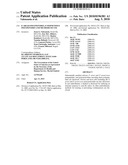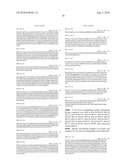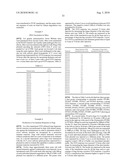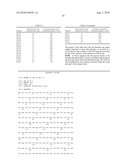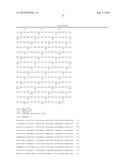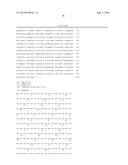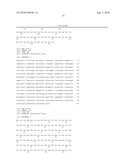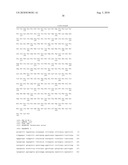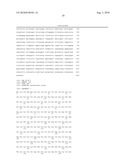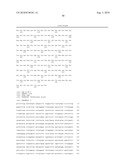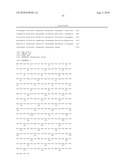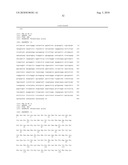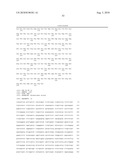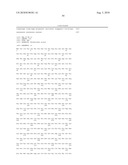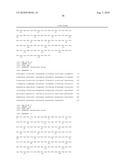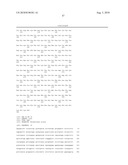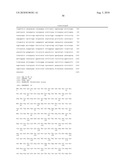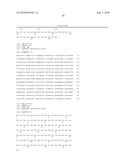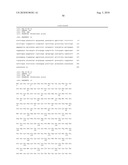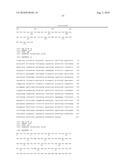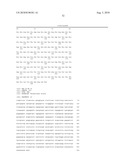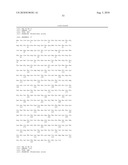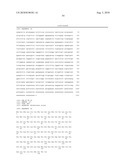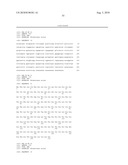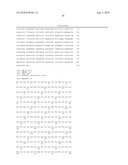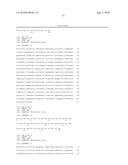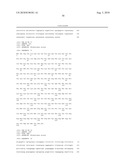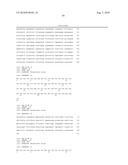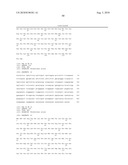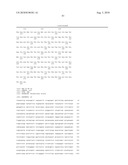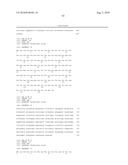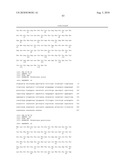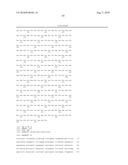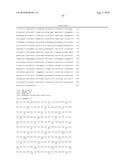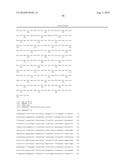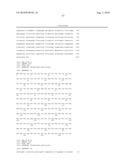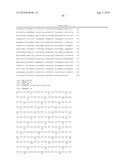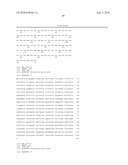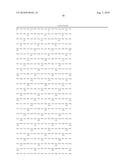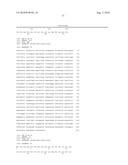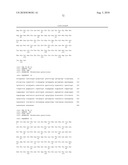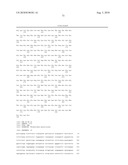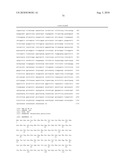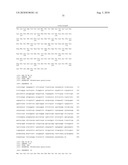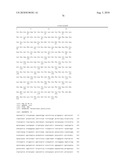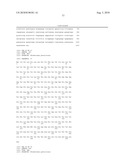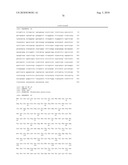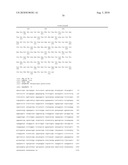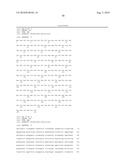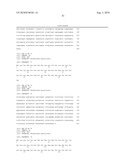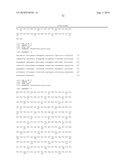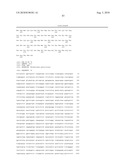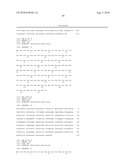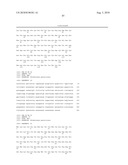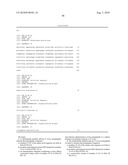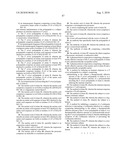Patent application title: P. ARIASI POLYPEPTIDES, P. PERNICIOSUS POLYPEPTIDES AND METHODS OF USE
Inventors:
Jesus G. Valenzuela (Rockville, MD, US)
Jose M.c. Ribiero (Rockville, MD, US)
Shaden Kamhawi (Rockville, MD, US)
Yasmine Belkaid (Norwood, OH, US)
Laurent Fischer (Lyon, FR)
Jean-Christophe Audonnet (Lyon, FR)
Jean-Christophe Audonnet (Lyon, FR)
Francis Milward (Bogart, GA, US)
Assignees:
The Government of the United States of America as represented by the Secretary of the Department of
Health and Human Service
Merial Limited
IPC8 Class: AA61K39395FI
USPC Class:
4241391
Class name: Drug, bio-affecting and body treating compositions immunoglobulin, antiserum, antibody, or antibody fragment, except conjugate or complex of the same with nonimmunoglobulin material binds antigen or epitope whose amino acid sequence is disclosed in whole or in part (e.g., binds specifically-identified amino acid sequence, etc.)
Publication date: 2010-08-05
Patent application number: 20100196381
Claims:
1. A substantially purified salivary P. ariasi polypeptide, wherein the
polypeptide comprises:a) residues 21-65 of the amino acid sequence set
forth as SEQ ID NO:39;b) an amino acid sequence at least 90% identical to
residues 21-65 of SEQ ID NO: 39; orc) an immunogenic fragment comprising
at least fifteen consecutive amino acids of residues 21-65 of SEQ ID NO:
39,and wherein administration of the polypeptide to a subject produces an
immune response to P. ariasi.
2. The substantially purified salivary P. ariasi polypeptide of claim 1, wherein the polypeptide comprises:a) residues 21-65 of the amino acid sequence set forth as SEQ ID NO:39;b) an amino acid sequence at least 90% identical to residues 21-65 of SEQ ID NO: 39;c) a conservative variant of residues 21-65 of SEQ ID NO:39; ord) an immunogenic fragment comprising at least fifteen consecutive amino acids of residues 21-65 of SEQ ID NO: 39,and wherein administration of the polypeptide to a subject produces an immune response to P. ariasi.
3. The P. ariasi polypeptide of claim 1, wherein the polypeptide comprises residues 21-65 of SEQ ID NO: 39, or a conservative variant thereof.
4. The P. ariasi polypeptide of claim 3, wherein the polypeptide comprises residues 21-65 of SEQ ID NO: 39.
5. An immunogenic fragment of the polypeptide of claim 4, wherein the immunogenic fragment comprises at least fifteen contiguous amino acids of residues 21-65 of SEQ ID NO: 39.
6. The P. ariasi polypeptide of claim 1, wherein the polypeptide comprises an amino acid sequence at least 90% identical to residues 21-65 of SEQ ID NO: 39.
7. The P. ariasi polypeptide of claim 6, wherein the polypeptide comprises an amino acid sequence at least 95% identical to residues 21-65 of SEQ ID NO: 39.
8. The P. ariasi polypeptide of claim 7, wherein the polypeptide comprises an amino acid sequence at least 98% identical to residues 21-65 of SEQ ID NO: 39.
9. The P. ariasi polypeptide of claim 8, wherein the polypeptide comprises residues 21-65 of the amino acid sequence set forth as SEQ ID NO: 39.
10. The P. ariasi polypeptide of claim 9, wherein the polypeptide consists of residues 21-65 of the amino acid sequence set forth as SEQ ID NO: 39.
11. An isolated nucleic acid encoding the P. ariasi polypeptide of claim 1.
12. The nucleic acid of claim 11, wherein the nucleic acid comprises a sequence as set forth as residues 86-220 SEQ ID NO: 40, or a degenerate variant thereof.
13. The nucleic acid of claim 11, wherein the nucleic acid comprises a sequence as set forth as residues 86-220 of SEQ ID NO: 40.
14. The nucleic acid of claim 11, wherein the nucleic acid encodes an amino acid sequence at least 90% identical to the amino acid sequence set forth as residues 21-65 of SEQ ID NO: 39.
15. The nucleic acid of claim 14, wherein the nucleic acid encodes an amino acid sequence at least 95% identical to the amino acid sequence set forth as residues 21-65 of SEQ ID NO: 39.
16. The nucleic acid of claim 15, wherein the nucleic acid encodes an amino acid sequence at least 98% identical to the amino acid sequence set forth as residues 21-65 of SEQ ID NO: 39.
17. The nucleic acid of claim 11, operably linked to an expression control sequence.
18. The nucleic acid of claim 17, wherein the expression control sequence comprises a promoter.
19. The nucleic acid of claim 18, wherein the promoter comprises an inducible or constitutive promoter.
20. The nucleic acid of claim 19, wherein the promoter comprises a cytomegalovirus promoter.
21. A vector comprising the nucleic acid of claim 11.
22. The vector of claim 21, wherein the vector comprises a plasmid.
23. The vector of claim 21, wherein the vector comprises a viral vector.
24. A host cell transformed with the vector of claim 21.
25. An antibody that specifically binds the polypeptide of claim 1.
26. The antibody of claim 25, wherein the antibody comprises a monoclonal antibody.
27. The antibody of claim 25, comprising a detectable label.
28. The antibody of claim 27, wherein the label comprises a fluorescent, enzymatic or radioactive label.
29. A pharmaceutical composition comprising a therapeutically effective amount of the P. ariasi polypeptide of claim 1 and a pharmaceutically acceptable carrier.
30. A pharmaceutical composition comprising a therapeutically effective amount of the nucleic acid of claim 11 and a pharmaceutically acceptable carrier.
31. A method for inducing an immune response to a P. ariasi polypeptide in a subject, comprisingadministering to the subject a therapeutically effective amount of the P. ariasi polypeptide of claim 1, or a therapeutically effective amount of a polynucleotide encoding the P. ariasi polypeptide of claim 1, thereby inducing the immune response.
32. The method of claim 31, wherein the immune response comprises a T cell response.
33. The method of claim 31, wherein the immune response comprises a B cell response.
34. The method of claim 32, wherein the subject is a non-human veterinary subject.
35. The method of claim 34, wherein the subject is a dog.
36. The method of claim 31, wherein the subject is a human.
37. A method for inhibiting a symptom of a Leishmania infection or preventing a Leishmania infection in a subject, comprising administering to the subject a therapeutically effective amount of the P. ariasi polypeptide of claim 1, or a therapeutically effective amount of a polynucleotide encoding the P. ariasi polypeptide of claim 1, thereby inhibiting the symptom of the Leishmania infection or preventing the Leishmania infection.
38. The method of claim 37, wherein the subject is a non-human veterinary subject.
39. The method of claim 38, wherein the subject is a dog.
40. The method of claim 37, wherein the subject is a human.
Description:
PRIORITY CLAIM
[0001]This application is a divisional of U.S. application Ser. No. 10/527,500, filed Mar. 11, 2005, which is the §371 U.S. National Stage of International Application No. PCT/US2003/029833, filed Sep. 18, 2003, which was published in English under PCT Article 21(2), which in turn claims the benefit of U.S. Provisional Application No. 60/412,327, filed Sep. 19, 2002, and U.S. Provisional Application No. 60/425,852, filed Nov. 12, 2002, which are incorporated herein by reference.
FIELD
[0002]The disclosure relates to proteins substantially purified from Phlebotomine sand fly salivary glands, or recombinant vectors expressing these proteins, and to an immune response produced to these proteins. This disclosure also relates to the production of an immune response that affects survival of Leishmania.
BACKGROUND
[0003]Leishmaniasis is a group of diseases caused by protozoa of the genus Leishmania that affects many millions of people worldwide. In humans, infection with the parasite manifests either as a cutaneous disease caused mainly by L. major, L. tropica, and L. mexicana; as a mucocutaneous disease caused mainly by L. brasiliensis; or as a visceral disease caused mainly by L. donovani and L. chagasi. In canids, Leishmania infections manifest as a visceral disease that can result in high death rates.
[0004]All leishmanial diseases are transmitted to their vertebrate hosts by phlebotomine sand flies, which acquire the pathogen by feeding on infected hosts and transmit them by regurgitating the parasite at the site of a subsequent blood meal (Killick-Kendrick, Biology of Leishmania in phlebotomine sand flies. In Biology of the kinetoplastida. W. Lumsden and D. Evans, editors. Academic Press, New York. 395, 1979).
[0005]While obtaining a blood meal, sand flies salivate into the host's skin. This saliva contains anticlotting, antiplatelet, and vasodilatory compounds that increase the hemorrhagic pool where sand flies feed (Ribeiro et al., Comp. Biochem. Physiol. 4:683, 1986; Charlab et al., Proc. Natl. Acad. Sci. USA. 26:15155, 1999). Some of these components are additionally immunomodulatory. For example, the New World sand fly Lutzomyia longipalpis contains the 6.5 kDa peptide, maxadilan, which is the most potent vasodilator known (Lerner et al., J. Biol. Chem. 17:11234, 1991). Maxadilan additionally has immunosuppressive activities of its own (Qureshi et al., Am. J. Trop. Med. Hyg. 6:665, 1996), as do many persistent vasodilators such as prostaglandin E2 (Makoul et al., J. Immunol. 134:2645, 1985; Santoli and Zurier, J. Immunol. 143:1303, 1989; Stockman and Mumford, Exp. Hematol. 2:65, 1974) and calcitonin gene-related peptide (Nong et al., J. Immunol. 1:45, 1989). Old World sand flies do not have maxadilan but instead use adenosine monophosphate and adenosine as vasodilators (Ribeiro et al., J. Exp. Biol. 11:1551, 1999). Adenosine is also an immunomodulatory component, promoting the production of interleukin-10 and suppressing tumor necrosis factor-α and interleukin-12 in mice (Hasko et al., J. Immunol. 10:4634, 1996; Webster, Asian Pac. J. Allergy Immunol. 2:311, 1984; Hasko et al., FASEB J. 14:2065, 2000).
[0006]Despite what is known about the role of sandfly saliva and disease transmission, much remains unknown, and an effective vaccine does not exist. Thus, there is a need for agents that can be used to induce an immune response to the organisms that cause leishmaniasis.
SUMMARY
[0007]The present disclosure relates to salivary proteins from sand fly vectors of Leishmania that are members of the subgenus of Phlebotomus Larroussius, in particular two species, namely Phlebotomus ariasi and Phlebotomus perniciosus, and the nucleic acids that encode these proteins. Methods of producing an immune response in a subject are also disclosed.
[0008]Substantially purified salivary P. ariasi polypeptides are disclosed herein. Also disclosed are polynucleotides encoding the P. ariasi polypeptides disclosed herein.
[0009]Disclosed herein are substantially purified salivary P. perniciosus polypeptides. Also disclosed are polynucleotides encoding the P. perniciosus polypeptides disclosed herein.
[0010]Methods are disclosed for inducing an immune response to a P. ariasi polypeptide using a therapeutically effective amount of the substantially purified salivary P. ariasi polypeptides disclosed herein, or the polynucleotides encoding the P. ariasi polypeptides disclosed herein.
[0011]Methods are also disclosed for inducing an immune response to a P. perniciosus polypeptide using a therapeutically effective amount of the P. perniciosus polypeptides disclosed herein, or the polynucleotides encoding the P. perniciosus polypeptides disclosed herein.
[0012]In another embodiment, methods are disclosed herein for inhibiting the symptoms of a Leishmania infection or for preventing a Leishmania infection in a subject. The methods include administering to the subject a therapeutically effective amount of a P. ariasi polypeptide, or a polynucleotide encoding a P. ariasi polypeptide.
[0013]In yet another embodiment, methods are disclosed herein for inhibiting the symptoms of a Leishmania infection or for preventing a Leishmania infection in a subject. The methods include administering to the subject a therapeutically effective amount of a P. perniciosus polypeptide, or a polynucleotide encoding a P. perniciosus polypeptide.
[0014]Pharmaceutical compositions are disclosed including a pharmaceutically acceptable carrier and a P. ariasi polypeptide and/or a P. perniciosus polypeptide.
[0015]The foregoing and other features and advantages will become more apparent from the following detailed description of several embodiments, which proceeds with reference to the accompanying figures.
SEQUENCE LISTING
[0016]The nucleic and amino acid sequences listed in the accompanying sequence listing are shown using standard letter abbreviations for nucleotide bases, and three letter code for amino acids, as defined in 37 C.F.R. 1.822. Only one strand of each nucleic acid sequence is shown, but the complementary strand is understood as included by any reference to the displayed strand. In the accompanying sequence listing:
[0017]SEQ ID NO: 1 is the amino acid sequence of a PRL-P4-A10 polypeptide.
[0018]SEQ ID NO:2 is the nucleic acid sequence of a polynucleotide encoding a PRL-P4-A10 polypeptide.
[0019]SEQ ID NO: 3 is the amino acid sequence of PRL-P4-A9 polypeptide.
[0020]SEQ ID NO:4 is the nucleic acid sequence of a polynucleotide encoding a PRL-P4-A9 polypeptide.
[0021]SEQ ID NO:5 is the amino acid sequence of PRL-P4-C10 polypeptide.
[0022]SEQ ID NO:6 is the nucleic acid sequence of a polynucleotide encoding a PRL-P4-C 10 polypeptide.
[0023]SEQ ID NO:7 is the amino acid sequence of PRL-P4-D6 polypeptide.
[0024]SEQ ID NO:8 is the nucleic acid sequence of a polynucleotide encoding a PRL-P4-D6 polypeptide.
[0025]SEQ ID NO:9 is the amino acid sequence of PRL-P4-D7 polypeptide.
[0026]SEQ ID NO:10 is the nucleic acid sequence of a polynucleotide encoding a PRL-P4-D7 polypeptide.
[0027]SEQ ID NO:11 is the amino acid sequence of PRL-P4-E5 polypeptide.
[0028]SEQ ID NO:12 is the nucleic acid sequence of a polynucleotide encoding a PRL-P4-E5 polypeptide.
[0029]SEQ ID NO:13 is the amino acid sequence of PRL-P4-F3 polypeptide.
[0030]SEQ ID NO:14 is the nucleic acid sequence of a polynucleotide encoding a PRL-P4-F3 polypeptide.
[0031]SEQ ID NO:15 is the amino acid sequence of PRL-P4-G12 polypeptide.
[0032]SEQ ID NO:16 is the nucleic acid sequence of a polynucleotide encoding a PRL-P4-G12 polypeptide.
[0033]SEQ ID NO:17 is the amino acid sequence of PRL-P4-G7 polypeptide.
[0034]SEQ ID NO:18 is the nucleic acid sequence of a polynucleotide encoding a PRL-P4-G7 polypeptide.
[0035]SEQ ID NO:19 is the amino acid sequence of PRL-P6-E11 polypeptide.
[0036]SEQ ID NO:20 is the nucleic acid sequence of a polynucleotide encoding a PRL-P6-E11 polypeptide.
[0037]SEQ ID NO:21 is the amino acid sequence of PRM-P3-A6 polypeptide.
[0038]SEQ ID NO:22 is the nucleic acid sequence of a polynucleotide encoding a PRM-P3-A6 polypeptide.
[0039]SEQ ID NO:23 is the amino acid sequence of PRM-P3-F11 polypeptide.
[0040]SEQ ID NO:24 is the nucleic acid sequence of a polynucleotide encoding a PRM-P3-F11 polypeptide.
[0041]SEQ ID NO:25 is the amino acid sequence of PRM-P5-D6 polypeptide.
[0042]SEQ ID NO:26 is the nucleic acid sequence of a polynucleotide encoding a PRM-P5-D6 polypeptide.
[0043]SEQ ID NO:27 is the amino acid sequence of PRM-P5-E9 polypeptide.
[0044]SEQ ID NO:28 is the nucleic acid sequence of a polynucleotide encoding a PRM-P5-E9 polypeptide.
[0045]SEQ ID NO:29 is the amino acid sequence of PRM-P5-F12 polypeptide.
[0046]SEQ ID NO:30 is the nucleic acid sequence of a polynucleotide encoding a PRM-P5-F12 polypeptide.
[0047]SEQ ID NO:31 is the amino acid sequence of PRM-P5-F2 polypeptide.
[0048]SEQ ID NO:32 is the nucleic acid sequence of a polynucleotide encoding a PRM-P5-F2 polypeptide.
[0049]SEQ ID NO:33 is the amino acid sequence of PRM-P5-G11 polypeptide.
[0050]SEQ ID NO:34 is the nucleic acid sequence of a polynucleotide encoding a PRM-P5-G11 polypeptide.
[0051]SEQ ID NO:35 is the amino acid sequence of PRM-P5-H4 polypeptide.
[0052]SEQ ID NO:36 is the nucleic acid sequence of a polynucleotide encoding a PRM-P5-H4 polypeptide.
[0053]SEQ ID NO:37 is the amino acid sequence of PRS-P1-B11 polypeptide.
[0054]SEQ ID NO:38 is the nucleic acid sequence of a polynucleotide encoding a PRS-P1-B11 polypeptide.
[0055]SEQ ID NO:39 is the amino acid sequence of PRS-P1-B4 polypeptide.
[0056]SEQ ID NO:40 is the nucleic acid sequence of a polynucleotide encoding a PRS-P1-B4 polypeptide.
[0057]SEQ ID NO:41 is the amino acid sequence of PRS-P1-E7 polypeptide.
[0058]SEQ ID NO:42 is the nucleic acid sequence of a polynucleotide encoding a PRS-P1-E7 polypeptide.
[0059]SEQ ID NO:43 is the amino acid sequence of PRS-P1-G9 polypeptide.
[0060]SEQ ID NO:44 is the nucleic acid sequence of a polynucleotide encoding a PRS-P1-G9 polypeptide.
[0061]SEQ ID NO:45 is the amino acid sequence of PRS-P2-C8 polypeptide.
[0062]SEQ ID NO:46 is the nucleic acid sequence of a polynucleotide encoding a PRS-P2-C8 polypeptide.
[0063]SEQ ID NO:47 is the amino acid sequence of PRS-P2-G8 polypeptide.
[0064]SEQ ID NO:48 is the nucleic acid sequence of a polynucleotide encoding a PRS-P2-G8 polypeptide.
[0065]SEQ ID NO:49 is the amino acid sequence of PERL-P7-G8 polypeptide.
[0066]SEQ ID NO:50 is the nucleic acid sequence of a polynucleotide encoding a PERL-P7-G8 polypeptide.
[0067]SEQ ID NO:51 is the amino acid sequence of PERL-P6-H9 polypeptide.
[0068]SEQ ID NO:52 is the nucleic acid sequence of a polynucleotide encoding a PERL-P6-H9 polypeptide.
[0069]SEQ ID NO:53 is the amino acid sequence of PERL-P7-C2 polypeptide.
[0070]SEQ ID NO:54 is the nucleic acid sequence of a polynucleotide encoding a PERL-P7-C2 polypeptide.
[0071]SEQ ID NO:55 is the amino acid sequence of PERL-P6-H1 polypeptide.
[0072]SEQ ID NO:56 is the nucleic acid sequence of a polynucleotide encoding a PERL-P6-H1 polypeptide.
[0073]SEQ ID NO:57 is the amino acid sequence of PERL-P3-E11 polypeptide.
[0074]SEQ ID NO:58 is the nucleic acid sequence of a polynucleotide encoding a PERL-P3-E11polypeptide.
[0075]SEQ ID NO:59 is the amino acid sequence of PERL-P7-G12 polypeptide.
[0076]SEQ ID NO:60 is the nucleic acid sequence of a polynucleotide encoding a PERL-P7-G12 polypeptide.
[0077]SEQ ID NO:61 is the amino acid sequence of PERL-P3-C9 polypeptide.
[0078]SEQ ID NO:62 is the nucleic acid sequence of a polynucleotide encoding a PERL-P3-C9 polypeptide.
[0079]SEQ ID NO:63 is the amino acid sequence of PERM-P2-A10 polypeptide.
[0080]SEQ ID NO:64 is the nucleic acid sequence of a polynucleotide encoding a PERM-P2-A10 polypeptide.
[0081]SEQ ID NO:65 is the amino acid sequence of PERL-P6-H11 polypeptide.
[0082]SEQ ID NO:66 is the nucleic acid sequence of a polynucleotide encoding a PERL-P6-H11 polypeptide.
[0083]SEQ ID NO:67 is the amino acid sequence of PERS-P1-H11 polypeptide.
[0084]SEQ ID NO:68 is the nucleic acid sequence of a polynucleotide encoding a PERS-P1-H11 polypeptide.
[0085]SEQ ID NO:69 is the amino acid sequence of PERM-P2-G11 polypeptide.
[0086]SEQ ID NO:70 is the nucleic acid sequence of a polynucleotide encoding a PERM-P2-G11 polypeptide.
[0087]SEQ ID NO:71 is the amino acid sequence of PERM-P5-E2 polypeptide.
[0088]SEQ ID NO:72 is the nucleic acid sequence of a polynucleotide encoding a PERM-P5-E2 polypeptide.
[0089]SEQ ID NO:73 is the amino acid sequence of PERM-P5-C11 polypeptide.
[0090]SEQ ID NO:74 is the nucleic acid sequence of a polynucleotide encoding a PERM-P5-C11 polypeptide.
[0091]SEQ ID NO:75 is the amino acid sequence of PERM-P5-H8 (also referred to as P2-G9) polypeptide.
[0092]SEQ ID NO:76 is the nucleic acid sequence of a polynucleotide encoding a PERM-P5-H8 (also referred to as P2-G9) polypeptide.
[0093]SEQ ID NO:77 is the amino acid sequence of PERL-P3-B3 polypeptide.
[0094]SEQ ID NO:78 is the nucleic acid sequence of a polynucleotide encoding a PERL-P3-B3 polypeptide.
[0095]SEQ ID NO:79 is the amino acid sequence of PERM-P2-D11 polypeptide.
[0096]SEQ ID NO:80 is the nucleic acid sequence of a polynucleotide encoding a PERM-P2-D 11 polypeptide.
[0097]SEQ ID NO:81 is the amino acid sequence of PERM-P5-E3 polypeptide. SEQ ID NO:82 is the nucleic acid sequence of a polynucleotide encoding a PERM-P5-E3 polypeptide.
[0098]SEQ ID NO:83 is the amino acid sequence of PERM-P2-F11 polypeptide.
[0099]SEQ ID NO:84 is the nucleic acid sequence of a polynucleotide encoding a PERM-P2-F11 polypeptide.
[0100]SEQ ID NO:85 is the nucleic acid sequence of the PT2F1 primer.
[0101]SEQ ID NO:86 is the nucleic acid sequence of the PT2R1 primer.
[0102]SEQ ID NO:87 is the nucleic acid sequence of the PT2F3 primer.
DETAILED DESCRIPTION
I. Abbreviations
[0103]AAV adeno-associated virus [0104]AcNPV Autographa California Nuclear Polyhedrosis Virus [0105]alum aluminum phosphate or aluminum hydroxide [0106]BCG Bacillus Calmette Guerin [0107]BLAST Basic Local Alignment Search Tool [0108]BSA bovine serum albumin [0109]CAV canine adenovirus [0110]CDR complementarity determining region [0111]CHV canine herpes virus [0112]CMV cytomegalovirus [0113]CTL cytotoxic T lymphocyte [0114]DMRIE N-(2-hydroxyethyl)-N,N-dimethyl-2,3-bis(tetradecyloxy)-1-propanammonium [0115]DOPE dioleoyl-phosphatidyl-ethanolamine [0116]DTH delayed type hypersensitivity [0117]fMLP N-formyl-methionyl-leucyl-phenylalanine [0118]GM-CSF granulocyte-macrophage colony stimulating factor [0119]H heavy chains [0120]HLB hydrophile-lipophile balance [0121]ID intradermal [0122]IM intramuscular [0123]ISS immunostimulating sequence [0124]KLH keyhole limpet hemocyanin [0125]L light chains [0126]LB Luria broth [0127]MVA Modified Vaccinia virus Ankara [0128]ORF open reading frame [0129]PCR polymerase chain reaction [0130]polyA polyadenylation signal [0131]PVDF polyvinylidene difluoride [0132]SC subcutaneous [0133]SCA Single chain antibody [0134]SDS-PAGE sodium dodecyl sulfate-polyacrylamide gel electrophoresis [0135]sFv single-chain antigen binding proteins [0136]SGH salivary gland homogenate [0137]SPGA sucrose phosphate glutamate albumin [0138]tPA tissue plasminogen activator [0139]VH variable region of the heavy chain [0140]VL variable region of the light chain [0141]W/V weight/volume
II. Terms
[0142]Unless otherwise noted, technical terms are used according to conventional usage. Definitions of common terms in molecular biology may be found in Benjamin Lewin, Genes V, published by Oxford University Press, 1994 (ISBN 0-19-854287-9); Kendrew et al. (eds.), The Encyclopedia of Molecular Biology, published by Blackwell Science Ltd., 1994 (ISBN 0-632-02182-9); and Robert A. Meyers (ed.), Molecular Biology and Biotechnology: a Comprehensive Desk Reference, published by VCH Publishers, Inc., 1995 (ISBN 1-56081-569-8).
[0143]In order to facilitate review of the various embodiments of the disclosure, the following explanations of specific terms are provided:
[0144]Amplification (of a nucleic acid molecule): A technique that increases the number of copies of a nucleic acid molecule (e.g., a DNA or an RNA) in a specimen. An example of amplification is the polymerase chain reaction, in which a biological sample collected from a subject is contacted with a pair of oligonucleotide primers, under conditions that allow for the hybridization of the primers to a nucleic acid template in the sample. The primers are extended under suitable conditions, dissociated from the template, and then re-annealed, extended, and dissociated to amplify the number of copies of the nucleic acid. The product of amplification may be characterized by electrophoresis, restriction endonuclease cleavage patterns, oligonucleotide hybridization or ligation, and/or nucleic acid sequencing using standard techniques. Other examples of amplification include strand displacement amplification, as disclosed in U.S. Pat. No. 5,744,311; transcription-free isothermal amplification, as disclosed in U.S. Pat. No. 6,033,881; repair chain reaction amplification, as disclosed in WO 90/01069; ligase chain reaction amplification, as disclosed in EP 0320308; gap filling ligase chain reaction amplification, as disclosed in U.S. Pat. No. 5,427,930; and NASBA® RNA transcription-free amplification, as disclosed in U.S. Pat. No. 6,025,134.
[0145]Antibody: immunoglobulin molecules and immunologically active portions of immunoglobulin molecules, i.e., molecules that contain an antigen binding site that specifically binds (immunoreacts with) an antigen.
[0146]A naturally occurring antibody (e.g., IgG, IgM, IgD) includes four polypeptide chains, two heavy (H) chains and two light (L) chains inter-connected by disulfide bonds. However, it has been shown that the antigen-binding function of an antibody can be performed by fragments of a naturally occurring antibody. Thus, these antigen-binding fragments are also intended to be designated by the term "antibody." Specific, non-limiting examples of binding fragments encompassed within the term antibody include (i) a Fab fragment consisting of the VL, VH, CL, and CH1 domains; (ii) an Fd fragment consisting of the VH and CH1 domains; (iii) an Fv fragment consisting of the VL and VH domains of a single arm of an antibody, (iv) a dAb fragment (Ward et al., Nature 341:544-546, 1989) which consists of a VH domain; (v) an isolated complimentarity determining region (CDR); and (vi) a F(ab')2 fragment, a bivalent fragment comprising two Fab fragments linked by a disulfide bridge at the hinge region.
[0147]Immunoglobulins and certain variants thereof are known and many have been prepared in recombinant cell culture (e.g., see U.S. Pat. No. 4,745,055; U.S. Pat. No. 4,444,487; WO 88/03565; EP 0256654; EP 0120694; EP 0125023; Faoulkner et al., Nature 298:286, 1982; Morrison, J. Immunol. 123:793, 1979; Morrison et al., Ann Rev. Immunol 2:239, 1984).
[0148]Animal: Living multi-cellular vertebrate organisms, a category that includes, for example, mammals and birds. The term mammal includes both human and non-human mammals. Similarly, the term "subject" includes both human and veterinary subjects, such as dogs.
[0149]Conservative variants: "Conservative" amino acid substitutions are those substitutions that do not substantially affect or decrease an activity or antigenicity of the P. ariasi or P. perniciosus polypeptide. Specific, non-limiting examples of a conservative substitution include the following examples:
TABLE-US-00001 Original Conservative Residue Substitutions Ala Ser Arg Lys Asn Gln, His Asp Glu Cys Ser Gln Asn Glu Asp His Asn; Gln Ile Leu, Val Leu Ile; Val Lys Arg; Gln; Glu Met Leu; Ile Phe Met; Leu; Tyr Ser Thr Thr Ser Trp Tyr Tyr Trp; Phe Val Ile; Leu
The term conservative variation also includes the use of a substituted amino acid in place of an unsubstituted parent amino acid, provided that antibodies raised to the unsubstituted polypeptide also essentially immunoreact with the substituted polypeptide, or that an immune response can be generated against the substituted polypeptide that is similar to the immune response against the unsubstituted polypeptide. Thus, is one embodiment, non-conservative substitutions are those that reduce an activity or antigenicity.
[0150]cDNA (complementary DNA): A piece of DNA lacking internal, non-coding segments (introns) and expression control sequences. cDNA is synthesized in the laboratory by reverse transcription from messenger RNA extracted from cells.
[0151]Degenerate variant: A polynucleotide encoding a P. ariasi polypeptide or a P. perniciosus polypeptide that includes a sequence that is degenerate as a result of the genetic code. There are 20 natural amino acids, most of which are specified by more than one codon. Therefore, all degenerate nucleotide sequences are included in the disclosure as long as the amino acid sequence of the P. ariasi polypeptide or P. perniciosus polypeptide encoded by the nucleotide sequence is unchanged.
[0152]Epitope: An antigenic determinant. These are particular chemical groups or peptide sequences on a molecule that are antigenic, i.e., that elicit a specific immune response. An antibody specifically binds a particular antigenic epitope on a polypeptide. Specific, non-limiting examples of an epitope include a tetra- to penta-peptide sequence in a polypeptide, a tri- to penta-glycoside sequence in a polysaccharide. In the animal most antigens will present several or even many antigenic determinants simultaneously. Such a polypeptide may also be qualified as an immunogenic polypeptide and the epitope may be identified as described further.
[0153]Expression Control Sequences: Nucleic acid sequences that control and regulate the expression of a nucleic acid sequence, such as a heterologous nucleic acid sequence, to which it is operably linked. Expression control sequences are operably linked to a nucleic acid sequence when the expression control sequences control and regulate the transcription and, as appropriate, translation of the nucleic acid sequence. Thus expression control sequences can include appropriate promoters, enhancers, transcription terminators, polyA signals, a start codon (i.e., ATG) in front of a protein-encoding polynucleotide sequence, splicing signal for introns, maintenance of the correct reading frame of that gene to permit proper translation of mRNA, and stop codons. The term "control sequences" is intended to include, at a minimum, components whose presence can influence expression, and can also include additional components whose presence is advantageous, for example, leader sequences and fusion partner sequences. Expression control sequences can include a promoter.
[0154]A promoter is a minimal sequence sufficient to direct transcription. Also included are those promoter elements which are sufficient to render promoter-dependent gene expression controllable for cell-type specific, tissue-specific, or inducible by external signals or agents; such elements may be located in the 5' or 3' regions of the gene. Both constitutive and inducible promoters, are included (see e.g., Bitter et al., Methods in Enzymology 153:516-544, 1987). For example, when cloning in bacterial systems, inducible promoters such as pL of bacteriophage lambda, plac, pap, ptac (ptrp-lac-hybrid promoter) and the like may be used. In one embodiment, when cloning in mammalian cell systems, promoters derived from the genome of mammalian cells (e.g., metallothionein promoter) or from mammalian viruses (e.g., the retrovirus long terminal repeat; the adenovirus late promoter; the vaccinia virus 7.5K promoter) can be used. Promoters produced by recombinant DNA or synthetic techniques may also be used to provide for transcription of the nucleic acid sequences. In one embodiment, the promoter is a cytomegalovirus promoter.
[0155]Host cells: Cells in which a vector can be propagated and its DNA expressed. The cell may be prokaryotic or eukaryotic. The term also includes any progeny of the subject host cell. It is understood that all progeny may not be identical to the parental cell since there may be mutations that occur during replication. However, such progeny are included when the term "host cell" is used. Also includes the cells of the subject.
[0156]Immune response: A response of a cell of the immune system, such as a B cell, T cell, or monocyte, to a stimulus. In one embodiment, the response is specific for a particular antigen (an "antigen-specific response"). The response can also be a non-specific response (not targeted specifically to salivary polypeptides) such as production of lymphokines. In one embodiment, an immune response is a T cell response, such as a CD4+ response or a CD8+ response. In another embodiment, the response is a B cell response, and results in the production of specific antibodies.
[0157]Immunogenic polypeptide: A polypeptide which comprises an allele-specific motif, an epitope or other sequence such that the polypeptide will induce an immune response. A specific, non-limiting example of an immune response includes binding an MHC molecule and inducing a cytotoxic T lymphocyte ("CTL") response, inducing a B cell response (e.g., antibody production), and/or T-helper lymphocyte response, and/or a delayed type hypersensitivity (DTH) response against the antigen from which the immunogenic polypeptide is derived.
[0158]In one embodiment, immunogenic polypeptides are identified using sequence motifs or other methods known in the art. Typically, algorithms are used to determine the "binding threshold" of polypeptides to select those with scores that give them a high probability of binding at a certain affinity and will be immunogenic. The algorithms are based either on the effects on MHC binding of a particular amino acid at a particular position, the effects on antibody binding of a particular amino acid at a particular position, or the effects on binding of a particular substitution in a motif-containing polypeptide. Within the context of an immunogenic polypeptide, a "conserved residue" is one which appears in a significantly higher frequency than would be expected by random distribution at a particular position in a polypeptide. In one embodiment, a conserved residue is one where the MHC structure may provide a contact point with the immunogenic polypeptide.
[0159]Immunogenic composition: A composition that, when administered to a subject, induces an immune response to a Phlebotomus salivary polypeptide. In one embodiment, the immune response is a positive DTH response.
[0160]Isolated: An "isolated" biological component (such as a nucleic acid or protein or organelle) has been substantially separated or purified away from other biological components in the cell of the organism in which the component naturally occurs, i.e., other chromosomal and extra-chromosomal DNA and RNA, proteins, and organelles. Nucleic acids and proteins that have been "isolated" include nucleic acids and proteins purified by standard purification methods. The term also embraces nucleic acids and proteins prepared by recombinant technology as well as chemical synthesis.
[0161]Label: A detectable compound or composition that is conjugated directly or indirectly to another molecule to facilitate detection of that molecule. Specific, non-limiting examples of labels include fluorescent tags, enzymatic linkages, and radioactive isotopes.
[0162]Leishmaniasis: A parasitic disease spread by the bite of infected sand flies. The trypanosomatid parasite of the genus Leishmania is the etiological agent of a variety of disease manifestations, which are collectively known as leishmaniasis. Leishmaniasis is prevalent through out the tropical and sub-tropical regions of Africa, Asia, the Mediterranean, Southern Europe (old world), and South and Central America (new world). The old world species are transmitted by the sand fly vector Phlebotomus sp. Humans, wild animals and domestic animals (such as dogs) are known to be targets of these sandflies and to act as reservoir hosts or to develop leishmaniasis.
[0163]Cutaneous leishmaniasis starts as single or multiple nodules that develop into ulcers in the skin at the site of the bite. The chiclero ulcer typically appears as a notch-like loss of tissue on the ear lobe. The incubation period ranges from days to months, even a year in some cases. The sores usually last months to a few years, with most cases healing on their own. The mucocutaneous type can develop into erosive lesions in the nose, mouth, or throat and can lead to severe disfigurement. Visceral leishmaniasis often has fever occurring in a typical daily pattern, abdominal enlargement with pain, weakness, widespread swelling of lymph nodes, and weight loss, as well as superimposed infections because of a weakened immune system. Visceral leishmaniasis can result in high death rates. The onset of symptoms can be sudden, but more often tends to be insidious.
[0164]Lymphocytes: A type of white blood cell that is involved in the immune defenses of the body. There are two main types of lymphocytes: B cells and T cells.
[0165]Mammal: This term includes both human and non-human mammals. Similarly, the term "subject" includes both human and veterinary subjects.
[0166]Oligonucleotide: A linear polynucleotide sequence of up to about 100 nucleotide bases in length.
[0167]Open reading frame (ORF): A nucleic acid sequence having a series of nucleotide triplets (codons), starting with a start codon and ending with a stop codon, coding for amino acids without any internal termination codons. These sequences are usually translatable into a polypeptide.
[0168]Operably linked: A first nucleic acid sequence is operably linked with a second nucleic acid sequence when the first nucleic acid sequence is placed in a functional relationship with the second nucleic acid sequence. For instance, a promoter is operably linked to a coding sequence if the promoter affects the transcription or expression of the coding sequence. Generally, operably linked DNA sequences are contiguous and, where necessary to join two protein-coding regions, in the same reading frame.
[0169]Pharmaceutically acceptable vehicles or excipients: The pharmaceutically acceptable vehicles or excipients of use are conventional. Remington's Pharmaceutical Sciences, by E. W. Martin, Mack Publishing Co., Easton, Pa., 15th Edition (1975), describes compositions and formulations suitable for pharmaceutical delivery of the polypeptides, plasmids, viral vectors herein disclosed.
[0170]In general, the nature of the vehicle or excipient will depend on the particular mode of administration being employed. For instance, parenteral formulations usually comprise injectable fluids that include pharmaceutically and physiologically acceptable fluids such as water, physiological saline, balanced salt solutions, aqueous dextrose, glycerol or the like as a vehicle. For solid compositions (e.g., freeze-dried pastille, powder, pill, tablet, or capsule forms), conventional non-toxic solid vehicles or excipients can include, for example, pharmaceutical grades of mannitol, lactose, starch, or magnesium stearate. In addition to biologically neutral vehicles or excipients, immunogenic compositions to be administered can contain minor amounts of non-toxic auxiliary substances, such as wetting or emulsifying agents, preservatives, and pH buffering agents and the like, for example sodium acetate or sorbitan monolaurate.
[0171]Phlebotomus ariasi (P. ariasi): A species of Phlebotomus (sand flies) genus endogenous to the Old World, in particular to southern Europe and Mediterranean countries, more particularly to Spain and France. This sand fly is a proven vector of visceral leishmaniasis. P. ariasi is a member of the subgenera of Phlebotomus Larroussius.
[0172]Phlebotomus perniciosus (P. perniciosus): A species of Phlebotomus (sand flies) genus endogenous to the Old World, in particular to southern Europe, and Mediterranean countries, more particularly to France, Italy, Greece, Morocco, and Spain. This sand fly is a proven vector of the visceral leishmaniasis. P. perniciosus is a member of the subgenera of Phlebotomus Larroussius.
[0173]Polynucleotide: The term polynucleotide or nucleic acid sequence refers to a polymeric form of nucleotide at least 10 bases in length, thus including oligonucleotides and genes. A recombinant polynucleotide includes a polynucleotide that is not immediately contiguous with both of the coding sequences with which it is immediately contiguous (one on the 5' end and one on the 3' end) in the naturally occurring genome of the organism from which it is derived. The term therefore includes, for example, a recombinant DNA which is incorporated into a vector; into an autonomously replicating plasmid or virus; or into the genomic DNA of a prokaryote or eukaryote, or which exists as a separate molecule (e.g., a cDNA) independent of other sequences. The polynucleotides can be ribonucleotides (e.g. RNA), deoxyribonucleotides (e.g. DNA, cDNA), or modified forms of either nucleotide. The term includes single- and double-stranded forms of DNA.
[0174]Polypeptide: Any chain of amino acids, regardless of length (thus encompassing oligopeptides, peptides, and proteins) or post-translational modification (e.g., glycosylation, phosphorylation, or acylation). A polypeptide encompasses also the precursor, as well as the mature polypeptide. In one embodiment, the polypeptide is a polypeptide isolated from P. ariasi, or encoded by a nucleic acid isolated from P. ariasi, such as the P. ariasi polypeptides disclosed herein. In another embodiment, the polypeptide is a polypeptide isolated from P. perniciosus, or encoded by a nucleic acid isolated from P. perniciosus, such as the P. perniciosus polypeptides disclosed herein.
[0175]Fusion proteins are encompassed by the term polypeptide. Fusion proteins have at least two domains of two different polypeptides fused together. In one embodiment, one domain is a detectable label. The two domains of a fusion protein can be genetically fused together, for instance directly or through the use of a linker oligonucleotide, thereby producing a single fusion-encoding nucleic acid molecule. The translated product of such a fusion-encoding nucleic acid molecule is a fusion protein. In one embodiment, one domain of the fusion protein is a P. ariasi or a P. perniciosus polypeptide and another domain of the fusion protein is a detectable label. The detectable label can be green fluorescent protein, a myc tag or a histidine tag, or the like.
[0176]Polypeptide Modifications: P. ariasi polypeptides or P. perniciosus polypeptides include synthetic embodiments of polypeptides described herein. In addition, analogues (non-peptide organic molecules), derivatives (chemically functionalized peptide molecules obtained starting with the disclosed polypeptide sequences) and variants (homologs) of these proteins can be utilized in the methods described herein. Each polypeptide of the disclosure is comprised of a sequence of amino acids, which may be either L- and/or D-amino acids, naturally occurring and otherwise.
[0177]Polypeptides may be modified by a variety of chemical techniques to produce derivatives having essentially the same activity as the unmodified polypeptides, and optionally having other desirable properties. For example, carboxylic acid groups of the protein, whether carboxyl-terminal or side chain, may be provided in the form of a salt of a pharmaceutically-acceptable cation or esterified to form a C1-C16 ester, or converted to an amide of formula NR1R2 wherein R1 and R2 are each independently H or C1-C16 alkyl, or combined to form a heterocyclic ring, such as a 5- or 6-membered ring Amino groups of the peptide, whether amino-terminal or side chain, may be in the form of a pharmaceutically-acceptable acid addition salt, such as the HCl, HBr, acetic, benzoic, toluene sulfonic, maleic, tartaric, and other organic salts, or may be modified to C1-C16 alkyl or dialkyl amino or further converted to an amide.
[0178]Hydroxyl groups of the peptide side chains may be converted to C1-C16 alkoxy or to a C1-C16 ester using well-recognized techniques. Phenyl and phenolic rings of the peptide side chains may be substituted with one or more halogen atoms, such as fluorine, chlorine, bromine, or iodine, or with C1-C16 alkyl, C1-C16 alkoxy, carboxylic acids and esters thereof, or amides of such carboxylic acids. Methylene groups of the peptide side chains can be extended to homologous C2-C4 alkylenes. Thiols can be protected with any one of a number of well-recognized protecting groups, such as acetamide groups. Those skilled in the art will also recognize methods for introducing cyclic structures into the peptides of this disclosure to select and provide conformational constraints to the structure that result in enhanced stability.
[0179]Peptidomimetic and organomimetic embodiments are envisioned, whereby the three-dimensional arrangement of the chemical constituents of such peptido- and organomimetics mimic the three-dimensional arrangement of the peptide backbone and component amino acid side chains, resulting in such peptido- and organomimetics of a P. ariasi polypeptide or a P. perniciosus polypeptide having measurable or enhanced ability to generate an immune response. For computer modeling applications, a pharmacophore is an idealized, three-dimensional definition of the structural requirements for biological activity. Peptido- and organomimetics can be designed to fit each pharmacophore with current computer modeling software (using computer assisted drug design or CADD). See Walters, "Computer-Assisted Modeling of Drugs," Klegerman & Groves (eds.), 1993, Pharmaceutical Biotechnology, Interpharm Press: Buffalo Grove, Ill., pp. 165-174 and Principles of Pharmacology Munson (ed.) 1995, Ch. 102, for descriptions of techniques used in CADD. Also included are mimetics prepared using such techniques.
[0180]Probes and primers: A probe comprises an isolated polynucleotide attached to a detectable label or reporter molecule. Primers are short polynucleotides. In one embodiment, polynucleotides are 15 nucleotides or more in length. Primers may be annealed to a complementary target DNA strand by nucleic acid hybridization to form a hybrid between the primer and the target DNA strand, and then extended along the target DNA strand by a DNA polymerase enzyme. Primer pairs can be used for amplification of a nucleic acid sequence, e.g., by the polymerase chain reaction (PCR) or other nucleic-acid amplification methods known in the art. One of skill in the art will appreciate that the specificity of a particular probe or primer increases with its length. Thus, for example, a primer comprising 20 consecutive nucleotides will anneal to a target with a higher specificity than a corresponding primer of only 15 nucleotides. Thus, in order to obtain greater specificity, probes and primers may be selected that comprise at least 15, 20, 25, 30, 35, 40, 50 or more consecutive nucleotides.
[0181]Promoter: A promoter is an array of nucleic acid control sequences that directs transcription of a nucleic acid. A promoter includes necessary nucleic acid sequences near the start site of transcription, such as, in the case of a polymerase II type promoter, a TATA element. A promoter also optionally includes distal enhancer or repressor elements which can be located as much as several thousand base pairs from the start site of transcription. Both constitutive and inducible promoters are included (see e.g., Bitter et al., Methods in Enzymology 153:516-544, 1987). Promoters may be cell-type specific or tissue specific.
[0182]Specific, non-limiting examples of promoters include promoters derived from the genome of mammalian cells (e.g., metallothionein promoter) or from mammalian viruses (e.g., the retrovirus long terminal repeat; the adenovirus late promoter; the vaccinia virus 7.5K promoter) may be used. Promoters produced by recombinant DNA or synthetic techniques may also be used. A polynucleotide can be inserted into an expression vector that contains a promoter sequence which facilitates the efficient transcription of the inserted genetic sequence of the host. The expression vector typically contains an origin of replication, a promoter, as well as specific nucleic acid sequences that allow phenotypic selection of the transformed cells.
[0183]Protein Purification: The P. ariasi polypeptides and P. perniciosus polypeptides disclosed herein can be purified by any of the means known in the art. See, e.g., Guide to Protein Purification, Deutscher (ed.), Meth. Enzymol. 185, Academic Press, San Diego, 1990; and Scopes, Protein Purification: Principles and Practice, Springer Verlag, New York, 1982. Substantial purification denotes purification from other proteins or cellular components. A substantially purified protein is at least 60%, 70%, 80%, 90%, 95%, or 98% pure. Thus, in one specific, non-limiting example, a substantially purified protein is 90% free of other proteins or cellular components.
[0184]Purified: The term purified does not require absolute purity; rather, it is intended as a relative term. Thus, for example, a purified polypeptide preparation is one in which the polypeptide is more enriched than the polypeptide is in its natural environment. A polypeptide preparation is substantially purified such that the polypeptide represents, in several embodiments, at least 60%, at least 70%, at least 80%, at least 90%, at least 95%, or at least 99%, of the total polypeptide content of the preparation. The same applies for polynucleotides. The polypeptides disclosed herein can be purified by any of the means known in the art (see, e.g., Guide to Protein Purification, Deutscher (ed.), Meth. Enzymol. 185, Academic Press, San Diego, 1990; and Scopes, Protein Purification: Principles and Practice, Springer Verlag, New York, 1982).
[0185]Recombinant: A recombinant polynucleotide is one that has a sequence that is not naturally occurring or has a sequence that is made by an artificial combination of two otherwise separated segments of sequence. This artificial combination is often accomplished by chemical synthesis or, more commonly, by the artificial manipulation of isolated segments of nucleic acids, e.g., by genetic engineering techniques.
[0186]Selectively hybridize: Hybridization under moderately or highly stringent conditions that excludes non-related nucleotide sequences.
[0187]In nucleic acid hybridization reactions, the conditions used to achieve a particular level of stringency will vary, depending on the nature of the nucleic acids being hybridized. For example, the length, degree of complementarity, nucleotide sequence composition (e.g., GC v. AT content), and nucleic acid type (e.g., RNA v. DNA) of the hybridizing regions of the nucleic acids can be considered in selecting hybridization conditions. An additional consideration is whether one of the nucleic acids is immobilized, for example, on a filter.
[0188]A specific, non-limiting example of progressively higher stringency conditions is as follows: 2×SSC/0.1% SDS at about room temperature (hybridization conditions); 0.2×SSC/0.1% SDS at about room temperature (low stringency conditions); 0.2×SSC/0.1% SDS at about 42° C. (moderate stringency conditions); and 0.1×SSC at about 68° C. (high stringency conditions). One of skill in the art can readily determine variations on these conditions (e.g., Molecular Cloning: A Laboratory Manual, 2nd ed., vol. 1-3, ed. Sambrook et al., Cold Spring Harbor Laboratory Press, Cold Spring Harbor, N.Y., 1989). Washing can be carried out using only one of these conditions, e.g., high stringency conditions, or each of the conditions can be used, e.g., for 10-15 minutes each, in the order listed above, repeating any or all of the steps listed. However, as mentioned above, optimal conditions will vary, depending on the particular hybridization reaction involved, and can be determined empirically.
[0189]Sequence identity: The similarity between amino acid sequences is expressed in terms of the percentage identity between the sequences. The higher the percentage, the more similar the two sequences are. Homologs or variants of a P. ariasi polypeptide or a P. perniciosus polypeptide will possess a significant degree of sequence identity when aligned using standard methods.
[0190]Methods of alignment of sequences for comparison are well known in the art. Various programs and alignment algorithms are described in: Smith and Waterman, Adv. Appl. Math. 2:482, 1981; Needleman and Wunsch, J. Mol. Biol. 48:443, 1970; Pearson and Lipman, Proc. Natl. Acad. Sci. U.S.A. 85:2444, 1988; Higgins and Sharp, Gene 73:237, 1988; Higgins and Sharp, CABIOS 5:151, 1989; Corpet et al., Nucleic Acids Research 16:10881, 1988; and Pearson and Lipman, Proc. Natl. Acad. Sci. U.S.A. 85:2444, 1988. Altschul et al., Nature Genet., 6:119, 1994 presents a detailed consideration of sequence alignment methods and identity calculations.
[0191]The NCBI Basic Local Alignment Search Tool (BLAST) (Altschul et al., J. Mol. Biol. 215:403, 1990) is available from several sources, including the National Center for Biotechnology Information (NCBI, Bethesda, Md.) and on the Internet, for use in connection with the sequence analysis programs blastp, blastn, blastx, tblastn, and tblastx. A description of how to determine sequence identity using this program is available on the NCBI website on the internet.
[0192]Homologs and variants of a P. ariasi polypeptide or a P. perniciosus polypeptide are typically characterized by possession of at least 75%, for example at least 80%, sequence identity counted over the full length alignment with the amino acid sequence of the P. ariasi polypeptide or the P. perniciosus polypeptide using the NCBI Blast 2.0, gapped blastp set to default parameters. The comparison between the sequences is made over the full length alignment with the amino acid sequence given in this present disclosure, employing the Blast 2 sequences function using the default BLOSUM62 matrix set to default parameters, (gap existence cost of 11, and a per residue gap cost of 1).
[0193]When aligning short peptides (fewer than around 30 amino acids), the alignment should be performed using the Blast 2 sequences function, employing the PAM30 matrix set to default parameters (open gap 9, extension gap 1 penalties). Proteins with even greater similarity to the reference sequences will show increasing percentage identities when assessed by this method, such as at least 80%, at least 85%, at least 90%, at least 95%, at least 98%, or at least 99% sequence identity. When less than the entire sequence is being compared for sequence identity, homologues and, variants will typically possess at least 80% sequence identity over short windows of 10-20 amino acids, and may possess sequence identities of at least 85% or at least 90% or 95% depending on their similarity to the reference sequence. Methods for determining sequence identity over such short windows are available at the NCBI website on the internet. One of skill in the art will appreciate that these sequence identity ranges are provided for guidance only; it is entirely possible that strongly significant homologues could be obtained that fall outside of the ranges provided.
[0194]Specific binding agent: An agent that binds substantially only to a defined target. Thus a P. ariasi specific binding agent is an agent that binds substantially to a P. ariasi polypeptide. Similarly, a P. perniciosus specific binding agent is an agent that binds substantially to a P. perniciosus polypeptide.
[0195]In one embodiment, the specific binding agent is a monoclonal or polyclonal antibody that specifically binds the P. ariasi polypeptide. In another embodiment, the specific binding agent is a monoclonal or polyclonal antibody that specifically binds the P. perniciosus polypeptide.
[0196]Subject: Living multi-cellular vertebrate organisms, a category that includes both human veterinary subjects, including human and non-human mammals. In one embodiment, the subject is a member of the canine family, such as a dog. In another embodiment, the subject is a human.
[0197]T Cell: A white blood cell critical to the immune response. T cells include, but are not limited to, CD4.sup.+ T cells and CD8.sup.+ T cells. A CD4.sup.+ T lymphocyte is an immune cell that carries a marker on its surface known as "cluster of differentiation 4" (CD4). These cells, also known as helper T cells, help orchestrate the immune response, including antibody responses as well as killer T cell responses. CD8.sup.+ T cells carry the "cluster of differentiation 8" (CD8) marker. In one embodiment, a CD8 T cells is a cytotoxic T lymphocytes. In another embodiment, a CD8 cell is a suppressor T cell.
[0198]Therapeutically active polypeptide: An agent, such as a P. ariasi polypeptide or a P. perniciosus polypeptide, that causes induction of an immune response, as measured by clinical response (for example, increase in a population of immune cells, production of antibody that specifically binds the P. ariasi polypeptide or P. perniciosus polypeptide, a measurable reduction in symptoms resulting from exposure to Leishmania, or protection from infection with Leishmania). Therapeutically active molecules can also be made from nucleic acids. Examples of a nucleic acid based therapeutically active molecule is a nucleic acid sequence that encodes a P. ariasi polypeptide or a P. perniciosus polypeptide, wherein the nucleic acid sequence is operably linked to a control element such as a promoter. Therapeutically active agents can also include organic or other chemical compounds that mimic the effects of the P. ariasi polypeptide or the P. perniciosus polypeptide.
[0199]The terms "therapeutically effective fragment of a P. ariasi polypeptide" or "therapeutically effective variant of a P. ariasi polypeptide" includes any fragment of the P. ariasi polypeptide, or variant of the P. ariasi polypeptide, that retains a function of the P. ariasi polypeptide, or retains an antigenic epitope of the P. ariasi polypeptide, or retains the ability to reduce the symptoms from exposure to Leishmania, or to protect from infection with Leishmania. The terms "therapeutically effective fragment of a P. perniciosus polypeptide" or "therapeutically effective variant of a P. perniciosus polypeptide" includes any fragment of the P. perniciosus polypeptide, or variant of the P. perniciosus peptide, that retains a function of the P. perniciosus polypeptide, or retains the ability to reduce the symptoms from exposure to Leishmania, or to protect from infection with Leishmania.
[0200]Thus, in one embodiment, a therapeutically effective amount of a fragment of P. ariasi polypeptide or a P. perniciosus polypeptide is an amount used to generate an immune response to the polypeptide. In another embodiment, a therapeutically effective amount of a fragment of P. ariasi polypeptide or a P. perniciosus polypeptide is an amount of use to prevent or treat a Leishmania infection in a subject. Treatment refers to a therapeutic intervention that confers resistance to infection with Leishamania, or a reduction in the symptoms associated with exposure to Leishamania. Specific, non-limiting examples of a polypeptide fragment are the N-terminal half or the C-terminal half of one of the P. ariasi polypeptides or the P. perniciosus polypeptide disclosed herein.
[0201]Transduced: A transduced cell is a cell into which has been introduced a nucleic acid molecule by molecular biology techniques. As used herein, the term transduction encompasses all techniques by which a nucleic acid molecule might be introduced into such a cell, including transfection with viral vectors, transformation with plasmid vectors, and introduction of naked DNA by electroporation, lipofection, and particle gun acceleration.
[0202]Vaccine: Composition that when administered to a subject, induces a decrease of the severity of the symptoms of a disorder or disease. In one embodiment, a vaccine decreases the severity of the symptoms of leishmaniasis and/or decreases the parasitic load.
[0203]Vector: A nucleic acid molecule as introduced into a host cell, thereby producing a transduced host cell. A vector may include nucleic acid sequences that permit it to replicate in a host cell, such as an origin of replication. A vector may also include one or more selectable marker genes and other genetic elements known in the art.
[0204]Unless otherwise explained, all technical and scientific terms used herein have the same meaning as commonly understood by one of ordinary skill in the art to which this disclosure belongs. The singular terms "a," "an," and "the" include plural referents unless context clearly indicates otherwise. Similarly, the word "or" is intended to include "and" unless the context clearly indicates otherwise. "Comprise" means "include," and a composition that comprises a polypeptide includes that polypeptide. It is further to be understood that all base sizes or amino acid sizes, and all molecular weight or molecular mass values, given for polynucleotides or polypeptides are approximate, and are provided for description. Although methods and materials similar or equivalent to those described herein can be used in the practice or testing of the present disclosure, suitable methods and materials are described below. All publications, patent applications, patents, and other references mentioned herein are incorporated by reference in their entirety. In case of conflict, the present specification, including explanations of terms, will control. In addition, the materials, methods, and examples are illustrative only and not intended to be limiting.
[0205]P. ariasi and P. perniciosus Polynucleotides and Polypeptides
[0206]Salivary polypeptides from sand fly species of the subgenera of Phlebotomus Larroussius, in particular P. ariasi and P. perniciosus, are disclosed herein. P. ariasi polypeptides include polypeptides having a sequence as set forth as SEQ ID NO:1, SEQ ID NO:3, SEQ ID NO:5, SEQ ID NO:7, SEQ ID NO:9, SEQ ID NO:11, SEQ ID NO:13, SEQ ID NO:15, SEQ ID NO:17, SEQ ID NO:19, SEQ ID NO:21, SEQ ID NO:23, SEQ ID NO:25, SEQ ID NO:27, SEQ ID NO:29, SEQ ID NO:31, SEQ ID NO:33, SEQ ID NO:35, SEQ ID NO:37, SEQ ID NO:39, SEQ ID NO:41, SEQ ID NO:43, SEQ ID NO:45, SEQ ID NO:47, and conservative variants thereof.
[0207]Specific, non-limiting examples of an amino acid sequence of a P. ariasi polypeptide are set forth below:
TABLE-US-00002 PRL-P4-A10 (SEQ ID NO: 1) MKLVPLCILVCFLIIAQQVAQNEASPAKSQDAMYGDWSRWSSCDETCH QTKVRSCLGAVCERNRLMKERKCPGCGTKVRIVQKLLQLFGMGDSIET DYEDDYGEHWLTDDRVISSRNDPESAESDELGSFFRDFFHSFDFEWKN PFSNPHENNDVDLEVEEDEEVEELPEIRTSNEEDSVSGADHVCGVTKN ERSSGMMAKTIGGRNSKKGRWPWQVALYNQEYENFFCGGTLISKYWVI TAAHCLISDFGSDITIFSGLYDTGDLVESPYSIHLVRDRVIHPRYDAE TNDNDIALLRLYNEVKLSDDVGIACLPSYSQASPGRSEVCKVLGWGQG TRRTKLQEADMHIQPANSCKRHYYGTGQLVTRHMLCASSRNYVSDTCG GDSGGPLLCRDTKSPARPWTLFGITSFGDDCTVSESPGVYARVASFRK WIDSVIECDGSCDN PRL-P4-A9 (SEQ ID NO: 3) MNILLKVAILVSLCEIGYSWKYPRNADQTLWAWRSCQKGNYDPELVKK WMAFEIPDDEVTHCYIKCVWTHLGMYDETSQTIRADRVKQQFKARGLS VPAEISHLEGSTGGSCVTIYKKTRAFLETQMPNYRIAFYGTVEESDKW FANNPETKPKRIKISDFCKGREAGTEGTCKHACSMYYYRLVDEDNLVI PFRKLPGILDSQLEQCRDQASSETGCKVGDTIYNCLNRINPEGLKKAL NTLDEQSLTLY PRL-P4-C10 (SEQ ID NO: 5) MKIFLCLFAAVSIQGALASQIEREYAWKNIIYEGIDQGSYNIENSIPT AFAHDAASKKIFITIPRINQVPITLTEFDSIKYPGGSPPLSKFPGSDN IISVYQPVIDECRRLWIVDAGQVEYKGDEQKYPKKNPAIIAYDLTKDN YPEIDRYEIPINIAGNPLGFGGFTVDVTNPKEGCGKTFIYITNFEDNT LIVYDQEKKDSWKISHGSFKPEHESILIHNGVDHILKLGIFGITLGDR DSEGNRPAYYLGGSSTKLFEVNTKALKKKEGEIEPITLGDRGPHSEAI ALAYDPKTKVIFFTEYNSKKISCWNIKKPLIHDNMDKIYASPEFIFGT DISVDSESKLWFFSNGHPPIENLQLSSDKPHIHLISVDTEKAIRGTKC EVKA PRL-P4-D6 (SEQ ID NO: 7) MKIFMGLIAVVSLQGALAYHVEREYAWKNITFEGIDQASYNIENSIPT AFVHDALSKKIIIAIPRLYPQVPITLTQLDTTKHPERSPPLEKFPGSD KLTSVYQPMLDECRRLWIVDVGQVEYKGDEQKYPKKNPAIIAYDLTKD NYPEIDRYEIPINIAGNQIGFGGFTVDVTNPKEGCGKTFIYITNFEDN TLIVYDQEKKDSWKISHGSFKPEHESNFSHNGAQYKYKAGIFGITLGD RDPEGNRPAYYLGGSSTKLFEVSTEALKKKGAKEDPVRLGDRGRHTEA IALVYDPKTKVIFFAESDSRQISCWNTQKPLNHKNTDVIYASSKFIFG TDIQIDSDSQLWFLSNGQPPIDNLKLTFDKPHIRLMRVDTKNSIRRTR CEVKPIKKP PRL-P4-D7 (SEQ ID NO: 9) MFKEIIVVALAVIVAQCAPPAIPIAKQGNDFPVPIVDEKETDDFFDDR FYPDIDDERVGARAPVGGKQTSNRGTSSQSDKVPRPQGSNRGPSSQTT DKVPRPQWPSRGTNSQNDKVPRPQGSSGQTPPRTPGKVEQSGRTNTKD QIPRPLTNRNPTKNPTEQARRPGNRELLIRDKTPGSQGGKQGTGNRQK LSSYKDAQPKLIFKSSQFNTDGQNPYLTRLFKTKKVEEVIAKGSPTDE YVLELLDGKPDNLSLVIRTNGKTSQAVLRNPTRNRIVGRIKSYNPGPR RMSY PRL-P4-E5 (SEQ ID NO: 11) MASIKLSTCSFVLLNLILPTISMKVISFDDRDEYLLGKPANSDDELLY STFDFQRDPCSKSYVKCTNNNTHFILDFVDPKKRCISSIHVFSYPDRP PSFEEKRIPSKSAIYCQKGGIGKSHCLLVFRKKEPREDALVDIRGIPA DQTCSLKERYTSGDPKKTDAYGMAYQFDRKDDWHIQRTGIKTWKRSGN EIFYRKNGLMNHQIRYLSKFDKYTVTRELVVKNNAKKFTLEFSNFRQY RISFLDIYWFQESQRNKPRLPYIYYNGHCLPSNKTCQLVFDTDEPITY AFVKVFSNPDHNEPRLRHEDLGRG PRL-P4-F3 (SEQ ID NO: 13) MVIYLTQNISRALLTLLPNPEDVRSAADVLESFTDDLKSFYPPPDDVN EEVSETESRTKRSLIEQLKESQPLKQIRETVAETTKYLKGFLKTKPSG NQTESSNSTSTKTQSRKRRGLTDFIPVNSLKDAISQATSGAMKAFKPS SENKTSSNPLDFLASLSDISRDLVQNSIKEVSGNLVSSVALYQVNSKL DAIKQSIGIINQEIDRTKKVQQYVMNALQQASNITNSIGEQLKSNNCF AQFINPFKLFEEVITCVKNKIENGLKIAEETFKNLNQALSVPSDIVSE VSKCSQNQNLNPLTKLLCYLRVPLQLDEEKLLLPIEFARRIREITNYF ATMRMDLIQCGIATIQSIGDKVENCAIEAILAVKDTLKG PRL-P4-G12 (SEQ ID NO: 15) MKQFPVILLTLGLLVVKCRSERPEWKCERDFKKIDQNCFRPCTFAIYH FVDNKFRIARKNIENYKKFLIDYNTVKPEVNDLEKHLLDCWNTIKSIE ASSRTEKCEQVNNFERCVIDKNILNYPVYFNALKKINKNTNV PRL-P4-G7 (SEQ ID NO: 17) MINPIVLRFTFLLVILLPGKCKSAPKSCTINLPTSIPKKGEPIYLNSN GSVFRPIGGLTQLNIGDSLSIYCPPLKKLKSVPCSRKFSLESYSCNNS SQSELVQTEEECGQEGKWYNIGFPLPTNAFHTIYRTCFNKQKLTPIYS YHVINGKAVGYHVKQPRGNFRPGKGVYRKININELYKTHISRFKKVFG DKQTFFRKPLHYLARGHLSPEVDFVFGTEQHATEFYINTAPQYQSINQ GNWLRVEKHVRGLAKALQDNLLVVTGILDILKFSNKRADTEIYLGDGI IPVPQIFWKAIFHLRTSSAIVFVTSNNPHETTFNNICKDACEMAGFGD KQHGNQNFSNYSLGFTICCELQDFIGNSKVVLPKDIQVKNHRKLLQLP KPKQ PRL-P6-E11 (SEQ ID NO: 19) MNALLLCVLLSLSGIGYSWKYPRNADQTLWAYRTCQREGKDPALVSKW MNWVLPDDPETHCYVKCVWTNLGSYDDNTGSIMINTVATQFITRGMKV PAEVNNLSGSTSGSCSDIYKKTIGFFKSQKANIQKAYYGTKEESDNWY SKHPNVKPKGTKISDFCKGREGGTEGTYKHACSMYYYRLVDEDNLVIP FRKLKIPGIPGPKIDECRRKASSKTGCKVADALYKCLKAINGKSFENA LKKLDEESSRTY PRM-P3-A6 (SEQ ID NO: 21) MIRILFPLFILSLGIYQVTCLMCHSCTLDGELESCEDSINETYVVKIE EKECKPAQSCGKVSFTANGTVRIGRGCIRSSSSWKIIDCRILAKEVRD EGIAVTHCSLCDTDLCNE PRM-P3-F11 (SEQ ID NO: 23) MLQIKHFLFFVVLFVVAHSNDYCEPKLCKFNNQVKTHIGCKNDGKFVE STCPKPNDAQMIDMTEQRKNLFLKIHNRLRDRLARGSVSNFKSAAKMP MLKWDNELARLAEYNVRTCKFAHDQCRSTKACPYAGQNLGQMLSSPDF LDPNYVIKNITREWFLEYKWANQGHTDKYMTGSGKNGKAIGHFTAFIH EKSDKVGCAVAKLTNQQYNMKQYLVACNYCYTNMLKEGIYTTGKPCSQ CQGKKCDSVYKNLCDASEKVDPIPDIFKQSRQQRSRK PRM-P5-D6 (SEQ ID NO: 25) MIVKSFLGVFLVILLVSVTEQDRGVDGHRRTQDDHDYSELAEYDDEDP HQEVIDGDEEEHELSGGRRLSHEDEDDDDRHYGHRGEDRENSRGRNGG SRNRGSEEQSYDPYSHERAPTYSESSEYDHSGDYDNSNYQQHSSTPSS YSNIDHYLHLIQLHSVPSDLAQYADSYLQHSKNSIRYYASHAKDFEKI RPCLESVVKYSNLLNDDLAKEYIRCQRKCYLERLNSYTSAISQYTVTT NACINNRLH PRM-P5-E9 (SEQ ID NO: 27) MIIKLCAIAVACLLTGDGEAAPRATRFIPFAVISDLDKKSIKSDQKSF TSIVRYGELKDNGERYTLSIKSENLHYFTRYAYNGRGAELSELLYFNN KLYTIDDKTGIIFEVKHGGDLIPWVILSNGDGNQKNGFKAEWATVKGD KLIVGSTGIPWFEEKTQSLNTYSLWVKEISKEGEVTNINWKSQYSKVK NAMGIPSSVGFVWHEAVNWSPRKNLWVFMPRKCTTEYFTSQVEEKTGC NQIITANEDFTQVKAIRIDGPVQDQAAGFSSFKFIPGTQNNDIFALKT IERNGQTATYGTVINIEGKTLLNEKRILDDKYEGVAFFKNPEGII PRM-P5-F12 (SEQ ID NO: 29) MHFKIIFCSLFIVLLGHMAFAESSESSSSESSSSETSEESSEEVVPSP SPSPKHRPHFGPHHPHGGRPKPPHPPPPKPEPEPDNGSDGGNQDNSNG QDNSNGNSQNDEQDNSQSGSAKRFRQPAVNIVNLVIPFSTI PRM-P5-F2 (SEQ ID NO: 31) MFSKIFSLAILALALSTVSSETCSNPQVKGASSYTTTDATIVSQIAFI TEFSLECSNPGAEKVSLFAEVDGRITPVAVIGDTKYQVSWNEEVKKAR SGDYNVRLYDEEGYGAVRKAQRSGEENNAKPLATVVVRHSGSYTGPWF NSEILASGLIAVVAYFAFATRSKILS PRM-P5-G11 (SEQ ID NO: 33) MSNLLTIFGAICFLGVANSLQFPRNPDQTRWAEKTCLKESWAPPNLIN KWKQLEFPSTNLTYCYVKCFVMYLGVYNETTKKFNVDGIRSQFTSQGL RPPNGLESLQKTSKGTCKDVFRMSAGLIKKYKLEFVKAFHGDSAEAAK WYIEHKGNVKAKYQKASEFCKTQKDECRLHCRFYYYRLVDEDFQIFNR KFKIYGISDSQLRQCRSKASQAKGCKVAKVLKNCLDKIDSEKVKTALK TLDEISANYV PRM-P5-H4 (SEQ ID NO: 35) MYFTHTLNFLLLVILLIMAGFSQANPEKRPCTNCERPKLSAKTPL PRS-P1-B11 (SEQ ID NO: 37) MTWVILCVALLVASVVAEGGIDAEGNRTKIEKITAGAGSDGKVVYTEG GSFPEKLEKEQKSVKKELGELPKPTNATFSPPVKVENKTEEVRNATLP VNATTEAPKVVNTTASTTTVKLTSTSTTTTTPKPKKPSLTISVEDDPS LLEVPVKVQHPQTGGRLDVEEPVAQLSHENILEMPVNHRDYIVPIVVL IFAIPMILGLATVVIRRFRDYRLTRHYRRMDYLVDGMYNE PRS-P1-B4 (SEQ ID NO: 39) MKKILLFSVIFVALLITAEAIPGKRARPKAPAVTKGRDVPKPRPGQGG QVPVEPDFPMENLRSRI PRS-P1-E7 (SEQ ID NO: 41) MAVKNLHKFLLVVGFVSLIHAAYSAAQHRTYLRITEQEFNSLPFDIVL QAVVSLIILVYSILQVVGEFREIRAAVDLQAKSWETLGNIPSFYMFNH RGKSLSGQYEDNIDTSAD PRS-P1-G9 (SEQ ID NO: 43) MMSRWSKSVKFVCLLLCGGFTFLTTSARAKPTLTFQLPPALTNLPPFV GISRFVERKMQNEQMKTYTGVRQTNESLVMIYHHDLTIAIVELGPEKS LLGCELIEINNDDEGAKVLKELATVNIPLEIDFREMVKLMKQCEKIDY IRKVKRQGAPESDQTTNRQHQTGYFTGATAGLSILSGILPGTKWCGTG DIARTYHDLGTEATMDMCCRTHDLCPVKVRSYQQRYNLTNKSIYTKSH CKCDDMLFNCLKRTNTSASQFMGTIYFNVVQVPCVLDTDRGYRFRKAR TFS PRS-P2-C8 (SEQ ID NO: 45) MKLLPIILLALTVLIVTCQAEHPGTKCRREFAIEEECINHCEYKHFGF TDDQFRIKKHHRENFKNAMSHYGAIRKDQEGELDKLLNRCAKKAKESP ATSKRDKCYRIINYYRCVVVDNNLINYSVYVKAVTKINDSINV PRS-P2-G8 (SEQ ID NO: 47) MKELVVFLTLIVLVVICHAERPSQKCRRELKTEEECILHCEYKHYRFT DDQFRLNADQRGDFRNIMRRYGAIRVDQESQL DKHLKKCANKVAKTPATSRKDKCRKISRYYHCAVDNKLFKYNDYANAI IKYDKTINV
[0208]P. perniciosus polypeptides include polypeptides having a sequence as set forth as SEQ ID NO:49, SEQ ID NO:51, SEQ ID NO:53, SEQ ID NO:55, SEQ ID NO:57, SEQ ID NO:59, SEQ ID NO:61, SEQ ID NO:63, SEQ ID NO:65, SEQ ID NO:67, SEQ ID NO:69, SEQ ID NO:71, SEQ ID NO:73, SEQ ID NO:75, SEQ ID NO:77, SEQ ID NO:79, SEQ ID NO:81, SEQ ID NO:83, and conservative variants thereof.
[0209]Specific, non-limiting examples of an amino acid sequence of a P. perniciosus polypeptide are set forth below:
TABLE-US-00003 PERL-P7-G8 (SEQ ID NO: 49) MKIFLCLIAVVFLQGVVGFHVEREYAWKNISYEGVDPALFNIDNIIPT GFVHDAINKKIFIAVPRRSPQIPFTLTELDTTKHPERSPPLSKFPGS DKLINVYQPVIDECRRLWIADVGRVDYKGDEQKYPNQNAVLIAYDLTK ENYPEIHRYEIPSKIAGSNTIPFGGFAVDVTNPKEGCGKTFVYITNFE DNTLIVYDQEKKDSWKISHGSFKPEHDSTLSHDGKQYKYRVGLFGITL GDRDPEGNRPAYYIAGSSTKLFEISTKILKEKGAKFDPVNLGNRGPHT EAVALVYDPKTKVIFFAESDSRQVSCWNTQKPLNHKNTDVIFASAKFI YGSDISVDSESQLWFLSTGHPPIPNLKLTFDKPHIRLMRVDTAKAIRR TRCEVKPRKP PERL-P6-H9 (SEQ ID NO: 51) MKIFLCLIAVVSLQGVLAYDIEREYAWKNISFEGIDPASYSVKNSIVT GFAHDADSKKIFITIPRLNPVPITLTELDTTKHPEGSPPLSKFPGSDK LISVYQPVIDECRRLWIVDAGQVEYKGDEQKIPKKNAAIIAYDLTKDN YPEIDRYEIPNNVAGNPLGFGGFAVDVTNPKEGCGKTFVYITNFEDNT LIVYDQEKKDSWKISHDSFKPEHESILTHNGAQHILKLGIFGITLGDL DEEGNRQAYYLGGSSTKLFRVNTKDLKKKAGQIEFTPLGDRGSHSEAL ALAYDPKTKVIFFIEYNSKRISCWNTQKSLNPDNIDVIYHSPDFIFGT DISMDSESKLWFFSNGHPPIENVQLTFDKPHFRLISMDTKKSIHGTKC EVKP PERL-P7-C2 (SEQ ID NO: 53) MFKKFILVALVVVVAQCALPAIPIARQGKDFPVPFVSEDNNPDDYFDD QYYPDINDAGVGSKAPQGSRKPPNRGTIPPPRGDQVSSGGRTPPGRVG QGTSPTKDKRARPQINRNPTGTVGQGGSPGTKDKRARPQINRNPTGSG TKPRDRELVIRDKPPSGSQGGKPGRQVRGPKEDLSRYQNAPAKLIFKS SNINTAGKTPKRCEVV PERL-P6-H1 (SEQ ID NO: 55) MTYFKISTCCLVLISLILPIICIKVIRFDDRDEYLLGKPDNTDEELLY STFDFIKNTCANPKMKCTNNATHFVLDFSDPKKRCISSIHVFSTPDGP VNLEEENKPRSKSSIYCQVGGIGQSYCLLVFKKKERREDALVDIRGLK TCSLKERYTSGDPKKTDAYGMAYKFDKNDNWSIKREGVKQWKRSGNEI FYRKNGLMNHQIRYLSKFDKYTVTREMVVKHRAKKFTMDFSNYGQYRI SFLDVYWFQESVKHKPKLPYIYYNGECLPSNKTCQLVFDADEPITYAF VKVFSNPDHNEPRLRHADLGRG PERL-P3-E11 (SEQ ID NO: 57) MKLLITIGAVCVLQVVTVSSIFFPIPINIQTGTTSSSSGQPGQQVTTS ISFSNVSNITDMVIYLTQNISRALLTRVPNPDDIKSAADILESFTGSL KYFQTPPDDVDQEESETKSRSKRSFTDIFKQSSPLKEIGERIEEIKKK LKGMLKPKPQTPSGNQTDSSNTTSETQSRKKRALTDFIPMDSLKDAIS KTGEVLIPSSASANSSPLDFMSKLSDIANDLIQNSMKEISENLASSVA MYQVNSQLDAIKQSMDIIKQEIDKTQKIQKYVKEALNQAKNATKSLGE KLKSSNCFAQFINPFKLFEKGITCVKNKIDNGLKIAKDTFKNLQQAMS VPSDIQSEVSKCSQNQQLNPIAKLLCYLRTPLQLDDEKLLLPFEFTRR IREITNYFATMRMDLIRCGIETIQSIGDKVEDCAREAILAVKDTLKG PERL-P7-G12 (SEQ ID NO: 59) MKQLVVFLALIVLIVICHAEPPSKKCRSGLVKDEECILHCEYKYYGFT DDNFELDSDLRGHFRTAMRKHGAIRIDQERQLDKHLKKCAQEAKKSEK CRKIIQYYRCAVNNKLFQYNAYAKAIIALDKTINV PERL-P3-C9 (SEQ ID NO: 61) MINSTVIQFIFLFVIFLPGKSKSAPKTCEINLPTSIPTKGESIYLLNG NGSVFRPDGKLTQLNIGDSLSIYCPGQKELKRVPCSPKFSLENITCNS NVHSELVDTEEKCGKDGKCYNISFPLPTNTFHTIYRTCFNKQKLTPIY SYHVINGKAVGYHVKQPRGNFRPGKGVYRKININELYKTHISRFKRII GSTQTFFRKPLHYLARGHLSPEVDFVFGNEQHATEFYINTAPQYQSIN QGNWLRVEKHVRKLAKALQDDLHVVTGILGILKFSNKRAEREIYLGEG VIPVPQIFWKAVFHPKTSSAIVFVSSNNPHEKTFNPMCKDVCETARFG GKQHENQNFSNHTVGFTICCELPDFLGNSKVILPKEFQGKNYRKLLKM PGKP PERM-P2-A10 (SEQ ID NO: 63) MNNLLTFFGVLCFLGFANSLRFPRDPDQTRWAEKTCLREFSRAPPSLL KKWQQLDFPNTNLTHCFIKCFTSYLGVYNDTTKKFNVDGIKTQFKSQE IPAPQGLETLRKTSKGTCKDIYLMTVDLVKKNKLQFAKAFHGISAEAA KWYTQHKGNVKGKYQKASEFCKSKDDECRLHCRFYYYRLVDEDYQIFN RNLKINGISNAQLQQCRNKASQAKGCQVAKVLRQCLKDINPENVKATL KELDEISAK PERL-P6-H11 (SEQ ID NO: 65) MLQIKHFLFFVVLLVIVHANDYCQPKLCTNGKTVKPHIGCRNNGDFDR SACPNDAQMVEMTQQRKELFLKIHNRLRDRFARGSVPNFKSAAKMPML KWDNELAKLAEYNVRTCKFAHDQCRATTACPYAGQNLGQMLSSPDYLD PGYAIKNITREWFLEYKWADQQRTNTFTGGPGKDGKQIGHFTAFVHEK SDKVGCAVAKLTNRQFNMKQYLIACNYCYTNMMNEKITAQVPPF PERS-P1-H11 (SEQ ID NO: 67) MIVKGLLGVFLVILLVCVTEQGVDGYHRANGDYGYSYENRHHVVNGDE EEHEIKHTNSRKFDDDDYLFSHGYAAYDDEDDEDERQGYSRGGGGAGD SSRDPGFYRRGSQEQSYDPHSGQTAPGYSESSEYEHSGDYDNSQNQQY SSTPSNANVNLIDQYLHLIQLHSIPSDLVQYAESYLTHAKNSIRYYAV HAKDFERIRPCLESVTKYFNMLNDDLAREYVRCQRQCYLDRLNSYTTA ISQYTVTTNACINNRLN PERM-P2-G11 (SEQ ID NO: 69) MILKLCAIAVLFFLIGDGEAAPRPTRFIPFAHSDLHRKAMHDEKNRFT SIVKYGQLKYNGEKYTLSIRSENLHYFTKDTYKGTGADMSELIYFNDK LYTLNDETGTIYEVKHGGELIPWITLKNDDGNQKDGFKAKWATVKGNK LIVGSAGMAFLDAKTMNIDRDALWVKEISESGHVTNKYWDSQYKKVRD AMGLVSGFVWHEAVNWSPRKNLWVFMPRKCTNEPYTVRLDKKTGCNQI ITANENFNDVRAIHINRAAADPASGFSSFKFIPNTRNNDIFAIKTIER NGQTATYGTVIDINGKTLLPDQRILDDKYEGIAFFKDPKGIK PERM-P5-E2 (SEQ ID NO: 71) MNTLLKVAVLLSLGGTGYSWQYPRNADQTLWAWRSCQKEHIGDDQALL KKWLKFEIPDDKVTHCFIKCTWIHLGMYDEKTKTIRVDKVKQQFEGRK LPVPAEISKLEGPTDGDCEKIYRKTKAFLDAQMKNYRIAFYGIYDGSD AWFAEHPETKPKKTKISEFCKGREGGKEGTCKHACSMYYYRLVDEDNL VIPFRKLPGISESDLKQCRDAASKKSGCQVADDNLRLS PERM-P5-C11 (SEQ ID NO: 73) MKYFSLNFLLIVILLIVACSPQLPCLPQDSKKKPSNPRPKLSARSGLS Y PERM-P5-H8 (also referred to as P2-G9) (SEQ ID NO: 75) MKKIVLFSFIFVALVISAKAIETELDDPDDATKGRDVAKAEPGQLGQV PVVPDLNPSNTRKRRNRSRKRRRNLGKRLKKVFA PERL-P3-B3 (SEQ ID NO: 77) MMSRWSKSVKFVCLLLCGGFTFLTTSARAKPTLTFQLPPALTNLPPFI GISRFVERKMQNDQMKTYTGVRQTNDSLVMIYHHDLTIAIVELGPEKT LLGCELIEINNDDEGAKVLTELATVNIPLQIDFREMVKLMKQCEKIDY MRKVKRQGASESDQTTNRQHQTGYFGLGGATAGLSILSGILPGTKWCG TGDIAKTYHDLGTEATMDMCCRTHDLCPVKVRSYQQRYNLSNNSIYTK SPCKCDDMLFNCLKRTNTSASQFMGTIYFNVVQVPCVLDTERGYRFRK ARTFS PERM-P2-D11 (SEQ ID NO: 79) MKQLVVFLALIVLIVICHAKRPSRKCRSGMVKEEECILHCEYKYYGFT DDKFQLDADQRGNFRFAMMDYGAIRMDQEGQMDEHLKKCANEAEKAPV CSKVDKCRKIIQYYRCAVNNKLFQYNAYAKAIIALDKTINV PERM-P5-E3 (SEQ ID NO: 81) MKQLPVILLALVFLIAKCRSEKPEYKCRRDFKTEDKNCFLSCTFKNYH FIDNKFRIERKNIENYKKFITDYKALKPNVSDNDLEKHLLDCWDKFQK SPEASTRPEKCEKVNNFERCVIDKNIFDYPIYFNALKKINYITKV PERM-P2-F11 (SEQ ID NO: 83) MKKIVLFSVIFIALVISAKAIEDEDDDDDDDESEDRDVARAEREQQEE EPDEPEYIPSRPRNRSKMRKWRNRNYRKYRDESRKRKRDMVLDVIRRF L
[0210]Homologous polypeptides having an amino acid sequence at least 75%, 80%, 85%, 90%, 95%, 98%, or 99% identical to the amino acid sequence as set forth as SEQ ID NO:1, SEQ ID NO:3, SEQ ID NO:5, SEQ ID NO:7, SEQ ID NO:9, SEQ
[0211]ID NO:11, SEQ ID NO:13, SEQ ID NO:15, SEQ ID NO:17, SEQ ID NO:19, SEQ ID NO:21, SEQ ID NO:23, SEQ ID NO:25, SEQ ID NO:27, SEQ ID NO:29, SEQ ID NO:31, SEQ ID NO:33, SEQ ID NO:35, SEQ ID NO:37, SEQ ID NO:39, SEQ ID NO:41, SEQ ID NO:43, SEQ ID NO:45, SEQ ID NO:47, SEQ ID NO:49, SEQ ID NO:51, SEQ ID NO:53, SEQ ID NO:55, SEQ ID NO:57, SEQ ID NO:59, SEQ ID NO:61, SEQ ID NO:63, SEQ ID NO:65, SEQ ID NO:67, SEQ ID NO:69, SEQ ID NO:71, SEQ ID NO:73, SEQ ID NO:75, SEQ ID NO:77, SEQ ID NO:79, SEQ ID NO:81, or SEQ ID NO:83 are disclosed herein.
[0212]Fragments, variants, and fusions of the Phlebotomus polypeptides identified above are disclosed herein and can readily be prepared by one of skill in the art using molecular techniques. In one embodiment, a fragment of a P. ariasi polypeptide or a P. perniciosus polypeptide includes at least 8, 10, 15, or 20 consecutive amino acids of a P. ariasi polypeptide or a P. perniciosus polypeptide. In another embodiment, a fragment of a P. ariasi polypeptide or a P. perniciosus polypeptide includes a specific antigenic epitope found on a full-length P. ariasi polypeptide or on a full-length P. perniciosus polypeptide.
[0213]In one embodiment, a fragment is at least 17 amino acids, at least 23 amino acids, at least 25 amino acids, or at least 30 amino acids in length from any polypeptide (including polypeptides as given in SEQ ID NO:1, SEQ ID NO:3, SEQ ID NO:5, SEQ ID NO:7, SEQ ID NO:9, SEQ ID NO:11, SEQ ID NO:13, SEQ ID NO:15, SEQ ID NO:17, SEQ ID NO:19, SEQ ID NO:21, SEQ ID NO:23, SEQ ID NO:25, SEQ ID NO:27, SEQ ID NO:29, SEQ ID NO:31, SEQ ID NO:33, SEQ ID NO:35, SEQ ID NO:37, SEQ ID NO:39, SEQ ID NO:41, SEQ ID NO:43, SEQ ID NO:45, SEQ ID NO:47, SEQ ID NO:49, SEQ ID NO:51, SEQ ID NO:53, SEQ ID NO:55, SEQ ID NO:57, SEQ ID NO:59, SEQ ID NO:61, SEQ ID NO:63, SEQ ID NO:65, SEQ ID NO:67, SEQ ID NO:69, SEQ ID NO:71, SEQ ID NO:73, SEQ ID NO:75, SEQ ID NO:77, SEQ ID NO:79, SEQ ID NO:81, or SEQ ID NO:83, conservative variants thereof, and homologues thereof), or any fragment that retains at least an epitope.
[0214]One skilled in the art, given the disclosure herein, can purify a P. ariasi polypeptide or a P. perniciosus polypeptide using standard techniques for protein purification. The substantially pure polypeptide will yield a single major band on a non-reducing polyacrylamide gel. The purity of the P. ariasi polypeptide or the P. perniciosus polypeptide can also be determined by amino-terminal amino acid sequence analysis.
[0215]Minor modifications of the P. ariasi polypeptide or the P. perniciosus polypeptide primary amino acid sequences may result in peptides which have substantially equivalent activity as compared to the unmodified counterpart polypeptide described herein. Such modifications may be deliberate, as by site-directed mutagenesis, or may be spontaneous. All of the polypeptides produced by these modifications are included herein.
[0216]Polynucleotides encoding salivary polypeptides from sand fly species of the subgenera of Phlebotomus Larroussius, in particular P. ariasi and P. pernicious, are disclosed herein. Also provided are nucleic acid sequences encoding a P. ariasi or a P. pernicious polypeptide. Specific, non-limiting examples of P. ariasi nucleic acid sequences include SEQ ID NO:2, SEQ ID NO:4, SEQ ID NO:6, SEQ ID NO:8, SEQ ID NO:10, SEQ ID NO:12, SEQ ID NO:14, SEQ ID NO:16, SEQ ID NO:18, SEQ ID NO:20, SEQ ID NO:22, SEQ ID NO:24, SEQ ID NO:26, SEQ ID NO:28, SEQ ID NO:30, SEQ ID NO:32, SEQ ID NO:34, SEQ ID NO:36, SEQ ID NO:38, SEQ ID NO:40, SEQ ID NO:42, SEQ ID NO:44, SEQ ID NO:46, or SEQ ID NO:48, and degenerate variants thereof. Specific, non-limiting examples of P. perniciosus nucleic acid sequences include SEQ ID NO:50, SEQ ID NO:52, SEQ ID NO:54, SEQ ID NO:56, SEQ ID NO:58, SEQ ID NO:60, SEQ ID NO:62, SEQ ID NO:64, SEQ ID NO:66, SEQ ID NO:68, SEQ ID NO:70, SEQ ID NO:72, SEQ ID NO:74, SEQ ID NO:76, SEQ ID NO:78, SEQ ID NO:80, SEQ ID NO:82, or SEQ ID NO:84, and degenerate variants thereof. These polynucleotides include DNA, cDNA, and RNA sequences that encode a P. ariasi polypeptide or a P. pernicious polypeptide. It is understood that all polynucleotides encoding a P. ariasi polypeptide or a P. pernicious polypeptide are also included herein, as long as they encode a polypeptide with the recognized activity, such as the binding to an antibody that recognizes the polypeptide, the induction of an immune response to the polypeptide, an effect on survival of Leishmania when administered to a subject having leishmaniasis, or who undergoes a decrease in a sign or a symptom of Leishmania infection.
[0217]The polynucleotides of the disclosure include sequences that are degenerate as a result of the genetic code. There are 20 natural amino acids, most of which are specified by more than one codon. Therefore, all degenerate nucleotide sequences are included in the disclosure as long as the amino acid sequence of the P. ariasi polypeptide or the P. pernicious polypeptide encoded by the nucleotide sequence is functionally unchanged.
[0218]Specific, non-limiting examples of a polynucleotide encoding a P. ariasi polypeptide are set forth below:
TABLE-US-00004 PRL-P4-A10 (SEQ ID NO: 2) ACTTGTCGATCACTTTTCACTCGCTCCAGACGCATTTTTGCGCTCT TCAGCCGTGATTAGCACAAAGTGTTTTAGAATTTGGTGAAAAAATA GCAAGATAAGGATGAAATTAGTGCCATTGTGTATTTTAGTGTGTTT TCTAATCATCGCGCAGCAGGTGGCTCAGAATGAAGCATCTCCCGCC AAAAGCCAAGACGCCATGTACGGTGATTGGAGTCGTTGGAGCTCCT GTGACGAGACTTGCCATCAGACGAAGGTGAGATCGTGCCTAGGGGC TGTCTGTGAGCGGAATCGACTGATGAAGGAGCGAAAATGTCCAGGA TGTGGTACAAAAGTGCGAATTGTACAGAAACTTCTTCAGCTCTTCG GCATGGGAGACTCCATAGAGACTGACTATGAAGATGACTATGGAGA GCACTGGCTAACTGATGACAGAGTCATTAGTTCTAGGAATGATCCT GAAAGTGCAGAAAGTGATGAATTGGGATCATTCTTCAGGGATTTCT TCCATTCATTCGATTTTGAGTGGAAAAATCCATTTAGCAATCCCCA TGAGAACAATGATGTGGACTTGGAGGTGGAGGAAGATGAGGAAGTT GAAGAACTTCCCGAAATTAGGACTTCTAATGAGGAGGATTCTGTCT CTGGGGCGGATCACGTGTGTGGAGTGACCAAGAATGAGAGATCTTC AGGGATGATGGCAAAAACTATCGGCGGGAGGAACTCGAAGAAGGGT CGATGGCCCTGGCAAGTGGCTCTTTATAACCAGGAATATGAGAATT TCTTCTGCGGCGGGACTCTTATCTCAAAATACTGGGTCATAACGGC CGCTCACTGTCTGATATCTGACTTCGGCAGTGACATCACGATCTTC TCCGGCCTGTACGACACCGGAGATCTCGTGGAGTCGCCCTACAGCA TCCACCTGGTGCGGGATCGAGTGATTCATCCGCGCTACGACGCCGA AACCAATGACAATGATATCGCCCTGCTGAGGCTCTACAACGAAGTG AAATTGAGCGATGATGTGGGTATCGCTTGTCTGCCCAGCTACTCGC AAGCCTCCCCGGGACGCAGTGAGGTGTGCAAGGTGCTGGGCTGGGG CCAAGGGACACGTCGAACCAAACTCCAGGAGGCCGACATGCACATC CAACCCGCCAACTCCTGCAAGCGCCACTACTACGGCACCGGACAAC TCGTCACGCGTCACATGCTGTGCGCCTCCTCCCGGAACTACGTCAG CGACACGTGTGGCGGTGATTCCGGTGGACCACTGCTGTGTCGCGAC ACCAAATCCCCCGCCCGACCCTGGACGCTGTTCGGCATCACGAGCT TCGGTGACGATTGCACGGTGAGCGAGAGTCCGGGTGTTTATGCGCG CGTCGCCTCCTTCCGGAAGTGGATTGACTCCGTCATCGAGTGCGAC GGCTCTTGTGACAATTAATAAACTCACAATATTATCAGTGAAAAAA TAAATTAGCAAATTTAATGCAAAAAAAAAAAAAAAAAAAAAAAAAA AA PRL-P4-A9 (SEQ ID NO: 4) AAAATGAATATCTTATTGAAAGTTGCGATTTTGGTGAGCTTGTGC GAAATTGGGTACTCTTGGAAATATCCCAGGAATGCCGATCAAACTCTC TGGGCTTGGAGATCATGCCAAAAGGGAAACTATGACCCAGAATTAGTG AAGAAATGGATGGCTTTTGAAATCCCAGACGACGAAGTAACTCATTGT TACATTAAGTGTGTTTGGACTCATTTGGGAATGTACGATGAAACTAGC CAAACTATTAGAGCTGATAGAGTCAAGCAACAATTCAAGGCTCGTGGA CTATCAGTTCCTGCTGAAATAAGCCATTTAGAGGGATCTACAGGAGGA TCCTGTGTAACGATTTACAAAAAAACTAGGGCTTTCCTTGAAACTCAA ATGCCGAATTATCGCATTGCATTCTATGGCACTGTGGAAGAATCAGAT AAGTGGTTCGCGAATAATCCCGAAACTAAACCCAAGAGAATTAAGATT TCTGACTTCTGCAAAGGTCGCGAAGCTGGAACGGAAGGAACTTGCAAG CATGCTTGCAGCATGTACTACTACCGCTTAGTCGATGAGGATAATCTT GTGATTCCCTTCAGGAAGTTGCCAGGAATCTTAGATTCCCAACTTGAA CAATGCAGGGATCAAGCTAGTTCGGAAACTGGATGCAAAGTTGGTGAT ACAATCTACAATTGTCTTAACAGAATTAATCCGGAAGGTCTTAAAAAA GCATTGAATACACTCGATGAACAATCATTGACGTTGTATTAGAAAGCA ATAAACTTGATTAAGAAAAACAAAAAAAAAAAAAAAAAAAAAAAAAAA AA PRL-P4-C10 (SEQ ID NO: 6) GTCAGTCTTTTGGAAACAAAACATGAAGATCTTTCTGTGCCTTTTT GCTGCAGTTTCCATTCAGGGAGCTTTAGCTTCTCAAATTGAAAGGGAA TACGCGTGGAAAAACATTATTTATGAAGGGATAGATCAAGGATCCTAC AACATTGAAAACAGCATCCCAACTGCTTTCGCTCACGATGCAGCTAGT AAGAAGATTTTCATCACTATTCCAAGAATAAACCAAGTACCAATAACC CTAACTGAATTTGATAGCATCAAGTATCCGGGAGGTTCTCCTCCTCTT AGCAAATTCCCTGGAAGCGATAACATAATTTCCGTTTATCAACCGGTC ATTGACGAATGTCGTAGACTTTGGATTGTGGACGCTGGACAGGTTGAG TACAAGGGAGATGAGCAGAAGTATCCCAAGAAAAATCCTGCTATCATA GCTTATGACCTGACTAAGGACAATTATCCTGAGATTGATCGATACGAG ATACCGATTAATATTGCTGGTAATCCATTAGGATTTGGAGGATTTACC GTTGATGTTACCAATCCGAAGGAGGGATGTGGTAAAACTTTTATCTAC ATCACAAACTTCGAAGACAACACTCTGATTGTGTACGATCAGGAGAAG AAAGATTCTTGGAAGATCAGTCATGGTTCATTTAAACCCGAACATGAG TCGATTCTAATCCATAACGGGGTTGATCATATTTTAAAACTGGGTATT TTCGGAATCACCCTTGGAGATCGGGATTCGGAGGGAAACCGTCCGGCT TACTACTTAGGAGGAAGCAGTACGAAGCTCTTTGAAGTCAACACAAAG GCTCTTAAGAAGAAGGAGGGTGAAATCGAACCAATCACTCTGGGAGAT CGTGGACCTCATTCCGAAGCCATTGCTTTGGCATACGATCCCAAGACC AAAGTGATTTTCTTCACTGAATATAACTCTAAGAAGATCTCATGCTGG AACATCAAGAAACCCCTTATTCATGACAACATGGATAAGATTTATGCT AGTCCTGAATTTATTTTCGGCACTGATATTTCGGTTGATAGTGAATCC AAATTGTGGTTCTTCTCCAACGGACATCCACCCATTGAGAATCAGCGT TGCAGTTGAGCTCTGATAAGCCTCATATTCATCTTATAGGATACGGAA AAGGCAATTCGTGGCACTAAATGTGAAGTGAAGGCCTAAGTCAAAAAT ATAACAATTTTACAACAAATTGTAAATTTAACGATGATAATAAAAAAA AAAAAAAAAAAAAAAAAAAAAA PRL-P4-D6 (SEQ ID NO: 8) GTCTTTTTGGAAACAAAGATGAAGATCTTTATGGGCCTAATTGCT GTGGTTTCCCTTCAGGGAGCTTTAGCTTATCACGTTGAAAGGGAGTAC GCGTGGAAGAACATTACTTTTGAAGGGATAGATCAAGCATCCTACAAC ATTGAAAACAGCATCCCAACTGCATTCGTTCACGATGCACTTAGTAAG AAGATTATCATCGCTATTCCTAGGCTATATCCTCAGGTGCCAATTACT TTAACTCAACTTGATACCACCAAGCATCCGGAACGTTCTCCTCCTCTC GAAAAATTCCCTGGAAGCGATAAATTAACCTCTGTTTATCAACCGATG CTTGACGAATGTCGTAGACTTTGGATTGTTGACGTTGGACAGGTCGAG TACAAGGGAGATGAGCAGAAGTACCCCAAGAAAAATCCTGCTATCATA GCCTATGACCTGACTAAGGACAATTATCCAGAGATTGATCGATATGAG ATACCGATTAATATTGCTGGTAATCAAATAGGATTTGGAGGATTTACC GTTGATGTTACGAATCCGAAGGAGGGATGTGGTAAAACCTTTATCTAC ATCACGAACTTCGAAGACAACACTCTGATTGTGTACGATCAGGAGAAG AAAGATTCTTGGAAGATCAGTCATGGTTCATTTAAACCCGAACATGAG TCTAATTTCTCCCACAACGGTGCTCAGTACAAGTACAAAGCGGGTATT TTCGGAATCACCCTTGGAGATCGGGATCCGGAGGGAAATCGTCCGGCT TACTACTTAGGAGGAAGCAGTACGAAGCTCTTTGAAGTGAGCACTGAG GCTCTCAAGAAGAAGGGTGCAAAGTTCGATCCTGTTCGTCTGGGTGAT CGTGGGCGTCACACTGAAGCCATTGCTCTGGTATATGATCCCAAGACT AAAGTTATTTTCTTTGCTGAATCTGACTCGAGACAAATCTCATGCTGG AACACCCAGAAGCCACTAAATCATAAGAATACTGATGTAATTTATGCG AGTTCCAAATTTATTTTCGGCACCGACATTCAAATTGACAGTGACTCC CAATTGTGGTTCTTATCCAACGGACAACCCCCCATTGATAATCTCAAA TTGACTTTTGATAAGCCCCATATTCGTCTTATGAGGGTAGATACGAAA AATTCAATTCGTAGGACTAGATGTGAAGTGAAGCCCATCAAGAAGCCA TAAGACAATCTATTAAAAATGTAACAATTTCCCCAAAAAAAGAAATTG TAAATTTTACGATGATAATAAAAAAATTTTATGCTTGTGAAAAAAAAA AAAAAAAAAAAAA PRL-P4-D7 (SEQ ID NO: 10) ATTCAGTCATAAACCTGGGGTAATGTTTAAGGAAATTATCGTAGT GGCTCTAGCCGTGATCGTGGCACAATGTGCTCCTCCTGCAATTCCAAT TGCAAAACAGGGAAACGATTTCCCTGTCCCAATTGTTGATGAAAAGGA AACGGATGATTTCTTTGACGATCGATTCTATCCGGACATAGATGATGA GCGTGTAGGTGCTAGGGCTCCGGTGGGTGGCAAACAGACATCTAATAG AGGAACCAGTTCTCAGAGTGATAAGGTTCCTCGTCCTCAAGGGTCCAA TAGAGGGCCTAGCTCTCAGACTACTGACAAGGTTCCCCGTCCTCAATG GCCCAGTAGAGGAACCAATTCTCAGAATGACAAGGTTCCTCGTCCTCA AGGGTCTAGTGGACAAACTCCACCTAGAACGCCTGGAAAGGTTGAACA AAGTGGAAGGACCAACACAAAGGACCAAATACCTCGTCCACTGACTAA CAGAAACCCAACCAAGAACCCAACTGAACAGGCTAGAAGACCAGGAAA CAGGGAGCTACTCATTAGGGATAAAACCCCAGGGAGTCAAGGTGGAAA ACAGGGAACAGGCAATAGGCAGAAACTGTCGAGTTATAAAGACGCTCA GCCGAAGTTGATTTTCAAATCGAGTCAATTCAATACTGATGGCCAAAA TCCATATTTAACGAGGTTGTTCAAGACGAAGAAAGTCGAAGAAGTTAT AGCTAAAGGAAGTCCCACTGATGAATATGTCCTGGAGCTTTTGGATGG AAAGCCAGATAATCTGAGCTTGGTCATCAGAACAAATGGCAAGACGAG CCAAGCGGTTCTCAGGAATCCCACTCGCAACAGAATTGTGGGCCGTAT CAAGTCGTACAACCCCGGCCCGAGGCGAATGTCCTATTAATTTTTTTT TCTCTTTTTTCTCCTAAATACAACTCCCACAATAAAATTTCAGTTGTA CGCAGCAAAAAAAAAAAAAAAAAAAAAAAAAAAAA PRL-P4-E5 (SEQ ID NO: 12) TAACGCTCAAGCTTTGTCTTCAATATGGCTTCCATCAAGCTCAGTA CTTGCTCTTTCGTTTTGCTAAACCTCATTCTACCAACAATCTCTATGA AAGTTATCAGTTTCGACGATAGAGATGAGTATCTACTTGGTAAACCTG CAAATTCTGACGATGAACTTCTCTATTCAACCTTTGACTTCCAGAGAG ATCCCTGTTCTAAGTCTTACGTGAAGTGCACCAACAACAACACCCACT TTATTCTGGATTTCGTTGATCCGAAGAAGAGATGCATCTCTTCAATTC ACGTTTTCTCCTACCCCGATAGACCTCCCAGCTTTGAGGAGAAGAGGA TTCCCTCGAAGAGTGCAATTTACTGCCAAAAGGGCGGCATTGGGAAGA GTCACTGTTTGCTGGTGTTCAGGAAGAAGGAACCTCGAGAGGACGCAC TGGTTGATATCCGGGGAATCCCCGCTGATCAAACATGCTCCCTCAAGG AGCGCTACACATCGGGAGATCCTAAGAAAACCGATGCTTACGGAATGG CCTATCAGTTTGATAGAAAAGATGATTGGCACATTCAAAGAACAGGTA TCAAGACATGGAAAAGATCAGGAAACGAGATCTTCTACCGTAAGAATG GTTTAATGAACCATCAAATAAGGTACTTGAGCAAGTTCGACAAATACA CGGTTACCAGAGAATTGGTGGTGAAGAACAACGCTAAGAAATTCACCT TGGAATTTTCAAACTTCCGTCAATACCGAATCAGTTTCTTGGACATCT ACTGGTTCCAGGAGTCTCAGAGGAATAAACCCAGATTACCTTATATTT ACTACAACGGTCATTGCTTGCCTAGCAACAAGACATGCCAGTTGGTCT TCGACACTGATGAGCCTATTACTTATGCTTTTGTGAAAGTGTTTAGTA ATCCGGATCACAATGAACCACGACTAAGACATGAAGATCTAGGACGAG GGTAAGAATGGACTAGTCCGGGGTTGAAAAATCGCCTAAAATATGGGG AATCTATTATTGAAAAAAAAAAAAAAAAAAAAAAAAAAAAA PRL-P4-F3 (SEQ ID NO: 14) ATGTATCAAACATCACGGATATGGTGATTTATCTCACGCAGAATA TCAGTAGAGCTCTTCTCACGCTTCTACCAAATCCTGAAGATGTCCGAT CAGCAGCGGATGTCCTAGAAAGTTTTACAGACGACCTCAAGTCTTTCT ACCCACCTCCTGATGATGTGAATGAAGAGGTATCAGAGACAGAGTCAA GAACTAAGAGATCATTGATTGAGCAACTCAAAGAGTCGCAACCTCTAA AACAAATCAGAGAAACAGTTGCTGAGACAACCAAGTACCTAAAGGGAT TCTTAAAAACGAAACCTTCTGGAAATCAAACGGAGAGTTCTAACTCAA CAAGTACGAAGACTCAGTCAAGAAAGAGACGTGGATTAACTGATTTTA TACCAGTGAATTCTCTAAAGGATGCAATTTCACAAGCAACTTCAGGTG CCATGAAAGCGTTCAAACCTTCAAGTGAAAATAAAACAAGTTCAAATC CTCTAGATTTCCTCGCAAGCCTCTCAGATATTTCCAGAGATCTTGTAC AAAATTCAATTAAGGAAGTCTCTGGCAATTTAGTTTCAAGCGTTGCTT TATACCAAGTCAACTCAAAGTTAGATGCCATTAAACAATCCATTGGTA TCATAAATCAAGAAATTGATAGGACCAAAAAAGTTCAGCAATACGTCA TGAATGCTCTTCAACAAGCCAGCAATATTACTAACTCAATTGGAGAGC AACTCAAGTCCAACAACTGTTTCGCACAATTTATAAACCCATTCAAAC TTTTCGAAGAAGTAATAACTTGTGTGAAAAATAAAATCGAAAATGGAT TGAAAATTGCGGAAGAGACATTTAAAAATTTAAATCAGGCTTTAAGTG TGCCCTCAGATATTGTAAGTGAAGTGTCCAAATGTTCCCAAAACCAGA ACTTGAATCCCTTGACGAAACTTCTGTGCTACTTGAGGGTACCCCTGC AATTGGATGAGGAGAAACTGCTGCTTCCTATTGAATTTGCGAGGCGAA TTAGAGAAATAACCAACTATTTTGCCACCATGAGAATGGACCTCATTC AATGTGGCATAGCAACTATTCAATCAATCGGAGACAAGGTTGAGAATT GTGCAATAGAAGCAATATTGGCTGTAAAGGACACTTTGAAGGGATAAA GTCCGTATTTTATGCTGTCCAATTGGGCTAACCCAATCATTGATATAC CGAATTGTGTATGTATATTGAGAAAATGAATAAATGCTTCAAAATGAA AAAAAAAAAAAAAAAAAA PRL-P4-G12 (SEQ ID NO: 16) ACATACGATTCCTAACCAACCATGAAGCAGTTCCCAGTGATCCTT TTGACCTTAGGCCTTTTGGTCGTGAAATGCCGATCAGAACGGCCGGAA TGGAAATGTGAAAGAGACTTCAAGAAAATCGACCAAAATTGCTTTCGT CCTTGTACATTTGCAATTTACCACTTTGTTGATAACAAGTTCAGGATT GCCAGGAAGAATATTGAAAACTACAAGAAGTTCTTAATTGACTATAAC ACCGTGAAGCCCGAAGTTAATGATTTGGAAAAACACCTGTTAGATTGT TGGAATACAATCAAATCCATTGAAGCATCATCCAGGACGGAAAAATGT GAACAAGTTAACAACTTTGAACGATGTGTTATTGACAAGAACATTCTT AATTATCCTGTTTACTTCAATGCTTTGAAGAAAATAAATAAGAATACA AATGTTTAATTAAATAAAGATGTGAAATATTGCAGTGCACAAATATAA AAAAAAAAAAAAAAAAAAAAAAAAAAAAAAAAAAAAAAAAAAAAAAAA AAAAA PRL-P4-G7 (SEQ ID NO: 18) AGAAGTTATTTTACACCTGTGCAATGATAAACCCAATAGTGCTGA GATTTACTTTTCTCTTGGTGATTTTGTTGCCTGGCAAATGTAAAAGTG CCCCAAAGTCTTGCACCATTAATCTTCCCACCAGCATTCCCAAGAAAG GTGAACCGATTTACCTCAACAGTAATGGATCAGTTTTCCGACCTATTG GAGGTTTAACTCAACTCAACATTGGGGACTCCCTCTCCATCTACTGTC CACCACTGAAGAAGCTCAAGAGTGTTCCTTGCAGTCGAAAATTCTCCC TTGAGAGCTACTCTTGCAACAACAGCTCTCAGAGTGAACTCGTGCAGA CGGAGGAGGAGTGCGGACAAGAGGGGAAATGGTACAACATTGGCTTTC CATTGCCCACAAATGCCTTCCACACAATCTACAGAACTTGCTTCAATA AGCAGAAACTAACACCAATTTACTCTTATCACGTCATCAATGGAAAGG CCGTTGGATATCACGTGAAGCAGCCGCGAGGAAACTTCCGACCAGGAA AAGGTGTCTACAGGAAAATCAACATCAATGAGCTGTACAAGACGCACA TTTCGCGCTTCAAGAAAGTCTTCGGTGACAAACAGACATTCTTCCGGA AGCCACTGCACTACCTGGCTCGCGGACATCTCTCCCCTGAAGTGGACT TTGTCTTCGGCACCGAACAACACGCCACTGAGTTCTACATCAACACCG CCCCCCAGTATCAGTCCATCAACCAGGGAAATTGGCTGCGAGTTGAAA AACACGTGCGCGGTCTGGCCAAGGCGCTCCAGGACAATCTCCTCGTCG TCACTGGCATTTTGGACATCCTAAAGTTCTCAAACAAACGAGCCGACA CAGAAATCTACTTGGGCGACGGAATAATTCCTGTTCCGCAAATATTCT GGAAGGCAATCTTCCACCTCAGAACATCTTCCGCCATTGTCTTTGTCA CCTCCAACAACCCTCACGAGACGACCTTCAACAATATCTGCAAGGACG CGTGTGAAATGGCAGGATTCGGAGACAAACAACATGGAAATCAAAATT TTTCCAACTACTCCTTGGGATTCACCATCTGTTGCGAACTACAGGACT TCATTGGGAACTCGAAAGTTGTTCTTCCAAAGGATATTCAAGTCAAAA ACCACCGCAAACTTCTTCAGTTGCCAAAACCGAAGCAATAAACTTTAA TTTTGGTCTTGCAAAGTGTGAGTATATTTTAAATAAACAGCAAATCAA AAAAAAAAAAAAAAAAAAAAAAA PRL-P6-E11 (SEQ ID NO: 20) AGTCTCTCCCAGGGTTTTATTGTGGAAAATGAACGCTTTATTGCTT TGTGTTTTGTTGAGTTTAAGTGGAATAGGGTACTCTTGGAAATACCCT AGGAATGCCGATCAAACTCTCTGGGCTTACAGAACGTGCCAAAGAGAA GGGAAAGATCCGGCATTAGTATCCAAGTGGATGAATTGGGTGTTACCA GATGATCCGGAAACTCACTGCTACGTTAAGTGCGTTTGGACCAATTTA
GGATCCTACGATGATAACACCGGTTCCATTATGATTAACACAGTGGCT ACACAATTTATAACACGCGGCATGAAAGTCCCAGCCGAAGTAAATAAT TTAAGTGGGTCGACAAGTGGATCTTGTTCAGATATTTACAAGAAAACC ATTGGGTTCTTCAAAAGTCAAAAGGCGAACATACAGAAAGCGTATTAC GGAACTAAGGAAGAGTCAGATAACTGGTATTCGAAACATCCAAATGTA AAGCCGAAAGGAACGAAGATTTCTGACTTCTGCAAAGGTCGCGAAGGT GGAACGGAAGGAACTTACAAGCATGCTTGCAGCATGTACTACTACCGC TTAGTCGATGAGGATAATCTTGTGATTCCGTTCAGGAAGTTGAAAATT CCGGGAATTCCAGGACCCAAAATAGATGAGTGTAGGAGGAAGGCTAGC TCGAAAACTGGATGCAAAGTTGCCGATGCACTATACAAATGTCTTAAG GCTATAAACGGTAAAAGTTTTGAAAATGCTTTAAAGAAGTTGGACGAA GAATCATCCAGAACTTATTAAAATAAAAGAAACTTGAGTTGCTAAAAA AAAAAAAAAAAAAAAAAAAAAAAA PRM-P3-A6 (SEQ ID NO: 22) ATATCTAGAGGAAAATATTAAGTGAAAAGTGAAATGATTAGGATT CTGTTTCCTCTCTTTATTCTTAGTCTTGGAATTTATCAAGTAACTTGC CTTATGTGCCACTCATGTACTCTTGATGGGGAGCTTGAGTCATGTGAA GATTCTATCAATGAGACTTATGTAGTTAAGATTGAGGAAAAGGAGTGC AAACCTGCGCAATCTTGCGGAAAAGTCTCATTTACTGCGAATGGAACA GTTCGAATCGGAAGAGGATGTATTCGCTCAAGCAGTAGTTGGAAAATC GATTGCAGAATACTTGCAAAGGAAGTTAGAGATGAAGGCATTGCGGTA ACACACTGTTCCTTATGCGACACGGACTTGTGCAATGAATAAATAAAA TTGTGAAGAAAAAAGTATTGTAACTGTTACTGGAAAAACAATTTCAGA AATATCCACAATAAAAAGAGAGCATTTCGCTGTAAAAAAAAAAAAAAA AAAAAAAAAAAAAAA PRM-P3-F11 (SEQ ID NO: 24) TCCAGTTAATATTCCGACATGTTGCAAATTAAACACTTCTTGTTCT TTGTGGTGTTGTTCGTTGTCGCTCACTCCAATGATTATTGTGAGCCGA AATTGTGCAAATTTAACAACCAAGTGAAGACTCACATTGGATGCAAGA ATGATGGAAAGTTCGTGGAAAGCACTTGCCCAAAACCAAATGATGCTC AAATGATTGATATGACTGAACAGAGGAAGAATCTCTTTCTCAAGATTC ACAATCGCCTTCGCGATAGGCTCGCTCGTGGTTCTGTGTCTAATTTCA AGTCAGCCGCCAAGATGCCAATGCTGAAATGGGACAATGAATTGGCCA GGTTGGCAGAATACAATGTGAGAACGTGCAAATTTGCTCACGATCAGT GTCGCTCAACCAAGGCTTGTCCTTATGCTGGCCAGAACTTGGGCCAAA TGTTGTCTTCTCCAGATTTCTTGGACCCCAACTATGTCATCAAGAATA TCACTAGGGAGTGGTTCTTGGAGTATAAGTGGGCAAATCAAGGACATA CTGATAAATATATGACAGGATCTGGTAAGAATGGCAAAGCAATTGGTC ACTTTACTGCCTTCATCCATGAGAAAAGCGACAAGGTTGGATGCGCTG TTGCTAAATTAACCAACCAGCAGTACAACATGAAGCAGTACCTCGTGG CCTGCAACTACTGCTACACGAATATGCTAAAGGAAGGGATCTACACGA CAGGAAAGCCTTGTTCTCAGTGCCAGGGAAAGAAGTGTGATTCCGTCT ACAAGAACTTATGCGATGCGAGTGAGAAAGTCGATCCCATCCCAGACA TCTTTAAGCAATCGAGACAACAGAGGAGCAGGAAATAATTCTCTGCTT TCCCATTTGGTATAAAATGTTAAATTTATTGTTTTCCCATCTATTGGG TGAATTGGCGAAAAAGGTGAAGATGAAAAAAGGTATAAGAAAATAAGA GATAAACAGAAACTGAGATATCTGAAAAAAAAAAAAAAAAAAAAAAAA AAAAAAAAAAAAAAAAAAAAAAAAAAAACCCAAAAAAAAAAAAAAAAA AAAAAAAAAAAAA PRM-P5-D6 (SEQ ID NO: 26) TCAGTTTCACTTTGACCATCGATGGTGCAATTACTTCAATTCAATT TACGAAATCACTTTGATTGAGAAACGATGATCGTGAAGAGTTTCCTTG GGGTGTTTCTTGTGATCTTGCTCGTGTCCGTGACAGAACAGGATCGTG GAGTAGACGGACACAGGAGGACTCAAGATGACCATGATTACAGCGAAT TGGCGGAATATGACGACGAAGATCCTCATCAAGAGGTAATTGACGGTG ATGAGGAGGAACATGAGTTGTCCGGAGGACGTCGACTATCCCACGAAG ACGAAGACGACGACGACAGACACTATGGCCATCGTGGAGAGGATCGAG AGAATTCTCGAGGCAGAAATGGTGGATCTCGTAATCGTGGTAGTGAGG AACAATCATACGATCCCTACAGCCACGAGAGAGCTCCTACCTACTCAG AATCCAGTGAATACGACCACAGCGGTGACTACGACAATTCCAACTACC AGCAACATTCCTCCACTCCCTCCTCCTACAGCAACATCGATCACTATC TCCATCTCATCCAATTGCACAGCGTCCCCAGTGATTTAGCCCAGTACG CCGATTCCTACCTTCAACACTCCAAGAACTCCATCAGATACTACGCTT CGCATGCCAAAGACTTTGAGAAGATTCGACCCTGTCTGGAGAGCGTCG TGAAGTACTCCAATCTCCTCAATGACGATCTTGCCAAGGAGTACATCA GATGCCAACGAAAGTGTTACCTTGAACGTCTCAATAGCTACACATCGG CTATCTCTCAGTACACAGTCACCACAAATGCCTGCATAAACAACCGAT TGCATTAAAGCTGAGGATTATCTTGTGAAATATTTATTTGAATCGATC AGTGAAAATAAATTTCCAATAGCAAAAAAAAAAAAACAAAAAAAAAAA AAAA PRM-P5-E9 (SEQ ID NO: 28) AAAGTATTCAGTTGTGAGAAATCTTTCCAAATACACATCATGATT ATCAAATTGTGCGCTATTGCTGTTGCTTGTCTCCTCACTGGAGATGGA GAAGCAGCTCCCAGAGCAACAAGATTCATCCCTTTCGCTGTTATCTCC GACTTGGACAAGAAGTCCATTAAATCCGATCAGAAGAGTTTCACCAGC ATCGTGAGATATGGCGAATTGAAGGACAATGGAGAGAGATATACGTTA TCCATCAAGAGTGAAAATCTTCACTACTTCACGCGATACGCTTACAAT GGACGCGGAGCCGAATTATCTGAATTGTTGTACTTCAACAACAAACTC TACACCATTGATGACAAAACAGGAATTATCTTTGAGGTGAAACATGGT GGGGATCTCATTCCATGGGTGATCCTGTCGAATGGCGATGGAAATCAA AAGAATGGCTTTAAAGCCGAATGGGCGACAGTTAAGGGTGACAAGTTG ATTGTCGGATCAACAGGAATCCCCTGGTTTGAGGAGAAAACCCAGTCT CTTAACACCTACAGCCTTTGGGTGAAAGAGATCAGCAAGGAAGGCGAA GTCACCAACATCAATTGGAAGAGTCAATACAGCAAAGTGAAGAATGCA ATGGGAATTCCTTCCTCTGTGGGATTCGTCTGGCATGAGGCTGTAAAT TGGTCACCGAGGAAGAATCTATGGGTCTTCATGCCCAGAAAATGTACA ACTGAATATTTCACCAGTCAAGTGGAAGAGAAAACTGGATGCAATCAG ATTATCACGGCTAATGAAGATTTCACTCAAGTGAAAGCAATTAGGATC GATGGACCTGTTCAGGATCAAGCTGCTGGATTCTCCTCCTTTAAGTTC ATCCCAGGCACTCAAAACAATGATATCTTCGCACTGAAGACTATCGAG AGGAACGGCCAAACAGCCACTTACGGGACAGTAATTAACATCGAAGGG AAGACTTTGTTGAACGAAAAACGAATTCTCGATGATAAATACGAAGGA GTTGCATTTTTCAAGAATCCCGAAGGCATTATATAAAATAATAATGAT GGAGTGAAAAACAAATTGAAATAAAATGCTAAAGCTCATAAAATTAAA AAAAAAAAAAAAAAAAAAAAAAAAAAAAAAAAAAAAAAAAAAAAAAAA AAAAAAAAAAAA PRM-P5-F12 (SEQ ID NO: 30) ATCAATTGTTATTGAAATAATCTTCAAGATGCATTTCAAGATTATC TTCTGCTCCCTCTTCATTGTCCTGCTGGGACATATGGCGTTTGCTGAA TCTTCTGAGTCATCATCTTCAGAGTCGTCGTCTTCAGAAACATCTGAA GAGTCATCTGAAGAAGTTGTTCCATCCCCTTCTCCCTCACCTAAGCAT CGGCCGCATTTTGGTCCCCATCACCCACATGGAGGCCGACCTAAGCCT CCCCATCCGCCGCCACCGAAACCTGAGCCGGAGCCAGATAATGGCTCA GATGGTGGCAATCAGGATAATTCAAATGGTCAGGATAACTCTAATGGA AACTCTCAGAATGATGAACAGGATAACTCTCAATCGGGATCCGCTAAG CGATTCAGACAACCTGCAGTGAATATTGTTAATCTTGTGATTCCTTTT TCTACGATTTAACTTTCCTTTTGTCTACTTTAATCACTTTAATGCACG TAATAATAAAAAATACTTTCAGCAAAAAAAAAAAAAAAAAAAAAAAAA AAAA PRM-P5-F2 (SEQ ID NO: 32) TTTCTCAATTTGTGTGTGATTGCTCTAGACGTGGCCGGTGAATTTT CCCAAAATGTTTTCCAAAATCTTCTCTTTGGCTATCCTCGCTCTCGCC TTGTCCACTGTGTCCAGTGAGACTTGCAGTAATCCTCAAGTGAAGGGC GCTTCCTCCTACACAACCACGGATGCAACGATAGTCAGCCAAATTGCC TTCATCACTGAATTCTCACTGGAGTGCTCGAATCCCGGAGCTGAGAAG GTCTCCCTGTTCGCCGAAGTTGACGGACGGATCACTCCAGTTGCGGTA ATTGGAGATACTAAATATCAGGTGAGCTGGAATGAGGAGGTCAAGAAG GCTCGCAGTGGAGATTACAATGTAAGACTGTACGACGAGGAGGGATAC GGAGCTGTGCGCAAAGCCCAGAGATCAGGAGAGGAGAACAATGCGAAG CCACTGGCTACAGTTGTTGTTCGCCATTCCGGATCCTACACTGGCCCT TGGTTCAATTCTGAAATCTTAGCCTCCGGTCTCATCGCCGTCGTAGCA TATTTTGCTTTCGCCACCAGAAGCAAAATCCTGTCGTAGAGACGCATC AATAATTTCACAAAAATGTAGCCAGAAGGCTGTTCTTGGCACTCAGAC TGTTTCTGTGAAATACAACAACATATCAAAAAAAAAAAAAAAAAAAAA AAAA PRM-P5-G11 (SEQ ID NO: 34) GTTTCTTATACATCACTTTGAAGCAGCAATGAGTAACTTGCTAACT ATCTTTGGGGCAATTTGTTTCTTGGGCGTTGCCAACTCTCTGCAATTC CCTCGGAACCCAGACCAAACCAGATGGGCAGAAAAGACATGTTTAAAA GAATCTTGGGCACCACCTAATCTGATAAACAAGTGGAAGCAATTGGAA TTTCCCAGTACCAATCTCACCTACTGCTACGTGAAGTGCTTTGTTATG TATTTAGGAGTCTACAACGAGACGACCAAGAAATTCAACGTAGACGGT ATCAGATCCCAATTTACAAGTCAAGGACTTCGTCCACCTAACGGTCTA GAGAGCCTACAAAAGACATCTAAAGGAACCTGCAAGGATGTCTTCCGA ATGTCCGCTGGCCTAATCAAGAAGTACAAATTGGAATTCGTAAAAGCT TTCCATGGAGATTCTGCCGAAGCTGCGAAGTGGTACATCGAACATAAA GGAAATGTTAAGGCAAAGTATCAGAAAGCTTCGGAATTCTGCAAAACT CAGAAGGATGAGTGTAGGCTGCATTGTCGTTTCTACTACTACCGCTTA GTTGACGAAGACTTCCAAATATTCAATAGAAAATTCAAGATCTACGGC ATTTCGGACTCACAGCTACGGCAGTGTAGGAGTAAAGCCAGTCAAGCT AAGGGTTGCAAGGTTGCCAAAGTCCTTAAAAATTGCCTCGACAAGATT GATTCTGAGAAAGTGAAAACCGCTCTTAAGACTTTGGATGAGATATCA GCAAATTACGTTTAACAGTAATCTCCAAGTTAGCCCCATCAGCCTAAT TTAGCGCCACCTTTAAATCAACCCCCAGCTAATTTCTCGAACGTTAGA AAAAGGTGTTTAACTTACGGGTGATTGAGTGTAAGTAATTTAGCGGCT GTGGAGATGAAATGACTATTAAATCGTGCACAATGGGGCAAAAAAAAA AAAAAAAAAAAAAAAAAAA PRM-P5-H4 (SEQ ID NO: 36) ACAATTCATATTTCCTTTAGTGAAGTTGTTGAAAATCAAGCAAGA TGTACTTTACCCATACCCTCAATTTTCTTCTTCTTGTAATTCTATTAA TAATGGCTGGTTTTTCCCAGGCAAATCCCGAGAAAAGGCCCTGCACAA ACTGTGAGCGTCCCAAGTTATCGGCTAAAACTCCTTTGTAACCCTTTT AAATCATATAATCGGTGATTAAAGATTTACCAGCAGAGCTACCGCAAT GTGAAATCGAAAAATTATACCTACCTACAGAAAAACTAAAATGTAATA AGAATTAGAAAAAATAAAAATGATCCAAGAACAAAAAAAAAAAAAAAA AAAAAAAAAAAAA PRS-P1-B11 (SEQ ID NO: 38) ATCGCGATTCTGTTGCAACGTCACAGAGTACTTCCTTCTTTTCCTT TCGGTTTCCTATCATTTCATTTGTTATCTCGCACCCAAATGACGTGGG TGATTCTTTGTGTCGCCCTCCTGGTTGCTTCCGTTGTCGCGGAGGGCG GAATCGATGCGGAGGGGAATCGCACGAAAATCGAGAAGATAACCGCGG GTGCAGGAAGTGATGGCAAGGTGGTCTACACAGAGGGTGGAAGCTTCC CGGAGAAGCTAGAGAAGGAGCAGAAGAGCGTGAAGAAGGAGCTTGGAG AATTGCCAAAGCCCACAAATGCCACATTTTCACCTCCCGTGAAGGTGG AGAATAAGACGGAGGAGGTGAGGAATGCTACACTGCCGGTGAATGCCA CAACTGAGGCCCCTAAGGTGGTCAATACGACAGCCAGCACCACCACGG TGAAGCTAACATCCACCAGCACCACAACAACTACTCCCAAGCCCAAGA AGCCCAGCCTCACGATTAGCGTGGAGGACGATCCGAGCCTCCTGGAGG TGCCAGTCAAGGTGCAGCATCCACAGACCGGAGGACGACTGGATGTGG AGGAGCCTGTGGCTCAGCTGTCGCATGAGAACATCCTGGAGATGCCCG TGAATCACCGGGACTACATTGTTCCCATTGTGGTGCTTATCTTTGCCA TTCCCATGATCCTGGGACTCGCCACTGTTGTCATCCGACGTTTCAGGG ACTACCGGCTCACTCGCCACTACCGCCGGATGGACTACCTCGTGGATG GAATGTATAATGAGTAGTTTCCGGCTCGCACTAACCGCCCAAGCAATA ATCTAATTAATGCTTAATCGTTTTATACTATGTAAATAAATGTACATT TTAATAATAAAAAAAAAAAAAAAAAAAAAAAAAAAAA PRS-P1-B4 (SEQ ID NO: 40) CGTCAGTTTGTTGAAAGTTGGGAAAATGAAGAAAATTCTGCTATT CAGTGTTATATTCGTTGCTTTGTTGATCACTGCCGAAGCCATTCCGGG AAAACGGGCAAGACCGAAAGCTCCCGCGGTCACTAAAGGTCGGGATGT TCCAAAACCAAGACCTGGTCAAGGAGGACAAGTGCCAGTTGAACCAGA TTTTCCTATGGAAAACTTAAGAAGTAGAATTTAGTAGATCTTCAGCTT TCTCGGCCCCTTTAATAAAATTCGTCTACTGATAAAAAAAAAAAAAAA AAAAAAAAAAAAAAAAAA PRS-P1-E7 (SEQ ID NO: 42) ATATATCTATCGATTTCTCGTGTTTTGATTTGCTTAGGTGGCCCCA TTTTTCCAAGAAAATTCCTGAAATGGCAGTTAAAAATCTTCACAAATT CCTCCTGGTCGTGGGATTCGTGTCCCTGATCCATGCGGCTTATTCGGC AGCACAGCACAGAACGTACCTGAGAATCACGGAGCAGGAGTTTAATTC TCTCCCATTTGACATTGTGCTCCAAGCTGTGGTGAGTCTGATCATTCT GGTGTACAGCATTCTGCAGGTTGTTGGGGAGTTCCGGGAGATTCGAGC AGCTGTGGACTTGCAAGCGAAATCATGGGAGACTTTGGGTAACATCCC CTCCTTCTACATGTTCAATCACCGTGGGAAGAGCCTATCCGGCCAGTA TGAGGATAACATTGACACGAGTGCCGATTGAATGCCCGGAAGAAGCCT TCCCGTAAATCTATTTGAATGTAAGGAATCCGATTAATTGAATTAACA CCAAAGGAGAGCTGAGGGAAAAAAAAAAAAAAAAAAAAAAAAAAAAAA AAAAAAAAAA PRS-P1-G9 (SEQ ID NO: 44) CACGAATTAGAAAACGGTCCCAGTGATTCTCTCGGTGGCTGATTT ATAAGAGAATGTGAAGAGTTGAGGATGATGTCTCGCTGGAGCAAAAGT GTGAAATTTGTGTGCCTCCTCCTGTGTGGCGGATTCACGTTTCTCACA ACATCAGCACGTGCCAAACCCACACTGACCTTTCAGCTACCGCCCGCA CTCACGAACCTACCCCCCTTCGTGGGCATCTCACGATTCGTCGAACGC AAAATGCAGAATGAGCAGATGAAGACCTACACTGGCGTTCGGCAGACG AATGAGTCTCTCGTGATGATCTACCACCATGATCTGACGATCGCCATC GTGGAATTGGGACCAGAGAAGAGTCTCTTGGGTTGTGAATTGATAGAA ATTAACAACGATGACGAAGGCGCCAAAGTGCTGAAAGAACTGGCCACG GTGAATATACCACTGGAGATCGACTTCCGGGAGATGGTGAAGCTCATG AAGCAGTGCGAGAAGATCGATTACATACGGAAAGTGAAACGCCAAGGA GCACCAGAGAGTGACCAGACGACAAATCGTCAACACCAGACGGGCTAC TTCACGGGCGCCACTGCCGGCCTGAGTATCCTCAGTGGCATCCTTCCC GGCACCAAGTGGTGTGGCACAGGAGACATCGCCAGGACATATCACGAT CTCGGCACAGAGGCTACCATGGACATGTGCTGTCGCACTCACGATCTC TGTCCAGTGAAAGTGCGCTCATATCAGCAACGCTACAATCTCACCAAT AAGTCAATCTACACAAAATCTCACTGTAAATGTGATGACATGCTGTTC AATTGCCTCAAGAGGACCAACACGTCAGCCTCGCAATTCATGGGGACC ATCTACTTCAACGTGGTCCAAGTGCCATGTGTTCTGGACACAGACAGA GGCTACAGATTCAGAAAAGCGAGAACCTTCTCCTGATCATCGCAATGC AACGAAATCTGAGGATATTTTATTTTTGGGGACTTTTTTTTGCGTGTA AAGACCATTTCTGTGATTTTCAGCTGAGGTGCTCTTTCAAATGAATTA TTTATATGTTACAAAAAAAAAAAAAAAAAAAAAA PRS-P2-C8 (SEQ ID NO: 46) AACATATCTGAACCAGCCATGAAGTTGTTACCTATAATTCTGTTG GCGTTGACAGTCTTGATCGTGACTTGTCAAGCTGAACATCCCGGTACT AAGTGTAGAAGAGAATTCGCAATAGAAGAAGAATGTATCAATCATTGT
GAATACAAACACTTTGGCTTCACAGATGACCAATTCCGGATTAAAAAG CATCATAGAGAAAATTTCAAAAACGCTATGAGTCATTACGGTGCAATC AGAAAGGATCAAGAAGGTGAACTGGATAAGCTTTTGAATAGATGTGCC AAGAAAGCCAAAGAGTCTCCTGCTACATCGAAAAGAGACAAATGTTAC AGAATTATTAACTACTACCGTTGTGTTGTTGTAGATAATAATCTGATC AATTATTCTGTTTACGTCAAAGCTGTTACCAAGATTAATGATTCAATC AATGTATAAAAATCAAATATTACTTTGAAATAAAAGAAGAAACAATGT TGTATGCAAGGCCAAAAAAAAAAAAAAAAAAAAAAAAAAAA PRS-P2-G8 (SEQ ID NO: 48) ATAGAAATCGAATCATGAAGGAGCTTGTTGTATTTTTGACACTGA TAGTTTTGGTCGTGATTTGTCACGCAGAACGACCTTCACAAAAGTGTA GGAGGGAACTGAAGACAGAGGAAGAGTGTATACTGCATTGTGAGTACA AACATTATCGCTTTACTGATGACCAGTTTCGACTTAACGCAGATCAAA GAGGAGACTTTAGGAATATCATGAGGAGGTACGGCGCAATTAGGGTGG ATCAGGAAAGTCAATTGGATAAGCATTTGAAAAAATGTGCCAACAAAG TTGCTAAGACTCCGGCAACATCGAGGAAGGATAAGTGTAGGAAAATTT CTCGGTACTATCACTGTGCTGTGGATAATAAACTTTTCAAATATAATG ATTATGCCAATGCCATAATTAAATATGATAAGACAATAAATGTTTAAA GATGAATGTATCGCTCAAATAAAGAAGCAAAGCTAACCATATTCAAAT CAAAAAAAAAAAAAAAAAAAAAAAAAAAAA
[0219]Specific, non-limiting examples of a polynucleotide encoding a P. perniciosus polypeptide are set forth below:
TABLE-US-00005 PERL-P7-G8 (SEQ ID NO: 50) TATATATAACTTTTGAAATGTTCAGTCAGTCTTTTGGAAGCAAAGATG AAGATCTTTCTGTGCCTAATTGCTGTGGTTTTCCTTCAGGGAGTTGTA GGCTTTCACGTTGAACGAGAATATGCGTGGAAAAACATTAGTTACGAA GGAGTAGATCCAGCATTATTCAATATTGATAATATCATTCCGACTGGT TTCGTTCACGATGCAATTAATAAGAAGATTTTCATTGCTGTTCCAAGG AGATCTCCTCAAATACCATTTACCCTAACTGAACTTGATACCACCAAG CATCCGGAACGTTCTCCTCCTCTAAGCAAATTTCCTGGTAGCGATAAA TTAATCAACGTTTATCAACCGGTCATTGACGAATGTCGCCGACTTTGG ATTGCGGACGTCGGACGGGTTGACTACAAGGGGGATGAGCAGAAGTAT CCAAACCAAAATGCTGTTCTCATAGCTTATGACCTGACGAAGGAAAAT TACCCAGAGATTCATCGATACGAGATACCAAGTAAAATTGCTGGTTCA AATACAATTCCATTTGGAGGATTTGCCGTTGATGTTACGAATCCGAAG GAGGGATGCGGCAAAACCTTTGTCTACATCACGAACTTCGAAGACAAC ACTCTGATTGTGTACGATCAGGAGAAGAAAGATTCTTGGAAGATCAGT CATGGGTCATTCAAACCAGAGCATGACTCGACTCTCTCCCATGACGGT AAACAGTACAAGTATAGAGTGGGTTTATTCGGAATTACTCTTGGAGAT CGGGATCCGGAAGGAAATCGTCCGGCTTACTACATAGCCGGAAGCAGT ACGAAGCTCTTTGAGATCAGCACTAAGATTTTGAAGGAGAAGGGTGCC AAATTTGATCCTGTTAATTTGGGAAATCGTGGTCCCCACACTGAAGCT GTTGCCCTGGTATATGATCCCAAGACAAAAGTTATCTTCTTTGCTGAA TCTGACTCCAGGCAGGTCTCTTGCTGGAATACCCAGAAGCCACTGAAT CATAAGAACACTGATGTGATTTTTGCCAGTGCCAAATTTATTTACGGC TCCGATATTTCAGTTGATAGTGAATCTCAATTGTGGTTCTTATCCACG GGACATCCACCCATTCCTAATCTCAAGTTGACCTTTGATAAACCCCAT ATTCGTCTTATGAGGGTGGATACGGCTAAAGCAATTCGTAGAACTAGA TGCGAAGTGAAGCCCCGCAAGCCATAAGACGAATATCTAATATCAAAA ATGTTACAATTCTGCTAAAATGTCTAAAAATAAAGATAATAATAAATA AATAAAAATATTGTGCAACACACAGAAACAAACCAAAAAAAAAAA PERL-P6-H9 (SEQ ID NO: 52) CAAGATGAAAATCTTTCTGTGCCTAATTGCTGTGGTTTCCCTTCAGGG AGTTTTAGCTTATGATATTGAGAGGGAATACGCGTGGAAAAACATCAG TTTTGAAGGAATAGACCCAGCATCCTACAGCGTTAAAAATAGTATCGT AACTGGTTTCGCTCACGATGCAGATAGTAAGAAGATTTTCATTACTAT TCCAAGGCTAAACCCAGTTCCGATTACTCTAACTGAACTGGATACCAC TAAGCATCCGGAAGGATCTCCTCCACTAAGCAAATTTCCTGGTAGTGA TAAATTAATCTCTGTTTATCAACCGGTCATTGACGAATGTCGCCGACT TTGGATTGTGGACGCTGGACAGGTTGAGTACAAAGGAGATGAGCAGAA GATTCCCAAGAAAAATGCTGCTATTATAGCTTATGATCTGACGAAGGA CAATTATCCAGAAATTGATCGATACGAGATACCGAATAATGTTGCTGG TAATCCACTTGGATTTGGAGGATTTGCCGTTGATGTTACAAATCCGAA AGAGGGATGTGGTAAAACCTTTGTCTACATCACGAACTTCGAAGACAA CACTCTAATAGTGTATGATCAGGAGAAGAAAGATTCCTGGAAGATCAG TCATGATTCATTCAAACCTGAGCATGAATCGATCCTGACCCACAACGG TGCTCAACACATTTTAAAGTTGGGTATATTCGGAATCACCTTAGGAGA TCTGGATGAGGAGGGAAATCGTCAGGCTTACTACTTGGGAGGTAGTAG TACGAAGCTCTTTAGAGTGAACACCAAGGATCTCAAGAAGAAAGCCGG TCAAATTGAATTCACTCCTCTGGGAGATCGTGGATCTCACTCTGAAGC CCTTGCTCTGGCTTATGATCCCAAGACTAAAGTTATCTTTTTCATTGA ATATAATTCTAAGCGAATCTCCTGCTGGAACACTCAGAAATCACTAAA TCCTGACAACATTGATGTGATTTATCACAGTCCTGATTTTATCTTCGG CACTGATATTTCAATGGATAGTGAATCCAAATTGTGGTTCTTTTCCAA CGGTCATCCACCAATTGAGAATGTTCAACTAACTTTTGATAAGCCACA TTTTCGTCTTATAAGCATGGATACGAAAAAATCAATTCATGGTACTAA ATGCGAAGTAAAACCTTAAGTCAAACTTGGAAAATAAAACACTTCTTA AAGAAATTGTAATTTTTATGATGGTAATAAATTTTTGTGTGCCGAAAA AAAAAAAAAAAAAAAAAAAAAAAAA PERL-P7-C2 (SEQ ID NO: 54) CACTTTAGTCTCAAATCTTGGATCATGTTTAAGAAATTTATCTTGGTG GCCCTTGTCGTTGTCGTGGCACAATGTGCTCTTCCCGCAATCCCAATT GCAAGACAGGGAAAAGATTTCCCCGTCCCGTTTGTAAGTGAAGATAAT AATCCGGATGATTATTTTGACGATCAGTACTATCCGGACATAAACGAT GCGGGTGTAGGTTCAAAGGCTCCGCAGGGAAGCAGAAAGCCACCCAAT AGAGGCACCATCCCTCCTCCTCGTGGTGACCAAGTGTCATCTGGTGGA CGAACTCCACCCGGAAGGGTTGGACAGGGTACAAGCCCTACAAAGGAT AAAAGAGCTCGTCCTCAGATTAACAGAAACCCAACCGGAACGGTTGGA CAGGGTGGAAGCCCTGGTACAAAGGATAAAAGAGCTCGTCCTCAGATT AACAGAAACCCAACCGGAAGTGGTACAAAACCCAGAGATAGGGAGCTT GTGATTAGGGATAAGCCCCCATCCGGAAGTCAAGGTGGTAAACCTGGA AGACAGGTCAGAGGCCCAAAGGAAGATTTGTCGCGTTATCAAAACGCT CCGGCAAAGTTGATTTTCAAATCGAGTAATATCAATACTGCTGGTAAA ACCCCGAAGCGCTGTGAAGTTGTTTAAGACGAAGAAGGACAAAACAGT TGTTGCTAAGGGAGGTCCCAACGATGTTTATGAGGTGGAGCTTCTCGA TGGAAATTTCAATAATATGAGCTTGAGGATCCAGATAATGGACAGGAA GAGCAGCACAGCGATCCTCAGCAATCCAGATCGCAACTTAATTGTTGG CCGTGTCAAGACGTACCGCGGATTAAGATGAGGTGCTGAATTTTTAAA TTTTATTTTATTTTTTTGCTCCTAAATCCAAAATCCCCCCAAATAAAT CAGTTTGAACGCAAAAAAAAAAAAAAAAAAAAAAAAAAAAAA PERL-P6-H1 (SEQ ID NO: 56) GGCCATTACGGCCAGGGGGAATAAGTTAGTGTCTTCACGTTTATTGAA GCTTTCACTTCAATATGACTTACTTCAAGATCAGTACTTGTTGTTTAG TTTTAATAAGCCTCATTCTACCTATAATTTGTATTAAAGTTATTCGTT TTGATGATAGAGATGAATATCTTCTTGGTAAACCTGATAATACTGATG AAGAACTCCTCTATTCAACCTTTGACTTCATTAAGAATACCTGCGCTA ATCCTAAAATGAAATGCACCAATAACGCCACTCATTTCGTTCTGGATT TCTCTGATCCGAAGAAGAGATGTATCTCCTCCATCCATGTATTTTCCA CTCCCGATGGACCTGTTAATCTTGAGGAGGAGAATAAGCCTCGATCAA AGAGTTCAATTTACTGCCAAGTGGGCGGCATTGGACAGAGTTACTGTT TGCTGGTGTTTAAAAAGAAGGAACGTCGTGAGGATGCTCTGGTTGATA TCCGGGGACTCAAAACATGCTCCCTCAAGGAGCGCTACACATCTGGAG ATCCCAAGAAAACCGATGCTTACGGAATGGCATACAAATTCGACAAGA ATGATAATTGGAGCATCAAGAGAGAAGGTGTTAAGCAATGGAAAAGAT CAGGAAATGAGATCTTCTACCGCAAGAATGGTTTGATGAACCATCAAA TAAGATACTTGAGCAAGTTTGATAAGTACACGGTTACCAGAGAAATGG TCGTGAAGCACCGCGCTAAGAAATTCACCATGGACTTCTCCAACTATG GCCAGTACAGAATCAGTTTCTTGGACGTCTACTGGTTCCAGGAGTCCG TGAAGCACAAGCCGAAGTTACCCTACATCTACTACAATGGCGAATGCT TGCCTAGCAATAAGACGTGTCAGTTGGTTTTCGACGCTGATGAGCCTA TTACTTATGCTTTTGTGAAAGTGTTCAGTAATCCGGACCACAACGAAC CACGATTGAGGCATGCAGATCTGGGACGAGGATAGGAGTGGATTAGTC CGTTGTTGAAATTTGAATAAAATGCTATGAAGATGTTAAATTTGCCTC AAAAAAAAAAAAAAAAAAAAAAAAA PERL-P3-E11 (SEQ ID NO: 58) AAAACATCTTCGCGTTTTCGTGCTATTTGAAACGGAGAACATCGAGTA AAGAATATGAAGTTACTAATTACTATCGGTGCGGTTTGTGTGTTACAA GTCGTTACAGTATCATCCATCTTCTTTCCCATTCCAATCAACATCCAA ACAGGGACGACATCATCATCATCAGGACAACCAGGACAGCAAGTTACA ACGAGTATAAGTTTCAGTAATGTATCAAACATCACGGATATGGTGATT TATCTCACGCAGAATATCAGTAGAGCTCTCCTTACGCGTGTACCAAAC CCTGATGATATCAAATCAGCAGCGGATATCTTGGAAAGTTTTACAGGA AGCCTCAAGTATTTCCAAACACCTCCGGATGATGTGGATCAAGAGGAA TCAGAGACAAAGTCACGATCTAAGAGATCATTTACTGATATATTCAAA CAATCTTCGCCTTTAAAAGAAATCGGAGAAAGGATCGAAGAAATAAAA AAGAAACTAAAAGGAATGCTCAAACCAAAACCGCAAACACCTTCTGGA AATCAAACTGATAGCTCGAACACAACTTCGGAGACTCAATCGAGAAAG AAACGGGCTTTAACTGACTTTATACCAATGGATTCTCTGAAAGATGCG ATTTCAAAAACAGGGGAAGTGTTGATACCTTCAAGTGCAAGTGCAAAC TCTAGTCCTCTAGATTTTATGTCAAAACTATCCGATATCGCAAATGAT CTTATTCAAAACTCAATGAAGGAAATCTCCGAAAATTTAGCCTCAAGC GTTGCTATGTACCAAGTCAACTCACAGTTAGATGCCATTAAACAATCC ATGGATATTATAAAACAAGAAATTGATAAGACCCAAAAGATCCAGAAA TACGTAAAGGAAGCTCTTAATCAAGCCAAAAATGCTACTAAATCTTTA GGAGAAAAGCTTAAGTCCAGTAACTGTTTCGCTCAATTTATAAATCCC TTTAAACTTTTTGAAAAAGGAATTACTTGTGTGAAAAATAAAATCGAT AATGGATTAAAAATCGCAAAAGACACCTTTAAGAATTTACAACAGGCA ATGAGTGTGCCCTCAGATATTCAAAGTGAAGTGTCCAAATGCTCCCAA AATCAGCAATTGAATCCCATTGCCAAACTCCTGTGCTACTTGAGGACA CCACTGCAATTGGACGACGAGAAGTTGCTGCTTCCCTTTGAATTTACG AGGAGAATTAGAGAAATAACTAACTATTTTGCCACCATGAGAATGGAC CTCATTCGTTGTGGCATAGAAACTATTCAGTCGATCGGAGACAAGGTT GAGGATTGTGCAAGAGAAGCAATATTGGCTGTAAAGGACACTCTGAAG GGATAAAGTCCGCATTTTCTGGCTGTCCAATTGGGACTAACCCAATCA TTGATGATGCCGAGCTATTGTATGTTGGAGAAAATGAATAAAAGGCTT CGCAAAAAAAAAAAAAAAAAAAAAAAAAAAA PERL-P7-G12 (SEQ ID NO: 60) ATTAGAAAACCAATCATGAAGCAGCTTGTTGTATTTTTGGCGTTGATA GTTCTGATAGTGATTTGTCACGCAGAACCACCTTCGAAGAAGTGTAGG AGTGGACTGGTGAAAGATGAGGAGTGTATACTCCATTGTGAATACAAA TACTATGGCTTTACTGATGATAATTTCGAACTTGATTCAGATCTAAGA GGACACTTTAGAACTGCTATGAGGAAGCACGGCGCAATTAGGATCGAT CAGGAAAGACAACTTGATAAGCATTTGAAAAAATGTGCTCAGGAAGCT AAAAAGTCGGAAAAGTGTAGGAAAATCATTCAGTACTATCGCTGTGCT GTGAATAATAAACTTTTCCAATATAATGCTTATGCTAAAGCAATTATT GCGCTTGATAAGACAATAAATGTTTAAAAAAGAAAGTGAAATGTATCT ATCGCTCAAATAAAGAAGGAAGCTAAGATCGTTGAAAGAAAAAAAAAA AAAAAAAAAAAAAAAAAAA PERL-P3-C9 (SEQ ID NO: 62) GCTTTAGAAGTTATTTTACATCTGTGCAATGATTAACTCAACAGTGAT TCAATTTATTTTTCTTTTTGTGATTTTTCTTCCTGGAAAATCTAAAAG TGCCCCAAAGACTTGCGAAATTAATCTTCCCACCAGTATTCCGACAAA AGGTGAATCAATTTATCTTCTCAATGGAAATGGATCGGTCTTCCGACC GGATGGAAAATTGACTCAACTCAATATTGGGGATTCCCTGTCCATCTA CTGTCCTGGACAGAAGGAGCTCAAGAGAGTCCCTTGCAGTCCCAAATT TTCCCTTGAGAACATCACTTGCAACAGCAATGTTCACAGTGAATTGGT TGACACGGAGGAAAAGTGCGGAAAAGATGGAAAATGTTACAATATTAG CTTTCCATTGCCAACAAATACCTTCCATACAATCTACAGAACTTGCTT CAACAAGCAGAAACTAACACCAATCTATTCTTATCACGTCATCAATGG AAAGGCAGTTGGATATCATGTGAAACAGCCACGAGGAAACTTTCGACC GGGAAAAGGTGTCTACAGGAAGATCAACATCAATGAGCTCTACAAGAC CCACATTTCGCGCTTCAAGAGAATCATCGGATCCACCCAGACATTCTT CCGGAAGCCCCTGCACTATCTGGCTCGTGGACATCTCTCACCTGAAGT GGACTTTGTCTTTGGCAACGAACAACACGCCACTGAGTTCTACATCAA CACCGCCCCCCAATATCAATCCATCAACCAGGGAAATTGGCTTCGAGT GGAGAAACACGTGCGCAAACTGGCCAAGGCCCTCCAGGATGATCTCCA CGTTGTCACTGGAATTTTGGGCATCCTCAAGTTCTCAAACAAACGAGC CGAAAGAGAAATCTATCTGGGCGAAGGAGTTATTCCTGTACCGCAAAT ATTTTGGAAGGCTGTCTTCCACCCTAAAACCTCTTCCGCCATTGTCTT CGTGTCCTCTAACAACCCTCATGAGAAGACCTTCAATCCAATGTGCAA GGATGTTTGTGAAACAGCAAGATTCGGAGGCAAACAACATGAAAATCA AAATTTTTCCAATCACACAGTGGGATTCACCATCTGTTGTGAATTACC AGACTTTCTTGGAAACTCAAAAGTTATTCTTCCTAAGGAGTTTCAAGG CAAAAACTACCGCAAGTTGCTTAAAATGCCAGGAAAAACAGATCCTAG CTGCCATAAAAACTTTCATCTTATGGTGTTGTCACACGGCAATAGTTT TGACCAAACGGAATTCAATAGCATTTTCCTTTAGAAAACTATCATATT TTCATCGAAAAACAGTCTCTTACAATTCTGAGGATTTTTAAAAAAGAA TTTCAATTGAATCAGAATCTCTTTTAAGCACTGAAGAGAATCTCCTGT CATTTTCTGATCTTCTATGGGTCTTTTCCAGAAAATTCTTGATTATTC CTAAGAAGAAATTGATATTTAGTGAAGACTGTAATTGTTTAGCATTCA ACAGTAAAAATTTGTTGACAGAGCTATAATTCCGTGTGACAACACCAT TAGTGGAAGACTCAACAAATCGATAAAAAAAATGATTTCAAAATGGTA TAATAGTAAAAATAAAAACCTTTCCGGCAATAAATTATTCCTTTGAGG ATCACAATGTCCTGAATATTCACACAGTGACTGAGTTTTAAGATTATT TTACTCTCAAATCGTATAATAAAGGACAAAAAACATGCGTAAATAAAG AAATTTGCAGTACGTAAAAAAAAAAAAAAAAAAAAAAAAAAAAA PERM-P2-A10 (SEQ ID NO: 64) CCATTACGGCCGAGGAGTCTCTTTCAACGCTTAATATCAGCAATGAAT AACTTGTTAACATTCTTTGGAGTACTTTGCTTCTTGGGCTTTGCTAAC TCTCTGCGATTCCCTCGTGACCCAGACCAAACCAGATGGGCGGAAAAG ACTTGTCTGAGAGAATTTTCTCGTGCTCCACCTAGTCTTTTAAAGAAA TGGCAACAACTGGACTTTCCCAATACCAATCTCACCCACTGCTTCATC AAGTGCTTCACTTCGTATCTTGGAGTCTACAACGACACGACTAAGAAA TTTAACGTGGACGGAATTAAAACCCAATTTAAAAGTCAGGAAATTCCT GCACCTCAAGGTCTTGAGACACTTCGTAAAACATCTAAAGGAACCTGC AAGGATATTTATCTAATGACTGTGGACCTTGTCAAGAAAAACAAGCTA CAATTCGCAAAAGCTTTCCATGGAATTTCTGCAGAAGCTGCAAAATGG TATACCCAACATAAAGGAAATGTTAAGGGAAAGTACCAGAAAGCATCG GAATTCTGCAAATCTAAAGATGATGAGTGTAGGCTCCATTGCCGATTC TACTACTACCGCTTAGTTGACGAGGACTACCAGATATTCAACAGAAAT TTAAAAATCAACGGTATTTCCAACGCTCAACTTCAGCAATGCAGGAAC AAAGCCAGTCAAGCTAAGGGTTGCCAGGTGGCAAAGGTCCTAAGGCAA TGTCTCAAAGACATTAATCCTGAAAATGTAAAAGCGACTTTGAAGGAG TTGGATGAGATATCGGCGAAATAATATACTTAAATTAACCCCATCAGC CCAATTTAGCGTAATTTCTCGACCGTAGAAAAAGGTGTTTAACTTACG GGTGATTGAGTGTAAGTAATTTAGCGGCTGTGGGAGATGAAATGACTA TTAAAAGGTTTATATCCCCAAAAAAAAAAAAAAAAAAAAA PERL-P6-H11 (SEQ ID NO: 66) AGTAAGTTTATCTGCGCGAGCGGAAATGGGTGCCATTTAGGCCGGAGT CCAGTTAATATTCCGACATGTTGCAAATTAAACATTTCTTGTTCTTTG TGGTGTTACTCGTGATCGTTCACGCTAACGACTATTGCCAGCCGAAAT TGTGCACAAATGGCAAAACAGTGAAGCCTCACATTGGATGCAGGAATA ATGGAGATTTCGATAGAAGTGCCTGTCCAAATGATGCTCAGATGGTTG AAATGACTCAACAGAGGAAGGAGCTCTTTCTTAAGATTCACAATCGCC TTCGCGATAGGTTCGCTCGTGGCTCAGTGCCCAATTTCAAGTCAGCCG CCAAGATGCCAATGCTGAAATGGGACAATGAATTGGCCAAGTTGGCAG AATACAATGTGAGAACGTGCAAATTTGCTCACGATCAGTGTCGCGCAA CCACAGCTTGTCCTTATGCTGGTCAGAACTTGGGGCAAATGTTGTCAT CTCCAGATTATTTGGACCCCGGCTATGCCATCAAGAATATCACCAGGG AGTGGTTCTTGGAGTATAAGTGGGCAGATCAACAACGTACCAACACCT TTACGGGAGGACCTGGTAAAGATGGCAAACAAATTGGTCACTTTACTG CCTTCGTCCATGAGAAGAGCGACAAGGTTGGATGTGCTGTTGCTAAAT TAACGAACCGACAATTCAACATGAAGCAGTACCTCATCGCTTGCAACT ACTGCTACACGAATATGATGAACGAGAAGATCACAGCACAGGTGCCCC CGTTCTAAGTGCCAGAGTAAAAAATGCGATTCCAAATACAAGAATTTG TGCGATGCCAGTGAGAAAGTCGAAGCCATCCCAGACATCTTCCTCAAG AAGCGCAGGACATAATTCTCTGCTTTCCCATTTGAAAATTGTAAAATA AATATTGTTTTCCCTTCTATCAGGTGAATTGGTGAAGATGAGAAGAAA GAATGTATAAGAAAATAAGAAATAAACAGAAACTGAGATATCGTAAAA AAAAAAAAAAAAAAAAAAAAAAAAA PERS-P1-H11 (SEQ ID NO: 68) ATCAGTTTCACTTTGACCATCGATGGTGAAATACTTCAATTCATTTTA CGAAATCACTCTGATTGAGAAACGATGATCGTGAAGGGTCTCCTTGGG
GTGTTTCTTGTGATCTTGCTCGTGTGCGTGACAGAACAGGGAGTGGAC GGATACCACAGGGCTAATGGGGACTATGGTTACAGCTACGAAAACCGG CATCACGTAGTCAACGGAGATGAGGAGGAACATGAAATAAAACATACT AACTCTCGTAAATTTGATGATGACGACTATCTCTTTAGTCACGGCTAC GCCGCCTACGACGACGAAGACGATGAAGATGAACGACAGGGCTATTCA AGGGGCGGTGGGGGAGCCGGAGACAGTAGCAGAGATCCCGGATTTTAT CGTCGTGGAAGTCAGGAACAATCTTACGATCCCCACAGCGGTCAGACA GCTCCTGGCTACTCAGAATCCAGTGAATACGAACATAGCGGAGACTAC GATAACTCCCAGAACCAGCAATATTCCTCAACTCCCTCTAACGCTAAC GTTAACCTAATCGACCAGTATCTCCATCTAATCCAATTACATAGCATC CCATCCGATTTAGTCCAATACGCCGAATCCTACTTAACACACGCCAAG AACTCCATCCGATACTACGCCGTGCACGCCAAGGACTTTGAGAGGATT CGACCCTGCCTTGAATCCGTCACGAAGTACTTCAATATGCTCAATGAC GATCTCGCCAGGGAGTACGTCAGATGTCAACGACAATGTTACCTTGAT CGTCTCAATAGCTACACAACGGCTATCTCTCAGTATACTGTCACCACA AATGCCTGCATAAACAACCGTTTGAACTGAAGATGAGGCTTTTTTTGT GAAATATTTATTTGGGTCAGTGAAAATAAATTTTCATCAACAAAAAAA AAAAAAAAAAAAAAAAAAAAAA PERM-P2-G11 (SEQ ID NO: 70) AGTATTCAGTTGTTAGAGATCTTTCCAACATGATATTGAAATTGTGCG CCATTGCGGTTTTATTTTTCCTTATTGGAGACGGAGAAGCAGCTCCTA GACCAACAAGATTCATCCCTTTCGCTATCATCTCAGATCTGCACAGGA AGGCCATGCACGACGAAAAGAACAGATTTACTAGTATAGTGAAATATG GTCAATTGAAGTACAATGGAGAGAAATATACTCTGTCCATCAGAAGTG AGAATCTCCATTATTTCACAAAGGACACCTACAAAGGAACCGGAGCCG ATATGTCCGAGTTGATCTACTTCAATGACAAGCTCTACACTCTTAACG ACGAAACAGGAACTATCTATGAGGTGAAACACGGCGGAGAGCTCATTC CATGGATAACTCTCAAGAATGACGATGGAAATCAAAAGGACGGCTTCA AAGCTAAATGGGCAACAGTTAAGGGTAACAAGTTGATTGTCGGATCAG CAGGAATGGCCTTTCTGGACGCGAAAACCATGAATATTGACAGAGACG CCCTCTGGGTGAAGGAAATCAGCGAATCTGGCCACGTCACTAATAAAT ATTGGGATAGTCAATACAAGAAAGTGAGGGACGCCATGGGACTCGTCT CCGGATTTGTCTGGCATGAGGCCGTAAATTGGTCACCAAGGAAGAATC TTTGGGTCTTCATGCCCAGGAAATGCACAAATGAACCATATACCGTTC GCTTAGACAAGAAAACCGGATGCAATCAGATTATCACGGCCAATGAAA ACTTCAATGATGTTAGAGCAATTCATATCAATCGAGCCGCTGCAGATC CAGCTTCTGGATTCTCCTCTTTCAAGTTCATCCCAAACACCAGAAACA ATGATATCTTCGCAATCAAGACAATCGAGAGGAACGGCCAAACAGCCA CTTATGGCACAGTGATTGACATCAATGGGAAGACTTTGTTGCCCGATC AGCGAATTCTCGATGATAAATATGAAGGAATTGCATTTTTCAAGGATC CCAAAGGAATTAAGTAAAGATGGATTATAAAATGTTGAAATAAAATGT CATGAAGCTTATAAAATGAAAAAAAAAAAAAAAAAAAAAAAAAAAA PERM-P5-E2 (SEQ ID NO: 72) AGTTCAGTTTTCTGTGGAAAATGAATACCTTATTGAAAGTCGCGGTTT TGCTAAGCTTGGGAGGAACTGGGTACTCTTGGCAATATCCCAGGAATG CCGATCAAACTCTCTGGGCTTGGAGATCGTGTCAAAAGGAGCACATCG GCGACGACCAAGCATTATTGAAGAAATGGTTGAAATTTGAAATTCCAG ATGATAAAGTAACGCATTGTTTTATTAAATGTACTTGGATCCATTTAG GAATGTACGATGAAAAAACTAAAACCATTAGGGTTGATAAGGTCAAGC AACAATTCGAGGGACGCAAATTACCAGTTCCTGCTGAAATCAGCAAAT TAGAGGGTCCTACAGATGGCGATTGTGAAAAAATTTACAGAAAAACTA AGGCTTTTCTTGACGCTCAAATGAAGAATTATCGCATTGCATTCTATG GCATTTATGATGGATCCGATGCATGGTTTGCAGAACATCCCGAAACTA AGCCCAAGAAAACGAAGATTTCTGAATTCTGCAAAGGTCGTGAAGGTG GAAAGGAAGGAACTTGCAAGCATGCTTGCAGCATGTACTACTACCGCT TAGTCGATGAGGATAATCTTGTGATTCCCTTCAGGAAGTTGCCAGGCA TCTCAGAGTCTGATCTTAAACAATGCAGAGATGCCGCTAGCAAGAAAA GTGGATGCCAAGTTGCTGATGACAATCTACGATTGTCTTAACAAGATC AACCCGACAGGTCTTAAAACTGCTTTAAATACGCTCGATGAGCAATCA TTAACAAATTATTAGAAAAGAAATAAAAATTGATTTCGAGCAATCGTA AAAAAAAAAAAAAAAAAAAAAAAAAAAAA PERM-P5-C11 (SEQ ID NO: 74) ATCATTAGTGAAGTTGTTAACAACTAAGCATGAAGTACTTTTCTCTCA ATTTTCTTCTAATTGTGATTCTATTGATTGTGGCTTGTTCACCTCAAT TACCATGTTTACCCCAGGATTCCAAGAAAAAGCCGTCCAATCCTCGTC CTAAATTATCGGCCAGAAGTGGTTTGTCTTATTGAGTTATCACACTAG GAATTCGATGCAGTAATTTATTACGTGGGCATTGTGGCTTCATAGCTG GGGCCGTAAAAATTAAAAGACAAAAAGAAATTATTACATGACGGCCGC CATAAGTCGACGAAAATGGACATAACATCCTTGACTACCTATCGTAAT GTGAATTTGAAAAATTATACAAAAAAATAATTATGAATTAGCAAAAAT AAAAATTATCAGAGGAGCAGATCTGCTGTTATGATTTCTTTTTATGTC TCTTTTATGTAAGCAATCACTATTCTTGTACGAATATATAAATAAAAG TTCCAACTGTGTCAAAAAAAAAAAAAAAAAAAAAAAAAAAA PERM-P5-H8 (also referred to as P2-G9) (SEQ ID NO: 76) AGTCAGTTATTGTTCGAAAAATGAAGAAAATTGTGCTATTCAGTTTTA TATTCGTTGCTTTGGTGATCAGTGCTAAAGCCATTGAGACGGAATTGG ATGATCCCGATGATGCCACTAAAGGTCGGGATGTTGCGAAGGCAGAAC CTGGACAACTGGGACAAGTTCCAGTTGTACCTGATTTAAATCCTTCGA ACACGAGGAAACGGAGGAATAGATCCAGAAAAAGGCGACGAAATCTAG GAAAGAGACTCAAAAAAGTTTTTGCATAGAAATTAATACTAAAAAGAT TAAAACTATGTCAATTTGATGCCTTTTGAGCATTCAATTAAAAAGTAT GACAAATTATTAAGAAAAAAAAAAAAAAAAAAAAAAAAAAAAA PERL-P3-B3 (SEQ ID NO: 78) ACTTAATATTGGACTGTATTTTGAGATAGACACCCCAGAGTACGATGG TGCAATGTGAATTCGGTGGAACACCTTGTACGACTTTGAATATTTCAT ATCCAACGATCAAGCCACTGGTGAATGCCTGAGTGTTGTGTTGAGCTC AGTCGCGGTGGAGCAGCGAGCCGAGAAAGAATGGCAAAGGTGCAATAG AGATACTAAACTAGAGGAAAGACTTGAACGGTGACAGAGGAATAGGAG CAAGAAAGAAGTGTTGAGAATTTGCGGGAATTTCTATGGCCAATATTA AGTGTTGATTCAAAGAGTTTTCTACACAGAGAAATTGCGAGGTCACTT ATTGGAAATCAATGAGAAAGTTTTTAATGTTTTTCGTGAAAGGAGTGA ATAAAAATTGAGTGCTTTATACATGTGAGACTCCCCCTTTTCTGTGGA GAGACGATAAAAGGAAATTCGATATTTATGGGAAAAGTGATGAATTAG TGATACTGGTGGCTCTCGAAACACAAGTCACGAATTAGAAAACGTCCA AAGAGTGATTTTTGTGCTCTCCGGTGGCTGATATAAGAGAATGTGAAG AGTGAGGATGATGTCTCGCTGGAGCAAAAGTGTGAAATTTGTGTGCCT CCTCCTGTGTGGCGGGTTCACGTTTCTCACAACATCAGCACGTGCCAA ACCCACGCTGACCTTTCAGCTTCCGCCCGCCCTCACGAACCTACCCCC CTTCATAGGCATCTCGCGATTTGTCGAACGCAAAATGCAGAATGACCA GATGAAGACCTACACTGGCGTTCGGCAGACGAACGACTCTCTCGTGAT GATCTACCACCATGATCTGACGATCGCCATCGTGGAATTGGGACCAGA GAAGACTCTCTTGGGTTGTGAATTGATAGAAATTAACAACGATGATGA AGGCGCCAAAGTGCTCACAGAACTGGCCACCGTGAATATACCACTGCA GATCGACTTCCGGGAGATGGTGAAGCTCATGAAGCAGTGCGAGAAGAT CGATTACATGCGGAAAGTGAAACGCCAGGGAGCATCAGAGAGTGACCA GACAACAAATCGTCAACATCAGACGGGCTACTTTGGACTCGGAGGCGC CACCGCCGGTCTAAGCATCCTCAGTGGCATCCTTCCCGGCACCAAGTG GTGTGGCACAGGAGACATCGCCAAAACATACCACGATCTCGGCACCGA GGCCACTATGGACATGTGCTGTCGCACTCATGATCTCTGTCCAGTGAA AGTGCGCTCATATCAGCAGCGCTACAATCTCAGCAATAACTCTATCTA CACAAAATCTCCCTGCAAATGTGATGACATGCTGTTCAATTGCCTCAA GAGGACCAACACGTCAGCCTCGCAATTCATGGGGACCATCTACTTCAA CGTGGTCCAAGTGCCATGTGTTCTGGACACAGAGAGAGGCTACAGATT CAGAAAAGCGAGAACCTTCTCCTGAGTATTGCAAAACAACGAAATCTG CGGATTTTTTTTTATTTTTGGGACTTTTCGTGTGTAAAGACCATTTC TTGTGATTTTCAGCTGCGGTGCTCTTTCAAATGAATTATTTATGTTGC TAAAAAAAAAAAAAAAAAAAAAAAAAAAAA PERM-P2-D11 (SEQ ID NO: 80) GTATTAGAAAACCAATCATGAAGCAGCTTGTTGTATTTTTGGCGTTGA TAGTTCTAATAGTGATTTGTCACGCAAAACGACCTTCGAGGAAGTGTA GGAGTGGAATGGTGAAAGAGGAAGAGTGTATACTCCATTGTGAGTACA AATATTATGGCTTTACCGATGATAAGTTCCAACTTGATGCAGATCAGA GAGGAAACTTTAGATTTGCCATGATGGACTATGGAGCAATTAGGATGG ATCAGGAGGGTCAAATGGATGAGCATTTGAAAAAATGTGCCAATGAAG CTGAAAAGGCTCCAGTGTGCTCCAAGGTGGATAAGTGTAGGAAAATCA TTCAGTACTATCGCTGTGCAGTGAATAATAAACTTTTCCAATATAATG CTTATGCCAAAGCAATTATTGCGCTTGATAAGACAATTAATGTTTAAA AAGTGGAATGAATCCCTAAAATAAAGAAGGAAAGATAAGAACTTTCAA GAAAACTTGAAAAAAAAAAAAAAAAAAAAAAAAAAAAA PERM-P5-E3 (SEQ ID NO: 82) ACACACATACGATTCATTACCAGAAATGAAGCAGTTACCAGTGATCCT TCTGGCCTTAGTCTTTCTGATCGCAAAATGTCGATCAGAAAAACCGGA ATATAAGTGCCGCAGAGACTTCAAGACCGAGGATAAAAATTGCTTCCT TTCTTGTACATTTAAAAATTACCACTTCATTGATAACAAGTTCAGGAT TGAAAGGAAGAATATTGAAAACTACAAGAAGTTCATAACTGACTATAA GGCCCTGAAACCCAATGTTAGCGATAATGATTTGGAAAAACACCTGTT GGATTGTTGGGATAAATTCCAAAAATCACCTGAAGCATCAACAAGGCC CGAAAAATGTGAAAAAGTCAACAACTTTGAAAGATGTGTTATTGACAA GAATATCTTTGATTATCCTATTTACTTCAATGCTTTGAAGAAAATAAA TTACATTACAAAGGTTTAATGAAAAATTGATGAAATAAACATAATGAA TTATTGCATTGAATAACAAAAAAAAAAAAAAAAAAAAAAAAAAAAA PERM-P2-F11 (SEQ ID NO: 84) AGTTATTGTTGGGAAAATGAAGAAAATTGTGCTGTTCAGTGTTATATT CATTGCTTTGGTGATCAGTGCTAAAGCCATTG AGGATGAGGATGATGATGATGACGATGATGAATCTGAAGATCGG GATGTTGCGAGGGCAGAACGTGAACAACAGGAAGAAGAACCAGACGAA CCTGAATATATTCCTTCTAGACCGAGGAATCGGTCGAAAATGAGAAAA TGGAGGAATAGAAACTATAGAAAATATAGAGACGAAAGTAGGAAAAGA AAGCGAGATATGGTTTTGGATGTTATCAGAAGATTTTTATAGAAATTA ATACTAAAAGTATTAAGTGGATCAATTTGATGCCTTTTGAGTGATTCA TTTTGAACTTTGAAAAATAAAACAAAGAATGTAAAAAAAAAAAAAAAA AAAAAAAAAAAAA
[0220]Also included are fragments of the above-described nucleic acid sequences that are at least 33 bases, at least 36 bases, at least 42 bases or at least 48 bases in length, which is sufficient to permit the fragment to selectively hybridize to a polynucleotide that encodes a disclosed P. ariasi polypeptide or that encodes a disclosed P. pernicious polypeptide under physiological conditions. The term "selectively hybridize" refers to hybridization under moderately or highly stringent conditions, which excludes non-related nucleotide sequences.
[0221]Also disclosed herein are open reading frames (ORFs) encoding a P. ariasi or a P. perniciosus polypeptide. These ORFs are delimited by a start codon and by a stop codon. This also includes the degenerate variants and nucleotide sequences encoding conservative variants and homologs. Specific, non-limiting examples of ORFs encoding a P. ariasi or a P. perniciosus polypeptide include a nucleic acid sequence from position 104 to position 1444 (104-1444) of SEQ ID NO:2, 4-759 of SEQ ID NO:4, 23-1189 of SEQ ID NO:6, 19-1200 of SEQ ID NO:8, 23-901 of SEQ ID NO:10, 25-963 of SEQ ID NO:12, 21-1148 of SEQ ID NO:14, 22-438 of SEQ ID NO:16, 24-1190 of SEQ ID NO:18, 29-787 of SEQ ID NO:20, 34-375 of SEQ ID NO:22, 19-852 of SEQ ID NO:24, 73-822 of SEQ ID NO:26, 40-1041 of SEQ ID NO:28, 29-442 of SEQ ID NO:30, 53-565 of SEQ ID NO:32, 29-781 of SEQ ID NO:34, 45-182 of SEQ ID NO:36, 85-783 of SEQ ID NO:38, 26-223 of SEQ ID NO:40, 69-413 of SEQ ID NO:42, 70-945 of SEQ ID NO:44, 19-438 of SEQ ID NO:46, 15-428 of SEQ ID NO:48, 46-1227 of SEQ ID NO:49, 5-1171 of SEQ ID NO:51, 25-651 of SEQ ID NO:53, 63-995 of SEQ ID NO:55, 55-1350 of SEQ ID NO:57, 16-411 of SEQ ID NO:59, 29-1195 of SEQ ID NO:61, 43-792 of SEQ ID NO:63, 66-776 of SEQ ID NO:65, 73-846 of SEQ ID NO:67, 30-1025 of SEQ ID NO:69, 21-713 of SEQ ID NO:71, 30-179 of SEQ ID NO:73, 21-269 of SEQ ID NO:75, 584-1465 of SEQ ID NO:77, 18-431 of SEQ ID NO:79, 26-451 of SEQ ID NO:81, 17-310 of SEQ ID NO:83.
[0222]In several embodiments:
[0223]The PRL-P4-A10 mature protein is 426 amino acids long (21-446 of SEQ ID NO:1) and is encoded by the nucleic acid sequence 164-1441 of SEQ ID NO:2.
[0224]The PRL-P4-A9 mature protein is 232 amino acids long (20-251 of SEQ ID NO:3) and is encoded by the nucleic acid sequence 61-756 of SEQ ID NO:4.
[0225]The PRL-P4-C10 mature protein is 370 amino acids long (19-388 of SEQ ID NO:5) and is encoded by the nucleic acid sequence 77-1186 of SEQ ID NO:6.
[0226]The PRL-P4-D6 mature protein is 375 amino acids long (19-393 of SEQ ID NO:7) and is encoded by the nucleic acid sequence 73-1197 of SEQ ID NO:8.
[0227]The PRL-P4-D7 mature protein is 275 amino acids long (18-292 of SEQ ID NO:9) and is encoded by the nucleic acid sequence 74-898 of SEQ ID NO:10.
[0228]The PRL-P4-E5 mature protein is 290 amino acids long (23-312 of SEQ ID NO:11) and is encoded by the nucleic acid sequence 91-960 of SEQ ID NO:12.
[0229]The PRL-P4-F3 mature protein is 350 amino acids long (26-375 of SEQ ID NO:13) and is encoded by the nucleic acid sequence 96-1145 of SEQ ID NO:14.
[0230]The PRL-P4-G12 mature protein is 118 amino acids long (21-138 of SEQ ID NO:15) and is encoded by the nucleic acid sequence 82-435 of SEQ ID NO:16.
[0231]The PRL-P4-G7 mature protein is 365 amino acids long (24-388 of SEQ ID NO:17) and is encoded by the nucleic acid sequence 93-1187 of SEQ ID NO:18.
[0232]The PRL-P6-E11 mature protein is 234 amino acids long (19-252 of SEQ ID NO:19) and is encoded by the nucleic acid sequence 83-784 of SEQ ID NO:20.
[0233]The PRM-P3-A6 mature protein is 93 amino acids long (21-113 of SEQ ID NO:21) and is encoded by the nucleic acid sequence 94-372 of SEQ ID NO:22.
[0234]The PRM-P3-F11 mature protein is 258 amino acids long (20-277 of SEQ ID NO:23) and is encoded by the nucleic acid sequence 76-849 of SEQ ID NO:24.
[0235]The PRM-P5-D6 mature protein is 228 amino acids long (22-249 of SEQ ID NO:25) and is encoded by the nucleic acid sequence 136-819 of SEQ ID NO:26.
[0236]The PRM-P5-E9 mature protein is 313 amino acids long (21-333 of SEQ ID NO:27) and is encoded by the nucleic acid sequence 100-1038 of SEQ ID NO:28.
[0237]The PRM-P5-F12 mature protein is 116 amino acids long (22-137 of SEQ ID NO:29) and is encoded by the nucleic acid sequence 92-439 of SEQ ID NO:30.
[0238]The PRM-P5-F2 mature protein is 150 amino acids long (21-170 of SEQ ID NO:31) and is encoded by the nucleic acid sequence 113-562 of SEQ ID NO:32.
[0239]The PRM-P5-G11 mature protein is 231 amino acids long (20-250 of SEQ ID NO:33) and is encoded by the nucleic acid sequence 86-778 of SEQ ID NO:34.
[0240]The PRM-P5-H4 mature protein is 21 amino acids long (25-45 of SEQ ID NO:35) and is encoded by the nucleic acid sequence 117-179 of SEQ ID NO:36.
[0241]The PRS-P1-B11 mature protein is 215 amino acids long (18-232 of SEQ ID NO:37) and is encoded by the nucleic acid sequence 136-780 of SEQ ID NO:38.
[0242]The PRS-P1-B4 mature protein is 45 amino acids long (21-65 of SEQ ID NO:39) and is encoded by the nucleic acid sequence 86-220 of SEQ ID NO:40.
[0243]The PRS-P1-E7 mature protein is 93 amino acids long (22-114 of SEQ ID NO:41) and is encoded by the nucleic acid sequence 132-410 of SEQ ID NO:42.
[0244]The PRS-P1-G9 mature protein is 262 amino acids long (30-291 of SEQ ID NO:43) and is encoded by the nucleic acid sequence 157-942 of SEQ ID NO:44.
[0245]The PRS-P2-C8 mature protein is 119 amino acids long (21-139 of SEQ ID NO:45) and is encoded by the nucleic acid sequence 79-435 of SEQ ID NO:46.
[0246]The PRS-P2-G8 mature protein is 118 amino acids long (20-137 of SEQ ID NO:47) and is encoded by the nucleic acid sequence 72-425 of SEQ ID NO:48.
[0247]The PERL-P7-G8 mature protein is 375 amino acids long (19-393 of SEQ ID NO:49) and is encoded by the nucleic acid sequence 100-1224 of SEQ ID NO:50.
[0248]The PERL-P6-H9 mature protein is 370 amino acids long (19-388 of SEQ ID NO:51) and is encoded by the nucleic acid sequence 59-1168 of SEQ ID NO:52.
[0249]The PERL-P7-C2 mature protein is 191 amino acids long (18-208 of SEQ ID NO:53) and is encoded by the nucleic acid sequence 76-648 of SEQ ID NO:54.
[0250]The PERL-P6-H1 mature protein is 282 amino acids long (29-310 of SEQ ID NO:55) and is encoded by the nucleic acid sequence 147-992 of SEQ ID NO:56.
[0251]The PERL-P3-E11 mature protein is 411 amino acids long (21-431 of SEQ ID NO:57) and is encoded by the nucleic acid sequence 115-1347 of SEQ ID NO:58.
[0252]The PERL-P7-G12 mature protein is 112 amino acids long (20-131 of SEQ ID NO:59) and is encoded by the nucleic acid sequence 73-408 of SEQ ID NO:60.
[0253]The PERL-P3-C9 mature protein is 365 amino acids long (24-388 of SEQ ID NO:61) and is encoded by the nucleic acid sequence 98-1192 of SEQ ID NO:62.
[0254]The PERM-P2-A10 mature protein is 230 amino acids long (20-249 of SEQ ID NO:63) and is encoded by the nucleic acid sequence 100-789 of SEQ ID NO:64.
[0255]The PERL-P6-H11 mature protein is 217 amino acids long (20-236 of SEQ ID NO:65) and is encoded by the nucleic acid sequence 123-773 of SEQ ID NO:66.
[0256]The PERS-P1-H11 mature protein is 232 amino acids long (26-257 of SEQ ID NO:67) and is encoded by the nucleic acid sequence 148-843 of SEQ ID NO:68.
[0257]The PERM-P2-G11 mature protein is 311 amino acids long (21-331 of SEQ ID NO:69) and is encoded by the nucleic acid sequence 90-1022 of SEQ ID NO:70.
[0258]The PERM-P5-E2 mature protein is 211 amino acids long (20-230 of SEQ ID NO:71) and is encoded by the nucleic acid sequence 78-710 of SEQ ID NO:72.
[0259]The PERM-P5-C11 mature protein is 24 amino acids long (26-49 of SEQ ID NO:73) and is encoded by the nucleic acid sequence 105-176 of SEQ ID NO:74.
[0260]The PERM- P5-H8 (also referred to P2-G9) mature protein is 62 amino acids long (21-82 of SEQ ID NO:75) and is encoded by the nucleic acid sequence 81-266 of SEQ ID NO:76.
[0261]The PERL-P3-B3 mature protein is 264 amino acids long (30-293 of SEQ ID NO:77) and is encoded by the nucleic acid sequence 671-1462 of SEQ ID NO:78.
[0262]The PERM-P2-D11 mature protein is 118 amino acids long (20-137 of SEQ ID NO:79) and is encoded by the nucleic acid sequence 75-428 of SEQ ID NO:80.
[0263]The PERM-P5-E3 mature protein is 121 amino acids long (21-141 of SEQ ID NO:81) and is encoded by the nucleic acid sequence 86-448 of SEQ ID NO:82.
[0264]The PERM-P2-F11 mature protein is 77 amino acids long (21-97 of SEQ ID NO:83) and is encoded by the nucleic acid sequence 77-307 of SEQ ID NO:84.
[0265]Another specific, non-limiting example of a polynucleotide encoding a P. ariasi polypeptide is a polynucleotide having at least 75%, 85%, 90%, 95%, or 99% homologous to one of the sequences set forth above that encodes a polypeptide having an antigenic epitope or function of a P. ariasi polypeptide or a P. perniciosus polypeptide. Yet another specific, non-limiting example of a polynucleotide encoding a P. ariasi polypeptide or a P. perniciosus polypeptide is a polynucleotide that encodes a polypeptide that is specifically bound by an antibody that specifically binds the P. ariasi polypeptide or the P. perniciosus polypeptide.
[0266]The P. ariasi polynucleotides and P. perniciosus polynucleotides include a recombinant DNA which is incorporated into a vector; into an autonomously replicating plasmid or virus; or into the genomic DNA of a prokaryote or eukaryote, or which exists as a separate molecule (e.g., a cDNA) independent of other sequences. The nucleotides can be ribonucleotides, deoxyribonucleotides, or modified forms of either nucleotide. The term includes single and double forms of DNA.
[0267]Recombinant vectors are also disclosed herein that include a polynucleotide encoding a polypeptide or a fragment thereof according to the disclosure. Recombinant vectors include plasmids, viral vectors, and bacterial vectors and may be used for in vitro or in vivo expression.
[0268]A plasmid may include a DNA transcription unit, a nucleic acid sequence that permit it to replicate in a host cell, such as an origin of replication (prokaryotic or eukaryotic). A plasmid may also include one or more selectable marker genes and other genetic elements known in the art. Circular and linear forms of plasmids are encompassed in the present disclosure.
[0269]For in vivo expression, the promoter is generally of viral or cellular origin. In one embodiment, the cytomegalovirus (CMV) early promoter (CMV-IE promoter), including the promoter and enhancer, is of use. The CMV-IE promoter can be of human or murine origin, or of other origin such as rat or guinea pig (see EP 0260148; EP 0323597; WO 89/01036; Pasleau et al., Gene 38:227-232, 1985; Boshart M. et al., Cell 41:521-530, 1985). Functional fragments of the CMV-IE promoter may also be used (WO 98/00166). The SV40 virus early or late promoter and the Rous Sarcoma virus LTR promoter are also of use. Other promoters include but are not limited to, a promoter of the cytoskeleton gene, such as (but not limited to) the desmin promoter (Kwissa M. et al., Vaccine 18(22):2337-2344, 2000), or the actin promoter (Miyazaki J. et al., Gene 79(2):269-277, 1989). When several genes are present in the same plasmid, they may be provided in the same transcription unit or in different units.
[0270]The plasmids may also comprise other transcription regulating elements such as, for example, stabilizing sequences of the intron type. In several embodiments the plasmids include the first intron of CMV-IE (WO 89/01036), the intron II of the rabbit β-globin gene (van Ooyen et al., Science 206: 337-344, 1979), the signal sequence of the protein encoded by the tissue plasminogen activator (tPA; Montgomery et al., Cell. Mol. Biol. 43:285-292, 1997), and/or a polyadenylation signal (polyA), in particular the polyA of the bovine growth hormone (bGH) gene (U.S. Pat. No. 5,122,458) or the polyA of the rabbit β-globin gene or of SV40 virus.
[0271]In a specific, non-limiting example, the pVR1020 plasmid (VICAL Inc.; Luke C. et al., Journal of Infectious Diseases 175:91-97, 1997; Hartikka J. et al., Human Gene Therapy 7:1205-1217, 1996)) can be utilized as a vector for the insertion of such a polynucleotide sequence, generating recombinant plasmids such as, but not limited to, PJV001, PJV002, PJV003, PJV004, PJV005, PJV006, PJV007, PJV008, PJV009, PJV010, PJV011, PJV012, PJV013, PJV014, PJV015, PJV016, PJV017, PJV018, PJV019, PJV020, PJV021, PJV022, PJV023, PJV024, PJV025, PJV026, PJV027, PJV028, PJV029, PJV030, PJV031, PJV032, PJV033, PJV034, PJV035, PJV036, PJV037, PJV038, PJV039, PJV040, PJV041, or PJV042. The plasmids are evaluated in dogs in order to determine their efficacy against a Leishmania infection (Vidor E. et al., P3.14, XXIV World Veterinary Congress, Rio de Janeiro, Brazil, 18-23 Aug. 1991).
[0272]Various viral vectors are also of use with a polynucleotide encoding a P. ariasi or a P. perniciosus polypeptide. A specific, non-limiting example includes recombinant poxvirus, including avipox viruses, such as the canarypox virus. Another specific, non-limiting example includes vaccinia viruses (U.S. Pat. No. 4,603,112), such as attenuated vaccinia virus such as NYVAC (see U.S. Pat. No. 5,494,807) or Modified Vaccinia virus Ankara (MVA, Stickl H. and Hochstein-Mintzel V., Munch. Med. Wschr. 113:1149-1153, 1971; Sutter G. et al., Proc. Natl. Acad. Sci. U.S.A. 89:10847-10851, 1992; Carroll M. W. et al., Vaccine 15(4):387-394, 1997; Stittelaar K. J. et al., J. Virol. 74(9):4236-4243, 2000; Sutter G. et al., Vaccine 12(11):1032-1040, 1994). When avipox viruses are used, canarypox viruses (U.S. Pat. No. 5,756,103) and fowlpox viruses (U.S. Pat. No. 5,766,599) are of use, such as attenuated viruses. For recombinant canarypox virus vectors, the insertion sites may be in particular in the ORFs C3, C5 or C6. When the expression vector is a poxvirus, the heterologous polynucleotide can be inserted under the control of a poxvirus specific promoter, such as the vaccinia virus 7.5 kDa promoter (Cochran et al., J. Virology 54:30-35, 1985), the vaccinia virus I3L promoter (Riviere et al., J. Virology 66:3424-3434, 1992), the vaccinia virus HA promoter (Shida, Virology 150:451-457, 1986), the cowpox virus ATI promoter (Funahashi et al., J. Gen. Virol. 69:35-47, 1988), other vaccinia virus H6 promoter (Taylor et al., Vaccine 6:504-508, 1988; Guo et al., J. Virol. 63:4189-4198, 1989; Perkus et al., J. Virol. 63:3829-3836, 1989).
[0273]Other viral vectors of use are herpes virus or adenovirus vectors. Specific, non-limiting examples include a canine herpes virus (CHV) or canine adenovirus (CAV) vector (for example, see U.S. Pat. No. 5,529,780; U.S. Pat. No. 5,688,920; Published PCT Application No. WO 95/14102). For CHV, the insertion sites may be in particular in the thymidine kinase gene, in the ORFS, or in the UL43 ORF (see U.S. Pat. No. 6,159,477). For CAV, the insertion sites may be in particular in the E3 region or in the region located between the E4 region and the right ITR region (see U.S. Pat. No. 6,090,393; U.S. Pat. No. 6,156,567). In one embodiment in CHV or CAV vectors the insert is in general under the control of a promoter (as described above for the plasmids), such as CMV-IE promoter.
[0274]Multiple insertions can be done in the same vector using different insertion sites or using the same insertion site. When the same insertion site is used, each polynucleotide insert is inserted under the control of different promoters. The insertion can be done tail-to-tail, head-to-head, tail-to-head, or head-to-tail. IRES elements (Internal Ribosome Entry Site, see European Patent EP 0803573) can also be used to separate and to express multiple inserts operably linked to the same promoter. Bacterial vectors may also be used for in vivo expression.
[0275]Any polynucleotide according to the disclosure can be expressed in vitro by DNA transfer or expression vectors into a suitable host cell. The host cell may be prokaryotic or eukaryotic. The term "host cell" also includes any progeny of the subject host cell. Methods of stable transfer, meaning that the foreign polynucleotide is continuously maintained in the host cell, are known in the art. Host cells can include bacteria (e.g. Escherichia coli), yeast, insect cells, and vertebrate cells. Methods of expressing DNA sequences in eukaryotic cells are well known in the art.
[0276]As a method for in vitro expression, recombinant Baculovirus vectors (e.g., Autographa California Nuclear Polyhedrosis Virus (AcNPV)) can be used with the nucleic acids disclosed herein. For example, polyhedrin promoters can be utilized with insect cells (for example Spodoptera frugiperda cells, like Sf9 available at the ATCC under the accession number CRL 1711, Sf21) (see for example, Smith et al., Mol. Cell Biol. 3:2156-2165, 1983; Pennock et al., Mol. Cell Biol. 4: 399-406, 1994; Vialard et al., J. Virol. 64:37-50, 1990; Verne A., Virology 167:56-71, 1988; O'Reilly et al., "Baculovirus expression vectors, A laboratory manual," New York Oxfore, Oxfore University Press, 1994; Kidd I. M. & Emery V. C., "The use of baculoviruses as expression vectors," Applied Biochemistry and Biotechnology 42:37-159, 1993; European Patent No. EP 0370573; European Patent No. EP 0265785; U.S. Pat. No. 4,745,051). For expression the BaculoGold® Starter Package (Cat #21001K) from Pharmingen (Becton Dickinson) can be used.
[0277]As a method for in vitro expression, recombinant E. coli can be used with a vector. For example, when cloning in bacterial systems, inducible promoters such as arabinose promoter, pL of bacteriophage lambda, plac, ptrp, ptac (ptrp-lac hybrid promoter), and the like may be used.
[0278]Transformation of a host cell with recombinant DNA may be carried out by conventional techniques as are well known to those skilled in the art. Where the host is prokaryotic, such as E. coli, competent cells which are capable of DNA uptake can be prepared from cells harvested after exponential growth phase and subsequently treated by the CaCl2 method using procedures well known in the art. Alternatively, MgCl2 or RbCl can be used. Transformation can also be performed after forming a protoplast of the host cell if desired, or by electroporation.
[0279]When the host is a eukaryote, methods of transduction of DNA such as calcium phosphate coprecipitates, conventional mechanical procedures such as microinjection, electroporation, insertion of a plasmid encased in liposomes, or virus vectors may be used. Eukaryotic cells can also be cotransformed with P. ariasi polynucleotide sequences or P. perniciosus polynucleotide sequences, and a second foreign DNA molecule encoding a selectable phenotype, such as the herpes simplex thymidine kinase gene. Another method is to use a eukaryotic viral vector (see above), such as a herpes virus or adenovirus (for example, canine adenovirus 2), to transiently transduce eukaryotic cells and express the protein (see for example, Eukaryotic Viral Vectors, Cold Spring Harbor Laboratory, Gluzman ed., 1982).
[0280]Isolation and purification of recombinantly expressed polypeptides may be carried out by conventional means including preparative chromatography (e.g., size exclusion, ion exchange, affinity), selective precipitation and ultra-filtration. Such a recombinantly expressed polypeptide is part of the present disclosure. The methods for production of such a polypeptide are also encompassed, in particular the use of a host cell and a recombinant expression vector comprising a polynucleotide according to the disclosure.
Antibodies
[0281]A polypeptide of the disclosure or a fragment thereof according to the disclosure can be used to produce antibodies. Polyclonal antibodies, antibodies which consist essentially of pooled monoclonal antibodies with different epitopic specificities, as well as distinct monoclonal antibodies are included. Without being bound by theory, antibodies are of use as markers for exposure, and as immunodiagnostic tools to follow the development of the immune response to Phlebotomus salivary proteins.
[0282]The preparation of polyclonal antibodies is well-known to those skilled in the art. See, for example, Green et al., "Production of Polyclonal Antisera," Immunochemical Protocols, pp. 1-5, Manson, ed., Humana Press, 1992; Coligan et al., "Production of Polyclonal Antisera in Rabbits, Rats, Mice and Hamsters," Current Protocols in Immunology, section 2.4.1, 1992.
[0283]The preparation of monoclonal antibodies likewise is conventional. See, for example, Kohler & Milstein, Nature 256:495, 1975; Coligan et al., sections 2.5.1-2.6.7; and Harlow et al., Antibodies: A Laboratory Manual, p. 726, Cold Spring Harbor Pub., 1988. Briefly, monoclonal antibodies can be obtained by injecting mice with a composition comprising an antigen, verifying the presence of antibody production by removing a serum sample, removing the spleen to obtain B lymphocytes, fusing the B lymphocytes with myeloma cells to produce hybridomas, cloning the hybridomas, selecting positive clones that produce antibodies to the antigen, and isolating the antibodies from the hybridoma cultures. Monoclonal antibodies can be isolated and purified from hybridoma cultures by a variety of well-established techniques. Such isolation techniques include affinity chromatography with Protein-A Sepharose, size-exclusion chromatography, and ion-exchange chromatography. See, e.g., Coligan et al., sections 2.7.1-2.7.12 and sections 2.9.1-2.9.3; Barnes et al., "Purification of Immunoglobulin G (IgG)," Methods in Molecular Biology, Vol. 10, pages 79-104, Humana Press, 1992.
[0284]Methods of in vitro and in vivo multiplication of monoclonal antibodies are well known to those skilled in the art. Multiplication in vitro may be carried out in suitable culture media such as Dulbecco's Modified Eagle Medium or RPMI 1640 medium, optionally supplemented by a mammalian serum such as fetal calf serum or trace elements and growth-sustaining supplements such as normal mouse peritoneal exudate cells, spleen cells, thymocytes, or bone marrow macrophages. Production in vitro provides relatively pure antibody preparations and allows scale-up to yield large amounts of the desired antibodies. Large-scale hybridoma cultivation can be carried out by homogenous suspension culture in an airlift reactor, in a continuous stirrer reactor, or in immobilized or entrapped cell culture. Multiplication in vivo may be carried out by injecting cell clones into mammals histocompatible with the parent cells, e.g., syngeneic mice, to cause growth of antibody-producing tumors. In one embodiment, the animals are primed with a hydrocarbon, especially oils such as pristane (tetramethylpentadecane) prior to injection. After one to three weeks, the desired monoclonal antibody is recovered from the body fluid of the animal.
[0285]Antibodies can also be derived from subhuman primates. General techniques for raising therapeutically useful antibodies in baboons can be found, for example, in WO 91/11465, 1991, and Losman et al., Int. J. Cancer 46:310, 1990.
[0286]Alternatively, an antibody that specifically binds a polypeptide can be derived from a humanized monoclonal antibody. Humanized monoclonal antibodies are produced by transferring mouse complementarity determining regions from heavy and light variable chains of the mouse immunoglobulin into a human variable domain, and then substituting human residues in the framework regions of the murine counterparts. The use of antibody components derived from humanized monoclonal antibodies obviates potential problems associated with the immunogenicity of murine constant regions. General techniques for cloning murine immunoglobulin variable domains are described, for example, by Orlandi et al., Proc. Nat'l Acad. Sci. USA 86:3833, 1989. Techniques for producing humanized monoclonal antibodies are described, for example, by Jones et al., Nature 321:522, 1986; Riechmann et al., Nature 332:323, 1988; Verhoeyen et al., Science 239:1534, 1988; Carter et al., Proc. Nat'l Acad. Sci. USA 89:4285, 1992; Sandhu, Crit. Rev. Biotech. 12:437, 1992; and Singer et al., J. Immunol. 150:2844, 1993.
[0287]Antibodies can be derived from human antibody fragments isolated from a combinatorial immunoglobulin library. See, for example, Barbas et al., Methods: a Companion to Methods in Enzymology, Vol. 2, p. 119, 1991; Winter et al., Ann. Rev. Immunol. 12:433, 1994. Cloning and expression vectors that are useful for producing a human immunoglobulin phage library can be obtained, for example, from STRATAGENE Cloning Systems (La Jolla, Calif.).
[0288]In addition, antibodies can be derived from a human monoclonal antibody. Such antibodies are obtained from transgenic mice that have been "engineered" to produce specific human antibodies in response to antigenic challenge. In this technique, elements of the human heavy and light chain loci are introduced into strains of mice derived from embryonic stem cell lines that contain targeted disruptions of the endogenous heavy and light chain loci. The transgenic mice can synthesize human antibodies specific for human antigens, and the mice can be used to produce human antibody-secreting hybridomas. Methods for obtaining human antibodies from transgenic mice are described by Green et al., Nature Genet. 7:13, 1994; Lonberg et al., Nature 368:856, 1994; and Taylor et al., Int. Immunol. 6:579, 1994.
[0289]Antibodies include intact molecules as well as fragments thereof, such as Fab, F(ab')2, and Fv which are capable of binding the epitopic determinant. These antibody fragments retain some ability to selectively bind with their antigen or receptor and are defined as follows:
[0290](1) Fab, the fragment which contains a monovalent antigen-binding fragment of an antibody molecule, can be produced by digestion of whole antibody with the enzyme papain to yield an intact light chain (L) and a portion of one heavy chain (H);
[0291](2) Fab', the fragment of an antibody molecule can be obtained by treating whole antibody with pepsin, followed by reduction, to yield an intact light chain and a portion of the heavy chain; two Fab' fragments are obtained per antibody molecule;
[0292](3) (Fab')2, the fragment of the antibody that can be obtained by treating whole antibody with the enzyme pepsin without subsequent reduction; F(ab')2 is a dimer of two Fab' fragments held together by two disulfide bonds;
[0293](4) Fv, defined as a genetically engineered fragment containing the variable region of the light chain (VL) and the variable region of the heavy chain (VH) expressed as two chains; and
[0294](5) Single chain antibody (SCA), defined as a genetically engineered molecule containing the variable region of the light chain, the variable region of the heavy chain, linked by a suitable polypeptide linker as a genetically fused single chain molecule.
[0295]Methods of making these fragments are known in the art. (See for example, Harlow and Lane, Antibodies: A Laboratory Manual, Cold Spring Harbor Laboratory, New York, 1988).
[0296]Antibody fragments can be prepared by proteolytic hydrolysis of the antibody or by expression in E. coli of DNA encoding the fragment. Antibody fragments can be obtained by pepsin or papain digestion of whole antibodies by conventional methods. For example, antibody fragments can be produced by enzymatic cleavage of antibodies with pepsin to provide a 5S fragment denoted F(ab')2. This fragment can be further cleaved using a thiol reducing agent, and in one embodiment, a blocking group for the sulfhydryl groups resulting from cleavage of disulfide linkages, to produce 3.5S Fab' monovalent fragments. Alternatively, an enzymatic cleavage using pepsin produces two monovalent Fab' fragments and an Fc fragment directly (see U.S. Pat. No. 4,036,945 and No. 4,331,647, and references contained therein; Nisonhoff et al., Arch. Biochem. Biophys. 89:230, 1960; Porter, Biochem. J. 73:119, 1959; Edelman et al., Methods in Enzymology, Vol. 1, page 422, Academic Press, 1967; and Coligan et al. at sections 2.8.1-2.8.10 and 2.10.1-2.10.4).
[0297]Other methods of cleaving antibodies, such as separation of heavy chains to form monovalent light-heavy chain fragments, further cleavage of fragments, or other enzymatic, chemical, or genetic techniques may also be used, so long as the fragments bind to the antigen that is recognized by the intact antibody.
[0298]For example, Fv fragments comprise an association of VH and VL chains. This association may be noncovalent (Inbar et al., Proc. Nat'l Acad. Sci. USA 69:2659, 1972). Alternatively, the variable chains can be linked by an intermolecular disulfide bond or cross-linked by chemicals such as glutaraldehyde. See, e.g., Sandhu, supra. In one embodiment, the Fv fragments comprise VH and VL chains connected by a peptide linker. These single-chain antigen binding proteins (sFv) are prepared by constructing a structural gene comprising DNA sequences encoding the VH and VL domains connected by an oligonucleotide. The structural gene is inserted into an expression vector, which is subsequently introduced into a host cell such as E. coli. The recombinant host cells synthesize a single polypeptide chain with a linker peptide bridging the two V domains. Methods for producing sFvs are known in the art (see Whitlow et al., Methods: a Companion to Methods in Enzymology, Vol. 2, page 97, 1991; Bird et al., Science 242:423, 1988; U.S. Pat. No. 4,946,778; Pack et al., Bio/Technology 11:1271, 1993; and Sandhu, supra).
[0299]Another form of an antibody fragment is a peptide coding for a single complementarity-determining region (CDR). CDR peptides ("minimal recognition units") can be obtained by constructing genes encoding the CDR of an antibody of interest. Such genes are prepared, for example, by using the polymerase chain reaction to synthesize the variable region from RNA of antibody-producing cells (Larrick et al., Methods: a Companion to Methods in Enzymology, Vol. 2, page 106, 1991).
[0300]Antibodies can be prepared using an intact polypeptide or fragments containing small peptides of interest as the immunizing antigen. The polypeptide or a peptide used to immunize an animal can be derived from substantially purified polypeptide produced in host cells, in vitro translated cDNA, or chemical synthesis which can be conjugated to a carrier protein, if desired. Such commonly used carriers which are chemically coupled to the peptide include keyhole limpet hemocyanin (KLH), thyroglobulin, bovine serum albumin (BSA), and tetanus toxoid. The coupled peptide is then used to immunize an animal (e.g., a mouse, a rat, or a rabbit).
[0301]Polyclonal or monoclonal antibodies can be further purified, for example, by binding to and elution from a matrix to which the polypeptide or a peptide to which the antibodies were raised is bound. Those of skill in the art will know of various techniques common in the immunology arts for purification and/or concentration of polyclonal antibodies, as well as monoclonal antibodies (See for example, Coligan et al., Unit 9, Current Protocols in Immunology, Wiley Interscience, 1991).
[0302]It is also possible to use the anti-idiotype technology to produce monoclonal antibodies which mimic an epitope. For example, an anti-idiotypic monoclonal antibody made to a first monoclonal antibody will have a binding domain in the hypervariable region that is the "image" of the epitope bound by the first mono-clonal antibody.
[0303]In view of the large number of methods that have been reported for attaching a variety of radiodiagnostic compounds, radiotherapeutic compounds, label (e.g., enzymes or fluorescent molecules) drugs, toxins, and other agents to antibodies one skilled in the art will be able to determine a suitable method for attaching a given agent to an antibody or other polypeptide.
[0304]In one embodiment, an antibody that binds a P. ariasi polypeptide or a P. perniciosus polypeptide can be used to assess whether a subject has been bitten by a sand fly. In one specific, non-limiting example, a sample is obtained from a subject of interest, such as a human or a dog. The sample can be a body fluid (e.g., blood, serum, urine, saliva, etc.) or a tissue biopsy. The sample or a fraction thereof is contacted with the antibody, and the ability of the antibody to form an antigen-antibody complex is assessed. One of skill in the art can readily detect the formation of an antigen-antibody complex. For example, ELISA or radio-immune assays can be utilized.
Immunogenic Compositions, Vaccines and Methods of Use
[0305]Immunogenic compositions and vaccines are disclosed herein. In one embodiment the immunogenic compositions and vaccines include a polypeptide. In another embodiment, the immunogenic compositions and vaccines include a recombinant vector, such as a viral vector or a plasmid. When administered to a subject such an immunogenic composition or vaccine generates an immune response to the sand fly's salivary protein(s), and surprisingly a reduction of the leishmaniasis symptoms and a decrease of the leishmania parasite load. Thus, without being bound by theory, a cellular response, such as a Th1 response, produced to the salivary protein can indirectly kill a Leishmania parasite. For example, a Th1 type response can allow macrophages to take up Leishmania antigens and present them to T cells in a Th1 context. The induction of the Th1 response can produce an anti-Leishmania immune response, or can prime the immune system of the mammalian host for anti-Leishmania immunity in response to a later infection.
[0306]In one embodiment, the immunogenic composition or the vaccine includes an effective amount of at least one P. ariasi polypeptide disclosed herein. The immunogenic composition and the vaccine can include a pharmaceutically acceptable excipient and/or an adjuvant. In one embodiment, the immunogenic composition or vaccine includes a polypeptide having an amino acid sequence as set forth as SEQ ID NO:1, SEQ ID NO:3, SEQ ID NO:5, SEQ ID NO:7, SEQ ID NO:9, SEQ ID NO:11, SEQ ID NO:13, SEQ ID NO:15, SEQ ID NO:17, SEQ ID NO:19, SEQ ID NO:21, SEQ ID NO:23, SEQ ID NO:25, SEQ ID NO:27, SEQ ID NO:29, SEQ ID NO:31, SEQ ID NO:33, SEQ ID NO:35, SEQ ID NO:37, SEQ ID NO:39, SEQ ID NO:41, SEQ ID NO:43, SEQ ID NO:45, or SEQ ID NO:47, a conservative variant, a fusion protein, a homolog, or an immunogenic fragment thereof, or any combination thereof. In another embodiment, the composition includes a polypeptide having a sequence as set forth as SEQ ID NO:1, SEQ ID NO:3, SEQ ID NO:7, SEQ ID NO:9, SEQ ID NO:11, SEQ ID NO:15, SEQ ID NO:17, SEQ ID NO:19, SEQ ID NO:29, SEQ ID NO:33, SEQ ID NO:35, SEQ ID NO:39, or SEQ ID NO:43, a conservative variant, a fusion protein, a homolog, or an immunogenic fragment thereof, or any combination thereof. In another embodiment, the immunogenic composition or vaccine includes a polypeptide having an amino acid sequence as set forth as SEQ ID NO:1, SEQ ID NO:11, SEQ ID NO:19, SEQ ID NO:35, or SEQ ID NO:39, a conservative variant, a fusion protein, a homolog, or an immunogenic fragment thereof, or any combination thereof. In yet another embodiment, the immunogenic composition or vaccine includes a polypeptide having an amino acid sequence as set forth as SEQ ID NO:11, SEQ ID NO:19, SEQ ID NO:35, or SEQ ID NO:39, a conservative variant, a fusion protein, a homolog, or an immunogenic fragment thereof, or any combination thereof. In a particular embodiment the immunogenic composition or vaccine comprises the five polypeptides as set forth as SEQ ID NO:1, SEQ ID NO:11, SEQ ID NO:19, SEQ ID NO:35, and SEQ ID NO:39. In a particular embodiment the immunogenic composition or vaccine comprises the four polypeptides as set forth as SEQ ID NO:11, SEQ ID NO:19, SEQ ID NO:35, and SEQ ID NO:39.
[0307]In another embodiment, the immunogenic composition or the vaccine includes an effective amount of at least one P. perniciosus polypeptide disclosed herein. The immunogenic composition or the vaccine can include a pharmaceutically acceptable excipient and/or an adjuvant. In one embodiment, the immunogenic composition or vaccine includes a polypeptide having an amino acid sequence as set forth as SEQ ID NO:49, SEQ ID NO:51, SEQ ID NO:53, SEQ ID NO:55, SEQ ID NO:57, SEQ ID NO:59, SEQ ID NO:61, SEQ ID NO:63, SEQ ID NO:65, SEQ ID NO:67, SEQ ID NO:69, SEQ ID NO:71, SEQ ID NO:73, SEQ ID NO:75, SEQ ID NO:77, SEQ ID NO:79, SEQ ID NO:81, or SEQ ID NO:83, a conservative variant, a fusion protein, a homolog, or an immunogenic fragment thereof, or any combination thereof. In another embodiment, the immunogenic composition or vaccine includes a polypeptide having a sequence as set forth as SEQ ID NO:55, SEQ ID NO:63, SEQ ID NO:73, or SEQ ID NO:75, a conservative variant, a fusion protein, a homolog, or an immunogenic fragment thereof, or any combination thereof. In yet another embodiment, the immunogenic composition or vaccine includes a polypeptide having an amino acid sequence as set forth as SEQ ID NO:73, or SEQ ID NO:75, a conservative variant, a fusion protein, a homolog, or an immunogenic fragment thereof, or any combination thereof. In a particular embodiment the immunogenic composition or vaccine comprises the four polypeptides as set forth as SEQ ID NO:55, SEQ ID NO:63, SEQ ID NO:73, and SEQ ID NO:75. In another particular embodiment the immunogenic composition or vaccine comprises the two polypeptides as set forth as SEQ ID NO:73 and SEQ ID NO:75. In another particular embodiment the immunogenic composition or vaccine comprises the polypeptide as set forth as SEQ ID NO:75.
[0308]In a further embodiment, the immunogenic compositions and the vaccines may comprise a combination including at least one P. ariasi polypeptide disclosed herein and at least one P. perniciosus polypeptide disclosed herein. In one embodiment, the immunogenic composition or vaccine includes a combination of polypeptides including a P. ariasi polypeptide having an amino acid sequence as set forth as SEQ ID NO:1, SEQ ID NO:11, SEQ ID NO:19, SEQ ID NO:35, SEQ ID NO:39, a conservative variant, a fusion protein, a homolog, or an immunogenic fragment thereof, or any combination thereof, and a P. perniciosus polypeptide having an amino acid sequence as set forth as SEQ ID NO:55, SEQ ID NO:63, SEQ ID NO:73, SEQ ID NO:75, a conservative variant, a fusion protein, a homolog, or an immunogenic fragment thereof, or any combination thereof. In another embodiment, the immunogenic composition or vaccine includes a combination of polypeptides including a P. ariasi polypeptide having an amino acid sequence as set forth as SEQ ID NO:11, SEQ ID NO:19, SEQ ID NO:35, SEQ ID NO:39, a conservative variant, a fusion protein, a homolog, or an immunogenic fragment thereof, or any combination thereof, and a P. perniciosus polypeptide having an amino acid sequence as set forth as SEQ ID NO:55, SEQ ID NO:63, SEQ ID NO:73, SEQ ID NO:75, a conservative variant, a fusion protein, a homolog, or an immunogenic fragment thereof, or any combination thereof. In yet another embodiment, the immunogenic composition or vaccine includes a combination of polypeptides including a P. ariasi polypeptide having an amino acid sequence as set forth as SEQ ID NO:11, SEQ ID NO:19, SEQ ID NO:35, SEQ ID NO:39, a conservative variant, a fusion protein, a homolog, or an immunogenic fragment thereof, or any combination thereof, and a P. perniciosus polypeptide having an amino acid sequence as set forth as SEQ ID NO:73, SEQ ID NO:75, a conservative variant, a fusion protein, a homolog, or an immunogenic fragment thereof, or any combination thereof. In yet another embodiment, the immunogenic composition or vaccine includes a combination of polypeptides including a P. ariasi polypeptide having an amino acid sequence as set forth as SEQ ID NO:11, SEQ ID NO:19, SEQ ID NO:35, SEQ ID NO:39, a conservative variant, a fusion protein, a homolog, or an immunogenic fragment thereof, or any combination thereof, and a P. perniciosus polypeptide having an amino acid sequence as set forth as SEQ ID NO:75 a conservative variant, a fusion protein, a homolog, or an immunogenic fragment thereof, or any combination thereof. In a further embodiment, the immunogenic composition or vaccine includes a combination of four P. ariasi polypeptides as set forth as SEQ ID NO:11, SEQ ID NO:19, SEQ ID NO:35, SEQ ID NO:39, a conservative variant, a fusion protein, a homolog, or an immunogenic fragment thereof, or any combination thereof, and two P. perniciosus polypeptides as set forth as SEQ ID NO:73, SEQ ID NO:75, a conservative variant, a fusion protein, a homolog, or an immunogenic fragment thereof, or any combination thereof. In another embodiment, the immunogenic composition or vaccine includes a combination of four P. ariasi polypeptides as set forth as SEQ ID NO:11, SEQ ID NO:19, SEQ ID NO:35, SEQ ID NO:39, a conservative variant, a fusion protein, a homolog, or an immunogenic fragment thereof, or any combination thereof, and one P. perniciosus polypeptide as set forth as SEQ ID NO:75, a conservative variant, a fusion protein, a homolog, or an immunogenic fragment thereof, or any combination thereof.
[0309]In one embodiment, the immunogenic composition or the vaccine comprises an effective amount of a recombinant vector expressing at least one P. ariasi polypeptide disclosed herein and a pharmaceutically acceptable vehicle or excipient. In one specific, non-limiting example the recombinant vector encodes at least a polypeptide having a sequence as set forth as SEQ ID NO:1, SEQ ID NO:3, SEQ ID NO:5, SEQ ID NO:7, SEQ ID NO:9, SEQ ID NO:11, SEQ ID NO:13, SEQ ID NO:15, SEQ ID NO:17, SEQ ID NO:19, SEQ ID NO:21, SEQ ID NO:23, SEQ ID NO:25, SEQ ID NO:27, SEQ ID NO:29, SEQ ID NO:31, SEQ ID NO:33, SEQ ID NO:35, SEQ ID NO:37, SEQ ID NO:39, SEQ ID NO:41, SEQ ID NO:43, SEQ ID NO:45, or SEQ ID NO:47, a conservative variant, a fusion protein, a homolog, or an immunogenic fragment thereof, or any combination thereof. In another specific, non-limiting example the recombinant vector encodes a polypeptide having a sequence as set forth as SEQ ID NO:1, SEQ ID NO:3, SEQ ID NO:7, SEQ ID NO:9, SEQ ID NO:11, SEQ ID NO:15, SEQ ID NO:17, SEQ ID NO:19, SEQ ID NO:29, SEQ ID NO:33, SEQ ID NO:35, SEQ ID NO:39, or SEQ ID NO:43, a conservative variant, a fusion protein, a homolog, or an immunogenic fragment thereof, or any combination thereof. In yet another specific, non-limiting example the recombinant vector encodes at least a polypeptide having a sequence as set forth as SEQ ID NO:1, SEQ ID NO:11, SEQ ID NO:19, SEQ ID NO:35, or SEQ ID NO:39, a conservative variant, a fusion protein, a homolog, or an immunogenic fragment thereof, or any combination thereof. In yet another specific, non-limiting example the recombinant vector encodes at least a polypeptide having a sequence as set forth as SEQ ID NO:11, SEQ ID NO:19, SEQ ID NO:35, or SEQ ID NO:39, a conservative variant, a fusion protein, a homolog, or an immunogenic fragment thereof, or any combination thereof. In a particular embodiment the immunogenic composition or vaccine comprises recombinant vector(s) expressing at least the five polypeptides as set forth as SEQ ID NO:1, SEQ ID NO:11, SEQ ID NO:19, SEQ ID NO:35, and SEQ ID NO:39. In a particular embodiment the immunogenic composition or vaccine comprises recombinant vector(s) expressing at least the four polypeptides as set forth as SEQ ID NO:11, SEQ ID NO:19, SEQ ID NO:35, and SEQ ID NO:39.
[0310]In another embodiment, the immunogenic composition or the vaccine comprises an effective amount of a recombinant vector expressing at least one P. perniciosus polypeptide disclosed herein and a pharmaceutically acceptable vehicle or excipient. In one specific, non-limiting example the recombinant vector encodes at least a polypeptide having a sequence as set forth as SEQ ID NO:49, SEQ ID NO:51, SEQ ID NO:53, SEQ ID NO:55, SEQ ID NO:57, SEQ ID NO:59, SEQ ID NO:61, SEQ ID NO:63, SEQ ID NO:65, SEQ ID NO:67, SEQ ID NO:69, SEQ ID NO:71, SEQ ID NO:73, SEQ ID NO:75, SEQ ID NO:77, SEQ ID NO:79, SEQ ID NO:81, or SEQ ID NO:83, a conservative variant, a fusion protein, a homolog, or an immunogenic fragment thereof, or any combination thereof. In another specific, non-limiting example the recombinant vector encodes at least a polypeptide having a sequence as set forth SEQ ID NO:55, SEQ ID NO:63, SEQ ID NO:73, or SEQ ID NO:75, a conservative variant, a fusion protein, a homolog, or an immunogenic fragment thereof, or any combination thereof. In yet another specific, non-limiting example the recombinant vector encodes at least a polypeptide having a sequence as set forth as SEQ ID NO:73, or SEQ ID NO:75, a conservative variant, a fusion protein, a homolog, or an immunogenic fragment thereof, or any combination thereof. In a particular embodiment the immunogenic composition or vaccine comprises recombinant vector(s) expressing at least the four polypeptides as set forth as SEQ ID NO:55, SEQ ID NO:63, SEQ ID NO:73, and SEQ ID NO:75. In a particular embodiment the immunogenic composition or vaccine comprises recombinant vector(s) expressing at least the two polypeptides as set forth as SEQ ID NO:73, and SEQ ID NO:75. In a particular embodiment the immunogenic composition or vaccine comprises a recombinant vector expressing at least the polypeptide as set forth as SEQ ID NO:75.
[0311]In a further embodiment, the immunogenic composition or the vaccine comprises a combination including a recombinant vector encoding at least one P. ariasi polypeptide disclosed herein and encoding at least one P. perniciosus polypeptide disclosed herein. In one embodiment, the combination includes a recombinant vector encoding at least a P. ariasi polypeptide having an amino acid sequence as set forth as SEQ ID NO:1, SEQ ID NO:11, SEQ ID NO:19, SEQ ID NO:35, SEQ ID NO:39, a conservative variant, a fusion protein, a homolog, or an immunogenic fragment thereof, or any combination thereof, and at least a P. perniciosus polypeptide having an amino acid sequence as set forth as SEQ ID NO:55, SEQ ID NO:63, SEQ ID NO:73, SEQ ID NO:75 a conservative variant, a fusion protein, a homolog, or an immunogenic fragment thereof, or any combination thereof. In another embodiment, the combination includes a recombinant vector encoding at least a P. ariasi polypeptide having an amino acid sequence as set forth as SEQ ID NO:11, SEQ ID NO:19, SEQ ID NO:35, SEQ ID NO:39, a conservative variant, a fusion protein, a homolog, or an immunogenic fragment thereof, or any combination thereof, and at least a P. perniciosus polypeptide having an amino acid sequence as set forth as SEQ ID NO:55, SEQ ID NO:63, SEQ ID NO:73, SEQ ID NO:75, a conservative variant, a fusion protein, a homolog, or an immunogenic fragment thereof, or any combination thereof. In another embodiment, the combination includes a recombinant vector encoding at least a P. ariasi polypeptide having an amino acid sequence as set forth as SEQ ID NO:11, SEQ ID NO:19, SEQ ID NO:35, SEQ ID NO:39, a conservative variant, a fusion protein, a homolog, or an immunogenic fragment thereof, or any combination thereof, and at least a P. perniciosus polypeptide having an amino acid sequence as set forth as SEQ ID NO:73, SEQ ID NO:75, a conservative variant, a fusion protein, a homolog, or an immunogenic fragment thereof, or any combination thereof. In yet another embodiment, the combination includes a recombinant vector encoding at least a P. ariasi polypeptide having an amino acid sequence as set forth as SEQ ID NO:11, SEQ ID NO:19, SEQ ID NO:35, SEQ ID NO:39, a conservative variant, a fusion protein, a homolog, or an immunogenic fragment thereof, or any combination thereof, and at least a P. perniciosus polypeptide having an amino acid sequence as set forth as SEQ ID NO:75, a conservative variant, a fusion protein, a homolog, or an immunogenic fragment thereof, or any combination thereof. In a further embodiment, the combination includes recombinant vector(s) encoding at least four P. ariasi polypeptides as set forth as SEQ ID NO:11, SEQ ID NO:19, SEQ ID NO:35, SEQ ID NO:39, a conservative variant, a fusion protein, a homolog, or an immunogenic fragment thereof, or any combination thereof, and at least two P. perniciosus polypeptides as set forth as SEQ ID NO:73, SEQ ID NO:75, a conservative variant, a fusion protein, a homolog, or an immunogenic fragment thereof, or any combination thereof. In another embodiment, the combination includes recombinant vector(s) encoding at least four P. ariasi polypeptides as set forth as SEQ ID NO:11, SEQ ID NO:19, SEQ ID NO:35, SEQ ID NO:39, a conservative variant, a fusion protein, a homolog, or an immunogenic fragment thereof, or any combination thereof, and at least the P. perniciosus polypeptide as set forth as SEQ ID NO:75, a conservative variant, a fusion protein, a homolog, or an immunogenic fragment thereof, or any combination thereof.
[0312]In one embodiment, the P. ariasi polypeptide(s) having an amino acid sequence as set forth as SEQ ID NO:1, SEQ ID NO:3, SEQ ID NO:5, SEQ ID NO:7, SEQ ID NO:9, SEQ ID NO:11, SEQ ID NO:13, SEQ ID NO:15, SEQ ID NO:17, SEQ ID NO:19, SEQ ID NO:21, SEQ ID NO:23, SEQ ID NO:25, SEQ ID NO:27, SEQ ID NO:29, SEQ ID NO:31, SEQ ID NO:33, SEQ ID NO:35, SEQ ID NO:37, SEQ ID NO:39, SEQ ID NO:41, SEQ ID NO:43, SEQ ID NO:45, or SEQ ID NO:47, a conservative variant, a fusion protein, a homolog, or an immunogenic fragment thereof, or any combination thereof, and the P. perniciosus polypeptide(s) having an amino acid sequence as set forth as SEQ ID NO:49, SEQ ID NO:51, SEQ ID NO:53, SEQ ID NO:55, SEQ ID NO:57, SEQ ID NO:59, SEQ ID NO:61, SEQ ID NO:63, SEQ ID NO:65, SEQ ID NO:67, SEQ ID NO:69, SEQ ID NO:71, SEQ ID NO:73, SEQ ID NO:75, SEQ ID NO:77, SEQ ID NO:79, SEQ ID NO:81, or SEQ ID NO:83, a conservative variant, a fusion protein, a homolog, or an immunogenic fragment thereof, or any combination thereof, are encoded by the same recombinant vector. In another embodiment, the P. ariasi polypeptide(s) having an amino acid sequence as set forth as SEQ ID NO:1, SEQ ID NO:3, SEQ ID NO:5, SEQ ID NO:7, SEQ ID NO:9, SEQ ID NO:11, SEQ ID NO:13, SEQ ID NO:15, SEQ ID NO:17, SEQ ID NO:19, SEQ ID NO:21, SEQ ID NO:23, SEQ ID NO:25, SEQ ID NO:27, SEQ ID NO:29, SEQ ID NO:31, SEQ ID NO:33, SEQ ID NO:35, SEQ ID NO:37, SEQ ID NO:39, SEQ ID NO:41, SEQ ID NO:43, SEQ ID NO:45, or SEQ ID NO:47, a conservative variant, a fusion protein, a homolog, or an immunogenic fragment thereof, or any combination thereof, and the P. perniciosus polypeptide(s) having an amino acid sequence as set forth as SEQ ID NO:49, SEQ ID NO:51, SEQ ID NO:53, SEQ ID NO:55, SEQ ID NO:57, SEQ ID NO:59, SEQ ID NO:61, SEQ ID NO:63, SEQ ID NO:65, SEQ ID NO:67, SEQ ID NO:69, SEQ ID NO:71, SEQ ID NO:73, SEQ ID NO:75, SEQ ID NO:77, SEQ ID NO:79, SEQ ID NO:81, or SEQ ID NO:83, a conservative variant, a fusion protein, a homolog, or an immunogenic fragment thereof, or any combination thereof, are encoded by different recombinant vectors.
[0313]The P. ariasi polypeptide or a P. perniciosus polypeptide can be administered by any means known to one of skill in the art (See Banga, A., "Parenteral Controlled Delivery of Therapeutic Peptides and Proteins," Therapeutic Peptides and Proteins, Technomic Publishing Co., Inc., Lancaster, Pa., 1995) such as by intramuscular, intradermal, subcutaneous, or intravenous injection, but even oral, nasal, or, anal administration is contemplated. In one embodiment, administration is by subcutaneous, intradermal, or intramuscular injection using a needleless injector (Biojector, Bioject, Oregon, USA).
[0314]To extend the time during which the peptide or protein is available to stimulate a response, the peptide or protein can be provided as an implant, an oily injection, or as a particulate system. The particulate system can be a microparticle, a microcapsule, a microsphere, a nanocapsule, or similar particle. (see, e.g., Banja, supra). A particulate carrier based on a synthetic polymer has been shown to act as an adjuvant to enhance the immune response, in addition to providing a controlled release. Aluminum salts may also be used as adjuvants to produce a humoral immune response. Thus, in one embodiment, a P. ariasi polypeptide or a P. perniciosus polypeptide is administered in a manner to induce a humoral response.
[0315]In another embodiment, a P. ariasi polypeptide or a P. perniciosus polypeptide is administered in a manner to direct the immune response to a cellular response (that is, a CTL response), rather than a humoral (antibody) response. A number of means for inducing cellular responses, both in vitro and in vivo, are known. Lipids have been identified as agents capable of assisting in priming CTL in vivo against various antigens. For example, as described in U.S. Pat. No. 5,662,907, palmitic acid residues can be attached to the alpha and epsilon amino groups of a lysine residue and then linked (e.g., via one or more linking residues, such as glycine, glycine-glycine, serine, serine-serine, or the like) to an immunogenic peptide. The lipidated peptide can then be injected directly in a micellar form, incorporated in a liposome, or emulsified in an adjuvant. As another example, E. coli lipoproteins, such as tripalmitoyl-S-glycerylcysteinylseryl-serine can be used to prime tumor specific CTL when covalently attached to an appropriate peptide (see, Deres et al., Nature 342:561, 1989). Further, as the induction of neutralizing antibodies can also be primed with the same molecule conjugated to a peptide which displays an appropriate epitope, the two compositions can be combined to elicit both humoral and cell-mediated responses where that is deemed desirable.
[0316]In yet another embodiment, an MHC class II-restricted T-helper epitope is added to the polypeptide of the disclosure to induce T-helper cells to secrete cytokines in the microenvironment to activate CTL precursor cells. The technique further involves adding short lipid molecules to retain the construct at the site of the injection for several days to localize the antigen at the site of the injection and enhance its proximity to dendritic cells or other "professional" antigen presenting cells over a period of time (see Chesnut et al., "Design and Testing of Peptide-Based Cytotoxic T-Cell-Mediated Immunotherapeutics to Treat Infectious Diseases and Cancer," Powell, et al., (eds.), Vaccine Design, the Subunit and Adjuvant Approach, Plenum Press, New York, 1995).
[0317]An immunogenic composition or a vaccine according to the disclosure can be prepared in accordance with standard techniques well known to those skilled in the pharmaceutical or veterinary art. Such compositions can be administered in dosages and by techniques well known to those skilled in the medical or veterinary arts, taking into consideration such factors as the age, sex, weight, species, and condition of the particular subject, and the route of administration. The immunogenic composition or the vaccine can be administered alone, or in combination with adjuvant(s) and/or with other antigen(s). The other antigen(s) can be a Leishmania antigen. In one embodiment, the Leishmania antigen is the A2 antigen, such as the A2 antigen from L. infantum (see PCT Patent Application WO 95/06729 and in particular the sequence given in SEQ ID NO:2). The other antigen(s) can be present in the composition as a protein, or as an immunological fragment thereof (e.g., an epitope), or as an insert in an expression vector (e.g., recombinant viral vector, recombinant plasmid, in particular the pVR1012 (Vical Inc.; Hartikka J. et al., Human Gene Therapy 7:1205-1217, 1996)).
[0318]Any immunogenic composition, vaccine, or therapeutic composition according to the disclosure can be mixed with an adjuvant.
Polypeptide-Based Compositions:
[0319]In several embodiments, the polypeptide-based immunogenic compositions and vaccines according to the disclosure are formulated with (1) vitamin E, saponin (e.g., Quil A®, QS21®), aluminum hydroxide, aluminum phosphate, aluminum oxide ("Vaccine Design, The subunit and adjuvant approach," Pharmaceutical Biotechnology, vol. 6, Edited by Micheal F. Powell and Mark J. Newman, 1995, Plenum Press New York), (2) an acrylic acid or methacrylic acid polymer, a polymer of maleic anhydride and of alkenyl derivative, (3) an immunostimulating sequence (ISS), in particular an oligodeoxyribonucleotidic sequence bearing one or more non-methylated CpG groups (Klinman D. M. et al., Proc. Natl. Acad. Sci. USA 93:2879-2883, 1996; WO 98/16247), (4) to formulate the immunogenic or vaccine preparation in the form of an oil-in-water emulsion, in particular the SPT emulsion described on page 147 of "Vaccine Design, The Subunit and Adjuvant Approach" edited by M. Powell and M. Newman, Plenum Press, 1995, and the emulsion MF59 described on page 183 of this same book, (5) cytokines, or (6) combinations or mixtures thereof.
[0320]The cytokine (5) could be added to the composition, such as, but not limited to, GM-CSF or cytokines inducing Th1 (e.g., IL12). All these cytokines can be added to the composition as a protein or as a vector encoding this cytokine protein. In one embodiment, the cytokines are from canine origin, e.g., canine GM-CSF, for which a gene sequence has been deposited at the GenBank database (accession number S49738). This sequence can be used to create the vector in a manner similar to what was made in the PCT Patent Application WO 00/77210.
[0321]In one specific, non-limiting example the adjuvant contains two or more of an emulsifier, a micelle-forming agent, or an oil. Suitable emulsifiers, micelle-forming agents, and oils are detailed in U.S. Pat. Nos. 5,585,103; 5,709,860; 5,270,202; and 5,695,770. An emulsifier is any molecule that allows the components of the emulsion to remain as a stable emulsion. Such emulsifiers include polysorbate 80 (Sorbitan-mono-9-octadecenoate-poly(oxy-1,2-ethanediyl); manufactured by ICI Americas, Wilmington, Del.), polysorbate 20, polysorbate 21, polysorbate 40, polysorbate 60, polysorbate 61, polysorbate 85, dodecyl-N,N-dimethyl-3-ammonio-1-propanesulfonate, TEEPOL IIB7®, and SPAN 80® SPAN 85®, ethoxylated fatty alcohols, ethoxylated fatty acids, ethoxylated castor oil (hydrogenated or not). In one embodiment, these emulsifiers are provided in an amount of approximately 0.05 to approximately 0.5%. In another embodiment, these emulsifiers are provided in an amount of approximately 0.2%. A micelle forming agent is an agent which is able to stabilize the emulsion formed with the other components such that a micelle-like structure is formed.
[0322]Examples of such agents include polymer surfactants described by BASF Wyandotte publications, e.g., Schmolka, J. Am. Oil. Chem. Soc. 54:110, 1977, and Hunter et al., J. Immunol. 129:1244, 1981, PLURONIC® L62LF, L101, L121, and L64, PEG1000, and TETRONIC® 1501, 150R1, 701, 901, 1301, and 130R1. The chemical structures of such agents are well known in the art. In one embodiment, the agent is chosen to have a hydrophile-lipophile balance (HLB) of between about 0 and about 2, as defined by Hunter and Bennett, J. Immun. 133:3167, 1984. In one embodiment, the agent can be provided in an effective amount, for example between about 0.5 and about 10%. In another embodiment, the agent can be provided in an effective amount, for example between about 1.25 and about 5%.
[0323]In one embodiment, the oil included in the composition is chosen to promote the retention of the antigen in an oil-in-water emulsion, i.e., to provide a vehicle for the desired antigen. In another embodiment, the oil has a melting temperature of less than about 65° C. such that emulsion is formed either at room temperature (about 20° C. to about 25° C.), or once the temperature of the emulsion is brought down to room temperature.
[0324]The oil-in-water emulsion (4) can be based in particular on light liquid paraffin oil (European Pharmacopea type); isoprenoid oil such as squalane, squalene, EICOSANE® or tetratetracontane; oil resulting from the oligomerization of alkenes, in particular of isobutene or decene; esters of acids or of alcohols containing a linear alkyl group, more particularly plant oils, ethyl oleate, propylene glycol di(caprylate/caprate), glyceryl tri(caprylate/caprate) or propylene glycol dioleate; esters of branched fatty acids or alcohols, in particular isostearic acid esters. The oil is used in combination with emulsifiers to form the emulsion. In several embodiments, the emulsifiers are nonionic surfactants, in particular esters of sorbitan, mannide (e.g., anhydromannitol oleate), glycerol, polyglycerol, propylene glycol, and oleic, isostearic, ricinoleic, or hydroxystearic acid, which are for example, ethoxylated, and polyoxypropylene-polyoxyethylene copolymer blocks, in particular the Pluronic® products, especially L121. In one specific, non-limiting example, the oil is provided in an amount between about 1 and about 60%. In another specific, non-limiting example, the oil is provided in an amount between about 5 and about 30%. In one embodiment, the adjuvant is a mixture of emulsifiers, micelle-forming agent, and oil available under the name Provax® (IDEC Pharmaceuticals, San Diego, Calif.).
[0325]The acrylic acid or methacrylic acid polymers (2) can be cross-linked in particular with polyalkenyl ethers of sugars or of polyalcohols. These compounds are known under the term "carbomer" (Pharmeuropa, Vol. 8, No. 2, June 1996). A person skilled in the art may also refer to U.S. Pat. No. 2,909,462 describing such acrylic polymers cross-linked with a polyhydroxylated compound containing at least 3 hydroxyl groups. In one embodiment, a polyhydroxylated compound contains not more than 8 hydroxyl groups. In another embodiment, the hydrogen atoms of at least 3 hydroxyls are replaced with unsaturated aliphatic radicals containing at least 2 carbon atoms. In other embodiments, radicals contain from about 2 to about 4 carbon atoms, e.g., vinyls, allyls, and other ethylenically unsaturated groups. The unsaturated radicals can themselves contain other substituents, such as methyl. The products sold under the name Carbopol® (Noveon Inc., Ohio, USA) are particularly suitable. They are cross-linked with an allyl sucrose or with allylpentaerythritol. Among these, mention may be made of the products Carbopol® 974P, 934P, and 971P.
[0326]Among the copolymers of maleic anhydride and of an alkenyl derivative, such as the EMA® products (Monsanto) which are copolymers of maleic anhydride and of ethylene, which may be linear or cross-linked, for example cross-linked with divinyl ether. Reference may be made to J. Fields et al., Nature 186:778-780, 1960. In one embodiment, the acrylic acid or methacrylic acid polymers and the EMA® products are formed from units based on the following formula:
##STR00001##
in which:
[0327]R1 and R2, which may be identical or different, represent H or CH3
[0328]x=0 or 1, in one embodiment, x=1
[0329]y=1 or 2, with x+y=2.
[0330]For the EMA® products, x=0 and y=2. For the carbomers, x=y=1.
[0331]In one embodiment, the dissolution of these polymers in water leads to an acid solution, which is neutralized to physiological pH, in order to give the adjuvant solution into which the immunogenic composition or the vaccine itself is incorporated. The carboxyl groups of the polymer are then partly in COO.sup.- form.
[0332]In one embodiment, a solution of adjuvant, especially of carbomer, is prepared in distilled water. In another embodiment, a solution of adjuvant, especially of carbomer, is prepared in the presence of sodium chloride, the solution obtained being at acidic pH. In another embodiment, this stock solution is diluted by adding it or a substantial part thereof, to the desired quantity (for obtaining the desired final concentration) of water charged with NaCl. In yet another embodiment, stock solution is diluted by adding it to the desired quantity of physiological saline (NaCl 9 g/l) with concomitant or subsequent neutralization (pH 7.3 to 7.4). In one embodiment, the stock solution is neutralized with NaOH. This solution, at physiological pH, is used as is for mixing with the immunogenic composition or with the vaccine, which may be stored in freeze-dried, liquid or frozen form.
[0333]In one embodiment, the polymer concentration in the final vaccine composition is from about 0.01% to about 1.5% weight/volume (W/V). In another embodiment, the final vaccine composition is from about 0.05 to about 1% W/V. In yet another embodiment, the final vaccine composition is from about 0.1 to about 0.4% W/V.
[0334]Lipids have been identified as agents capable of stimulating the immune response for various antigens. For example, as described in U.S. Pat. No. 5,662,907, palmitic acid residues can be attached to the alpha and epsilon amino groups of a lysine residue and then linked (e.g., via one or more linking residues, such as glycine, glycine-glycine, serine, serine-serine, or the like) to an immunogenic peptide. The lipidated peptide can then be injected directly in a micellar form, incorporated in a liposome, or emulsified in an adjuvant. As another example, E. coli lipoproteins, such as tripalmitoyl-S-glycerylcysteinylseryl-serine, can be used.
[0335]To extend the time during which the peptide or protein is available to stimulate a response, the peptide or protein can be provided as an implant, an oily injection, or as a particulate system. The particulate system can be a microparticle, a microcapsule, a microsphere, a nanocapsule, or similar particle. (see, e.g., Banja, supra). A particulate excipient based on a synthetic polymer has been shown to act as an adjuvant to enhance the immune response, in addition to providing a controlled release.
Plasmid-Based Compositions:
[0336]In one embodiment, the plasmid-based compositions is formulated with cationic lipids, in particular with cationic lipids containing a quaternary ammonium salt having the following formula:
##STR00002##
in which R1 is a saturated or unsaturated linear aliphatic radical from 12 to 18 carbon atoms, R2 is another aliphatic radical comprising from 2 to 3 carbon atoms, and X is an hydroxyl or amine group.
[0337]In one embodiment, DMRIE (N-(2-hydroxyethyl)-N,N-dimethyl-2,3-bis(tetradecyloxy)-1-propanammonium; WO 96/34109) is the cationic lipid. In another embodiment, the cationic lipid is in association with a neutral lipid, for example DOPE (dioleoyl-phosphatidyl-ethanolamine; Behr J. P., Bioconjugate Chemistry 5:382-389, 1994), in order to form the DMRIE-DOPE. In yet another embodiment, the mixture is made extemporaneously about 10 minutes to about 60 minutes before administration. In another embodiment, the mixture is made extemporaneously about 30 minutes before administration. In one embodiment, the molar ratio of DMRIE/DOPE is from about 95/5 to about 5/95. In another embodiment, the molar ratio of DMRIE/DOPE is about 1/1. In one embodiment, the weight ratio of plasmid/DMRIE or of DMRIE-DOPE adjuvant is from about 50/1 to about 1/10. In another embodiment, the weight ratio of plasmid/DMRIE or of DMRIE-DOPE adjuvant is from about 10/1 to about 1/5. In yet another embodiment, the weight ratio of plasmid/DMRIE or of DMRIE-DOPE adjuvant is from about 1/1 to about 1/2.
[0338]In one embodiment, a cytokine or non-methylated CpG groups is added to the composition, as described above for polypeptide-based compositions. The addition can be done advantageously by a plasmid encoding the cytokine.
Viral Vector-Based Composition:
[0339]The recombinant viral vector-based composition can be supplemented with fMLP (N-formyl-methionyl-leucyl-phenylalanine; U.S. Pat. No. 6,017,537) and/or acrylic acid or methacrylic acid polymer adjuvant as described above for polypeptide-based compositions. They can also be formaluted with emulsions as described above.
[0340]In one embodiment, cytokines, non-methylated CpG groups, or emulsions are added to the composition as described above for polypeptide-based compositions. The addition can be done advantageously by a viral vector encoding said cytokine.
[0341]The immunogenic compositions and vaccines according to the disclosure are conserved and stored either in formulated form at 5° C., or in lyophilized form. In one embodiment, the immunogenic compositions and vaccines according to the disclosure are conserved and stored either in formulated form at 5° C., or in lyophilized form with a stabilizer. Freeze-drying can be done according to well-known standard freeze-drying procedures. The pharmaceutically acceptable stabilizers may be SPGA (sucrose phosphate glutamate albumin) (Bovarnik et al., J. Bacteriology 59:509, 1950), carbohydrates (e.g., sorbitol, mannitol, lactose, sucrose, glucose, dextran, trehalose), sodium glutamate (Tsvetkov T et al., Cryobiology 20(3):318-23, 1983 ; Israeli E et al., Cryobiology 30(5):519-23, 1993), proteins such as peptone, albumin, or casein, protein containing agents such as skimmed milk (Mills C K et al., Cryobiology 25(2):148-52, 1988; Wolff E et al., Cryobiology 27(5):569-75, 1990), and buffers (e.g., phosphate buffer, alkaline metal phosphate buffer). An adjuvant may be used to make soluble the freeze-dried preparations.
Methods of Immunization
[0342]The present disclosure provides methods for inducing an immune response to a Phlebotomus polypeptide in a subject. The present disclosure provides further methods for inhibiting or preventing leishmaniasis in a subject.
[0343]These methods include the administration of at least one immunogenic composition or vaccine according to the disclosure.
[0344]An immunogenic composition or a vaccine according to the disclosure can be prepared in accordance with standard techniques well known to those skilled in the pharmaceutical or veterinary art. Such compositions can be administered in dosages and by techniques well known to those skilled in the medical or veterinary arts, taking into consideration such factors as the age, sex, weight, species, and condition of the particular subject, and the route of administration.
[0345]If more than one administration is required, they can be administered concurrently (e.g., different compositions given during the same period of time via the same or different routes, or a same composition given in the same period of time via different routes), or sequentially (e.g., the same or different compositions given at least two times via the same or different routes). In one embodiment, the delay between two sequential administrations is from about 1 week to about 6 months. In another embodiment, the delay is from about 3 weeks to about 6 weeks. In yet another embodiment, the delay is from about 4 weeks. Following vaccination, annual boost administrations may be done. In a prime-boost vaccination schedule advantageously, at least one primo-administration can be done with a composition containing a plasmid according to the disclosure, following by at least one booster administration done with a composition containing a recombinant viral vector according to the disclosure, on the condition that a same Phlebotomus salivary polypeptide is present twice, coded by the plasmid and by the viral vector. Alternatively, the booster administration can be done with a composition containing a polypeptide according to the disclosure, on the condition that a same Phlebotomus salivary polypeptide is present twice, coded by the primo-administration plasmid and in the booster polypeptide-based composition.
[0346]In such compositions the antigen(s) may be in admixture with a suitable vehicle or excipient such as sterile water, physiological saline, glucose, or the like. The compositions can contain auxiliary substances such as wetting or emulsifying agents, pH buffering agents, adjuvants, gelling, or viscosity enhancing additives, preservatives, flavoring agents, colors, and the like, depending upon the route of administration and the preparation desired. Standard texts, such as Remington's Pharmaceutical Science, 17th edition, 1985, may be consulted to prepare suitable preparations, without undue experimentation. The compositions can also be lyophilized.
[0347]Suitable dosages can also be based upon the examples below. For polypeptide-based compositions, the route of administration can be intradermal (ID), intramuscular (IM), or subcutaneous (SC), intravenous, oral, nasal, or anal. This administration can be made with a syringe and a needle or with a needle-less apparatus like, for example, Biojector (Bioject, Oregon, USA). In several embodiments, polypeptide dosages can be from about 1 to 250 μg/ml, from about 15 to about 150 μg/dose, or from about 20 to about 100 μg/dose. In another embodiment, using a needle-less apparatus, the volume of a dose can be between about 0.1 ml and about 0.5 ml. In yet another embodiment, using a needle-less apparatus, the volume of a dose can be about 0.25 ml. Administration with multiple points of injection is preferred. In one embodiment, for conventional injection with a syringe and a needle, the volumes are from about 0.1 to about 2 ml. In another embodiment, for conventional injection with a syringe and a needle, the volumes are from about 0.5 to about 1 ml.
[0348]For plasmid-based compositions, the route of administration can be ID, IM, SC, intravenous, oral, nasal, or anal. This administration can be made with a syringe and a needle or with a needle-less apparatus like, for example, Biojector. The dosage is from about 50 μg to about 500 μg per plasmid. When DMRIE-DOPE is added, about 100 μg per plasmid is preferred. In one embodiment, when canine GM-CSF or other cytokine is used, the plasmid encoding this protein is present at a dosage from about 200 μg to about 500 μg. In another embodiment, the plasmid encoding this protein is present at a dosage of about 200 μg. In one embodiment, using a needle-less apparatus, the volume of a dose can be between about 0.1 ml and about 0.5 ml. In another embodiment, the volume of a dose can be about 0.25 ml. In yet another embodiment, administration is performed using multiple points of injection. In one embodiment, for conventional injection with a syringe and a needle, the volumes are from about 0.1 to about 2. In another embodiment, the volumes are from about 0.5 to about 1 ml. The dosages are the same as mentioned above.
[0349]For recombinant viral vector-based compositions, the route of administration can be ID, IM, SC, intravenous, oral, nasal, or anal. This administration can be made with a syringe and a needle or with a needle-less apparatus like, for example, Biojector. The dosage is from about 103 pfu to about 109 pfu per recombinant poxvirus vector. In one embodiment, when the vector is a canarypox virus, the dosage is from about 105 pfu to about 109 pfu. In another embodiment, when the vector is a canarypox virus, the dosage is from about 106 pfu to about 108 pfu. In one embodiment, the volume of needle-less apparatus doses is between about 0.1 ml and about 0.5 ml. In another embodiment, the volume of needle-less apparatus dose is 0.25 ml. In yet another embodiment, administration is performed using multiple points of injection. In one embodiment, for conventional injection with a syringe and a needle, the volumes are from about 0.1 to about 2. In another embodiment, the volumes are from about 0.5 to about 1 ml. The dosages are the same as mentioned above. In one embodiment, when a syringe with a needle is used, the injection is IM.
[0350]In one embodiment, for the prime-boost administration regimen, the prime-administration is made with a plasmid-based composition and the boost administration is made with a recombinant viral vector-based composition. In one embodiment, the boost administration is made with a canarypox vector. Both priming and boosting administrations include vectors encoding at least one identical Phlebotomus salivary antigen, and in one specific, non-limiting example, a Leishmania A2 antigen. The dosage of plasmids and recombinant viral vectors are the same as described above. In one embodiment, the boost administration is done with a polypeptide-based composition. In specific, non-limiting examples, the dosage of polypeptide is from about 1 to about 250 μg/ml, from about 15 to about 150 μg/dose, or from about 20 to about 100 μg/dose.
[0351]Immunization by nucleic acid constructs is well known in the art and taught, for example, in U.S. Pat. No. 5,643,578 (which describes methods of immunizing vertebrates by introducing DNA encoding a desired antigen to elicit a cell-mediated or a humoral response) and U.S. Pat. Nos. 5,593,972 and 5,817,637 (which describe operably linking a nucleic acid sequence encoding an antigen to regulatory sequences enabling expression). U.S. Pat. No. 5,880,103 describes several methods of delivery of nucleic acids encoding immunogenic peptides or other antigens to an organism. The methods include liposomal delivery of the nucleic acids (or of the synthetic peptides themselves), and immune-stimulating constructs, or ISCOMS®, negatively charged cage-like structures of 30-40 nm in size formed spontaneously on mixing cholesterol and Quil A® (saponin). Protective immunity has been generated in a variety of experimental models of infection, including toxoplasmosis and Epstein-Barr virus-induced tumors, using ISCOMS® as the delivery vehicle for antigens (Mowat and Donachie, Immunol. Today 12:383, 1991). Doses of antigen as low as 1 μg encapsulated in ISCOMS® have been found to produce class I mediated CTL responses (Takahashi et al., Nature 344:873, 1990).
[0352]In another approach to using nucleic acids for immunization, a P. ariasi or a P. perniciosus polypeptide, or an immunogenic peptide thereof, can also be expressed by attenuated viral hosts or vectors or bacterial vectors. Recombinant vaccinia virus, adeno-associated virus (AAV), herpes virus, retrovirus, or other viral vectors can be used to express the peptide or protein, thereby eliciting a CTL response. For example, vaccinia vectors and methods useful in immunization protocols are described in U.S. Pat. No. 4,722,848. BCG (Bacillus Calmette Guerin) provides another vector for expression of the peptides (see Stover, Nature 351:456-460, 1991).
[0353]In one embodiment, a nucleic acid encoding a P. ariasi or a P. perniciosus polypeptide, or an immunogenic fragment thereof, is introduced directly into cells. For example, the nucleic acid may be loaded onto gold microspheres by standard methods and introduced into the skin by a device such as Bio-Rad's Helios® Gene Gun. A needless injector can also be utilized, such as a Bioinjector2000®. The nucleic acids can be "naked," consisting of plasmids under control of a strong promoter. Typically, the DNA is injected into muscle, although it can also be injected directly into other sites. Exemplary dosages for injection are around 0.5 μg/kg to about 50 mg/kg, and typically are about 0.005 mg/kg to about 5 mg/kg (see, e.g., U.S. Pat. No. 5,589,466). In one embodiment, a prime-boost strategy for immunization is utilized. Thus, in one embodiment, a nucleic acid encoding a P. ariasi or a P. perniciosus polypeptide is administered to the subject, followed by immunization with an attenuated or inactivated form of Leishmania.
[0354]The immunogenic compositions and the vaccines disclosed herein can be administered for preventative and therapeutic treatments. In therapeutic applications, compositions are administered to a subject suffering from a disease, such as Leishmaniasis, in a therapeutically effective amount, which is an amount sufficient to cure or at least partially arrest the disease or a sign or symptom of the disease. Amounts effective for this use will depend upon the severity of the disease and the general state of the subject's health. An effective amount of the compound is that which provides either subjective relief of a symptom(s) or an objectively identifiable improvement as noted by the clinician or other qualified observer.
[0355]Single or multiple administrations of the compositions are administered depending on the dosage and frequency as required and tolerated by the subject. In one embodiment, the dosage is administered once as a bolus, but in another embodiment can be applied periodically until a therapeutic result is achieved. Generally, the dose is sufficient to treat or ameliorate symptoms or signs of disease without producing unacceptable toxicity in the subject.
[0356]As noted above, the dosage of the composition varies depending on the weight, age, sex, and method of administration. The dosage can also be adjusted by the individual physician as called for based on the particular circumstances. The compositions can be administered conventionally as vaccines containing the active composition as a predetermined quantity of active material calculated to produce the desired therapeutic or immunologic effect in association with the required pharmaceutically acceptable carrier or diluent (i.e., carrier or vehicle). For example, about 50 μg of a DNA construct vaccine of the present disclosure can be injected intradermally three times at two week intervals to produce the desired therapeutic or immunologic effect. In another embodiment, about 1 mg/Kg dosage of a protein vaccine of the present disclosure can be injected intradermally three times at two week intervals to produce the desired therapeutic or immunologic effect.
[0357]A vaccine is provided herein that includes a P. ariasi or P. perniciosus polypeptide or polynucleotide. Administration of the vaccine to a subject, such as a human or veterinary subject, results in resistance to infection with Leishamania. In one embodiment, the subject is a human subject. In another embodiment, the subject is a canine subject, such as a dog.
[0358]The disclosure is illustrated by the following non-limiting Examples.
Examples
Example 1
Library Construction
[0359]Sand Flies and Preparation of salivary gland homogenate (SGH). Salivary extracts are prepared directly from sand flies captured in the wild in the Cevennes in Southern France (close to Vallerauge (Gard)) which is known to be a valid biotope for the P. ariasi sand fly species. Unfed females are captured by aspiration immediately after they land on the outside walls of a tent in which a dog has been placed. Captures are done at the end of July, shortly after dusk on dry days and in the absence of wind. Outside temperatures should be between 20 and 25° C. Alternatively, salivary extracts of P. perniciosus are prepared directly from sand flies captured in the wild in Southern France (near the city of Marseille) which is known to be a valid biotope for the P. perniciosus sand fly species. The identification of the sand fly specimen is performed by the visual observation (20× microscope) of the morphology of the spermatheca after dissection, as described in Leger et al. Ann. Parasitol. Hum. Comp. t58(6):611-623, 1983).
[0360]Salivary glands dissected under a dissection microscope and collected in microfuge tubes in sterile phosphate saline buffer, pH 7.0, are stored in dry ice and transferred to -70° C. until use.
[0361]The salivary gland of P. ariasi is a sac-like structure consisting of a unicellular epithelium layer surrounding a large lumen (Adler and Theodor, Ann. Trop. Med. Parasitol. 20:109, 1926). After a blood meal, the gland total protein content decreases to half or less from its ˜1 μg value (Ribeiro et al., Insect Biochem. 19:409-412, 1989). Thus, most of the protein from the fly SGH must be destined for secretion. Sodium dodecylsulfate-polyacrylamide gel electrophoresis (SDS-PAGE) of SGH reveals a low complexity composition consisting of ˜12 major bands varying from 10-100 kDa (Valenzuela et al., J. Exp. Med.194:331-42, 2001). For SDS-PAGE, Tris-glycine gels (16%), 1 mm thick, or NUPAGE 12% BIS-tris gels were used (Invitrogen). Gels were run with either Tris-glycine or MOPS Nupage running buffer according to the manufacturer's instructions. To estimate the molecular weight of the samples, See BlueJ markers from Invitrogen (myosin, BSA, glutamic dehydrogenase, alcohol dehydrogenase, carbonic anhydrase, myoglobin, lysozyme, aprotinin, and insulin, chain B) were used. SGH were treated with equal parts of 2× SDS sample buffer (8% SDS in Tris-HCl buffer, 0.5M, pH 6.8, 10% glycerol and 1% bromophenol blue dye). Thirty pairs of homogenized salivary glands per lane (approximately 30μg protein) were applied when visualization of the protein bands by Coomassie blue staining was desired. For amino terminal sequencing of the salivary proteins, 40 homogenized pairs of glands were electrophoresed and transferred to polyvinylidene difluoride (PVDF) membrane using 10 mM CAPS, pH 11, 10% methanol as the transfer buffer on a Blot-Module for the XCell II Mini-Cell (Invitrogen). The membrane was stained with Coomassie blue in the absence of acetic acid. Stained bands were cut from the PVDF membrane and subjected to Edman degradation using a Procise sequencer (Perkin-Elmer Corp.).
[0362]Salivary Gland cDNA Library Construction. P. ariasi salivary gland mRNA was isolated from 100 salivary gland pairs from adult females. The Micro-FastTrack mRNA isolation kit (Invitrogen, San Diego, Calif.) was used, yielding approximately 100 ng poly (A)+mRNA. The PCR-based cDNA library was made following the instructions for the SMART cDNA library construction kit (Clontech, Palo Alto, Calif.). One hundred nanograms of P. ariasi salivary gland mRNA was reverse transcribed to cDNA using Superscript II RNase H-reverse transcriptase (Gibco-BRL, Gaithersburg, Md.) and the CDS/3' primer (Clontech, Palo Alto, Calif.) for 1 hour at 42° C. Second strand synthesis was performed using a PCR-based protocol by using the SMART III primer (Clontech, Palo Alto, Calif.) as the sense primer, and the CDS/3' primer as anti-sense primer. These two primers, additionally, create at the ends of the nascent cDNA, SfiI A and B sites respectively. Double strand cDNA synthesis was done on a Perkin Elmer 9700 Thermal cycler (Perkin Elmer Corp., Foster City, Calif.) using the Advantage Klen-Taq DNA polymerase (Clontech, Palo Alto, Calif.). PCR conditions were the following: 94° C. for 2 minutes; 19 cycles of 94° C. for 10 seconds and 68° C. for 6 minutes. Double stranded cDNA was immediately treated with proteinase K (0.8 μg/μl) for 20 minutes at 45° C. and washed three times with water using Amicon filters with a 100 kD cut off (Millipore Corp., Bedford Mass.). The double stranded cDNA was then digested with Sfi I for 2 hours at 50° C. (The Sfi I sites were inserted to the cDNA during the second strand synthesis using the SMART III and the CDS/3' primer). The cDNA was then fractionated using columns provided by the manufacturer (Clontech, Palo Alto, Calif.). Fractions containing cDNA of more than 400 by were pooled, concentrated, and washed three times with water using an Amicon filter with a 100 kDa cut-off. The cDNA was concentrated to a volume of 7 μl. The concentrated cDNA was then ligated into a lambda triplex2 vector (Clontech, Palo Alto, Calif.), and the resulting ligation reaction was packed using the Gigapack gold III from Stratagene/Biocrest (Cedar Creek, TE) following manufacturer's specifications. The obtained library was plated by infecting log phase XL1-blue cells (Clontech, Palo Alto, Calif.) and the amount of recombinants was determined by PCR using vector primers flanking the inserted cDNA and visualized on a 1.1% agarose gel with ethidium bromide (1.5 μg/ml)
[0363]Massive Sequencing of P. ariasi Salivary Gland cDNA Library. P. ariasi salivary gland cDNA library was plated to approximately 200 plaques per plate (150 mm Petri dish). The plaques were randomly picked and transferred to a 96 well polypropylene plate containing 100 μl of water per well. The plate was covered and placed on a gyrator shaker for 1 hour at room temperature. Four microliters of a phage sample was used as a template for a PCR reaction to amplify random cDNAs. The primers used for this reaction were sequences from the triplex2 vector, the primers were named PT2F1 (5'-AAGTACTCT AGCAAT TGTGAGC-3') (SEQ ID NO:85) which is positioned upstream of the cDNA of interest (5' end), and PT2R1 (5'-CTCTTCGCTATTACGCCAGCT G-3') (SEQ ID NO:86) which is positioned downstream of the cDNA of interest (3' end). Platinum Taq polymerase (Gibco-BRL, Gaithersburg, Md.) was used for these reactions. Amplification conditions were: 1 hold of 75° C. for 3 minutes, 1 hold of 94° C. for 3 minutes, and 34 cycles of 94° C. for 30 seconds, 49° C. for 30 seconds and 72° C. for 1 minute and 20 seconds. Amplified products were visualized on a 1.1% agarose gel with ethidium bromide. Clean PCR was used as a template for a cycle sequencing reaction using the DTCS labeling kit from Beckman Coulter Inc. (Fullerton, Calif.). The primer used for sequencing (PT2F3) (5'-TCTCGGGAAGCGCGCCATTGTGTT-3') (SEQ ID NO:87) is upstream of the inserted cDNA and downstream of the primer PT2F1. Sequencing reaction was performed on a Perkin Elmer 9700 thermacycler. Conditions were 75° C. for 2 minutes, 94° C. for 4 minutes, and 30 cycles of 96° C. for 20 seconds, 50° C. for 20 seconds and 60° C. for 4 minutes.
[0364]After cycle sequencing the samples, a cleaning step was done using the multi-screen 96 well plate cleaning system from Millipore (Bedford, Mass.). The 96 well multi-screening plate was prepared by adding a fixed amount (according to the manufacturer's specifications) of Sephadex-50 (Amersham Pharmacia Biotech, Piscataway, N.J.) and 300 μl of deionized water. After 1 hour of incubation at room temperature, the water was removed from the multi screen plate by centrifugation at 750 g for 5 minutes. After the Sephadex in the multi-screen plate was partially dried, the whole cycle sequencing reaction was added to the center of each well, centrifuged at 750 g for 5 minutes and the clean sample was collected on a sequencing microtiter plate (Beckman Coulter, Fullerton, Calif.). The plate was then dried on Speed-Vac SC 110 model with a microtiter plate holder (Savant Instruments Inc, Holbrook, N.Y.). The dried samples were immediately resuspended with 25 μl of deionized ultrapure formamide (J.T. Baker, Phillipsburg, N.J.), and one drop of mineral oil was added to the top of each sample. Samples were sequenced immediately on a CEQ 2000 DNA sequencing instrument (Beckman Coulter Inc., Fullerton, Calif.) or stored at -30° C. The entire cDNA of selected genes was fully sequenced using custom primers using a CEQ 2000 DNA sequencing instrument (Beckman Coulter Inc., Fullerton, Calif.), as described above.
[0365]Accordingly, a cDNA library was also constructed with P. perniciosus salivary glands and sequenced.
[0366]DNA Vaccine Construction and Description of the VR1020 Vector. The genes coding for the predicted secreted proteins were amplified from P. ariasi specific cDNA and from P. perniciosus specific cDNA by PCR using Platinum Taq polymerase (GIBCO BRL) and specific primers carrying the Predicted N-terminus (Forward primer); and the stop codon (Reverse primer) of the selected cDNA.
[0367]The PCR product was immediately cloned into the custom made VR-2001-TOPO (derived from VR1020 vector) cloning vector following the manufacturer's specifications (Invitrogen). The ligation mixture was used to transform TOP10 cells (Invitrogen) and the cells were incubated overnight at 37° C. Eight colonies were picked and mixed with 10 μl of sterile water. Five μl of each sample were transferred to Luria broth (LB) with ampicillin (100 μg/ml) and grown at 37° C. The other 5 μl were used as a template for a PCR reaction using two vector-specific primers from the PCRII vector to confirm the presence of the insert and for sequencing analysis. After visualization of the PCR product on a 1.1% agarose gel, the eight PCR products were completely sequenced as described above using a CEQ2000 DNA sequencing instrument (Beckman Coulter). Cells containing the plasmid carrying the selected P. ariasi gene were grown overnight at 37° C. on Luria broth with ampicillin (100 μg/ml), and plasmid isolation was performed using the Wizard Miniprep kit (Promega). The VR-2001-TOPO (a variant of the VR1020 plasmid from Vical) plasmid contains a kanamycin resistance gene, the human cytomegalovirus promoter, and the tissue plasminogen activator signal peptide upstream of the TOPO TA cloning site. The sample that contained the sequence from the start codon to the stop codon in the right orientation and in the correct open-reading-frame following the nucleotide sequence encoding the tissue plasminogen activator signal peptide was chosen.
[0368]Plasmids were transformed into the SCS-1 strain of E. coli (Stratagene, La Jolla, Calif.) according to the manufacturer's instructions. The transformed bacteria were grown in LB medium and the plasmid was subsequently purified using a commercial plasmid purification kit (Qiagen, Courtaboeuf, France). Individual plasmids were quality controlled for identity based on a restriction profile.
[0369]These plasmids were named and encoded the following proteins:
TABLE-US-00006 TABLE 1 Plasmid name Protein encoded PJV001 PRL-P4-A10 PJV002 PRL-P4-D6 PJV003 PRL-P4-E5 PJV004 PRL-P4-G7 PJV005 PRM-P5-D6 PJV006 PRM-P5-E9 PJV007 PRM-P5-F12 PJV008 PRM-P5-F2 PJV009 PRM-P5-G11 PJV010 PRM-P5-H4 PJV011 PRS-P1-B11 PJV012 PRS-P1-B4 PJV013 PRS-P1-E7 PJV014 PRS-P1-G9 PJV015 PRS-P2-C8 PJV016 PRS-P2-G8 PJV017 PRL-P4-A9 PJV018 PRL-P4-C10 PJV019 PRL-P4-D7 PJV020 PRL-P4-F3 PJV021 PRL-P4-G12 PJV022 PRL-P6-E11 PJV023 PRM-P3-A6 PJV024 PRM-P3-F11 PJV031 PERL-P7-G8 PJV032 PERL-P6-H9 PJV033 PERL-P7-C2 PJV034 PERL-P6-H1 PJV035 PERL-P3-E11 PJV036 PERL-P7-G12 PJV037 PERL-P3-C9 PVJ038 PERM-P2-A10 PVJ039 PERL-P6-H11 PJV040 PERS-P1-H11 PJV041 PERM-P2-G11 PJV042 PERM-P5-E2 PJV025 PERM-P5-C11 PJV026 PERM-P5-H8 PJV027 PERL-P3-B3 PJV028 PERM-P2-D11 PJV029 PERM-P5-E3 PJV030 PERM-P2-F11
Example 2
DNA and Predicted Protein Sequence Analysis
[0370]DNA data derived from the mass sequencing project were analyzed by an in-house program written in VisualBASIC (Microsoft). This program removed vector and primer sequences from the raw sequence. Stripped sequences were compared to the NCBI non-redundant protein database using the program BlastX using the BLOSUM-62 matrix (Altschul et al. Nucleic Acids Research 25:3389, 1997). DNA sequences were clustered by blasting the database against itself with a preselected threshold cutoff, usually 1e-10 (BlastN program) (Altschul et al. Nucleic Acids Research 25:3389, 1997). Sequences from the same cluster were aligned using ClustalX (Jeanmougin et al., Trends Biochem. Sci. 23:403, 1998). To find the cDNA sequences corresponding to the amino acid sequence obtained by Edman degradation of the proteins transferred to PVDF membranes from SDS-PAGE gels, a search program was written that checked these amino acid sequences against the three possible protein translations of each cDNA sequence obtained in the mass sequencing project. This was written using the same approach used in the BLOCKS (Henikoff et al., Bioinformatics 15:471, 1999) or Prosite (Bairoch, Nucleic Acids Res. 19(Suppl.):2241,1991) programs. Protein translations of the full-length clones were further processed to identify the predicted signal peptides using the Signal P program (Nielsen et al., Protein Eng. 10:1, 1997), available online Predicted signal peptide cleaved sites were compared to the N-terminus sequence obtained from Edman degradation of Phlebotomus salivary proteins. Estimation of isoelectric point and molecular weight of translated protein was performed using the DNA STAR program (DNASTAR). Full-length translated protein sequence information was compared with the non-redundant protein database of NCBI using the BLAST-P program (Altschul et al. Nucleic Acids Research 25:3389, 1997) and searched for motifs by submitting each sequence to the electronic database.
[0371]To characterize the primary structure of the main proteins of P. ariasi and P. perniciosus SGH, SDS-PAGE gels were transferred to PVDF membranes, and the amino terminal sequence of each cut band by Edman degradation was estimated.
Example 3
DNA Vaccination in Mice
[0372]For genetic immunization, Swiss Webster mice were purchased from Taconic Farms. Mice were maintained in the NIAID Animal Care Facility under pathogen-free conditions. Mice were inoculated in the right ear with 30 μg of the plasmid encoding the selected cDNA from P. ariasi suspended in 5 μl of PBS. Each group was boosted 2 wk later using the same regimen. Mice were challenged on the opposite ear with salivary gland homogenate of P. ariasi and delayed type hypersensitivity (DTH) response was measured 24 hours after the injection by measuring thickness and redness of ear (++: at least 2 mice with a good DTH response, +++: at least three mice had a good DTH response, Table 2).
TABLE-US-00007 TABLE 2 DTH Plasmid name response PJV002 - PJV016 - PJV008 - PJV017 - PJV021 +++ PJV013 - PJV024 +++ PJV022 +++ PJV007 - PJV005 +++ PJV009 +++ PJV023 ++ PJV010 - PJV012 +++ PJV003 - PJV014 - PJV015 ++ PJV019 - PJV018 - PJV011 - PJV020 +++ PJV001 +++ PJV006 +++ PJV004 ++
Example 4
Production of an Immune Response in Dogs
[0373]In a first experiment DTH (delayed type hypersensitivity) reaction was performed in dogs with natural immunity against the leishmaniasis in order to determine which P. ariasi salivary proteins are recognized by a protective immune response. Dogs with natural immunity survived without symptoms after two years of exposure in an endemic area. In a second experiment, naive dogs were immunized with the 24 P. ariasi salivary gland proteins expressed by a plasmid in order to evaluate the capability to induce a cellular immune response measured by DTH.
[0374]Twelve dogs approximately three years old with natural immunity against Leishmaniasis were injected, via an intradermal route (ID) in the back after shaving, with 100 μg of each individual plasmid suspended in 100 μl of PBS. Each plasmid was injected at a different point. The points were separated by at least 3 cm to avoid interference between DTH responses. The negative control (100 μl of buffer) was also inoculated by ID route.
[0375]The DTH response was assessed 72 hours after injection by measuring the larger diameter of the skin tumefaction area (see Table 3). The results are expressed as the mean value of the tumefaction area for all the dogs and as a percentage of dogs having a positive DTH response. A positive DTH is a tumefaction area diameter greater than or equal to 4 mm at 72 hours after injection.
TABLE-US-00008 TABLE 3 Mean diameter of the Percentage of dogs with a Plasmids tumefaction area (mm) tumefaction diameter ≧ 4 mm PJV018 1.1 18% PJV016 1.4 20% PJV005 2.0 27% PJV006 1.4 27% PJV008 2.0 27% PJV011 1.6 27% PJV013 1.7 27% PJV020 1.4 27% PJV023 1.5 27% PJV015 2.4 36% PJV024 2.1 36% PJV004 2.3 40% PJV009 2.9 46% PJV014 2.7 46% PJV019 2.9 46% PJV002 2.8 46% PJV021 3.3 55% PJV007 3.3 55% PJV017 3.9 58% PJV001 4.4 64% PJV022 4.1 64% PJV003 6.0 82% PJV012 6.1 91% PJV010 6.3 100%
[0376]The data in Table 3 can be divided into three groups: a first group corresponding to plasmids number PJV001, PJV022, PJV003, PJV012, and PJV010 showing a strong DTH response, a second group corresponding to PJV018, PJV016, PJV005, PJV006, PJV008, PJV011, PJV013, PJV020, PJV023, PJV015, and PJV024 showing a low DTH response, and a last group (with PJV004, PJV009, PJV014, PJV019, PJV002, PJV021, PJV007, and PJV017) showing an intermediate DTH response.
[0377]In a second study, 10 naive dogs 4 to 6 months old were immunized by ID injection in 10 points (100 μl per point) in the right ear with a pool of the 24 plasmids (PJV001 to PJV024), 100 μg for each one suspended in 1000 μl of PBS. On day 21, dogs were injected in 10 points (100 μlper point) in the left ear and in 10 points (100 μl per point) in the belly with a pool of the 24 plasmids, 100 μg for each one suspended in 2000 μl of PBS. All dogs were challenged on day 35 by inoculation by ID route in the back (after shaving), with 100 μg of each individual plasmid suspended in 100 μl of PBS. Each plasmid was injected at a different point. The points were separated by at least 3 cm to avoid interference. As a negative control, 100 μl of buffer was inoculated intradermally. The DTH response was assessed 72 hours after challenge, by measuring the larger diameter of the skin tumefaction area (see Table 4). The results are expressed as the mean value of the tumefaction area for all the dogs and as a percentage of dogs having a positive DTH response. A positive DTH is a tumefaction area diameter higher or equal of 4 mm at 72 hours after injection.
TABLE-US-00009 TABLE 4 Mean diameter of the Percentage of dogs with a Plasmids tumefaction area (mm) tumefaction diameter ≧ 4 mm PJV018 4.2 60% PJV016 3.2 56% PJV005 3.9 60% PJV006 3.3 50% PJV008 3.9 70% PJV011 4.9 89% PJV013 3.2 56% PJV020 2.5 50% PJV023 3.9 67% PJV015 2.7 44% PJV024 5.3 78% PJV004 3.8 56% PJV009 3.7 70% PJV014 2.9 44% PJV019 1.8 33% PJV002 2.7 50% PJV021 4.2 70% PJV007 3.5 70% PJV017 3.1 56% PJV001 2.1 40% PJV022 6.4 100% PJV003 4.3 70% PJV012 3.2 60% PJV010 2.4 40%
The results of this table show that all plasmids can induce cellular immunity in dogs after injection, as revealed by a DTH response. The variation of the DTH response level may be due to the variation of the expression of the insert.
[0378]It will be apparent that the precise details of the methods described may be varied or modified without departing from the spirit of the described disclosure. We claim all such modifications and variations that fall within the scope and spirit of the claims below.
Sequence CWU
1
871446PRTPhlebotomus ariasi 1Met Lys Leu Val Pro Leu Cys Ile Leu Val Cys
Phe Leu Ile Ile Ala1 5 10
15Gln Gln Val Ala Gln Asn Glu Ala Ser Pro Ala Lys Ser Gln Asp Ala
20 25 30Met Tyr Gly Asp Trp Ser Arg
Trp Ser Ser Cys Asp Glu Thr Cys His 35 40
45Gln Thr Lys Val Arg Ser Cys Leu Gly Ala Val Cys Glu Arg Asn
Arg 50 55 60Leu Met Lys Glu Arg Lys
Cys Pro Gly Cys Gly Thr Lys Val Arg Ile65 70
75 80Val Gln Lys Leu Leu Gln Leu Phe Gly Met Gly
Asp Ser Ile Glu Thr 85 90
95Asp Tyr Glu Asp Asp Tyr Gly Glu His Trp Leu Thr Asp Asp Arg Val
100 105 110Ile Ser Ser Arg Asn Asp
Pro Glu Ser Ala Glu Ser Asp Glu Leu Gly 115 120
125Ser Phe Phe Arg Asp Phe Phe His Ser Phe Asp Phe Glu Trp
Lys Asn 130 135 140Pro Phe Ser Asn Pro
His Glu Asn Asn Asp Val Asp Leu Glu Val Glu145 150
155 160Glu Asp Glu Glu Val Glu Glu Leu Pro Glu
Ile Arg Thr Ser Asn Glu 165 170
175Glu Asp Ser Val Ser Gly Ala Asp His Val Cys Gly Val Thr Lys Asn
180 185 190Glu Arg Ser Ser Gly
Met Met Ala Lys Thr Ile Gly Gly Arg Asn Ser 195
200 205Lys Lys Gly Arg Trp Pro Trp Gln Val Ala Leu Tyr
Asn Gln Glu Tyr 210 215 220Glu Asn Phe
Phe Cys Gly Gly Thr Leu Ile Ser Lys Tyr Trp Val Ile225
230 235 240Thr Ala Ala His Cys Leu Ile
Ser Asp Phe Gly Ser Asp Ile Thr Ile 245
250 255Phe Ser Gly Leu Tyr Asp Thr Gly Asp Leu Val Glu
Ser Pro Tyr Ser 260 265 270Ile
His Leu Val Arg Asp Arg Val Ile His Pro Arg Tyr Asp Ala Glu 275
280 285Thr Asn Asp Asn Asp Ile Ala Leu Leu
Arg Leu Tyr Asn Glu Val Lys 290 295
300Leu Ser Asp Asp Val Gly Ile Ala Cys Leu Pro Ser Tyr Ser Gln Ala305
310 315 320Ser Pro Gly Arg
Ser Glu Val Cys Lys Val Leu Gly Trp Gly Gln Gly 325
330 335Thr Arg Arg Thr Lys Leu Gln Glu Ala Asp
Met His Ile Gln Pro Ala 340 345
350Asn Ser Cys Lys Arg His Tyr Tyr Gly Thr Gly Gln Leu Val Thr Arg
355 360 365His Met Leu Cys Ala Ser Ser
Arg Asn Tyr Val Ser Asp Thr Cys Gly 370 375
380Gly Asp Ser Gly Gly Pro Leu Leu Cys Arg Asp Thr Lys Ser Pro
Ala385 390 395 400Arg Pro
Trp Thr Leu Phe Gly Ile Thr Ser Phe Gly Asp Asp Cys Thr
405 410 415Val Ser Glu Ser Pro Gly Val
Tyr Ala Arg Val Ala Ser Phe Arg Lys 420 425
430Trp Ile Asp Ser Val Ile Glu Cys Asp Gly Ser Cys Asp Asn
435 440 44521520DNAPhlebotomus
ariasi 2acttgtcgat cacttttcac tcgctccaga cgcatttttg cgctcttcag ccgtgattag
60cacaaagtgt tttagaattt ggtgaaaaaa tagcaagata aggatgaaat tagtgccatt
120gtgtatttta gtgtgttttc taatcatcgc gcagcaggtg gctcagaatg aagcatctcc
180cgccaaaagc caagacgcca tgtacggtga ttggagtcgt tggagctcct gtgacgagac
240ttgccatcag acgaaggtga gatcgtgcct aggggctgtc tgtgagcgga atcgactgat
300gaaggagcga aaatgtccag gatgtggtac aaaagtgcga attgtacaga aacttcttca
360gctcttcggc atgggagact ccatagagac tgactatgaa gatgactatg gagagcactg
420gctaactgat gacagagtca ttagttctag gaatgatcct gaaagtgcag aaagtgatga
480attgggatca ttcttcaggg atttcttcca ttcattcgat tttgagtgga aaaatccatt
540tagcaatccc catgagaaca atgatgtgga cttggaggtg gaggaagatg aggaagttga
600agaacttccc gaaattagga cttctaatga ggaggattct gtctctgggg cggatcacgt
660gtgtggagtg accaagaatg agagatcttc agggatgatg gcaaaaacta tcggcgggag
720gaactcgaag aagggtcgat ggccctggca agtggctctt tataaccagg aatatgagaa
780tttcttctgc ggcgggactc ttatctcaaa atactgggtc ataacggccg ctcactgtct
840gatatctgac ttcggcagtg acatcacgat cttctccggc ctgtacgaca ccggagatct
900cgtggagtcg ccctacagca tccacctggt gcgggatcga gtgattcatc cgcgctacga
960cgccgaaacc aatgacaatg atatcgccct gctgaggctc tacaacgaag tgaaattgag
1020cgatgatgtg ggtatcgctt gtctgcccag ctactcgcaa gcctccccgg gacgcagtga
1080ggtgtgcaag gtgctgggct ggggccaagg gacacgtcga accaaactcc aggaggccga
1140catgcacatc caacccgcca actcctgcaa gcgccactac tacggcaccg gacaactcgt
1200cacgcgtcac atgctgtgcg cctcctcccg gaactacgtc agcgacacgt gtggcggtga
1260ttccggtgga ccactgctgt gtcgcgacac caaatccccc gcccgaccct ggacgctgtt
1320cggcatcacg agcttcggtg acgattgcac ggtgagcgag agtccgggtg tttatgcgcg
1380cgtcgcctcc ttccggaagt ggattgactc cgtcatcgag tgcgacggct cttgtgacaa
1440ttaataaact cacaatatta tcagtgaaaa aataaattag caaatttaat gcaaaaaaaa
1500aaaaaaaaaa aaaaaaaaaa
15203251PRTPhlebotomus ariasi 3Met Asn Ile Leu Leu Lys Val Ala Ile Leu
Val Ser Leu Cys Glu Ile1 5 10
15Gly Tyr Ser Trp Lys Tyr Pro Arg Asn Ala Asp Gln Thr Leu Trp Ala
20 25 30Trp Arg Ser Cys Gln Lys
Gly Asn Tyr Asp Pro Glu Leu Val Lys Lys 35 40
45Trp Met Ala Phe Glu Ile Pro Asp Asp Glu Val Thr His Cys
Tyr Ile 50 55 60Lys Cys Val Trp Thr
His Leu Gly Met Tyr Asp Glu Thr Ser Gln Thr65 70
75 80Ile Arg Ala Asp Arg Val Lys Gln Gln Phe
Lys Ala Arg Gly Leu Ser 85 90
95Val Pro Ala Glu Ile Ser His Leu Glu Gly Ser Thr Gly Gly Ser Cys
100 105 110Val Thr Ile Tyr Lys
Lys Thr Arg Ala Phe Leu Glu Thr Gln Met Pro 115
120 125Asn Tyr Arg Ile Ala Phe Tyr Gly Thr Val Glu Glu
Ser Asp Lys Trp 130 135 140Phe Ala Asn
Asn Pro Glu Thr Lys Pro Lys Arg Ile Lys Ile Ser Asp145
150 155 160Phe Cys Lys Gly Arg Glu Ala
Gly Thr Glu Gly Thr Cys Lys His Ala 165
170 175Cys Ser Met Tyr Tyr Tyr Arg Leu Val Asp Glu Asp
Asn Leu Val Ile 180 185 190Pro
Phe Arg Lys Leu Pro Gly Ile Leu Asp Ser Gln Leu Glu Gln Cys 195
200 205Arg Asp Gln Ala Ser Ser Glu Thr Gly
Cys Lys Val Gly Asp Thr Ile 210 215
220Tyr Asn Cys Leu Asn Arg Ile Asn Pro Glu Gly Leu Lys Lys Ala Leu225
230 235 240Asn Thr Leu Asp
Glu Gln Ser Leu Thr Leu Tyr 245
2504815DNAPhlebotomus ariasi 4aaaatgaata tcttattgaa agttgcgatt ttggtgagct
tgtgcgaaat tgggtactct 60tggaaatatc ccaggaatgc cgatcaaact ctctgggctt
ggagatcatg ccaaaaggga 120aactatgacc cagaattagt gaagaaatgg atggcttttg
aaatcccaga cgacgaagta 180actcattgtt acattaagtg tgtttggact catttgggaa
tgtacgatga aactagccaa 240actattagag ctgatagagt caagcaacaa ttcaaggctc
gtggactatc agttcctgct 300gaaataagcc atttagaggg atctacagga ggatcctgtg
taacgattta caaaaaaact 360agggctttcc ttgaaactca aatgccgaat tatcgcattg
cattctatgg cactgtggaa 420gaatcagata agtggttcgc gaataatccc gaaactaaac
ccaagagaat taagatttct 480gacttctgca aaggtcgcga agctggaacg gaaggaactt
gcaagcatgc ttgcagcatg 540tactactacc gcttagtcga tgaggataat cttgtgattc
ccttcaggaa gttgccagga 600atcttagatt cccaacttga acaatgcagg gatcaagcta
gttcggaaac tggatgcaaa 660gttggtgata caatctacaa ttgtcttaac agaattaatc
cggaaggtct taaaaaagca 720ttgaatacac tcgatgaaca atcattgacg ttgtattaga
aagcaataaa cttgattaag 780aaaaacaaaa aaaaaaaaaa aaaaaaaaaa aaaaa
8155388PRTPhlebotomus ariasi 5Met Lys Ile Phe Leu
Cys Leu Phe Ala Ala Val Ser Ile Gln Gly Ala1 5
10 15Leu Ala Ser Gln Ile Glu Arg Glu Tyr Ala Trp
Lys Asn Ile Ile Tyr 20 25
30Glu Gly Ile Asp Gln Gly Ser Tyr Asn Ile Glu Asn Ser Ile Pro Thr
35 40 45Ala Phe Ala His Asp Ala Ala Ser
Lys Lys Ile Phe Ile Thr Ile Pro 50 55
60Arg Ile Asn Gln Val Pro Ile Thr Leu Thr Glu Phe Asp Ser Ile Lys65
70 75 80Tyr Pro Gly Gly Ser
Pro Pro Leu Ser Lys Phe Pro Gly Ser Asp Asn 85
90 95Ile Ile Ser Val Tyr Gln Pro Val Ile Asp Glu
Cys Arg Arg Leu Trp 100 105
110Ile Val Asp Ala Gly Gln Val Glu Tyr Lys Gly Asp Glu Gln Lys Tyr
115 120 125Pro Lys Lys Asn Pro Ala Ile
Ile Ala Tyr Asp Leu Thr Lys Asp Asn 130 135
140Tyr Pro Glu Ile Asp Arg Tyr Glu Ile Pro Ile Asn Ile Ala Gly
Asn145 150 155 160Pro Leu
Gly Phe Gly Gly Phe Thr Val Asp Val Thr Asn Pro Lys Glu
165 170 175Gly Cys Gly Lys Thr Phe Ile
Tyr Ile Thr Asn Phe Glu Asp Asn Thr 180 185
190Leu Ile Val Tyr Asp Gln Glu Lys Lys Asp Ser Trp Lys Ile
Ser His 195 200 205Gly Ser Phe Lys
Pro Glu His Glu Ser Ile Leu Ile His Asn Gly Val 210
215 220Asp His Ile Leu Lys Leu Gly Ile Phe Gly Ile Thr
Leu Gly Asp Arg225 230 235
240Asp Ser Glu Gly Asn Arg Pro Ala Tyr Tyr Leu Gly Gly Ser Ser Thr
245 250 255Lys Leu Phe Glu Val
Asn Thr Lys Ala Leu Lys Lys Lys Glu Gly Glu 260
265 270Ile Glu Pro Ile Thr Leu Gly Asp Arg Gly Pro His
Ser Glu Ala Ile 275 280 285Ala Leu
Ala Tyr Asp Pro Lys Thr Lys Val Ile Phe Phe Thr Glu Tyr 290
295 300Asn Ser Lys Lys Ile Ser Cys Trp Asn Ile Lys
Lys Pro Leu Ile His305 310 315
320Asp Asn Met Asp Lys Ile Tyr Ala Ser Pro Glu Phe Ile Phe Gly Thr
325 330 335Asp Ile Ser Val
Asp Ser Glu Ser Lys Leu Trp Phe Phe Ser Asn Gly 340
345 350His Pro Pro Ile Glu Asn Leu Gln Leu Ser Ser
Asp Lys Pro His Ile 355 360 365His
Leu Ile Ser Val Asp Thr Glu Lys Ala Ile Arg Gly Thr Lys Cys 370
375 380Glu Val Lys Ala38561268DNAPhlebotomus
ariasi 6gtcagtcttt tggaaacaaa acatgaagat ctttctgtgc ctttttgctg cagtttccat
60tcagggagct ttagcttctc aaattgaaag ggaatacgcg tggaaaaaca ttatttatga
120agggatagat caaggatcct acaacattga aaacagcatc ccaactgctt tcgctcacga
180tgcagctagt aagaagattt tcatcactat tccaagaata aaccaagtac caataaccct
240aactgaattt gatagcatca agtatccggg aggttctcct cctcttagca aattccctgg
300aagcgataac ataatttccg tttatcaacc ggtcattgac gaatgtcgta gactttggat
360tgtggacgct ggacaggttg agtacaaggg agatgagcag aagtatccca agaaaaatcc
420tgctatcata gcttatgacc tgactaagga caattatcct gagattgatc gatacgagat
480accgattaat attgctggta atccattagg atttggagga tttaccgttg atgttaccaa
540tccgaaggag ggatgtggta aaacttttat ctacatcaca aacttcgaag acaacactct
600gattgtgtac gatcaggaga agaaagattc ttggaagatc agtcatggtt catttaaacc
660cgaacatgag tcgattctaa tccataacgg ggttgatcat attttaaaac tgggtatttt
720cggaatcacc cttggagatc gggattcgga gggaaaccgt ccggcttact acttaggagg
780aagcagtacg aagctctttg aagtcaacac aaaggctctt aagaagaagg agggtgaaat
840cgaaccaatc actctgggag atcgtggacc tcattccgaa gccattgctt tggcatacga
900tcccaagacc aaagtgattt tcttcactga atataactct aagaagatct catgctggaa
960catcaagaaa ccccttattc atgacaacat ggataagatt tatgctagtc ctgaatttat
1020tttcggcact gatatttcgg ttgatagtga atccaaattg tggttcttct ccaacggaca
1080tccacccatt gagaatctgc agttgagctc tgataagcct catattcatc ttataagcgt
1140ggatacggaa aaggcaattc gtggcactaa atgtgaagtg aaggcctaag tcaaaaatat
1200aacaatttta caacaaattg taaatttaac gatgataata aaaaaaaaaa aaaaaaaaaa
1260aaaaaaaa
12687393PRTPhlebotomus ariasi 7Met Lys Ile Phe Met Gly Leu Ile Ala Val
Val Ser Leu Gln Gly Ala1 5 10
15Leu Ala Tyr His Val Glu Arg Glu Tyr Ala Trp Lys Asn Ile Thr Phe
20 25 30Glu Gly Ile Asp Gln Ala
Ser Tyr Asn Ile Glu Asn Ser Ile Pro Thr 35 40
45Ala Phe Val His Asp Ala Leu Ser Lys Lys Ile Ile Ile Ala
Ile Pro 50 55 60Arg Leu Tyr Pro Gln
Val Pro Ile Thr Leu Thr Gln Leu Asp Thr Thr65 70
75 80Lys His Pro Glu Arg Ser Pro Pro Leu Glu
Lys Phe Pro Gly Ser Asp 85 90
95Lys Leu Thr Ser Val Tyr Gln Pro Met Leu Asp Glu Cys Arg Arg Leu
100 105 110Trp Ile Val Asp Val
Gly Gln Val Glu Tyr Lys Gly Asp Glu Gln Lys 115
120 125Tyr Pro Lys Lys Asn Pro Ala Ile Ile Ala Tyr Asp
Leu Thr Lys Asp 130 135 140Asn Tyr Pro
Glu Ile Asp Arg Tyr Glu Ile Pro Ile Asn Ile Ala Gly145
150 155 160Asn Gln Ile Gly Phe Gly Gly
Phe Thr Val Asp Val Thr Asn Pro Lys 165
170 175Glu Gly Cys Gly Lys Thr Phe Ile Tyr Ile Thr Asn
Phe Glu Asp Asn 180 185 190Thr
Leu Ile Val Tyr Asp Gln Glu Lys Lys Asp Ser Trp Lys Ile Ser 195
200 205His Gly Ser Phe Lys Pro Glu His Glu
Ser Asn Phe Ser His Asn Gly 210 215
220Ala Gln Tyr Lys Tyr Lys Ala Gly Ile Phe Gly Ile Thr Leu Gly Asp225
230 235 240Arg Asp Pro Glu
Gly Asn Arg Pro Ala Tyr Tyr Leu Gly Gly Ser Ser 245
250 255Thr Lys Leu Phe Glu Val Ser Thr Glu Ala
Leu Lys Lys Lys Gly Ala 260 265
270Lys Phe Asp Pro Val Arg Leu Gly Asp Arg Gly Arg His Thr Glu Ala
275 280 285Ile Ala Leu Val Tyr Asp Pro
Lys Thr Lys Val Ile Phe Phe Ala Glu 290 295
300Ser Asp Ser Arg Gln Ile Ser Cys Trp Asn Thr Gln Lys Pro Leu
Asn305 310 315 320His Lys
Asn Thr Asp Val Ile Tyr Ala Ser Ser Lys Phe Ile Phe Gly
325 330 335Thr Asp Ile Gln Ile Asp Ser
Asp Ser Gln Leu Trp Phe Leu Ser Asn 340 345
350Gly Gln Pro Pro Ile Asp Asn Leu Lys Leu Thr Phe Asp Lys
Pro His 355 360 365Ile Arg Leu Met
Arg Val Asp Thr Lys Asn Ser Ile Arg Arg Thr Arg 370
375 380Cys Glu Val Lys Pro Ile Lys Lys Pro385
39081306DNAPhlebotomus ariasi 8gtctttttgg aaacaaagat gaagatcttt
atgggcctaa ttgctgtggt ttcccttcag 60ggagctttag cttatcacgt tgaaagggag
tacgcgtgga agaacattac ttttgaaggg 120atagatcaag catcctacaa cattgaaaac
agcatcccaa ctgcattcgt tcacgatgca 180cttagtaaga agattatcat cgctattcct
aggctatatc ctcaggtgcc aattacttta 240actcaacttg ataccaccaa gcatccggaa
cgttctcctc ctctcgaaaa attccctgga 300agcgataaat taacctctgt ttatcaaccg
atgcttgacg aatgtcgtag actttggatt 360gttgacgttg gacaggtcga gtacaaggga
gatgagcaga agtaccccaa gaaaaatcct 420gctatcatag cctatgacct gactaaggac
aattatccag agattgatcg atatgagata 480ccgattaata ttgctggtaa tcaaatagga
tttggaggat ttaccgttga tgttacgaat 540ccgaaggagg gatgtggtaa aacctttatc
tacatcacga acttcgaaga caacactctg 600attgtgtacg atcaggagaa gaaagattct
tggaagatca gtcatggttc atttaaaccc 660gaacatgagt ctaatttctc ccacaacggt
gctcagtaca agtacaaagc gggtattttc 720ggaatcaccc ttggagatcg ggatccggag
ggaaatcgtc cggcttacta cttaggagga 780agcagtacga agctctttga agtgagcact
gaggctctca agaagaaggg tgcaaagttc 840gatcctgttc gtctgggtga tcgtgggcgt
cacactgaag ccattgctct ggtatatgat 900cccaagacta aagttatttt ctttgctgaa
tctgactcga gacaaatctc atgctggaac 960acccagaagc cactaaatca taagaatact
gatgtaattt atgcgagttc caaatttatt 1020ttcggcaccg acattcaaat tgacagtgac
tcccaattgt ggttcttatc caacggacaa 1080ccccccattg ataatctcaa attgactttt
gataagcccc atattcgtct tatgagggta 1140gatacgaaaa attcaattcg taggactaga
tgtgaagtga agcccatcaa gaagccataa 1200gacaatctat taaaaatgta acaatttccc
caaaaaaaga aattgtaaat tttacgatga 1260taataaaaaa attttatgct tgtgaaaaaa
aaaaaaaaaa aaaaaa 13069292PRTPhlebotomus ariasi 9Met Phe
Lys Glu Ile Ile Val Val Ala Leu Ala Val Ile Val Ala Gln1 5
10 15Cys Ala Pro Pro Ala Ile Pro Ile
Ala Lys Gln Gly Asn Asp Phe Pro 20 25
30Val Pro Ile Val Asp Glu Lys Glu Thr Asp Asp Phe Phe Asp Asp
Arg 35 40 45Phe Tyr Pro Asp Ile
Asp Asp Glu Arg Val Gly Ala Arg Ala Pro Val 50 55
60Gly Gly Lys Gln Thr Ser Asn Arg Gly Thr Ser Ser Gln Ser
Asp Lys65 70 75 80Val
Pro Arg Pro Gln Gly Ser Asn Arg Gly Pro Ser Ser Gln Thr Thr
85 90 95Asp Lys Val Pro Arg Pro Gln
Trp Pro Ser Arg Gly Thr Asn Ser Gln 100 105
110Asn Asp Lys Val Pro Arg Pro Gln Gly Ser Ser Gly Gln Thr
Pro Pro 115 120 125Arg Thr Pro Gly
Lys Val Glu Gln Ser Gly Arg Thr Asn Thr Lys Asp 130
135 140Gln Ile Pro Arg Pro Leu Thr Asn Arg Asn Pro Thr
Lys Asn Pro Thr145 150 155
160Glu Gln Ala Arg Arg Pro Gly Asn Arg Glu Leu Leu Ile Arg Asp Lys
165 170 175Thr Pro Gly Ser Gln
Gly Gly Lys Gln Gly Thr Gly Asn Arg Gln Lys 180
185 190Leu Ser Ser Tyr Lys Asp Ala Gln Pro Lys Leu Ile
Phe Lys Ser Ser 195 200 205Gln Phe
Asn Thr Asp Gly Gln Asn Pro Tyr Leu Thr Arg Leu Phe Lys 210
215 220Thr Lys Lys Val Glu Glu Val Ile Ala Lys Gly
Ser Pro Thr Asp Glu225 230 235
240Tyr Val Leu Glu Leu Leu Asp Gly Lys Pro Asp Asn Leu Ser Leu Val
245 250 255Ile Arg Thr Asn
Gly Lys Thr Ser Gln Ala Val Leu Arg Asn Pro Thr 260
265 270Arg Asn Arg Ile Val Gly Arg Ile Lys Ser Tyr
Asn Pro Gly Pro Arg 275 280 285Arg
Met Ser Tyr 29010992DNAPhlebotomus ariasi 10attcagtcat aaacctgggg
taatgtttaa ggaaattatc gtagtggctc tagccgtgat 60cgtggcacaa tgtgctcctc
ctgcaattcc aattgcaaaa cagggaaacg atttccctgt 120cccaattgtt gatgaaaagg
aaacggatga tttctttgac gatcgattct atccggacat 180agatgatgag cgtgtaggtg
ctagggctcc ggtgggtggc aaacagacat ctaatagagg 240aaccagttct cagagtgata
aggttcctcg tcctcaaggg tccaatagag ggcctagctc 300tcagactact gacaaggttc
cccgtcctca atggcccagt agaggaacca attctcagaa 360tgacaaggtt cctcgtcctc
aagggtctag tggacaaact ccacctagaa cgcctggaaa 420ggttgaacaa agtggaagga
ccaacacaaa ggaccaaata cctcgtccac tgactaacag 480aaacccaacc aagaacccaa
ctgaacaggc tagaagacca ggaaacaggg agctactcat 540tagggataaa accccaggga
gtcaaggtgg aaaacaggga acaggcaata ggcagaaact 600gtcgagttat aaagacgctc
agccgaagtt gattttcaaa tcgagtcaat tcaatactga 660tggccaaaat ccatatttaa
cgaggttgtt caagacgaag aaagtcgaag aagttatagc 720taaaggaagt cccactgatg
aatatgtcct ggagcttttg gatggaaagc cagataatct 780gagcttggtc atcagaacaa
atggcaagac gagccaagcg gttctcagga atcccactcg 840caacagaatt gtgggccgta
tcaagtcgta caaccccggc ccgaggcgaa tgtcctatta 900attttttttt ctcttttttc
tcctaaatac aactcccaca ataaaatttc agttgtacgc 960agcaaaaaaa aaaaaaaaaa
aaaaaaaaaa aa 99211312PRTPhlebotomus
ariasi 11Met Ala Ser Ile Lys Leu Ser Thr Cys Ser Phe Val Leu Leu Asn Leu1
5 10 15Ile Leu Pro Thr
Ile Ser Met Lys Val Ile Ser Phe Asp Asp Arg Asp 20
25 30Glu Tyr Leu Leu Gly Lys Pro Ala Asn Ser Asp
Asp Glu Leu Leu Tyr 35 40 45Ser
Thr Phe Asp Phe Gln Arg Asp Pro Cys Ser Lys Ser Tyr Val Lys 50
55 60Cys Thr Asn Asn Asn Thr His Phe Ile Leu
Asp Phe Val Asp Pro Lys65 70 75
80Lys Arg Cys Ile Ser Ser Ile His Val Phe Ser Tyr Pro Asp Arg
Pro 85 90 95Pro Ser Phe
Glu Glu Lys Arg Ile Pro Ser Lys Ser Ala Ile Tyr Cys 100
105 110Gln Lys Gly Gly Ile Gly Lys Ser His Cys
Leu Leu Val Phe Arg Lys 115 120
125Lys Glu Pro Arg Glu Asp Ala Leu Val Asp Ile Arg Gly Ile Pro Ala 130
135 140Asp Gln Thr Cys Ser Leu Lys Glu
Arg Tyr Thr Ser Gly Asp Pro Lys145 150
155 160Lys Thr Asp Ala Tyr Gly Met Ala Tyr Gln Phe Asp
Arg Lys Asp Asp 165 170
175Trp His Ile Gln Arg Thr Gly Ile Lys Thr Trp Lys Arg Ser Gly Asn
180 185 190Glu Ile Phe Tyr Arg Lys
Asn Gly Leu Met Asn His Gln Ile Arg Tyr 195 200
205Leu Ser Lys Phe Asp Lys Tyr Thr Val Thr Arg Glu Leu Val
Val Lys 210 215 220Asn Asn Ala Lys Lys
Phe Thr Leu Glu Phe Ser Asn Phe Arg Gln Tyr225 230
235 240Arg Ile Ser Phe Leu Asp Ile Tyr Trp Phe
Gln Glu Ser Gln Arg Asn 245 250
255Lys Pro Arg Leu Pro Tyr Ile Tyr Tyr Asn Gly His Cys Leu Pro Ser
260 265 270Asn Lys Thr Cys Gln
Leu Val Phe Asp Thr Asp Glu Pro Ile Thr Tyr 275
280 285Ala Phe Val Lys Val Phe Ser Asn Pro Asp His Asn
Glu Pro Arg Leu 290 295 300Arg His Glu
Asp Leu Gly Arg Gly305 310121047DNAPhlebotomus ariasi
12taacgctcaa gctttgtctt caatatggct tccatcaagc tcagtacttg ctctttcgtt
60ttgctaaacc tcattctacc aacaatctct atgaaagtta tcagtttcga cgatagagat
120gagtatctac ttggtaaacc tgcaaattct gacgatgaac ttctctattc aacctttgac
180ttccagagag atccctgttc taagtcttac gtgaagtgca ccaacaacaa cacccacttt
240attctggatt tcgttgatcc gaagaagaga tgcatctctt caattcacgt tttctcctac
300cccgatagac ctcccagctt tgaggagaag aggattccct cgaagagtgc aatttactgc
360caaaagggcg gcattgggaa gagtcactgt ttgctggtgt tcaggaagaa ggaacctcga
420gaggacgcac tggttgatat ccggggaatc cccgctgatc aaacatgctc cctcaaggag
480cgctacacat cgggagatcc taagaaaacc gatgcttacg gaatggccta tcagtttgat
540agaaaagatg attggcacat tcaaagaaca ggtatcaaga catggaaaag atcaggaaac
600gagatcttct accgtaagaa tggtttaatg aaccatcaaa taaggtactt gagcaagttc
660gacaaataca cggttaccag agaattggtg gtgaagaaca acgctaagaa attcaccttg
720gaattttcaa acttccgtca ataccgaatc agtttcttgg acatctactg gttccaggag
780tctcagagga ataaacccag attaccttat atttactaca acggtcattg cttgcctagc
840aacaagacat gccagttggt cttcgacact gatgagccta ttacttatgc ttttgtgaaa
900gtgtttagta atccggatca caatgaacca cgactaagac atgaagatct aggacgaggg
960taagaatgga ctagtccggg gttgaaaaat cgcctaaaat atggggaatc tattattgaa
1020aaaaaaaaaa aaaaaaaaaa aaaaaaa
104713375PRTPhlebotomus ariasi 13Met Val Ile Tyr Leu Thr Gln Asn Ile Ser
Arg Ala Leu Leu Thr Leu1 5 10
15Leu Pro Asn Pro Glu Asp Val Arg Ser Ala Ala Asp Val Leu Glu Ser
20 25 30Phe Thr Asp Asp Leu Lys
Ser Phe Tyr Pro Pro Pro Asp Asp Val Asn 35 40
45Glu Glu Val Ser Glu Thr Glu Ser Arg Thr Lys Arg Ser Leu
Ile Glu 50 55 60Gln Leu Lys Glu Ser
Gln Pro Leu Lys Gln Ile Arg Glu Thr Val Ala65 70
75 80Glu Thr Thr Lys Tyr Leu Lys Gly Phe Leu
Lys Thr Lys Pro Ser Gly 85 90
95Asn Gln Thr Glu Ser Ser Asn Ser Thr Ser Thr Lys Thr Gln Ser Arg
100 105 110Lys Arg Arg Gly Leu
Thr Asp Phe Ile Pro Val Asn Ser Leu Lys Asp 115
120 125Ala Ile Ser Gln Ala Thr Ser Gly Ala Met Lys Ala
Phe Lys Pro Ser 130 135 140Ser Glu Asn
Lys Thr Ser Ser Asn Pro Leu Asp Phe Leu Ala Ser Leu145
150 155 160Ser Asp Ile Ser Arg Asp Leu
Val Gln Asn Ser Ile Lys Glu Val Ser 165
170 175Gly Asn Leu Val Ser Ser Val Ala Leu Tyr Gln Val
Asn Ser Lys Leu 180 185 190Asp
Ala Ile Lys Gln Ser Ile Gly Ile Ile Asn Gln Glu Ile Asp Arg 195
200 205Thr Lys Lys Val Gln Gln Tyr Val Met
Asn Ala Leu Gln Gln Ala Ser 210 215
220Asn Ile Thr Asn Ser Ile Gly Glu Gln Leu Lys Ser Asn Asn Cys Phe225
230 235 240Ala Gln Phe Ile
Asn Pro Phe Lys Leu Phe Glu Glu Val Ile Thr Cys 245
250 255Val Lys Asn Lys Ile Glu Asn Gly Leu Lys
Ile Ala Glu Glu Thr Phe 260 265
270Lys Asn Leu Asn Gln Ala Leu Ser Val Pro Ser Asp Ile Val Ser Glu
275 280 285Val Ser Lys Cys Ser Gln Asn
Gln Asn Leu Asn Pro Leu Thr Lys Leu 290 295
300Leu Cys Tyr Leu Arg Val Pro Leu Gln Leu Asp Glu Glu Lys Leu
Leu305 310 315 320Leu Pro
Ile Glu Phe Ala Arg Arg Ile Arg Glu Ile Thr Asn Tyr Phe
325 330 335Ala Thr Met Arg Met Asp Leu
Ile Gln Cys Gly Ile Ala Thr Ile Gln 340 345
350Ser Ile Gly Asp Lys Val Glu Asn Cys Ala Ile Glu Ala Ile
Leu Ala 355 360 365Val Lys Asp Thr
Leu Lys Gly 370 375141263DNAPhlebotomus ariasi
14atgtatcaaa catcacggat atggtgattt atctcacgca gaatatcagt agagctcttc
60tcacgcttct accaaatcct gaagatgtcc gatcagcagc ggatgtccta gaaagtttta
120cagacgacct caagtctttc tacccacctc ctgatgatgt gaatgaagag gtatcagaga
180cagagtcaag aactaagaga tcattgattg agcaactcaa agagtcgcaa cctctaaaac
240aaatcagaga aacagttgct gagacaacca agtacctaaa gggattctta aaaacgaaac
300cttctggaaa tcaaacggag agttctaact caacaagtac gaagactcag tcaagaaaga
360gacgtggatt aactgatttt ataccagtga attctctaaa ggatgcaatt tcacaagcaa
420cttcaggtgc catgaaagcg ttcaaacctt caagtgaaaa taaaacaagt tcaaatcctc
480tagatttcct cgcaagcctc tcagatattt ccagagatct tgtacaaaat tcaattaagg
540aagtctctgg caatttagtt tcaagcgttg ctttatacca agtcaactca aagttagatg
600ccattaaaca atccattggt atcataaatc aagaaattga taggaccaaa aaagttcagc
660aatacgtcat gaatgctctt caacaagcca gcaatattac taactcaatt ggagagcaac
720tcaagtccaa caactgtttc gcacaattta taaacccatt caaacttttc gaagaagtaa
780taacttgtgt gaaaaataaa atcgaaaatg gattgaaaat tgcggaagag acatttaaaa
840atttaaatca ggctttaagt gtgccctcag atattgtaag tgaagtgtcc aaatgttccc
900aaaaccagaa cttgaatccc ttgacgaaac ttctgtgcta cttgagggta cccctgcaat
960tggatgagga gaaactgctg cttcctattg aatttgcgag gcgaattaga gaaataacca
1020actattttgc caccatgaga atggacctca ttcaatgtgg catagcaact attcaatcaa
1080tcggagacaa ggttgagaat tgtgcaatag aagcaatatt ggctgtaaag gacactttga
1140agggataaag tccgtatttt atgctgtcca attgggctaa cccaatcatt gatataccga
1200attgtgtatg tatattgaga aaatgaataa atgcttcaaa atgaaaaaaa aaaaaaaaaa
1260aaa
126315138PRTPhlebotomus ariasi 15Met Lys Gln Phe Pro Val Ile Leu Leu Thr
Leu Gly Leu Leu Val Val1 5 10
15Lys Cys Arg Ser Glu Arg Pro Glu Trp Lys Cys Glu Arg Asp Phe Lys
20 25 30Lys Ile Asp Gln Asn Cys
Phe Arg Pro Cys Thr Phe Ala Ile Tyr His 35 40
45Phe Val Asp Asn Lys Phe Arg Ile Ala Arg Lys Asn Ile Glu
Asn Tyr 50 55 60Lys Lys Phe Leu Ile
Asp Tyr Asn Thr Val Lys Pro Glu Val Asn Asp65 70
75 80Leu Glu Lys His Leu Leu Asp Cys Trp Asn
Thr Ile Lys Ser Ile Glu 85 90
95Ala Ser Ser Arg Thr Glu Lys Cys Glu Gln Val Asn Asn Phe Glu Arg
100 105 110Cys Val Ile Asp Lys
Asn Ile Leu Asn Tyr Pro Val Tyr Phe Asn Ala 115
120 125Leu Lys Lys Ile Asn Lys Asn Thr Asn Val 130
13516530DNAPhlebotomus ariasi 16acatacgatt cctaaccaac
catgaagcag ttcccagtga tccttttgac cttaggcctt 60ttggtcgtga aatgccgatc
agaacggccg gaatggaaat gtgaaagaga cttcaagaaa 120atcgaccaaa attgctttcg
tccttgtaca tttgcaattt accactttgt tgataacaag 180ttcaggattg ccaggaagaa
tattgaaaac tacaagaagt tcttaattga ctataacacc 240gtgaagcccg aagttaatga
tttggaaaaa cacctgttag attgttggaa tacaatcaaa 300tccattgaag catcatccag
gacggaaaaa tgtgaacaag ttaacaactt tgaacgatgt 360gttattgaca agaacattct
taattatcct gtttacttca atgctttgaa gaaaataaat 420aagaatacaa atgtttaatt
aaataaagat gtgaaatatt gcagtgcaca aatataaaaa 480aaaaaaaaaa aaaaaaaaaa
aaaaaaaaaa aaaaaaaaaa aaaaaaaaaa 53017388PRTPhlebotomus
ariasi 17Met Ile Asn Pro Ile Val Leu Arg Phe Thr Phe Leu Leu Val Ile Leu1
5 10 15Leu Pro Gly Lys
Cys Lys Ser Ala Pro Lys Ser Cys Thr Ile Asn Leu 20
25 30Pro Thr Ser Ile Pro Lys Lys Gly Glu Pro Ile
Tyr Leu Asn Ser Asn 35 40 45Gly
Ser Val Phe Arg Pro Ile Gly Gly Leu Thr Gln Leu Asn Ile Gly 50
55 60Asp Ser Leu Ser Ile Tyr Cys Pro Pro Leu
Lys Lys Leu Lys Ser Val65 70 75
80Pro Cys Ser Arg Lys Phe Ser Leu Glu Ser Tyr Ser Cys Asn Asn
Ser 85 90 95Ser Gln Ser
Glu Leu Val Gln Thr Glu Glu Glu Cys Gly Gln Glu Gly 100
105 110Lys Trp Tyr Asn Ile Gly Phe Pro Leu Pro
Thr Asn Ala Phe His Thr 115 120
125Ile Tyr Arg Thr Cys Phe Asn Lys Gln Lys Leu Thr Pro Ile Tyr Ser 130
135 140Tyr His Val Ile Asn Gly Lys Ala
Val Gly Tyr His Val Lys Gln Pro145 150
155 160Arg Gly Asn Phe Arg Pro Gly Lys Gly Val Tyr Arg
Lys Ile Asn Ile 165 170
175Asn Glu Leu Tyr Lys Thr His Ile Ser Arg Phe Lys Lys Val Phe Gly
180 185 190Asp Lys Gln Thr Phe Phe
Arg Lys Pro Leu His Tyr Leu Ala Arg Gly 195 200
205His Leu Ser Pro Glu Val Asp Phe Val Phe Gly Thr Glu Gln
His Ala 210 215 220Thr Glu Phe Tyr Ile
Asn Thr Ala Pro Gln Tyr Gln Ser Ile Asn Gln225 230
235 240Gly Asn Trp Leu Arg Val Glu Lys His Val
Arg Gly Leu Ala Lys Ala 245 250
255Leu Gln Asp Asn Leu Leu Val Val Thr Gly Ile Leu Asp Ile Leu Lys
260 265 270Phe Ser Asn Lys Arg
Ala Asp Thr Glu Ile Tyr Leu Gly Asp Gly Ile 275
280 285Ile Pro Val Pro Gln Ile Phe Trp Lys Ala Ile Phe
His Leu Arg Thr 290 295 300Ser Ser Ala
Ile Val Phe Val Thr Ser Asn Asn Pro His Glu Thr Thr305
310 315 320Phe Asn Asn Ile Cys Lys Asp
Ala Cys Glu Met Ala Gly Phe Gly Asp 325
330 335Lys Gln His Gly Asn Gln Asn Phe Ser Asn Tyr Ser
Leu Gly Phe Thr 340 345 350Ile
Cys Cys Glu Leu Gln Asp Phe Ile Gly Asn Ser Lys Val Val Leu 355
360 365Pro Lys Asp Ile Gln Val Lys Asn His
Arg Lys Leu Leu Gln Leu Pro 370 375
380Lys Pro Lys Gln385181268DNAPhlebotomus ariasi 18agaagttatt ttacacctgt
gcaatgataa acccaatagt gctgagattt acttttctct 60tggtgatttt gttgcctggc
aaatgtaaaa gtgccccaaa gtcttgcacc attaatcttc 120ccaccagcat tcccaagaaa
ggtgaaccga tttacctcaa cagtaatgga tcagttttcc 180gacctattgg aggtttaact
caactcaaca ttggggactc cctctccatc tactgtccac 240cactgaagaa gctcaagagt
gttccttgca gtcgaaaatt ctcccttgag agctactctt 300gcaacaacag ctctcagagt
gaactcgtgc agacggagga ggagtgcgga caagagggga 360aatggtacaa cattggcttt
ccattgccca caaatgcctt ccacacaatc tacagaactt 420gcttcaataa gcagaaacta
acaccaattt actcttatca cgtcatcaat ggaaaggccg 480ttggatatca cgtgaagcag
ccgcgaggaa acttccgacc aggaaaaggt gtctacagga 540aaatcaacat caatgagctg
tacaagacgc acatttcgcg cttcaagaaa gtcttcggtg 600acaaacagac attcttccgg
aagccactgc actacctggc tcgcggacat ctctcccctg 660aagtggactt tgtcttcggc
accgaacaac acgccactga gttctacatc aacaccgccc 720cccagtatca gtccatcaac
cagggaaatt ggctgcgagt tgaaaaacac gtgcgcggtc 780tggccaaggc gctccaggac
aatctcctcg tcgtcactgg cattttggac atcctaaagt 840tctcaaacaa acgagccgac
acagaaatct acttgggcga cggaataatt cctgttccgc 900aaatattctg gaaggcaatc
ttccacctca gaacatcttc cgccattgtc tttgtcacct 960ccaacaaccc tcacgagacg
accttcaaca atatctgcaa ggacgcgtgt gaaatggcag 1020gattcggaga caaacaacat
ggaaatcaaa atttttccaa ctactccttg ggattcacca 1080tctgttgcga actacaggac
ttcattggga actcgaaagt tgttcttcca aaggatattc 1140aagtcaaaaa ccaccgcaaa
cttcttcagt tgccaaaacc gaagcaataa actttaattt 1200tggtcttgca aagtgtgagt
atattttaaa taaacagcaa atcaaaaaaa aaaaaaaaaa 1260aaaaaaaa
126819252PRTPhlebotomus
ariasi 19Met Asn Ala Leu Leu Leu Cys Val Leu Leu Ser Leu Ser Gly Ile Gly1
5 10 15Tyr Ser Trp Lys
Tyr Pro Arg Asn Ala Asp Gln Thr Leu Trp Ala Tyr 20
25 30Arg Thr Cys Gln Arg Glu Gly Lys Asp Pro Ala
Leu Val Ser Lys Trp 35 40 45Met
Asn Trp Val Leu Pro Asp Asp Pro Glu Thr His Cys Tyr Val Lys 50
55 60Cys Val Trp Thr Asn Leu Gly Ser Tyr Asp
Asp Asn Thr Gly Ser Ile65 70 75
80Met Ile Asn Thr Val Ala Thr Gln Phe Ile Thr Arg Gly Met Lys
Val 85 90 95Pro Ala Glu
Val Asn Asn Leu Ser Gly Ser Thr Ser Gly Ser Cys Ser 100
105 110Asp Ile Tyr Lys Lys Thr Ile Gly Phe Phe
Lys Ser Gln Lys Ala Asn 115 120
125Ile Gln Lys Ala Tyr Tyr Gly Thr Lys Glu Glu Ser Asp Asn Trp Tyr 130
135 140Ser Lys His Pro Asn Val Lys Pro
Lys Gly Thr Lys Ile Ser Asp Phe145 150
155 160Cys Lys Gly Arg Glu Gly Gly Thr Glu Gly Thr Tyr
Lys His Ala Cys 165 170
175Ser Met Tyr Tyr Tyr Arg Leu Val Asp Glu Asp Asn Leu Val Ile Pro
180 185 190Phe Arg Lys Leu Lys Ile
Pro Gly Ile Pro Gly Pro Lys Ile Asp Glu 195 200
205Cys Arg Arg Lys Ala Ser Ser Lys Thr Gly Cys Lys Val Ala
Asp Ala 210 215 220Leu Tyr Lys Cys Leu
Lys Ala Ile Asn Gly Lys Ser Phe Glu Asn Ala225 230
235 240Leu Lys Lys Leu Asp Glu Glu Ser Ser Arg
Thr Tyr 245 25020838DNAPhlebotomus ariasi
20agtctctccc agggttttat tgtggaaaat gaacgcttta ttgctttgtg ttttgttgag
60tttaagtgga atagggtact cttggaaata ccctaggaat gccgatcaaa ctctctgggc
120ttacagaacg tgccaaagag aagggaaaga tccggcatta gtatccaagt ggatgaattg
180ggtgttacca gatgatccgg aaactcactg ctacgttaag tgcgtttgga ccaatttagg
240atcctacgat gataacaccg gttccattat gattaacaca gtggctacac aatttataac
300acgcggcatg aaagtcccag ccgaagtaaa taatttaagt gggtcgacaa gtggatcttg
360ttcagatatt tacaagaaaa ccattgggtt cttcaaaagt caaaaggcga acatacagaa
420agcgtattac ggaactaagg aagagtcaga taactggtat tcgaaacatc caaatgtaaa
480gccgaaagga acgaagattt ctgacttctg caaaggtcgc gaaggtggaa cggaaggaac
540ttacaagcat gcttgcagca tgtactacta ccgcttagtc gatgaggata atcttgtgat
600tccgttcagg aagttgaaaa ttccgggaat tccaggaccc aaaatagatg agtgtaggag
660gaaggctagc tcgaaaactg gatgcaaagt tgccgatgca ctatacaaat gtcttaaggc
720tataaacggt aaaagttttg aaaatgcttt aaagaagttg gacgaagaat catccagaac
780ttattaaaat aaaagaaact tgagttgcta aaaaaaaaaa aaaaaaaaaa aaaaaaaa
83821113PRTPhlebotomus ariasi 21Met Ile Arg Ile Leu Phe Pro Leu Phe Ile
Leu Ser Leu Gly Ile Tyr1 5 10
15Gln Val Thr Cys Leu Met Cys His Ser Cys Thr Leu Asp Gly Glu Leu
20 25 30Glu Ser Cys Glu Asp Ser
Ile Asn Glu Thr Tyr Val Val Lys Ile Glu 35 40
45Glu Lys Glu Cys Lys Pro Ala Gln Ser Cys Gly Lys Val Ser
Phe Thr 50 55 60Ala Asn Gly Thr Val
Arg Ile Gly Arg Gly Cys Ile Arg Ser Ser Ser65 70
75 80Ser Trp Lys Ile Asp Cys Arg Ile Leu Ala
Lys Glu Val Arg Asp Glu 85 90
95Gly Ile Ala Val Thr His Cys Ser Leu Cys Asp Thr Asp Leu Cys Asn
100 105 110Glu
22492DNAPhlebotomus ariasi 22atatctagag gaaaatatta agtgaaaagt gaaatgatta
ggattctgtt tcctctcttt 60attcttagtc ttggaattta tcaagtaact tgccttatgt
gccactcatg tactcttgat 120ggggagcttg agtcatgtga agattctatc aatgagactt
atgtagttaa gattgaggaa 180aaggagtgca aacctgcgca atcttgcgga aaagtctcat
ttactgcgaa tggaacagtt 240cgaatcggaa gaggatgtat tcgctcaagc agtagttgga
aaatcgattg cagaatactt 300gcaaaggaag ttagagatga aggcattgcg gtaacacact
gttccttatg cgacacggac 360ttgtgcaatg aataaataaa attgtgaaga aaaaagtatt
gtaactgtta ctggaaaaac 420aatttcagaa atatccacaa taaaaagaga gcatttcgct
gtaaaaaaaa aaaaaaaaaa 480aaaaaaaaaa aa
49223277PRTPhlebotomus ariasi 23Met Leu Gln Ile
Lys His Phe Leu Phe Phe Val Val Leu Phe Val Val1 5
10 15Ala His Ser Asn Asp Tyr Cys Glu Pro Lys
Leu Cys Lys Phe Asn Asn 20 25
30Gln Val Lys Thr His Ile Gly Cys Lys Asn Asp Gly Lys Phe Val Glu
35 40 45Ser Thr Cys Pro Lys Pro Asn Asp
Ala Gln Met Ile Asp Met Thr Glu 50 55
60Gln Arg Lys Asn Leu Phe Leu Lys Ile His Asn Arg Leu Arg Asp Arg65
70 75 80Leu Ala Arg Gly Ser
Val Ser Asn Phe Lys Ser Ala Ala Lys Met Pro 85
90 95Met Leu Lys Trp Asp Asn Glu Leu Ala Arg Leu
Ala Glu Tyr Asn Val 100 105
110Arg Thr Cys Lys Phe Ala His Asp Gln Cys Arg Ser Thr Lys Ala Cys
115 120 125Pro Tyr Ala Gly Gln Asn Leu
Gly Gln Met Leu Ser Ser Pro Asp Phe 130 135
140Leu Asp Pro Asn Tyr Val Ile Lys Asn Ile Thr Arg Glu Trp Phe
Leu145 150 155 160Glu Tyr
Lys Trp Ala Asn Gln Gly His Thr Asp Lys Tyr Met Thr Gly
165 170 175Ser Gly Lys Asn Gly Lys Ala
Ile Gly His Phe Thr Ala Phe Ile His 180 185
190Glu Lys Ser Asp Lys Val Gly Cys Ala Val Ala Lys Leu Thr
Asn Gln 195 200 205Gln Tyr Asn Met
Lys Gln Tyr Leu Val Ala Cys Asn Tyr Cys Tyr Thr 210
215 220Asn Met Leu Lys Glu Gly Ile Tyr Thr Thr Gly Lys
Pro Cys Ser Gln225 230 235
240Cys Gln Gly Lys Lys Cys Asp Ser Val Tyr Lys Asn Leu Cys Asp Ala
245 250 255Ser Glu Lys Val Asp
Pro Ile Pro Asp Ile Phe Lys Gln Ser Arg Gln 260
265 270Gln Arg Ser Arg Lys
275241067DNAPhlebotomus ariasi 24tccagttaat attccgacat gttgcaaatt
aaacacttct tgttctttgt ggtgttgttc 60gttgtcgctc actccaatga ttattgtgag
ccgaaattgt gcaaatttaa caaccaagtg 120aagactcaca ttggatgcaa gaatgatgga
aagttcgtgg aaagcacttg cccaaaacca 180aatgatgctc aaatgattga tatgactgaa
cagaggaaga atctctttct caagattcac 240aatcgccttc gcgataggct cgctcgtggt
tctgtgtcta atttcaagtc agccgccaag 300atgccaatgc tgaaatggga caatgaattg
gccaggttgg cagaatacaa tgtgagaacg 360tgcaaatttg ctcacgatca gtgtcgctca
accaaggctt gtccttatgc tggccagaac 420ttgggccaaa tgttgtcttc tccagatttc
ttggacccca actatgtcat caagaatatc 480actagggagt ggttcttgga gtataagtgg
gcaaatcaag gacatactga taaatatatg 540acaggatctg gtaagaatgg caaagcaatt
ggtcacttta ctgccttcat ccatgagaaa 600agcgacaagg ttggatgcgc tgttgctaaa
ttaaccaacc agcagtacaa catgaagcag 660tacctcgtgg cctgcaacta ctgctacacg
aatatgctaa aggaagggat ctacacgaca 720ggaaagcctt gttctcagtg ccagggaaag
aagtgtgatt ccgtctacaa gaacttatgc 780gatgcgagtg agaaagtcga tcccatccca
gacatcttta agcaatcgag acaacagagg 840agcaggaaat aattctctgc tttcccattt
ggtataaaat gttaaattta ttgttttccc 900atctattggg tgaattggcg aaaaaggtga
agatgaaaaa aggtataaga aaataagaga 960taaacagaaa ctgagatatc tgaaaaaaaa
aaaaaaaaaa aaaaaaaaaa aaaaaaaaaa 1020aaaaaaaaaa aaaacccaaa aaaaaaaaaa
aaaaaaaaaa aaaaaaa 106725249PRTPhlebotomus ariasi 25Met
Ile Val Lys Ser Phe Leu Gly Val Phe Leu Val Ile Leu Leu Val1
5 10 15Ser Val Thr Glu Gln Asp Arg
Gly Val Asp Gly His Arg Arg Thr Gln 20 25
30Asp Asp His Asp Tyr Ser Glu Leu Ala Glu Tyr Asp Asp Glu
Asp Pro 35 40 45His Gln Glu Val
Ile Asp Gly Asp Glu Glu Glu His Glu Leu Ser Gly 50 55
60Gly Arg Arg Leu Ser His Glu Asp Glu Asp Asp Asp Asp
Arg His Tyr65 70 75
80Gly His Arg Gly Glu Asp Arg Glu Asn Ser Arg Gly Arg Asn Gly Gly
85 90 95Ser Arg Asn Arg Gly Ser
Glu Glu Gln Ser Tyr Asp Pro Tyr Ser His 100
105 110Glu Arg Ala Pro Thr Tyr Ser Glu Ser Ser Glu Tyr
Asp His Ser Gly 115 120 125Asp Tyr
Asp Asn Ser Asn Tyr Gln Gln His Ser Ser Thr Pro Ser Ser 130
135 140Tyr Ser Asn Ile Asp His Tyr Leu His Leu Ile
Gln Leu His Ser Val145 150 155
160Pro Ser Asp Leu Ala Gln Tyr Ala Asp Ser Tyr Leu Gln His Ser Lys
165 170 175Asn Ser Ile Arg
Tyr Tyr Ala Ser His Ala Lys Asp Phe Glu Lys Ile 180
185 190Arg Pro Cys Leu Glu Ser Val Val Lys Tyr Ser
Asn Leu Leu Asn Asp 195 200 205Asp
Leu Ala Lys Glu Tyr Ile Arg Cys Gln Arg Lys Cys Tyr Leu Glu 210
215 220Arg Leu Asn Ser Tyr Thr Ser Ala Ile Ser
Gln Tyr Thr Val Thr Thr225 230 235
240Asn Ala Cys Ile Asn Asn Arg Leu His
24526914DNAPhlebotomus ariasi 26tcagtttcac tttgaccatc gatggtgcaa
ttacttcaat tcaatttacg aaatcacttt 60gattgagaaa cgatgatcgt gaagagtttc
cttggggtgt ttcttgtgat cttgctcgtg 120tccgtgacag aacaggatcg tggagtagac
ggacacagga ggactcaaga tgaccatgat 180tacagcgaat tggcggaata tgacgacgaa
gatcctcatc aagaggtaat tgacggtgat 240gaggaggaac atgagttgtc cggaggacgt
cgactatccc acgaagacga agacgacgac 300gacagacact atggccatcg tggagaggat
cgagagaatt ctcgaggcag aaatggtgga 360tctcgtaatc gtggtagtga ggaacaatca
tacgatccct acagccacga gagagctcct 420acctactcag aatccagtga atacgaccac
agcggtgact acgacaattc caactaccag 480caacattcct ccactccctc ctcctacagc
aacatcgatc actatctcca tctcatccaa 540ttgcacagcg tccccagtga tttagcccag
tacgccgatt cctaccttca acactccaag 600aactccatca gatactacgc ttcgcatgcc
aaagactttg agaagattcg accctgtctg 660gagagcgtcg tgaagtactc caatctcctc
aatgacgatc ttgccaagga gtacatcaga 720tgccaacgaa agtgttacct tgaacgtctc
aatagctaca catcggctat ctctcagtac 780acagtcacca caaatgcctg cataaacaac
cgattgcatt aaagctgagg attatcttgt 840gaaatattta tttgaatcga tcagtgaaaa
taaatttcca atagcaaaaa aaaaaaaaca 900aaaaaaaaaa aaaa
91427333PRTPhlebotomus ariasi 27Met Ile
Ile Lys Leu Cys Ala Ile Ala Val Ala Cys Leu Leu Thr Gly1 5
10 15Asp Gly Glu Ala Ala Pro Arg Ala
Thr Arg Phe Ile Pro Phe Ala Val 20 25
30Ile Ser Asp Leu Asp Lys Lys Ser Ile Lys Ser Asp Gln Lys Ser
Phe 35 40 45Thr Ser Ile Val Arg
Tyr Gly Glu Leu Lys Asp Asn Gly Glu Arg Tyr 50 55
60Thr Leu Ser Ile Lys Ser Glu Asn Leu His Tyr Phe Thr Arg
Tyr Ala65 70 75 80Tyr
Asn Gly Arg Gly Ala Glu Leu Ser Glu Leu Leu Tyr Phe Asn Asn
85 90 95Lys Leu Tyr Thr Ile Asp Asp
Lys Thr Gly Ile Ile Phe Glu Val Lys 100 105
110His Gly Gly Asp Leu Ile Pro Trp Val Ile Leu Ser Asn Gly
Asp Gly 115 120 125Asn Gln Lys Asn
Gly Phe Lys Ala Glu Trp Ala Thr Val Lys Gly Asp 130
135 140Lys Leu Ile Val Gly Ser Thr Gly Ile Pro Trp Phe
Glu Glu Lys Thr145 150 155
160Gln Ser Leu Asn Thr Tyr Ser Leu Trp Val Lys Glu Ile Ser Lys Glu
165 170 175Gly Glu Val Thr Asn
Ile Asn Trp Lys Ser Gln Tyr Ser Lys Val Lys 180
185 190Asn Ala Met Gly Ile Pro Ser Ser Val Gly Phe Val
Trp His Glu Ala 195 200 205Val Asn
Trp Ser Pro Arg Lys Asn Leu Trp Val Phe Met Pro Arg Lys 210
215 220Cys Thr Thr Glu Tyr Phe Thr Ser Gln Val Glu
Glu Lys Thr Gly Cys225 230 235
240Asn Gln Ile Ile Thr Ala Asn Glu Asp Phe Thr Gln Val Lys Ala Ile
245 250 255Arg Ile Asp Gly
Pro Val Gln Asp Gln Ala Ala Gly Phe Ser Ser Phe 260
265 270Lys Phe Ile Pro Gly Thr Gln Asn Asn Asp Ile
Phe Ala Leu Lys Thr 275 280 285Ile
Glu Arg Asn Gly Gln Thr Ala Thr Tyr Gly Thr Val Ile Asn Ile 290
295 300Glu Gly Lys Thr Leu Leu Asn Glu Lys Arg
Ile Leu Asp Asp Lys Tyr305 310 315
320Glu Gly Val Ala Phe Phe Lys Asn Pro Glu Gly Ile Ile
325 330281161DNAPhlebotomus ariasi 28aaagtattca
gttgtgagaa atctttccaa atacacatca tgattatcaa attgtgcgct 60attgctgttg
cttgtctcct cactggagat ggagaagcag ctcccagagc aacaagattc 120atccctttcg
ctgttatctc cgacttggac aagaagtcca ttaaatccga tcagaagagt 180ttcaccagca
tcgtgagata tggcgaattg aaggacaatg gagagagata tacgttatcc 240atcaagagtg
aaaatcttca ctacttcacg cgatacgctt acaatggacg cggagccgaa 300ttatctgaat
tgttgtactt caacaacaaa ctctacacca ttgatgacaa aacaggaatt 360atctttgagg
tgaaacatgg tggggatctc attccatggg tgatcctgtc gaatggcgat 420ggaaatcaaa
agaatggctt taaagccgaa tgggcgacag ttaagggtga caagttgatt 480gtcggatcaa
caggaatccc ctggtttgag gagaaaaccc agtctcttaa cacctacagc 540ctttgggtga
aagagatcag caaggaaggc gaagtcacca acatcaattg gaagagtcaa 600tacagcaaag
tgaagaatgc aatgggaatt ccttcctctg tgggattcgt ctggcatgag 660gctgtaaatt
ggtcaccgag gaagaatcta tgggtcttca tgcccagaaa atgtacaact 720gaatatttca
ccagtcaagt ggaagagaaa actggatgca atcagattat cacggctaat 780gaagatttca
ctcaagtgaa agcaattagg atcgatggac ctgttcagga tcaagctgct 840ggattctcct
cctttaagtt catcccaggc actcaaaaca atgatatctt cgcactgaag 900actatcgaga
ggaacggcca aacagccact tacgggacag taattaacat cgaagggaag 960actttgttga
acgaaaaacg aattctcgat gataaatacg aaggagttgc atttttcaag 1020aatcccgaag
gcattatata aaataataat gatggagtga aaaacaaatt gaaataaaat 1080gctaaagctc
ataaaattaa aaaaaaaaaa aaaaaaaaaa aaaaaaaaaa aaaaaaaaaa 1140aaaaaaaaaa
aaaaaaaaaa a
116129137PRTPhlebotomus ariasi 29Met His Phe Lys Ile Ile Phe Cys Ser Leu
Phe Ile Val Leu Leu Gly1 5 10
15His Met Ala Phe Ala Glu Ser Ser Glu Ser Ser Ser Ser Glu Ser Ser
20 25 30Ser Ser Glu Thr Ser Glu
Glu Ser Ser Glu Glu Val Val Pro Ser Pro 35 40
45Ser Pro Ser Pro Lys His Arg Pro His Phe Gly Pro His His
Pro His 50 55 60Gly Gly Arg Pro Lys
Pro Pro His Pro Pro Pro Pro Lys Pro Glu Pro65 70
75 80Glu Pro Asp Asn Gly Ser Asp Gly Gly Asn
Gln Asp Asn Ser Asn Gly 85 90
95Gln Asp Asn Ser Asn Gly Asn Ser Gln Asn Asp Glu Gln Asp Asn Ser
100 105 110Gln Ser Gly Ser Ala
Lys Arg Phe Arg Gln Pro Ala Val Asn Ile Val 115
120 125Asn Leu Val Ile Pro Phe Ser Thr Ile 130
13530530DNAPhlebotomus ariasi 30atcaattgtt attgaaataa tcttcaagat
gcatttcaag attatcttct gctccctctt 60cattgtcctg ctgggacata tggcgtttgc
tgaatcttct gagtcatcat cttcagagtc 120gtcgtcttca gaaacatctg aagagtcatc
tgaagaagtt gttccatccc cttctccctc 180acctaagcat cggccgcatt ttggtcccca
tcacccacat ggaggccgac ctaagcctcc 240ccatccgccg ccaccgaaac ctgagccgga
gccagataat ggctcagatg gtggcaatca 300ggataattca aatggtcagg ataactctaa
tggaaactct cagaatgatg aacaggataa 360ctctcaatcg ggatccgcta agcgattcag
acaacctgca gtgaatattg ttaatcttgt 420gattcctttt tctacgattt aactttcctt
ttgtctactt taatcacttt aatgcacgta 480ataataaaaa atactttcag caaaaaaaaa
aaaaaaaaaa aaaaaaaaaa 53031170PRTPhlebotomus ariasi 31Met
Phe Ser Lys Ile Phe Ser Leu Ala Ile Leu Ala Leu Ala Leu Ser1
5 10 15Thr Val Ser Ser Glu Thr Cys
Ser Asn Pro Gln Val Lys Gly Ala Ser 20 25
30Ser Tyr Thr Thr Thr Asp Ala Thr Ile Val Ser Gln Ile Ala
Phe Ile 35 40 45Thr Glu Phe Ser
Leu Glu Cys Ser Asn Pro Gly Ala Glu Lys Val Ser 50 55
60Leu Phe Ala Glu Val Asp Gly Arg Ile Thr Pro Val Ala
Val Ile Gly65 70 75
80Asp Thr Lys Tyr Gln Val Ser Trp Asn Glu Glu Val Lys Lys Ala Arg
85 90 95Ser Gly Asp Tyr Asn Val
Arg Leu Tyr Asp Glu Glu Gly Tyr Gly Ala 100
105 110Val Arg Lys Ala Gln Arg Ser Gly Glu Glu Asn Asn
Ala Lys Pro Leu 115 120 125Ala Thr
Val Val Val Arg His Ser Gly Ser Tyr Thr Gly Pro Trp Phe 130
135 140Asn Ser Glu Ile Leu Ala Ser Gly Leu Ile Ala
Val Val Ala Tyr Phe145 150 155
160Ala Phe Ala Thr Arg Ser Lys Ile Leu Ser 165
17032674DNAPhlebotomus ariasi 32tttctcaatt tgtgtgtgat tgctctagac
gtggccggtg aattttccca aaatgttttc 60caaaatcttc tctttggcta tcctcgctct
cgccttgtcc actgtgtcca gtgagacttg 120cagtaatcct caagtgaagg gcgcttcctc
ctacacaacc acggatgcaa cgatagtcag 180ccaaattgcc ttcatcactg aattctcact
ggagtgctcg aatcccggag ctgagaaggt 240ctccctgttc gccgaagttg acggacggat
cactccagtt gcggtaattg gagatactaa 300atatcaggtg agctggaatg aggaggtcaa
gaaggctcgc agtggagatt acaatgtaag 360actgtacgac gaggagggat acggagctgt
gcgcaaagcc cagagatcag gagaggagaa 420caatgcgaag ccactggcta cagttgttgt
tcgccattcc ggatcctaca ctggcccttg 480gttcaattct gaaatcttag cctccggtct
catcgccgtc gtagcatatt ttgctttcgc 540caccagaagc aaaatcctgt cgtagagacg
catcaataat ttcacaaaaa tgtagccaga 600aggctgttct tggcactcag actgtttctg
tgaaatacaa caacatatca aaaaaaaaaa 660aaaaaaaaaa aaaa
67433250PRTPhlebotomus ariasi 33Met Ser
Asn Leu Leu Thr Ile Phe Gly Ala Ile Cys Phe Leu Gly Val1 5
10 15Ala Asn Ser Leu Gln Phe Pro Arg
Asn Pro Asp Gln Thr Arg Trp Ala 20 25
30Glu Lys Thr Cys Leu Lys Glu Ser Trp Ala Pro Pro Asn Leu Ile
Asn 35 40 45Lys Trp Lys Gln Leu
Glu Phe Pro Ser Thr Asn Leu Thr Tyr Cys Tyr 50 55
60Val Lys Cys Phe Val Met Tyr Leu Gly Val Tyr Asn Glu Thr
Thr Lys65 70 75 80Lys
Phe Asn Val Asp Gly Ile Arg Ser Gln Phe Thr Ser Gln Gly Leu
85 90 95Arg Pro Pro Asn Gly Leu Glu
Ser Leu Gln Lys Thr Ser Lys Gly Thr 100 105
110Cys Lys Asp Val Phe Arg Met Ser Ala Gly Leu Ile Lys Lys
Tyr Lys 115 120 125Leu Glu Phe Val
Lys Ala Phe His Gly Asp Ser Ala Glu Ala Ala Lys 130
135 140Trp Tyr Ile Glu His Lys Gly Asn Val Lys Ala Lys
Tyr Gln Lys Ala145 150 155
160Ser Glu Phe Cys Lys Thr Gln Lys Asp Glu Cys Arg Leu His Cys Arg
165 170 175Phe Tyr Tyr Tyr Arg
Leu Val Asp Glu Asp Phe Gln Ile Phe Asn Arg 180
185 190Lys Phe Lys Ile Tyr Gly Ile Ser Asp Ser Gln Leu
Arg Gln Cys Arg 195 200 205Ser Lys
Ala Ser Gln Ala Lys Gly Cys Lys Val Ala Lys Val Leu Lys 210
215 220Asn Cys Leu Asp Lys Ile Asp Ser Glu Lys Val
Lys Thr Ala Leu Lys225 230 235
240Thr Leu Asp Glu Ile Ser Ala Asn Tyr Val 245
25034977DNAPhlebotomus ariasi 34gtttcttata catcactttg aagcagcaat
gagtaacttg ctaactatct ttggggcaat 60ttgtttcttg ggcgttgcca actctctgca
attccctcgg aacccagacc aaaccagatg 120ggcagaaaag acatgtttaa aagaatcttg
ggcaccacct aatctgataa acaagtggaa 180gcaattggaa tttcccagta ccaatctcac
ctactgctac gtgaagtgct ttgttatgta 240tttaggagtc tacaacgaga cgaccaagaa
attcaacgta gacggtatca gatcccaatt 300tacaagtcaa ggacttcgtc cacctaacgg
tctagagagc ctacaaaaga catctaaagg 360aacctgcaag gatgtcttcc gaatgtccgc
tggcctaatc aagaagtaca aattggaatt 420cgtaaaagct ttccatggag attctgccga
agctgcgaag tggtacatcg aacataaagg 480aaatgttaag gcaaagtatc agaaagcttc
ggaattctgc aaaactcaga aggatgagtg 540taggctgcat tgtcgtttct actactaccg
cttagttgac gaagacttcc aaatattcaa 600tagaaaattc aagatctacg gcatttcgga
ctcacagcta cggcagtgta ggagtaaagc 660cagtcaagct aagggttgca aggttgccaa
agtccttaaa aattgcctcg acaagattga 720ttctgagaaa gtgaaaaccg ctcttaagac
tttggatgag atatcagcaa attacgttta 780acagtaatct ccaagttagc cccatcagcc
taatttagcg ccacctttaa atcaaccccc 840agctaatttc tcgaacgtta gaaaaaggtg
tttaacttac gggtgattga gtgtaagtaa 900tttagcggct gtggagatga aatgactatt
aaatcgtgca caatggggca aaaaaaaaaa 960aaaaaaaaaa aaaaaaa
9773545PRTPhlebotomus ariasi 35Met Tyr
Phe Thr His Thr Leu Asn Phe Leu Leu Leu Val Ile Leu Leu1 5
10 15Ile Met Ala Gly Phe Ser Gln Ala
Asn Pro Glu Lys Arg Pro Cys Thr 20 25
30Asn Cys Glu Arg Pro Lys Leu Ser Ala Lys Thr Pro Leu 35
40 4536346DNAPhlebotomus ariasi
36acaattcata tttcctttag tgaagttgtt gaaaatcaag caagatgtac tttacccata
60ccctcaattt tcttcttctt gtaattctat taataatggc tggtttttcc caggcaaatc
120ccgagaaaag gccctgcaca aactgtgagc gtcccaagtt atcggctaaa actcctttgt
180aaccctttta aatcatataa tcggtgatta aagatttacc agcagagcta ccgcaatgtg
240aaatcgaaaa attataccta cctacagaaa aactaaaatg taataagaat tagaaaaaat
300aaaaatgatc caagaacaaa aaaaaaaaaa aaaaaaaaaa aaaaaa
34637232PRTPhlebotomus ariasi 37Met Thr Trp Val Ile Leu Cys Val Ala Leu
Leu Val Ala Ser Val Val1 5 10
15Ala Glu Gly Gly Ile Asp Ala Glu Gly Asn Arg Thr Lys Ile Glu Lys
20 25 30Ile Thr Ala Gly Ala Gly
Ser Asp Gly Lys Val Val Tyr Thr Glu Gly 35 40
45Gly Ser Phe Pro Glu Lys Leu Glu Lys Glu Gln Lys Ser Val
Lys Lys 50 55 60Glu Leu Gly Glu Leu
Pro Lys Pro Thr Asn Ala Thr Phe Ser Pro Pro65 70
75 80Val Lys Val Glu Asn Lys Thr Glu Glu Val
Arg Asn Ala Thr Leu Pro 85 90
95Val Asn Ala Thr Thr Glu Ala Pro Lys Val Val Asn Thr Thr Ala Ser
100 105 110Thr Thr Thr Val Lys
Leu Thr Ser Thr Ser Thr Thr Thr Thr Thr Pro 115
120 125Lys Pro Lys Lys Pro Ser Leu Thr Ile Ser Val Glu
Asp Asp Pro Ser 130 135 140Leu Leu Glu
Val Pro Val Lys Val Gln His Pro Gln Thr Gly Gly Arg145
150 155 160Leu Asp Val Glu Glu Pro Val
Ala Gln Leu Ser His Glu Asn Ile Leu 165
170 175Glu Met Pro Val Asn His Arg Asp Tyr Ile Val Pro
Ile Val Val Leu 180 185 190Ile
Phe Ala Ile Pro Met Ile Leu Gly Leu Ala Thr Val Val Ile Arg 195
200 205Arg Phe Arg Asp Tyr Arg Leu Thr Arg
His Tyr Arg Arg Met Asp Tyr 210 215
220Leu Val Asp Gly Met Tyr Asn Glu225
23038899DNAPhlebotomus ariasi 38atcgcgattc tgttgcaacg tcacagagta
cttccttctt ttcctttcgg tttcctatca 60tttcatttgt tatctcgcac ccaaatgacg
tgggtgattc tttgtgtcgc cctcctggtt 120gcttccgttg tcgcggaggg cggaatcgat
gcggagggga atcgcacgaa aatcgagaag 180ataaccgcgg gtgcaggaag tgatggcaag
gtggtctaca cagagggtgg aagcttcccg 240gagaagctag agaaggagca gaagagcgtg
aagaaggagc ttggagaatt gccaaagccc 300acaaatgcca cattttcacc tcccgtgaag
gtggagaata agacggagga ggtgaggaat 360gctacactgc cggtgaatgc cacaactgag
gcccctaagg tggtcaatac gacagccagc 420accaccacgg tgaagctaac atccaccagc
accacaacaa ctactcccaa gcccaagaag 480cccagcctca cgattagcgt ggaggacgat
ccgagcctcc tggaggtgcc agtcaaggtg 540cagcatccac agaccggagg acgactggat
gtggaggagc ctgtggctca gctgtcgcat 600gagaacatcc tggagatgcc cgtgaatcac
cgggactaca ttgttcccat tgtggtgctt 660atctttgcca ttcccatgat cctgggactc
gccactgttg tcatccgacg tttcagggac 720taccggctca ctcgccacta ccgccggatg
gactacctcg tggatggaat gtataatgag 780tagtttccgg ctcgcactaa ccgcccaagc
aataatctaa ttaatgctta atcgttttat 840actatgtaaa taaatgtaca ttttaataat
aaaaaaaaaa aaaaaaaaaa aaaaaaaaa 8993965PRTPhlebotomus ariasi 39Met
Lys Lys Ile Leu Leu Phe Ser Val Ile Phe Val Ala Leu Leu Ile1
5 10 15Thr Ala Glu Ala Ile Pro Gly
Lys Arg Ala Arg Pro Lys Ala Pro Ala 20 25
30Val Thr Lys Gly Arg Asp Val Pro Lys Pro Arg Pro Gly Gln
Gly Gly 35 40 45Gln Val Pro Val
Glu Pro Asp Phe Pro Met Glu Asn Leu Arg Ser Arg 50 55
60Ile6540303DNAPhlebotomus ariasi 40cgtcagtttg
ttgaaagttg ggaaaatgaa gaaaattctg ctattcagtg ttatattcgt 60tgctttgttg
atcactgccg aagccattcc gggaaaacgg gcaagaccga aagctcccgc 120ggtcactaaa
ggtcgggatg ttccaaaacc aagacctggt caaggaggac aagtgccagt 180tgaaccagat
tttcctatgg aaaacttaag aagtagaatt tagtagatct tcagctttct 240cggccccttt
aataaaattc gtctactgat aaaaaaaaaa aaaaaaaaaa aaaaaaaaaa 300aaa
30341114PRTPhlebotomus ariasi 41Met Ala Val Lys Asn Leu His Lys Phe Leu
Leu Val Val Gly Phe Val1 5 10
15Ser Leu Ile His Ala Ala Tyr Ser Ala Ala Gln His Arg Thr Tyr Leu
20 25 30Arg Ile Thr Glu Gln Glu
Phe Asn Ser Leu Pro Phe Asp Ile Val Leu 35 40
45Gln Ala Val Val Ser Leu Ile Ile Leu Val Tyr Ser Ile Leu
Gln Val 50 55 60Val Gly Glu Phe Arg
Glu Ile Arg Ala Ala Val Asp Leu Gln Ala Lys65 70
75 80Ser Trp Glu Thr Leu Gly Asn Ile Pro Ser
Phe Tyr Met Phe Asn His 85 90
95Arg Gly Lys Ser Leu Ser Gly Gln Tyr Glu Asp Asn Ile Asp Thr Ser
100 105 110Ala Asp
42536DNAPhlebotomus ariasi 42atatatctat cgatttctcg tgttttgatt tgcttaggtg
gccccatttt tccaagaaaa 60ttcctgaaat ggcagttaaa aatcttcaca aattcctcct
ggtcgtggga ttcgtgtccc 120tgatccatgc ggcttattcg gcagcacagc acagaacgta
cctgagaatc acggagcagg 180agtttaattc tctcccattt gacattgtgc tccaagctgt
ggtgagtctg atcattctgg 240tgtacagcat tctgcaggtt gttggggagt tccgggagat
tcgagcagct gtggacttgc 300aagcgaaatc atgggagact ttgggtaaca tcccctcctt
ctacatgttc aatcaccgtg 360ggaagagcct atccggccag tatgaggata acattgacac
gagtgccgat tgaatgcccg 420gaagaagcct tcccgtaaat ctatttgaat gtaaggaatc
cgattaattg aattaacacc 480aaaggagagc tgagggaaaa aaaaaaaaaa aaaaaaaaaa
aaaaaaaaaa aaaaaa 53643291PRTPhlebotomus ariasi 43Met Met Ser Arg
Trp Ser Lys Ser Val Lys Phe Val Cys Leu Leu Leu1 5
10 15Cys Gly Gly Phe Thr Phe Leu Thr Thr Ser
Ala Arg Ala Lys Pro Thr 20 25
30Leu Thr Phe Gln Leu Pro Pro Ala Leu Thr Asn Leu Pro Pro Phe Val
35 40 45Gly Ile Ser Arg Phe Val Glu Arg
Lys Met Gln Asn Glu Gln Met Lys 50 55
60Thr Tyr Thr Gly Val Arg Gln Thr Asn Glu Ser Leu Val Met Ile Tyr65
70 75 80His His Asp Leu Thr
Ile Ala Ile Val Glu Leu Gly Pro Glu Lys Ser 85
90 95Leu Leu Gly Cys Glu Leu Ile Glu Ile Asn Asn
Asp Asp Glu Gly Ala 100 105
110Lys Val Leu Lys Glu Leu Ala Thr Val Asn Ile Pro Leu Glu Ile Asp
115 120 125Phe Arg Glu Met Val Lys Leu
Met Lys Gln Cys Glu Lys Ile Asp Tyr 130 135
140Ile Arg Lys Val Lys Arg Gln Gly Ala Pro Glu Ser Asp Gln Thr
Thr145 150 155 160Asn Arg
Gln His Gln Thr Gly Tyr Phe Thr Gly Ala Thr Ala Gly Leu
165 170 175Ser Ile Leu Ser Gly Ile Leu
Pro Gly Thr Lys Trp Cys Gly Thr Gly 180 185
190Asp Ile Ala Arg Thr Tyr His Asp Leu Gly Thr Glu Ala Thr
Met Asp 195 200 205Met Cys Cys Arg
Thr His Asp Leu Cys Pro Val Lys Val Arg Ser Tyr 210
215 220Gln Gln Arg Tyr Asn Leu Thr Asn Lys Ser Ile Tyr
Thr Lys Ser His225 230 235
240Cys Lys Cys Asp Asp Met Leu Phe Asn Cys Leu Lys Arg Thr Asn Thr
245 250 255Ser Ala Ser Gln Phe
Met Gly Thr Ile Tyr Phe Asn Val Val Gln Val 260
265 270Pro Cys Val Leu Asp Thr Asp Arg Gly Tyr Arg Phe
Arg Lys Ala Arg 275 280 285Thr Phe
Ser 290441087DNAPhlebotomus ariasi 44cacgaattag aaaacggtcc cagtgattct
ctcggtggct gatttataag agaatgtgaa 60gagttgagga tgatgtctcg ctggagcaaa
agtgtgaaat ttgtgtgcct cctcctgtgt 120ggcggattca cgtttctcac aacatcagca
cgtgccaaac ccacactgac ctttcagcta 180ccgcccgcac tcacgaacct accccccttc
gtgggcatct cacgattcgt cgaacgcaaa 240atgcagaatg agcagatgaa gacctacact
ggcgttcggc agacgaatga gtctctcgtg 300atgatctacc accatgatct gacgatcgcc
atcgtggaat tgggaccaga gaagagtctc 360ttgggttgtg aattgataga aattaacaac
gatgacgaag gcgccaaagt gctgaaagaa 420ctggccacgg tgaatatacc actggagatc
gacttccggg agatggtgaa gctcatgaag 480cagtgcgaga agatcgatta catacggaaa
gtgaaacgcc aaggagcacc agagagtgac 540cagacgacaa atcgtcaaca ccagacgggc
tacttcacgg gcgccactgc cggcctgagt 600atcctcagtg gcatccttcc cggcaccaag
tggtgtggca caggagacat cgccaggaca 660tatcacgatc tcggcacaga ggctaccatg
gacatgtgct gtcgcactca cgatctctgt 720ccagtgaaag tgcgctcata tcagcaacgc
tacaatctca ccaataagtc aatctacaca 780aaatctcact gtaaatgtga tgacatgctg
ttcaattgcc tcaagaggac caacacgtca 840gcctcgcaat tcatggggac catctacttc
aacgtggtcc aagtgccatg tgttctggac 900acagacagag gctacagatt cagaaaagcg
agaaccttct cctgatcatc gcaatgcaac 960gaaatctgag gatattttat ttttggggac
ttttttttgc gtgtaaagac catttctgtg 1020attttcagct gaggtgctct ttcaaatgaa
ttatttatat gttacaaaaa aaaaaaaaaa 1080aaaaaaa
108745139PRTPhlebotomus ariasi 45Met Lys
Leu Leu Pro Ile Ile Leu Leu Ala Leu Thr Val Leu Ile Val1 5
10 15Thr Cys Gln Ala Glu His Pro Gly
Thr Lys Cys Arg Arg Glu Phe Ala 20 25
30Ile Glu Glu Glu Cys Ile Asn His Cys Glu Tyr Lys His Phe Gly
Phe 35 40 45Thr Asp Asp Gln Phe
Arg Ile Lys Lys His His Arg Glu Asn Phe Lys 50 55
60Asn Ala Met Ser His Tyr Gly Ala Ile Arg Lys Asp Gln Glu
Gly Glu65 70 75 80Leu
Asp Lys Leu Leu Asn Arg Cys Ala Lys Lys Ala Lys Glu Ser Pro
85 90 95Ala Thr Ser Lys Arg Asp Lys
Cys Tyr Arg Ile Ile Asn Tyr Tyr Arg 100 105
110Cys Val Val Val Asp Asn Asn Leu Ile Asn Tyr Ser Val Tyr
Val Lys 115 120 125Ala Val Thr Lys
Ile Asn Asp Ser Ile Asn Val 130 13546518DNAPhlebotomus
ariasi 46aacatatctg aaccagccat gaagttgtta cctataattc tgttggcgtt
gacagtcttg 60atcgtgactt gtcaagctga acatcccggt actaagtgta gaagagaatt
cgcaatagaa 120gaagaatgta tcaatcattg tgaatacaaa cactttggct tcacagatga
ccaattccgg 180attaaaaagc atcatagaga aaatttcaaa aacgctatga gtcattacgg
tgcaatcaga 240aaggatcaag aaggtgaact ggataagctt ttgaatagat gtgccaagaa
agccaaagag 300tctcctgcta catcgaaaag agacaaatgt tacagaatta ttaactacta
ccgttgtgtt 360gttgtagata ataatctgat caattattct gtttacgtca aagctgttac
caagattaat 420gattcaatca atgtataaaa atcaaatatt actttgaaat aaaagaagaa
acaatgttgt 480atgcaaggcc aaaaaaaaaa aaaaaaaaaa aaaaaaaa
51847137PRTPhlebotomus ariasi 47Met Lys Glu Leu Val Val Phe
Leu Thr Leu Ile Val Leu Val Val Ile1 5 10
15Cys His Ala Glu Arg Pro Ser Gln Lys Cys Arg Arg Glu
Leu Lys Thr 20 25 30Glu Glu
Glu Cys Ile Leu His Cys Glu Tyr Lys His Tyr Arg Phe Thr 35
40 45Asp Asp Gln Phe Arg Leu Asn Ala Asp Gln
Arg Gly Asp Phe Arg Asn 50 55 60Ile
Met Arg Arg Tyr Gly Ala Ile Arg Val Asp Gln Glu Ser Gln Leu65
70 75 80Asp Lys His Leu Lys Lys
Cys Ala Asn Lys Val Ala Lys Thr Pro Ala 85
90 95Thr Ser Arg Lys Asp Lys Cys Arg Lys Ile Ser Arg
Tyr Tyr His Cys 100 105 110Ala
Val Asp Asn Lys Leu Phe Lys Tyr Asn Asp Tyr Ala Asn Ala Ile 115
120 125Ile Lys Tyr Asp Lys Thr Ile Asn Val
130 13548507DNAPhlebotomus ariasi 48atagaaatcg
aatcatgaag gagcttgttg tatttttgac actgatagtt ttggtcgtga 60tttgtcacgc
agaacgacct tcacaaaagt gtaggaggga actgaagaca gaggaagagt 120gtatactgca
ttgtgagtac aaacattatc gctttactga tgaccagttt cgacttaacg 180cagatcaaag
aggagacttt aggaatatca tgaggaggta cggcgcaatt agggtggatc 240aggaaagtca
attggataag catttgaaaa aatgtgccaa caaagttgct aagactccgg 300caacatcgag
gaaggataag tgtaggaaaa tttctcggta ctatcactgt gctgtggata 360ataaactttt
caaatataat gattatgcca atgccataat taaatatgat aagacaataa 420atgtttaaag
atgaatgtat cgctcaaata aagaagcaaa gctaaccata ttcaaatcaa 480aaaaaaaaaa
aaaaaaaaaa aaaaaaa
50749393PRTPhlebotomus perniciosus 49Met Lys Ile Phe Leu Cys Leu Ile Ala
Val Val Phe Leu Gln Gly Val1 5 10
15Val Gly Phe His Val Glu Arg Glu Tyr Ala Trp Lys Asn Ile Ser
Tyr 20 25 30Glu Gly Val Asp
Pro Ala Leu Phe Asn Ile Asp Asn Ile Ile Pro Thr 35
40 45Gly Phe Val His Asp Ala Ile Asn Lys Lys Ile Phe
Ile Ala Val Pro 50 55 60Arg Arg Ser
Pro Gln Ile Pro Phe Thr Leu Thr Glu Leu Asp Thr Thr65 70
75 80Lys His Pro Glu Arg Ser Pro Pro
Leu Ser Lys Phe Pro Gly Ser Asp 85 90
95Lys Leu Ile Asn Val Tyr Gln Pro Val Ile Asp Glu Cys Arg
Arg Leu 100 105 110Trp Ile Ala
Asp Val Gly Arg Val Asp Tyr Lys Gly Asp Glu Gln Lys 115
120 125Tyr Pro Asn Gln Asn Ala Val Leu Ile Ala Tyr
Asp Leu Thr Lys Glu 130 135 140Asn Tyr
Pro Glu Ile His Arg Tyr Glu Ile Pro Ser Lys Ile Ala Gly145
150 155 160Ser Asn Thr Ile Pro Phe Gly
Gly Phe Ala Val Asp Val Thr Asn Pro 165
170 175Lys Glu Gly Cys Gly Lys Thr Phe Val Tyr Ile Thr
Asn Phe Glu Asp 180 185 190Asn
Thr Leu Ile Val Tyr Asp Gln Glu Lys Lys Asp Ser Trp Lys Ile 195
200 205Ser His Gly Ser Phe Lys Pro Glu His
Asp Ser Thr Leu Ser His Asp 210 215
220Gly Lys Gln Tyr Lys Tyr Arg Val Gly Leu Phe Gly Ile Thr Leu Gly225
230 235 240Asp Arg Asp Pro
Glu Gly Asn Arg Pro Ala Tyr Tyr Ile Ala Gly Ser 245
250 255Ser Thr Lys Leu Phe Glu Ile Ser Thr Lys
Ile Leu Lys Glu Lys Gly 260 265
270Ala Lys Phe Asp Pro Val Asn Leu Gly Asn Arg Gly Pro His Thr Glu
275 280 285Ala Val Ala Leu Val Tyr Asp
Pro Lys Thr Lys Val Ile Phe Phe Ala 290 295
300Glu Ser Asp Ser Arg Gln Val Ser Cys Trp Asn Thr Gln Lys Pro
Leu305 310 315 320Asn His
Lys Asn Thr Asp Val Ile Phe Ala Ser Ala Lys Phe Ile Tyr
325 330 335Gly Ser Asp Ile Ser Val Asp
Ser Glu Ser Gln Leu Trp Phe Leu Ser 340 345
350Thr Gly His Pro Pro Ile Pro Asn Leu Lys Leu Thr Phe Asp
Lys Pro 355 360 365His Ile Arg Leu
Met Arg Val Asp Thr Ala Lys Ala Ile Arg Arg Thr 370
375 380Arg Cys Glu Val Lys Pro Arg Lys Pro385
390501341DNAPhlebotomus perniciosus 50tatatataac ttttgaaatg
ttcagtcagt cttttggaag caaagatgaa gatctttctg 60tgcctaattg ctgtggtttt
ccttcaggga gttgtaggct ttcacgttga acgagaatat 120gcgtggaaaa acattagtta
cgaaggagta gatccagcat tattcaatat tgataatatc 180attccgactg gtttcgttca
cgatgcaatt aataagaaga ttttcattgc tgttccaagg 240agatctcctc aaataccatt
taccctaact gaacttgata ccaccaagca tccggaacgt 300tctcctcctc taagcaaatt
tcctggtagc gataaattaa tcaacgttta tcaaccggtc 360attgacgaat gtcgccgact
ttggattgcg gacgtcggac gggttgacta caagggggat 420gagcagaagt atccaaacca
aaatgctgtt ctcatagctt atgacctgac gaaggaaaat 480tacccagaga ttcatcgata
cgagatacca agtaaaattg ctggttcaaa tacaattcca 540tttggaggat ttgccgttga
tgttacgaat ccgaaggagg gatgcggcaa aacctttgtc 600tacatcacga acttcgaaga
caacactctg attgtgtacg atcaggagaa gaaagattct 660tggaagatca gtcatgggtc
attcaaacca gagcatgact cgactctctc ccatgacggt 720aaacagtaca agtatagagt
gggtttattc ggaattactc ttggagatcg ggatccggaa 780ggaaatcgtc cggcttacta
catagccgga agcagtacga agctctttga gatcagcact 840aagattttga aggagaaggg
tgccaaattt gatcctgtta atttgggaaa tcgtggtccc 900cacactgaag ctgttgccct
ggtatatgat cccaagacaa aagttatctt ctttgctgaa 960tctgactcca ggcaggtctc
ttgctggaat acccagaagc cactgaatca taagaacact 1020gatgtgattt ttgccagtgc
caaatttatt tacggctccg atatttcagt tgatagtgaa 1080tctcaattgt ggttcttatc
cacgggacat ccacccattc ctaatctcaa gttgaccttt 1140gataaacccc atattcgtct
tatgagggtg gatacggcta aagcaattcg tagaactaga 1200tgcgaagtga agccccgcaa
gccataagac gaatatctaa tatcaaaaat gttacaattc 1260tgctaaaatg tctaaaaata
aagataataa taaataaata aaaatattgt gcaacacaca 1320gaaacaaacc aaaaaaaaaa a
134151388PRTPhlebotomus
perniciosus 51Met Lys Ile Phe Leu Cys Leu Ile Ala Val Val Ser Leu Gln Gly
Val1 5 10 15Leu Ala Tyr
Asp Ile Glu Arg Glu Tyr Ala Trp Lys Asn Ile Ser Phe 20
25 30Glu Gly Ile Asp Pro Ala Ser Tyr Ser Val
Lys Asn Ser Ile Val Thr 35 40
45Gly Phe Ala His Asp Ala Asp Ser Lys Lys Ile Phe Ile Thr Ile Pro 50
55 60Arg Leu Asn Pro Val Pro Ile Thr Leu
Thr Glu Leu Asp Thr Thr Lys65 70 75
80His Pro Glu Gly Ser Pro Pro Leu Ser Lys Phe Pro Gly Ser
Asp Lys 85 90 95Leu Ile
Ser Val Tyr Gln Pro Val Ile Asp Glu Cys Arg Arg Leu Trp 100
105 110Ile Val Asp Ala Gly Gln Val Glu Tyr
Lys Gly Asp Glu Gln Lys Ile 115 120
125Pro Lys Lys Asn Ala Ala Ile Ile Ala Tyr Asp Leu Thr Lys Asp Asn
130 135 140Tyr Pro Glu Ile Asp Arg Tyr
Glu Ile Pro Asn Asn Val Ala Gly Asn145 150
155 160Pro Leu Gly Phe Gly Gly Phe Ala Val Asp Val Thr
Asn Pro Lys Glu 165 170
175Gly Cys Gly Lys Thr Phe Val Tyr Ile Thr Asn Phe Glu Asp Asn Thr
180 185 190Leu Ile Val Tyr Asp Gln
Glu Lys Lys Asp Ser Trp Lys Ile Ser His 195 200
205Asp Ser Phe Lys Pro Glu His Glu Ser Ile Leu Thr His Asn
Gly Ala 210 215 220Gln His Ile Leu Lys
Leu Gly Ile Phe Gly Ile Thr Leu Gly Asp Leu225 230
235 240Asp Glu Glu Gly Asn Arg Gln Ala Tyr Tyr
Leu Gly Gly Ser Ser Thr 245 250
255Lys Leu Phe Arg Val Asn Thr Lys Asp Leu Lys Lys Lys Ala Gly Gln
260 265 270Ile Glu Phe Thr Pro
Leu Gly Asp Arg Gly Ser His Ser Glu Ala Leu 275
280 285Ala Leu Ala Tyr Asp Pro Lys Thr Lys Val Ile Phe
Phe Ile Glu Tyr 290 295 300Asn Ser Lys
Arg Ile Ser Cys Trp Asn Thr Gln Lys Ser Leu Asn Pro305
310 315 320Asp Asn Ile Asp Val Ile Tyr
His Ser Pro Asp Phe Ile Phe Gly Thr 325
330 335Asp Ile Ser Met Asp Ser Glu Ser Lys Leu Trp Phe
Phe Ser Asn Gly 340 345 350His
Pro Pro Ile Glu Asn Val Gln Leu Thr Phe Asp Lys Pro His Phe 355
360 365Arg Leu Ile Ser Met Asp Thr Lys Lys
Ser Ile His Gly Thr Lys Cys 370 375
380Glu Val Lys Pro385521273DNAPhlebotomus perniciosus 52caagatgaaa
atctttctgt gcctaattgc tgtggtttcc cttcagggag ttttagctta 60tgatattgag
agggaatacg cgtggaaaaa catcagtttt gaaggaatag acccagcatc 120ctacagcgtt
aaaaatagta tcgtaactgg tttcgctcac gatgcagata gtaagaagat 180tttcattact
attccaaggc taaacccagt tccgattact ctaactgaac tggataccac 240taagcatccg
gaaggatctc ctccactaag caaatttcct ggtagtgata aattaatctc 300tgtttatcaa
ccggtcattg acgaatgtcg ccgactttgg attgtggacg ctggacaggt 360tgagtacaaa
ggagatgagc agaagattcc caagaaaaat gctgctatta tagcttatga 420tctgacgaag
gacaattatc cagaaattga tcgatacgag ataccgaata atgttgctgg 480taatccactt
ggatttggag gatttgccgt tgatgttaca aatccgaaag agggatgtgg 540taaaaccttt
gtctacatca cgaacttcga agacaacact ctaatagtgt atgatcagga 600gaagaaagat
tcctggaaga tcagtcatga ttcattcaaa cctgagcatg aatcgatcct 660gacccacaac
ggtgctcaac acattttaaa gttgggtata ttcggaatca ccttaggaga 720tctggatgag
gagggaaatc gtcaggctta ctacttggga ggtagtagta cgaagctctt 780tagagtgaac
accaaggatc tcaagaagaa agccggtcaa attgaattca ctcctctggg 840agatcgtgga
tctcactctg aagcccttgc tctggcttat gatcccaaga ctaaagttat 900ctttttcatt
gaatataatt ctaagcgaat ctcctgctgg aacactcaga aatcactaaa 960tcctgacaac
attgatgtga tttatcacag tcctgatttt atcttcggca ctgatatttc 1020aatggatagt
gaatccaaat tgtggttctt ttccaacggt catccaccaa ttgagaatgt 1080tcaactaact
tttgataagc cacattttcg tcttataagc atggatacga aaaaatcaat 1140tcatggtact
aaatgcgaag taaaacctta agtcaaactt ggaaaataaa acacttctta 1200aagaaattgt
aatttttatg atggtaataa atttttgtgt gccgaaaaaa aaaaaaaaaa 1260aaaaaaaaaa
aaa
127353208PRTPhlebotomus perniciosus 53Met Phe Lys Lys Phe Ile Leu Val Ala
Leu Val Val Val Val Ala Gln1 5 10
15Cys Ala Leu Pro Ala Ile Pro Ile Ala Arg Gln Gly Lys Asp Phe
Pro 20 25 30Val Pro Phe Val
Ser Glu Asp Asn Asn Pro Asp Asp Tyr Phe Asp Asp 35
40 45Gln Tyr Tyr Pro Asp Ile Asn Asp Ala Gly Val Gly
Ser Lys Ala Pro 50 55 60Gln Gly Ser
Arg Lys Pro Pro Asn Arg Gly Thr Ile Pro Pro Pro Arg65 70
75 80Gly Asp Gln Val Ser Ser Gly Gly
Arg Thr Pro Pro Gly Arg Val Gly 85 90
95Gln Gly Thr Ser Pro Thr Lys Asp Lys Arg Ala Arg Pro Gln
Ile Asn 100 105 110Arg Asn Pro
Thr Gly Thr Val Gly Gln Gly Gly Ser Pro Gly Thr Lys 115
120 125Asp Lys Arg Ala Arg Pro Gln Ile Asn Arg Asn
Pro Thr Gly Ser Gly 130 135 140Thr Lys
Pro Arg Asp Arg Glu Leu Val Ile Arg Asp Lys Pro Pro Ser145
150 155 160Gly Ser Gln Gly Gly Lys Pro
Gly Arg Gln Val Arg Gly Pro Lys Glu 165
170 175Asp Leu Ser Arg Tyr Gln Asn Ala Pro Ala Lys Leu
Ile Phe Lys Ser 180 185 190Ser
Asn Ile Asn Thr Ala Gly Lys Thr Pro Lys Arg Cys Glu Val Val 195
200 20554954DNAPhlebotomus perniciosus
54cactttagtc tcaaatcttg gatcatgttt aagaaattta tcttggtggc ccttgtcgtt
60gtcgtggcac aatgtgctct tcccgcaatc ccaattgcaa gacagggaaa agatttcccc
120gtcccgtttg taagtgaaga taataatccg gatgattatt ttgacgatca gtactatccg
180gacataaacg atgcgggtgt aggttcaaag gctccgcagg gaagcagaaa gccacccaat
240agaggcacca tccctcctcc tcgtggtgac caagtgtcat ctggtggacg aactccaccc
300ggaagggttg gacagggtac aagccctaca aaggataaaa gagctcgtcc tcagattaac
360agaaacccaa ccggaacggt tggacagggt ggaagccctg gtacaaagga taaaagagct
420cgtcctcaga ttaacagaaa cccaaccgga agtggtacaa aacccagaga tagggagctt
480gtgattaggg ataagccccc atccggaagt caaggtggta aacctggaag acaggtcaga
540ggcccaaagg aagatttgtc gcgttatcaa aacgctccgg caaagttgat tttcaaatcg
600agtaatatca atactgctgg taaaaccccg aagcgctgtg aagttgttta agacgaagaa
660ggacaaaaca gttgttgcta agggaggtcc caacgatgtt tatgaggtgg agcttctcga
720tggaaatttc aataatatga gcttgaggat ccagataatg gacaggaaga gcagcacagc
780gatcctcagc aatccagatc gcaacttaat tgttggccgt gtcaagacgt accgcggatt
840aagatgaggt gctgaatttt taaattttat tttatttttt tgctcctaaa tccaaaatcc
900ccccaaataa atcagtttga acgcaaaaaa aaaaaaaaaa aaaaaaaaaa aaaa
95455310PRTPhlebotomus perniciosus 55Met Thr Tyr Phe Lys Ile Ser Thr Cys
Cys Leu Val Leu Ile Ser Leu1 5 10
15Ile Leu Pro Ile Ile Cys Ile Lys Val Ile Arg Phe Asp Asp Arg
Asp 20 25 30Glu Tyr Leu Leu
Gly Lys Pro Asp Asn Thr Asp Glu Glu Leu Leu Tyr 35
40 45Ser Thr Phe Asp Phe Ile Lys Asn Thr Cys Ala Asn
Pro Lys Met Lys 50 55 60Cys Thr Asn
Asn Ala Thr His Phe Val Leu Asp Phe Ser Asp Pro Lys65 70
75 80Lys Arg Cys Ile Ser Ser Ile His
Val Phe Ser Thr Pro Asp Gly Pro 85 90
95Val Asn Leu Glu Glu Glu Asn Lys Pro Arg Ser Lys Ser Ser
Ile Tyr 100 105 110Cys Gln Val
Gly Gly Ile Gly Gln Ser Tyr Cys Leu Leu Val Phe Lys 115
120 125Lys Lys Glu Arg Arg Glu Asp Ala Leu Val Asp
Ile Arg Gly Leu Lys 130 135 140Thr Cys
Ser Leu Lys Glu Arg Tyr Thr Ser Gly Asp Pro Lys Lys Thr145
150 155 160Asp Ala Tyr Gly Met Ala Tyr
Lys Phe Asp Lys Asn Asp Asn Trp Ser 165
170 175Ile Lys Arg Glu Gly Val Lys Gln Trp Lys Arg Ser
Gly Asn Glu Ile 180 185 190Phe
Tyr Arg Lys Asn Gly Leu Met Asn His Gln Ile Arg Tyr Leu Ser 195
200 205Lys Phe Asp Lys Tyr Thr Val Thr Arg
Glu Met Val Val Lys His Arg 210 215
220Ala Lys Lys Phe Thr Met Asp Phe Ser Asn Tyr Gly Gln Tyr Arg Ile225
230 235 240Ser Phe Leu Asp
Val Tyr Trp Phe Gln Glu Ser Val Lys His Lys Pro 245
250 255Lys Leu Pro Tyr Ile Tyr Tyr Asn Gly Glu
Cys Leu Pro Ser Asn Lys 260 265
270Thr Cys Gln Leu Val Phe Asp Ala Asp Glu Pro Ile Thr Tyr Ala Phe
275 280 285Val Lys Val Phe Ser Asn Pro
Asp His Asn Glu Pro Arg Leu Arg His 290 295
300Ala Asp Leu Gly Arg Gly305
310561081DNAPhlebotomus perniciosus 56ggccattacg gccaggggga ataagttagt
gtcttcacgt ttattgaagc tttcacttca 60atatgactta cttcaagatc agtacttgtt
gtttagtttt aataagcctc attctaccta 120taatttgtat taaagttatt cgttttgatg
atagagatga atatcttctt ggtaaacctg 180ataatactga tgaagaactc ctctattcaa
cctttgactt cattaagaat acctgcgcta 240atcctaaaat gaaatgcacc aataacgcca
ctcatttcgt tctggatttc tctgatccga 300agaagagatg tatctcctcc atccatgtat
tttccactcc cgatggacct gttaatcttg 360aggaggagaa taagcctcga tcaaagagtt
caatttactg ccaagtgggc ggcattggac 420agagttactg tttgctggtg tttaaaaaga
aggaacgtcg tgaggatgct ctggttgata 480tccggggact caaaacatgc tccctcaagg
agcgctacac atctggagat cccaagaaaa 540ccgatgctta cggaatggca tacaaattcg
acaagaatga taattggagc atcaagagag 600aaggtgttaa gcaatggaaa agatcaggaa
atgagatctt ctaccgcaag aatggtttga 660tgaaccatca aataagatac ttgagcaagt
ttgataagta cacggttacc agagaaatgg 720tcgtgaagca ccgcgctaag aaattcacca
tggacttctc caactatggc cagtacagaa 780tcagtttctt ggacgtctac tggttccagg
agtccgtgaa gcacaagccg aagttaccct 840acatctacta caatggcgaa tgcttgccta
gcaataagac gtgtcagttg gttttcgacg 900ctgatgagcc tattacttat gcttttgtga
aagtgttcag taatccggac cacaacgaac 960cacgattgag gcatgcagat ctgggacgag
gataggagtg gattagtccg ttgttgaaat 1020ttgaataaaa tgctatgaag atgttaaatt
tgcctcaaaa aaaaaaaaaa aaaaaaaaaa 1080a
108157431PRTPhlebotomus perniciosus
57Met Lys Leu Leu Ile Thr Ile Gly Ala Val Cys Val Leu Gln Val Val1
5 10 15Thr Val Ser Ser Ile Phe
Phe Pro Ile Pro Ile Asn Ile Gln Thr Gly 20 25
30Thr Thr Ser Ser Ser Ser Gly Gln Pro Gly Gln Gln Val
Thr Thr Ser 35 40 45Ile Ser Phe
Ser Asn Val Ser Asn Ile Thr Asp Met Val Ile Tyr Leu 50
55 60Thr Gln Asn Ile Ser Arg Ala Leu Leu Thr Arg Val
Pro Asn Pro Asp65 70 75
80Asp Ile Lys Ser Ala Ala Asp Ile Leu Glu Ser Phe Thr Gly Ser Leu
85 90 95Lys Tyr Phe Gln Thr Pro
Pro Asp Asp Val Asp Gln Glu Glu Ser Glu 100
105 110Thr Lys Ser Arg Ser Lys Arg Ser Phe Thr Asp Ile
Phe Lys Gln Ser 115 120 125Ser Pro
Leu Lys Glu Ile Gly Glu Arg Ile Glu Glu Ile Lys Lys Lys 130
135 140Leu Lys Gly Met Leu Lys Pro Lys Pro Gln Thr
Pro Ser Gly Asn Gln145 150 155
160Thr Asp Ser Ser Asn Thr Thr Ser Glu Thr Gln Ser Arg Lys Lys Arg
165 170 175Ala Leu Thr Asp
Phe Ile Pro Met Asp Ser Leu Lys Asp Ala Ile Ser 180
185 190Lys Thr Gly Glu Val Leu Ile Pro Ser Ser Ala
Ser Ala Asn Ser Ser 195 200 205Pro
Leu Asp Phe Met Ser Lys Leu Ser Asp Ile Ala Asn Asp Leu Ile 210
215 220Gln Asn Ser Met Lys Glu Ile Ser Glu Asn
Leu Ala Ser Ser Val Ala225 230 235
240Met Tyr Gln Val Asn Ser Gln Leu Asp Ala Ile Lys Gln Ser Met
Asp 245 250 255Ile Ile Lys
Gln Glu Ile Asp Lys Thr Gln Lys Ile Gln Lys Tyr Val 260
265 270Lys Glu Ala Leu Asn Gln Ala Lys Asn Ala
Thr Lys Ser Leu Gly Glu 275 280
285Lys Leu Lys Ser Ser Asn Cys Phe Ala Gln Phe Ile Asn Pro Phe Lys 290
295 300Leu Phe Glu Lys Gly Ile Thr Cys
Val Lys Asn Lys Ile Asp Asn Gly305 310
315 320Leu Lys Ile Ala Lys Asp Thr Phe Lys Asn Leu Gln
Gln Ala Met Ser 325 330
335Val Pro Ser Asp Ile Gln Ser Glu Val Ser Lys Cys Ser Gln Asn Gln
340 345 350Gln Leu Asn Pro Ile Ala
Lys Leu Leu Cys Tyr Leu Arg Thr Pro Leu 355 360
365Gln Leu Asp Asp Glu Lys Leu Leu Leu Pro Phe Glu Phe Thr
Arg Arg 370 375 380Ile Arg Glu Ile Thr
Asn Tyr Phe Ala Thr Met Arg Met Asp Leu Ile385 390
395 400Arg Cys Gly Ile Glu Thr Ile Gln Ser Ile
Gly Asp Lys Val Glu Asp 405 410
415Cys Ala Arg Glu Ala Ile Leu Ala Val Lys Asp Thr Leu Lys Gly
420 425 430581471DNAPhlebotomus
perniciosus 58aaaacatctt cgcgttttcg tgctatttga aacggagaac atcgagtaaa
gaatatgaag 60ttactaatta ctatcggtgc ggtttgtgtg ttacaagtcg ttacagtatc
atccatcttc 120tttcccattc caatcaacat ccaaacaggg acgacatcat catcatcagg
acaaccagga 180cagcaagtta caacgagtat aagtttcagt aatgtatcaa acatcacgga
tatggtgatt 240tatctcacgc agaatatcag tagagctctc cttacgcgtg taccaaaccc
tgatgatatc 300aaatcagcag cggatatctt ggaaagtttt acaggaagcc tcaagtattt
ccaaacacct 360ccggatgatg tggatcaaga ggaatcagag acaaagtcac gatctaagag
atcatttact 420gatatattca aacaatcttc gcctttaaaa gaaatcggag aaaggatcga
agaaataaaa 480aagaaactaa aaggaatgct caaaccaaaa ccgcaaacac cttctggaaa
tcaaactgat 540agctcgaaca caacttcgga gactcaatcg agaaagaaac gggctttaac
tgactttata 600ccaatggatt ctctgaaaga tgcgatttca aaaacagggg aagtgttgat
accttcaagt 660gcaagtgcaa actctagtcc tctagatttt atgtcaaaac tatccgatat
cgcaaatgat 720cttattcaaa actcaatgaa ggaaatctcc gaaaatttag cctcaagcgt
tgctatgtac 780caagtcaact cacagttaga tgccattaaa caatccatgg atattataaa
acaagaaatt 840gataagaccc aaaagatcca gaaatacgta aaggaagctc ttaatcaagc
caaaaatgct 900actaaatctt taggagaaaa gcttaagtcc agtaactgtt tcgctcaatt
tataaatccc 960tttaaacttt ttgaaaaagg aattacttgt gtgaaaaata aaatcgataa
tggattaaaa 1020atcgcaaaag acacctttaa gaatttacaa caggcaatga gtgtgccctc
agatattcaa 1080agtgaagtgt ccaaatgctc ccaaaatcag caattgaatc ccattgccaa
actcctgtgc 1140tacttgagga caccactgca attggacgac gagaagttgc tgcttccctt
tgaatttacg 1200aggagaatta gagaaataac taactatttt gccaccatga gaatggacct
cattcgttgt 1260ggcatagaaa ctattcagtc gatcggagac aaggttgagg attgtgcaag
agaagcaata 1320ttggctgtaa aggacactct gaagggataa agtccgcatt ttctggctgt
ccaattggga 1380ctaacccaat cattgatgat gccgagctat tgtatgttgg agaaaatgaa
taaaaggctt 1440cgcaaaaaaa aaaaaaaaaa aaaaaaaaaa a
147159131PRTPhlebotomus perniciosus 59Met Lys Gln Leu Val Val
Phe Leu Ala Leu Ile Val Leu Ile Val Ile1 5
10 15Cys His Ala Glu Pro Pro Ser Lys Lys Cys Arg Ser
Gly Leu Val Lys 20 25 30Asp
Glu Glu Cys Ile Leu His Cys Glu Tyr Lys Tyr Tyr Gly Phe Thr 35
40 45Asp Asp Asn Phe Glu Leu Asp Ser Asp
Leu Arg Gly His Phe Arg Thr 50 55
60Ala Met Arg Lys His Gly Ala Ile Arg Ile Asp Gln Glu Arg Gln Leu65
70 75 80Asp Lys His Leu Lys
Lys Cys Ala Gln Glu Ala Lys Lys Ser Glu Lys 85
90 95Cys Arg Lys Ile Ile Gln Tyr Tyr Arg Cys Ala
Val Asn Asn Lys Leu 100 105
110Phe Gln Tyr Asn Ala Tyr Ala Lys Ala Ile Ile Ala Leu Asp Lys Thr
115 120 125Ile Asn Val
13060499DNAPhlebotomus perniciosus 60attagaaaac caatcatgaa gcagcttgtt
gtatttttgg cgttgatagt tctgatagtg 60atttgtcacg cagaaccacc ttcgaagaag
tgtaggagtg gactggtgaa agatgaggag 120tgtatactcc attgtgaata caaatactat
ggctttactg atgataattt cgaacttgat 180tcagatctaa gaggacactt tagaactgct
atgaggaagc acggcgcaat taggatcgat 240caggaaagac aacttgataa gcatttgaaa
aaatgtgctc aggaagctaa aaagtcggaa 300aagtgtagga aaatcattca gtactatcgc
tgtgctgtga ataataaact tttccaatat 360aatgcttatg ctaaagcaat tattgcgctt
gataagacaa taaatgttta aaaaagaaag 420tgaaatgtat ctatcgctca aataaagaag
gaagctaaga tcgttgaaag aaaaaaaaaa 480aaaaaaaaaa aaaaaaaaa
49961388PRTPhlebotomus perniciosus
61Met Ile Asn Ser Thr Val Ile Gln Phe Ile Phe Leu Phe Val Ile Phe1
5 10 15Leu Pro Gly Lys Ser Lys
Ser Ala Pro Lys Thr Cys Glu Ile Asn Leu 20 25
30Pro Thr Ser Ile Pro Thr Lys Gly Glu Ser Ile Tyr Leu
Leu Asn Gly 35 40 45Asn Gly Ser
Val Phe Arg Pro Asp Gly Lys Leu Thr Gln Leu Asn Ile 50
55 60Gly Asp Ser Leu Ser Ile Tyr Cys Pro Gly Gln Lys
Glu Leu Lys Arg65 70 75
80Val Pro Cys Ser Pro Lys Phe Ser Leu Glu Asn Ile Thr Cys Asn Ser
85 90 95Asn Val His Ser Glu Leu
Val Asp Thr Glu Glu Lys Cys Gly Lys Asp 100
105 110Gly Lys Cys Tyr Asn Ile Ser Phe Pro Leu Pro Thr
Asn Thr Phe His 115 120 125Thr Ile
Tyr Arg Thr Cys Phe Asn Lys Gln Lys Leu Thr Pro Ile Tyr 130
135 140Ser Tyr His Val Ile Asn Gly Lys Ala Val Gly
Tyr His Val Lys Gln145 150 155
160Pro Arg Gly Asn Phe Arg Pro Gly Lys Gly Val Tyr Arg Lys Ile Asn
165 170 175Ile Asn Glu Leu
Tyr Lys Thr His Ile Ser Arg Phe Lys Arg Ile Ile 180
185 190Gly Ser Thr Gln Thr Phe Phe Arg Lys Pro Leu
His Tyr Leu Ala Arg 195 200 205Gly
His Leu Ser Pro Glu Val Asp Phe Val Phe Gly Asn Glu Gln His 210
215 220Ala Thr Glu Phe Tyr Ile Asn Thr Ala Pro
Gln Tyr Gln Ser Ile Asn225 230 235
240Gln Gly Asn Trp Leu Arg Val Glu Lys His Val Arg Lys Leu Ala
Lys 245 250 255Ala Leu Gln
Asp Asp Leu His Val Val Thr Gly Ile Leu Gly Ile Leu 260
265 270Lys Phe Ser Asn Lys Arg Ala Glu Arg Glu
Ile Tyr Leu Gly Glu Gly 275 280
285Val Ile Pro Val Pro Gln Ile Phe Trp Lys Ala Val Phe His Pro Lys 290
295 300Thr Ser Ser Ala Ile Val Phe Val
Ser Ser Asn Asn Pro His Glu Lys305 310
315 320Thr Phe Asn Pro Met Cys Lys Asp Val Cys Glu Thr
Ala Arg Phe Gly 325 330
335Gly Lys Gln His Glu Asn Gln Asn Phe Ser Asn His Thr Val Gly Phe
340 345 350Thr Ile Cys Cys Glu Leu
Pro Asp Phe Leu Gly Asn Ser Lys Val Ile 355 360
365Leu Pro Lys Glu Phe Gln Gly Lys Asn Tyr Arg Lys Leu Leu
Lys Met 370 375 380Pro Gly Lys
Pro385621772DNAPhlebotomus perniciosus 62gctttagaag ttattttaca tctgtgcaat
gattaactca acagtgattc aatttatttt 60tctttttgtg atttttcttc ctggaaaatc
taaaagtgcc ccaaagactt gcgaaattaa 120tcttcccacc agtattccga caaaaggtga
atcaatttat cttctcaatg gaaatggatc 180ggtcttccga ccggatggaa aattgactca
actcaatatt ggggattccc tgtccatcta 240ctgtcctgga cagaaggagc tcaagagagt
cccttgcagt cccaaatttt cccttgagaa 300catcacttgc aacagcaatg ttcacagtga
attggttgac acggaggaaa agtgcggaaa 360agatggaaaa tgttacaata ttagctttcc
attgccaaca aataccttcc atacaatcta 420cagaacttgc ttcaacaagc agaaactaac
accaatctat tcttatcacg tcatcaatgg 480aaaggcagtt ggatatcatg tgaaacagcc
acgaggaaac tttcgaccgg gaaaaggtgt 540ctacaggaag atcaacatca atgagctcta
caagacccac atttcgcgct tcaagagaat 600catcggatcc acccagacat tcttccggaa
gcccctgcac tatctggctc gtggacatct 660ctcacctgaa gtggactttg tctttggcaa
cgaacaacac gccactgagt tctacatcaa 720caccgccccc caatatcaat ccatcaacca
gggaaattgg cttcgagtgg agaaacacgt 780gcgcaaactg gccaaggccc tccaggatga
tctccacgtt gtcactggaa ttttgggcat 840cctcaagttc tcaaacaaac gagccgaaag
agaaatctat ctgggcgaag gagttattcc 900tgtaccgcaa atattttgga aggctgtctt
ccaccctaaa acctcttccg ccattgtctt 960cgtgtcctct aacaaccctc atgagaagac
cttcaatcca atgtgcaagg atgtttgtga 1020aacagcaaga ttcggaggca aacaacatga
aaatcaaaat ttttccaatc acacagtggg 1080attcaccatc tgttgtgaat taccagactt
tcttggaaac tcaaaagtta ttcttcctaa 1140ggagtttcaa ggcaaaaact accgcaagtt
gcttaaaatg ccaggaaagc cataaaaact 1200ttcatcttat ggtgttgtca cacggcaata
gttttgacaa cagatcctag ctcaaacgga 1260attcaatagc attttccttt agaaaactat
catattttca tcgaaaaaca gtctcttaca 1320attctgagga tttttaaaaa agaatttcaa
ttgaatcaga atctctttta agcactgaag 1380agaatctcct gtcattttct gatcttctat
gggtcttttc cagaaaattc ttgattattc 1440ctaagaagaa attgatattt agtgaagact
gtaattgttt agcattcaac agtaaaaatt 1500tgttgacaga gctataattc cgtgtgacaa
caccattagt ggaagactca acaaatcgat 1560aaaaaaaatg atttcaaaat ggtataatag
taaaaataaa aacctttccg gcaataaatt 1620attcctttga ggatcacaat gtcctgaata
ttcacacagt gactgagttt taagattatt 1680ttactctcaa atcgtataat aaaggacaaa
aaacatgcgt aaataaagaa atttgcagta 1740cgtaaaaaaa aaaaaaaaaa aaaaaaaaaa
aa 177263249PRTPhlebotomus perniciosus
63Met Asn Asn Leu Leu Thr Phe Phe Gly Val Leu Cys Phe Leu Gly Phe1
5 10 15Ala Asn Ser Leu Arg Phe
Pro Arg Asp Pro Asp Gln Thr Arg Trp Ala 20 25
30Glu Lys Thr Cys Leu Arg Glu Phe Ser Arg Ala Pro Pro
Ser Leu Leu 35 40 45Lys Lys Trp
Gln Gln Leu Asp Phe Pro Asn Thr Asn Leu Thr His Cys 50
55 60Phe Ile Lys Cys Phe Thr Ser Tyr Leu Gly Val Tyr
Asn Asp Thr Thr65 70 75
80Lys Lys Phe Asn Val Asp Gly Ile Lys Thr Gln Phe Lys Ser Gln Glu
85 90 95Ile Pro Ala Pro Gln Gly
Leu Glu Thr Leu Arg Lys Thr Ser Lys Gly 100
105 110Thr Cys Lys Asp Ile Tyr Leu Met Thr Val Asp Leu
Val Lys Lys Asn 115 120 125Lys Leu
Gln Phe Ala Lys Ala Phe His Gly Ile Ser Ala Glu Ala Ala 130
135 140Lys Trp Tyr Thr Gln His Lys Gly Asn Val Lys
Gly Lys Tyr Gln Lys145 150 155
160Ala Ser Glu Phe Cys Lys Ser Lys Asp Asp Glu Cys Arg Leu His Cys
165 170 175Arg Phe Tyr Tyr
Tyr Arg Leu Val Asp Glu Asp Tyr Gln Ile Phe Asn 180
185 190Arg Asn Leu Lys Ile Asn Gly Ile Ser Asn Ala
Gln Leu Gln Gln Cys 195 200 205Arg
Asn Lys Ala Ser Gln Ala Lys Gly Cys Gln Val Ala Lys Val Leu 210
215 220Arg Gln Cys Leu Lys Asp Ile Asn Pro Glu
Asn Val Lys Ala Thr Leu225 230 235
240Lys Glu Leu Asp Glu Ile Ser Ala Lys
24564952DNAPhlebotomus perniciosus 64ccattacggc cgaggagtct ctttcaacgc
ttaatatcag caatgaataa cttgttaaca 60ttctttggag tactttgctt cttgggcttt
gctaactctc tgcgattccc tcgtgaccca 120gaccaaacca gatgggcgga aaagacttgt
ctgagagaat tttctcgtgc tccacctagt 180cttttaaaga aatggcaaca actggacttt
cccaatacca atctcaccca ctgcttcatc 240aagtgcttca cttcgtatct tggagtctac
aacgacacga ctaagaaatt taacgtggac 300ggaattaaaa cccaatttaa aagtcaggaa
attcctgcac ctcaaggtct tgagacactt 360cgtaaaacat ctaaaggaac ctgcaaggat
atttatctaa tgactgtgga ccttgtcaag 420aaaaacaagc tacaattcgc aaaagctttc
catggaattt ctgcagaagc tgcaaaatgg 480tatacccaac ataaaggaaa tgttaaggga
aagtaccaga aagcatcgga attctgcaaa 540tctaaagatg atgagtgtag gctccattgc
cgattctact actaccgctt agttgacgag 600gactaccaga tattcaacag aaatttaaaa
atcaacggta tttccaacgc tcaacttcag 660caatgcagga acaaagccag tcaagctaag
ggttgccagg tggcaaaggt cctaaggcaa 720tgtctcaaag acattaatcc tgaaaatgta
aaagcgactt tgaaggagtt ggatgagata 780tcggcgaaat aatatactta aattaacccc
atcagcccaa tttagcgtaa tttctcgacc 840gtagaaaaag gtgtttaact tacgggtgat
tgagtgtaag taatttagcg gctgtgggag 900atgaaatgac tattaaaagg tttatatccc
caaaaaaaaa aaaaaaaaaa aa 95265236PRTPhlebotomus perniciosus
65Met Leu Gln Ile Lys His Phe Leu Phe Phe Val Val Leu Leu Val Ile1
5 10 15Val His Ala Asn Asp Tyr
Cys Gln Pro Lys Leu Cys Thr Asn Gly Lys 20 25
30Thr Val Lys Pro His Ile Gly Cys Arg Asn Asn Gly Asp
Phe Asp Arg 35 40 45Ser Ala Cys
Pro Asn Asp Ala Gln Met Val Glu Met Thr Gln Gln Arg 50
55 60Lys Glu Leu Phe Leu Lys Ile His Asn Arg Leu Arg
Asp Arg Phe Ala65 70 75
80Arg Gly Ser Val Pro Asn Phe Lys Ser Ala Ala Lys Met Pro Met Leu
85 90 95Lys Trp Asp Asn Glu Leu
Ala Lys Leu Ala Glu Tyr Asn Val Arg Thr 100
105 110Cys Lys Phe Ala His Asp Gln Cys Arg Ala Thr Thr
Ala Cys Pro Tyr 115 120 125Ala Gly
Gln Asn Leu Gly Gln Met Leu Ser Ser Pro Asp Tyr Leu Asp 130
135 140Pro Gly Tyr Ala Ile Lys Asn Ile Thr Arg Glu
Trp Phe Leu Glu Tyr145 150 155
160Lys Trp Ala Asp Gln Gln Arg Thr Asn Thr Phe Thr Gly Gly Pro Gly
165 170 175Lys Asp Gly Lys
Gln Ile Gly His Phe Thr Ala Phe Val His Glu Lys 180
185 190Ser Asp Lys Val Gly Cys Ala Val Ala Lys Leu
Thr Asn Arg Gln Phe 195 200 205Asn
Met Lys Gln Tyr Leu Ile Ala Cys Asn Tyr Cys Tyr Thr Asn Met 210
215 220Met Asn Glu Lys Ile Thr Ala Gln Val Pro
Pro Phe225 230 235661033DNAPhlebotomus
perniciosus 66agtaagttta tctgcgcgag cggaaatggg tgccatttag gccggagtcc
agttaatatt 60ccgacatgtt gcaaattaaa catttcttgt tctttgtggt gttactcgtg
atcgttcacg 120ctaacgacta ttgccagccg aaattgtgca caaatggcaa aacagtgaag
cctcacattg 180gatgcaggaa taatggagat ttcgatagaa gtgcctgtcc aaatgatgct
cagatggttg 240aaatgactca acagaggaag gagctctttc ttaagattca caatcgcctt
cgcgataggt 300tcgctcgtgg ctcagtgccc aatttcaagt cagccgccaa gatgccaatg
ctgaaatggg 360acaatgaatt ggccaagttg gcagaataca atgtgagaac gtgcaaattt
gctcacgatc 420agtgtcgcgc aaccacagct tgtccttatg ctggtcagaa cttggggcaa
atgttgtcat 480ctccagatta tttggacccc ggctatgcca tcaagaatat caccagggag
tggttcttgg 540agtataagtg ggcagatcaa caacgtacca acacctttac gggaggacct
ggtaaagatg 600gcaaacaaat tggtcacttt actgccttcg tccatgagaa gagcgacaag
gttggatgtg 660ctgttgctaa attaacgaac cgacaattca acatgaagca gtacctcatc
gcttgcaact 720actgctacac gaatatgatg aacgagaaga tcacagcaca ggtgcccccg
ttctaagtgc 780cagagtaaaa aatgcgattc caaatacaag aatttgtgcg atgccagtga
gaaagtcgaa 840gccatcccag acatcttcct caagaagcgc aggacataat tctctgcttt
cccatttgaa 900aattgtaaaa taaatattgt tttcccttct atcaggtgaa ttggtgaaga
tgagaagaaa 960gaatgtataa gaaaataaga aataaacaga aactgagata tcgtaaaaaa
aaaaaaaaaa 1020aaaaaaaaaa aaa
103367257PRTPhlebotomus perniciosus 67Met Ile Val Lys Gly Leu
Leu Gly Val Phe Leu Val Ile Leu Leu Val1 5
10 15Cys Val Thr Glu Gln Gly Val Asp Gly Tyr His Arg
Ala Asn Gly Asp 20 25 30Tyr
Gly Tyr Ser Tyr Glu Asn Arg His His Val Val Asn Gly Asp Glu 35
40 45Glu Glu His Glu Ile Lys His Thr Asn
Ser Arg Lys Phe Asp Asp Asp 50 55
60Asp Tyr Leu Phe Ser His Gly Tyr Ala Ala Tyr Asp Asp Glu Asp Asp65
70 75 80Glu Asp Glu Arg Gln
Gly Tyr Ser Arg Gly Gly Gly Gly Ala Gly Asp 85
90 95Ser Ser Arg Asp Pro Gly Phe Tyr Arg Arg Gly
Ser Gln Glu Gln Ser 100 105
110Tyr Asp Pro His Ser Gly Gln Thr Ala Pro Gly Tyr Ser Glu Ser Ser
115 120 125Glu Tyr Glu His Ser Gly Asp
Tyr Asp Asn Ser Gln Asn Gln Gln Tyr 130 135
140Ser Ser Thr Pro Ser Asn Ala Asn Val Asn Leu Ile Asp Gln Tyr
Leu145 150 155 160His Leu
Ile Gln Leu His Ser Ile Pro Ser Asp Leu Val Gln Tyr Ala
165 170 175Glu Ser Tyr Leu Thr His Ala
Lys Asn Ser Ile Arg Tyr Tyr Ala Val 180 185
190His Ala Lys Asp Phe Glu Arg Ile Arg Pro Cys Leu Glu Ser
Val Thr 195 200 205Lys Tyr Phe Asn
Met Leu Asn Asp Asp Leu Ala Arg Glu Tyr Val Arg 210
215 220Cys Gln Arg Gln Cys Tyr Leu Asp Arg Leu Asn Ser
Tyr Thr Thr Ala225 230 235
240Ile Ser Gln Tyr Thr Val Thr Thr Asn Ala Cys Ile Asn Asn Arg Leu
245 250 255Asn
68934DNAPhlebotomus perniciosus 68atcagtttca ctttgaccat cgatggtgaa
atacttcaat tcattttacg aaatcactct 60gattgagaaa cgatgatcgt gaagggtctc
cttggggtgt ttcttgtgat cttgctcgtg 120tgcgtgacag aacagggagt ggacggatac
cacagggcta atggggacta tggttacagc 180tacgaaaacc ggcatcacgt agtcaacgga
gatgaggagg aacatgaaat aaaacatact 240aactctcgta aatttgatga tgacgactat
ctctttagtc acggctacgc cgcctacgac 300gacgaagacg atgaagatga acgacagggc
tattcaaggg gcggtggggg agccggagac 360agtagcagag atcccggatt ttatcgtcgt
ggaagtcagg aacaatctta cgatccccac 420agcggtcaga cagctcctgg ctactcagaa
tccagtgaat acgaacatag cggagactac 480gataactccc agaaccagca atattcctca
actccctcta acgctaacgt taacctaatc 540gaccagtatc tccatctaat ccaattacat
agcatcccat ccgatttagt ccaatacgcc 600gaatcctact taacacacgc caagaactcc
atccgatact acgccgtgca cgccaaggac 660tttgagagga ttcgaccctg ccttgaatcc
gtcacgaagt acttcaatat gctcaatgac 720gatctcgcca gggagtacgt cagatgtcaa
cgacaatgtt accttgatcg tctcaatagc 780tacacaacgg ctatctctca gtatactgtc
accacaaatg cctgcataaa caaccgtttg 840aactgaagat gaggcttttt ttgtgaaata
tttatttggg tcagtgaaaa taaattttca 900tcaacaaaaa aaaaaaaaaa aaaaaaaaaa
aaaa 93469331PRTPhlebotomus perniciosus
69Met Ile Leu Lys Leu Cys Ala Ile Ala Val Leu Phe Phe Leu Ile Gly1
5 10 15Asp Gly Glu Ala Ala Pro
Arg Pro Thr Arg Phe Ile Pro Phe Ala Ile 20 25
30Ile Ser Asp Leu His Arg Lys Ala Met His Asp Glu Lys
Asn Arg Phe 35 40 45Thr Ser Ile
Val Lys Tyr Gly Gln Leu Lys Tyr Asn Gly Glu Lys Tyr 50
55 60Thr Leu Ser Ile Arg Ser Glu Asn Leu His Tyr Phe
Thr Lys Asp Thr65 70 75
80Tyr Lys Gly Thr Gly Ala Asp Met Ser Glu Leu Ile Tyr Phe Asn Asp
85 90 95Lys Leu Tyr Thr Leu Asn
Asp Glu Thr Gly Thr Ile Tyr Glu Val Lys 100
105 110His Gly Gly Glu Leu Ile Pro Trp Ile Thr Leu Lys
Asn Asp Asp Gly 115 120 125Asn Gln
Lys Asp Gly Phe Lys Ala Lys Trp Ala Thr Val Lys Gly Asn 130
135 140Lys Leu Ile Val Gly Ser Ala Gly Met Ala Phe
Leu Asp Ala Lys Thr145 150 155
160Met Asn Ile Asp Arg Asp Ala Leu Trp Val Lys Glu Ile Ser Glu Ser
165 170 175Gly His Val Thr
Asn Lys Tyr Trp Asp Ser Gln Tyr Lys Lys Val Arg 180
185 190Asp Ala Met Gly Leu Val Ser Gly Phe Val Trp
His Glu Ala Val Asn 195 200 205Trp
Ser Pro Arg Lys Asn Leu Trp Val Phe Met Pro Arg Lys Cys Thr 210
215 220Asn Glu Pro Tyr Thr Val Arg Leu Asp Lys
Lys Thr Gly Cys Asn Gln225 230 235
240Ile Ile Thr Ala Asn Glu Asn Phe Asn Asp Val Arg Ala Ile His
Ile 245 250 255Asn Arg Ala
Ala Ala Asp Pro Ala Ser Gly Phe Ser Ser Phe Lys Phe 260
265 270Ile Pro Asn Thr Arg Asn Asn Asp Ile Phe
Ala Ile Lys Thr Ile Glu 275 280
285Arg Asn Gly Gln Thr Ala Thr Tyr Gly Thr Val Ile Asp Ile Asn Gly 290
295 300Lys Thr Leu Leu Pro Asp Gln Arg
Ile Leu Asp Asp Lys Tyr Glu Gly305 310
315 320Ile Ala Phe Phe Lys Asp Pro Lys Gly Ile Lys
325 330701102DNAPhlebotomus perniciosus
70agtattcagt tgttagagat ctttccaaca tgatattgaa attgtgcgcc attgcggttt
60tatttttcct tattggagac ggagaagcag ctcctagacc aacaagattc atccctttcg
120ctatcatctc agatctgcac aggaaggcca tgcacgacga aaagaacaga tttactagta
180tagtgaaata tggtcaattg aagtacaatg gagagaaata tactctgtcc atcagaagtg
240agaatctcca ttatttcaca aaggacacct acaaaggaac cggagccgat atgtccgagt
300tgatctactt caatgacaag ctctacactc ttaacgacga aacaggaact atctatgagg
360tgaaacacgg cggagagctc attccatgga taactctcaa gaatgacgat ggaaatcaaa
420aggacggctt caaagctaaa tgggcaacag ttaagggtaa caagttgatt gtcggatcag
480caggaatggc ctttctggac gcgaaaacca tgaatattga cagagacgcc ctctgggtga
540aggaaatcag cgaatctggc cacgtcacta ataaatattg ggatagtcaa tacaagaaag
600tgagggacgc catgggactc gtctccggat ttgtctggca tgaggccgta aattggtcac
660caaggaagaa tctttgggtc ttcatgccca ggaaatgcac aaatgaacca tataccgttc
720gcttagacaa gaaaaccgga tgcaatcaga ttatcacggc caatgaaaac ttcaatgatg
780ttagagcaat tcatatcaat cgagccgctg cagatccagc ttctggattc tcctctttca
840agttcatccc aaacaccaga aacaatgata tcttcgcaat caagacaatc gagaggaacg
900gccaaacagc cacttatggc acagtgattg acatcaatgg gaagactttg ttgcccgatc
960agcgaattct cgatgataaa tatgaaggaa ttgcattttt caaggatccc aaaggaatta
1020agtaaagatg gattataaaa tgttgaaata aaatgtcatg aagcttataa aatgaaaaaa
1080aaaaaaaaaa aaaaaaaaaa aa
110271230PRTPhlebotomus perniciosus 71Met Asn Thr Leu Leu Lys Val Ala Val
Leu Leu Ser Leu Gly Gly Thr1 5 10
15Gly Tyr Ser Trp Gln Tyr Pro Arg Asn Ala Asp Gln Thr Leu Trp
Ala 20 25 30Trp Arg Ser Cys
Gln Lys Glu His Ile Gly Asp Asp Gln Ala Leu Leu 35
40 45Lys Lys Trp Leu Lys Phe Glu Ile Pro Asp Asp Lys
Val Thr His Cys 50 55 60Phe Ile Lys
Cys Thr Trp Ile His Leu Gly Met Tyr Asp Glu Lys Thr65 70
75 80Lys Thr Ile Arg Val Asp Lys Val
Lys Gln Gln Phe Glu Gly Arg Lys 85 90
95Leu Pro Val Pro Ala Glu Ile Ser Lys Leu Glu Gly Pro Thr
Asp Gly 100 105 110Asp Cys Glu
Lys Ile Tyr Arg Lys Thr Lys Ala Phe Leu Asp Ala Gln 115
120 125Met Lys Asn Tyr Arg Ile Ala Phe Tyr Gly Ile
Tyr Asp Gly Ser Asp 130 135 140Ala Trp
Phe Ala Glu His Pro Glu Thr Lys Pro Lys Lys Thr Lys Ile145
150 155 160Ser Glu Phe Cys Lys Gly Arg
Glu Gly Gly Lys Glu Gly Thr Cys Lys 165
170 175His Ala Cys Ser Met Tyr Tyr Tyr Arg Leu Val Asp
Glu Asp Asn Leu 180 185 190Val
Ile Pro Phe Arg Lys Leu Pro Gly Ile Ser Glu Ser Asp Leu Lys 195
200 205Gln Cys Arg Asp Ala Ala Ser Lys Lys
Ser Gly Cys Gln Val Ala Asp 210 215
220Asp Asn Leu Arg Leu Ser225 23072845DNAPhlebotomus
perniciosus 72agttcagttt tctgtggaaa atgaatacct tattgaaagt cgcggttttg
ctaagcttgg 60gaggaactgg gtactcttgg caatatccca ggaatgccga tcaaactctc
tgggcttgga 120gatcgtgtca aaaggagcac atcggcgacg accaagcatt attgaagaaa
tggttgaaat 180ttgaaattcc agatgataaa gtaacgcatt gttttattaa atgtacttgg
atccatttag 240gaatgtacga tgaaaaaact aaaaccatta gggttgataa ggtcaagcaa
caattcgagg 300gacgcaaatt accagttcct gctgaaatca gcaaattaga gggtcctaca
gatggcgatt 360gtgaaaaaat ttacagaaaa actaaggctt ttcttgacgc tcaaatgaag
aattatcgca 420ttgcattcta tggcatttat gatggatccg atgcatggtt tgcagaacat
cccgaaacta 480agcccaagaa aacgaagatt tctgaattct gcaaaggtcg tgaaggtgga
aaggaaggaa 540cttgcaagca tgcttgcagc atgtactact accgcttagt cgatgaggat
aatcttgtga 600ttcccttcag gaagttgcca ggcatctcag agtctgatct taaacaatgc
agagatgccg 660ctagcaagaa aagtggatgc caagttgctg atgacaatct acgattgtct
taacaagatc 720aacccgacag gtcttaaaac tgctttaaat acgctcgatg agcaatcatt
aacaaattat 780tagaaaagaa ataaaaattg atttcgagca atcgtaaaaa aaaaaaaaaa
aaaaaaaaaa 840aaaaa
8457349PRTPhlebotomus perniciosus 73Met Lys Tyr Phe Ser Leu
Asn Phe Leu Leu Ile Val Ile Leu Leu Ile1 5
10 15Val Ala Cys Ser Pro Gln Leu Pro Cys Leu Pro Gln
Asp Ser Lys Lys 20 25 30Lys
Pro Ser Asn Pro Arg Pro Lys Leu Ser Ala Arg Ser Gly Leu Ser 35
40 45Tyr74521DNAPhlebotomus perniciosus
74atcattagtg aagttgttaa caactaagca tgaagtactt ttctctcaat tttcttctaa
60ttgtgattct attgattgtg gcttgttcac ctcaattacc atgtttaccc caggattcca
120agaaaaagcc gtccaatcct cgtcctaaat tatcggccag aagtggtttg tcttattgag
180ttatcacact aggaattcga tgcagtaatt tattacgtgg gcattgtggc ttcatagctg
240gggccgtaaa aattaaaaga caaaaagaaa ttattacatg acggccgcca taagtcgacg
300aaaatggaca taacatcctt gactacctat cgtaatgtga atttgaaaaa ttatacaaaa
360aaataattat gaattagcaa aaataaaaat tatcagagga gcagatctgc tgttatgatt
420tctttttatg tctcttttat gtaagcaatc actattcttg tacgaatata taaataaaag
480ttccaactgt gtcaaaaaaa aaaaaaaaaa aaaaaaaaaa a
5217582PRTPhlebotomus perniciosus 75Met Lys Lys Ile Val Leu Phe Ser Phe
Ile Phe Val Ala Leu Val Ile1 5 10
15Ser Ala Lys Ala Ile Glu Thr Glu Leu Asp Asp Pro Asp Asp Ala
Thr 20 25 30Lys Gly Arg Asp
Val Ala Lys Ala Glu Pro Gly Gln Leu Gly Gln Val 35
40 45Pro Val Val Pro Asp Leu Asn Pro Ser Asn Thr Arg
Lys Arg Arg Asn 50 55 60Arg Ser Arg
Lys Arg Arg Arg Asn Leu Gly Lys Arg Leu Lys Lys Val65 70
75 80Phe Ala76379DNAPhlebotomus
perniciosus 76agtcagttat tgttcgaaaa atgaagaaaa ttgtgctatt cagttttata
ttcgttgctt 60tggtgatcag tgctaaagcc attgagacgg aattggatga tcccgatgat
gccactaaag 120gtcgggatgt tgcgaaggca gaacctggac aactgggaca agttccagtt
gtacctgatt 180taaatccttc gaacacgagg aaacggagga atagatccag aaaaaggcga
cgaaatctag 240gaaagagact caaaaaagtt tttgcataga aattaatact aaaaagatta
aaactatgtc 300aatttgatgc cttttgagca ttcaattaaa aagtatgaca aattattaag
aaaaaaaaaa 360aaaaaaaaaa aaaaaaaaa
37977293PRTPhlebotomus perniciosus 77Met Met Ser Arg Trp Ser
Lys Ser Val Lys Phe Val Cys Leu Leu Leu1 5
10 15Cys Gly Gly Phe Thr Phe Leu Thr Thr Ser Ala Arg
Ala Lys Pro Thr 20 25 30Leu
Thr Phe Gln Leu Pro Pro Ala Leu Thr Asn Leu Pro Pro Phe Ile 35
40 45Gly Ile Ser Arg Phe Val Glu Arg Lys
Met Gln Asn Asp Gln Met Lys 50 55
60Thr Tyr Thr Gly Val Arg Gln Thr Asn Asp Ser Leu Val Met Ile Tyr65
70 75 80His His Asp Leu Thr
Ile Ala Ile Val Glu Leu Gly Pro Glu Lys Thr 85
90 95Leu Leu Gly Cys Glu Leu Ile Glu Ile Asn Asn
Asp Asp Glu Gly Ala 100 105
110Lys Val Leu Thr Glu Leu Ala Thr Val Asn Ile Pro Leu Gln Ile Asp
115 120 125Phe Arg Glu Met Val Lys Leu
Met Lys Gln Cys Glu Lys Ile Asp Tyr 130 135
140Met Arg Lys Val Lys Arg Gln Gly Ala Ser Glu Ser Asp Gln Thr
Thr145 150 155 160Asn Arg
Gln His Gln Thr Gly Tyr Phe Gly Leu Gly Gly Ala Thr Ala
165 170 175Gly Leu Ser Ile Leu Ser Gly
Ile Leu Pro Gly Thr Lys Trp Cys Gly 180 185
190Thr Gly Asp Ile Ala Lys Thr Tyr His Asp Leu Gly Thr Glu
Ala Thr 195 200 205Met Asp Met Cys
Cys Arg Thr His Asp Leu Cys Pro Val Lys Val Arg 210
215 220Ser Tyr Gln Gln Arg Tyr Asn Leu Ser Asn Asn Ser
Ile Tyr Thr Lys225 230 235
240Ser Pro Cys Lys Cys Asp Asp Met Leu Phe Asn Cys Leu Lys Arg Thr
245 250 255Asn Thr Ser Ala Ser
Gln Phe Met Gly Thr Ile Tyr Phe Asn Val Val 260
265 270Gln Val Pro Cys Val Leu Asp Thr Glu Arg Gly Tyr
Arg Phe Arg Lys 275 280 285Ala Arg
Thr Phe Ser 290781613DNAPhlebotomus perniciosus 78acttaatatt
ggactgtatt ttgagataga caccccagag tacgatggtg caatgtgaat 60tcggtggaac
accttgtacg actttgaata tttcatatcc aacgatcaag ccactggtga 120atgcctgagt
gttgtgttga gctcagtcgc ggtggagcag cgagccgaga aagaatggca 180aaggtgcaat
agagatacta aactagagga aagacttgaa cggtgacaga ggaataggag 240caagaaagaa
gtgttgagaa tttgcgggaa tttctatggc caatattaag tgttgattca 300aagagttttc
tacacagaga aattgcgagg tcacttattg gaaatcaatg agaaagtttt 360taatgttttt
cgtgaaagga gtgaataaaa attgagtgct ttatacatgt gagactcccc 420cttttctgtg
gagagacgat aaaaggaaat tcgatattta tgggaaaagt gatgaattag 480tgatactggt
ggctctcgaa acacaagtca cgaattagaa aacgtccaaa gagtgatttt 540tgtgctctcc
ggtggctgat ataagagaat gtgaagagtg aggatgatgt ctcgctggag 600caaaagtgtg
aaatttgtgt gcctcctcct gtgtggcggg ttcacgtttc tcacaacatc 660agcacgtgcc
aaacccacgc tgacctttca gcttccgccc gccctcacga acctaccccc 720cttcataggc
atctcgcgat ttgtcgaacg caaaatgcag aatgaccaga tgaagaccta 780cactggcgtt
cggcagacga acgactctct cgtgatgatc taccaccatg atctgacgat 840cgccatcgtg
gaattgggac cagagaagac tctcttgggt tgtgaattga tagaaattaa 900caacgatgat
gaaggcgcca aagtgctcac agaactggcc accgtgaata taccactgca 960gatcgacttc
cgggagatgg tgaagctcat gaagcagtgc gagaagatcg attacatgcg 1020gaaagtgaaa
cgccagggag catcagagag tgaccagaca acaaatcgtc aacatcagac 1080gggctacttt
ggactcggag gcgccaccgc cggtctaagc atcctcagtg gcatccttcc 1140cggcaccaag
tggtgtggca caggagacat cgccaaaaca taccacgatc tcggcaccga 1200ggccactatg
gacatgtgct gtcgcactca tgatctctgt ccagtgaaag tgcgctcata 1260tcagcagcgc
tacaatctca gcaataactc tatctacaca aaatctccct gcaaatgtga 1320tgacatgctg
ttcaattgcc tcaagaggac caacacgtca gcctcgcaat tcatggggac 1380catctacttc
aacgtggtcc aagtgccatg tgttctggac acagagagag gctacagatt 1440cagaaaagcg
agaaccttct cctgagtatt gcaaaacaac gaaatctgcg gatttttttt 1500tatttttggg
acttttcgtg tgtaaagacc atttcttgtg attttcagct gcggtgctct 1560ttcaaatgaa
ttatttatgt tgctaaaaaa aaaaaaaaaa aaaaaaaaaa aaa
161379137PRTPhlebotomus perniciosus 79Met Lys Gln Leu Val Val Phe Leu Ala
Leu Ile Val Leu Ile Val Ile1 5 10
15Cys His Ala Lys Arg Pro Ser Arg Lys Cys Arg Ser Gly Met Val
Lys 20 25 30Glu Glu Glu Cys
Ile Leu His Cys Glu Tyr Lys Tyr Tyr Gly Phe Thr 35
40 45Asp Asp Lys Phe Gln Leu Asp Ala Asp Gln Arg Gly
Asn Phe Arg Phe 50 55 60Ala Met Met
Asp Tyr Gly Ala Ile Arg Met Asp Gln Glu Gly Gln Met65 70
75 80Asp Glu His Leu Lys Lys Cys Ala
Asn Glu Ala Glu Lys Ala Pro Val 85 90
95Cys Ser Lys Val Asp Lys Cys Arg Lys Ile Ile Gln Tyr Tyr
Arg Cys 100 105 110Ala Val Asn
Asn Lys Leu Phe Gln Tyr Asn Ala Tyr Ala Lys Ala Ile 115
120 125Ile Ala Leu Asp Lys Thr Ile Asn Val 130
13580518DNAPhlebotomus perniciosus 80gtattagaaa accaatcatg
aagcagcttg ttgtattttt ggcgttgata gttctaatag 60tgatttgtca cgcaaaacga
ccttcgagga agtgtaggag tggaatggtg aaagaggaag 120agtgtatact ccattgtgag
tacaaatatt atggctttac cgatgataag ttccaacttg 180atgcagatca gagaggaaac
tttagatttg ccatgatgga ctatggagca attaggatgg 240atcaggaggg tcaaatggat
gagcatttga aaaaatgtgc caatgaagct gaaaaggctc 300cagtgtgctc caaggtggat
aagtgtagga aaatcattca gtactatcgc tgtgcagtga 360ataataaact tttccaatat
aatgcttatg ccaaagcaat tattgcgctt gataagacaa 420ttaatgttta aaaagtggaa
tgaatcccta aaataaagaa ggaaagataa gaactttcaa 480gaaaacttga aaaaaaaaaa
aaaaaaaaaa aaaaaaaa 51881141PRTPhlebotomus
perniciosus 81Met Lys Gln Leu Pro Val Ile Leu Leu Ala Leu Val Phe Leu Ile
Ala1 5 10 15Lys Cys Arg
Ser Glu Lys Pro Glu Tyr Lys Cys Arg Arg Asp Phe Lys 20
25 30Thr Glu Asp Lys Asn Cys Phe Leu Ser Cys
Thr Phe Lys Asn Tyr His 35 40
45Phe Ile Asp Asn Lys Phe Arg Ile Glu Arg Lys Asn Ile Glu Asn Tyr 50
55 60Lys Lys Phe Ile Thr Asp Tyr Lys Ala
Leu Lys Pro Asn Val Ser Asp65 70 75
80Asn Asp Leu Glu Lys His Leu Leu Asp Cys Trp Asp Lys Phe
Gln Lys 85 90 95Ser Pro
Glu Ala Ser Thr Arg Pro Glu Lys Cys Glu Lys Val Asn Asn 100
105 110Phe Glu Arg Cys Val Ile Asp Lys Asn
Ile Phe Asp Tyr Pro Ile Tyr 115 120
125Phe Asn Ala Leu Lys Lys Ile Asn Tyr Ile Thr Lys Val 130
135 14082526DNAPhlebotomus perniciosus 82acacacatac
gattcattac cagaaatgaa gcagttacca gtgatccttc tggccttagt 60ctttctgatc
gcaaaatgtc gatcagaaaa accggaatat aagtgccgca gagacttcaa 120gaccgaggat
aaaaattgct tcctttcttg tacatttaaa aattaccact tcattgataa 180caagttcagg
attgaaagga agaatattga aaactacaag aagttcataa ctgactataa 240ggccctgaaa
cccaatgtta gcgataatga tttggaaaaa cacctgttgg attgttggga 300taaattccaa
aaatcacctg aagcatcaac aaggcccgaa aaatgtgaaa aagtcaacaa 360ctttgaaaga
tgtgttattg acaagaatat ctttgattat cctatttact tcaatgcttt 420gaagaaaata
aattacatta caaaggttta atgaaaaatt gatgaaataa acataatgaa 480ttattgcatt
gaataacaaa aaaaaaaaaa aaaaaaaaaa aaaaaa
5268397PRTPhlebotomus perniciosus 83Met Lys Lys Ile Val Leu Phe Ser Val
Ile Phe Ile Ala Leu Val Ile1 5 10
15Ser Ala Lys Ala Ile Glu Asp Glu Asp Asp Asp Asp Asp Asp Asp
Glu 20 25 30Ser Glu Asp Arg
Asp Val Ala Arg Ala Glu Arg Glu Gln Gln Glu Glu 35
40 45Glu Pro Asp Glu Pro Glu Tyr Ile Pro Ser Arg Pro
Arg Asn Arg Ser 50 55 60Lys Met Arg
Lys Trp Arg Asn Arg Asn Tyr Arg Lys Tyr Arg Asp Glu65 70
75 80Ser Arg Lys Arg Lys Arg Asp Met
Val Leu Asp Val Ile Arg Arg Phe 85 90
95Leu84425DNAPhlebotomus perniciosus 84agttattgtt gggaaaatga
agaaaattgt gctgttcagt gttatattca ttgctttggt 60gatcagtgct aaagccattg
aggatgagga tgatgatgat gacgatgatg aatctgaaga 120tcgggatgtt gcgagggcag
aacgtgaaca acaggaagaa gaaccagacg aacctgaata 180tattccttct agaccgagga
atcggtcgaa aatgagaaaa tggaggaata gaaactatag 240aaaatataga gacgaaagta
ggaaaagaaa gcgagatatg gttttggatg ttatcagaag 300atttttatag aaattaatac
taaaagtatt aagtggatca atttgatgcc ttttgagtga 360ttcattttga actttgaaaa
ataaaacaaa gaatgtaaaa aaaaaaaaaa aaaaaaaaaa 420aaaaa
4258522DNAArtificial
SequenceOligonucleotide primer. 85aagtactcta gcaattgtga gc
228622DNAArtificial SequenceOligonucleotide
primer. 86ctcttcgcta ttacgccagc tg
228724DNAArtificial SequenceOligonucleotide primer. 87tctcgggaag
cgcgccattg tgtt 24
User Contributions:
Comment about this patent or add new information about this topic:
| People who visited this patent also read: | |
| Patent application number | Title |
|---|---|
| 20210209910 | SYSTEMS AND METHODS FOR VIDEO DISPLAY |
| 20210209909 | INFORMATION PROCESSING DEVICE AND DETERMINATION METHOD |
| 20210209908 | Method and System for Distributed Acoustic Sensing |
| 20210209907 | SECURITY ALARM SYSTEM COMPRISING AN RFID TAG |
| 20210209906 | MULTI-SITE DAMAGE SENSING AND LOCALIZATION SOFT-MATTER ELECTRONICS AND RELATED SYSTEMS AND METHODS |

